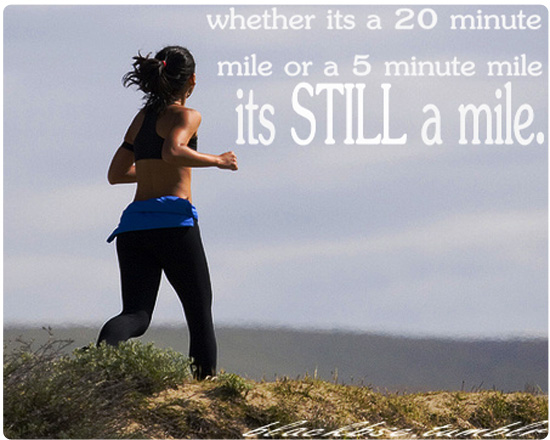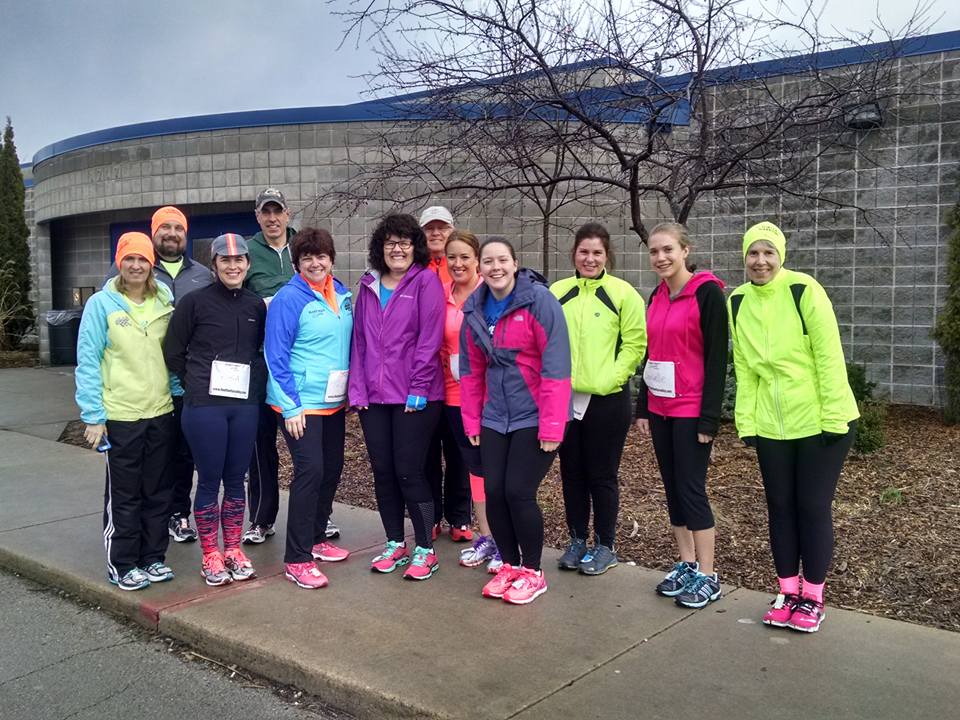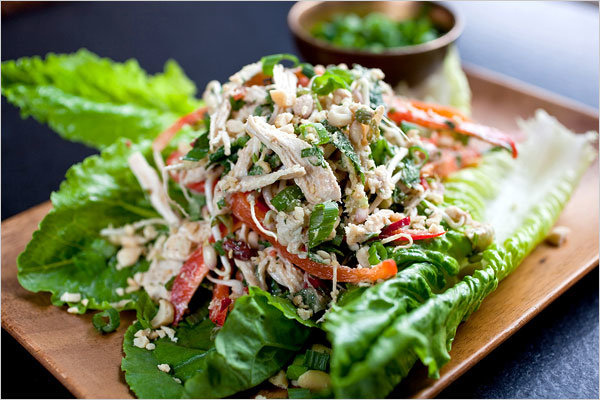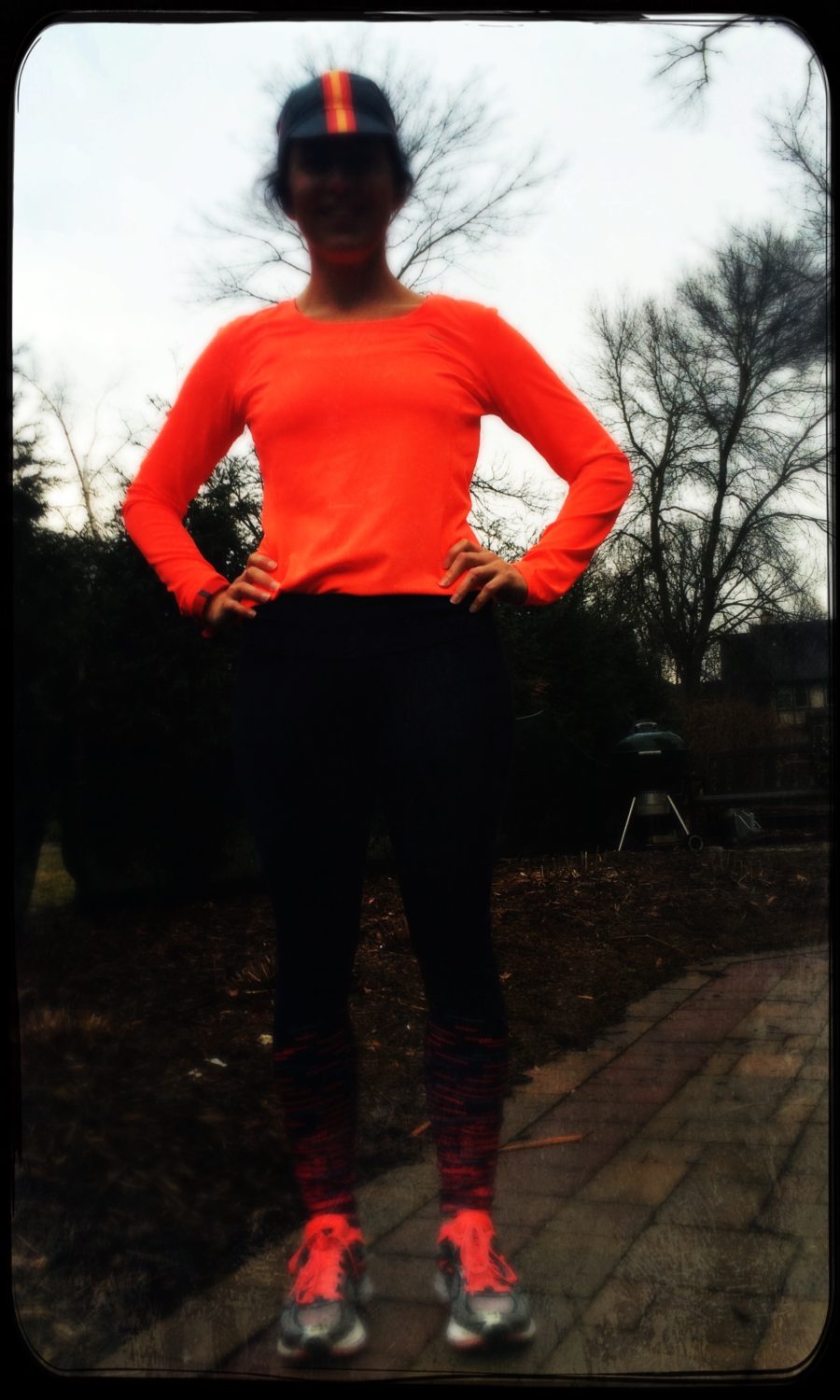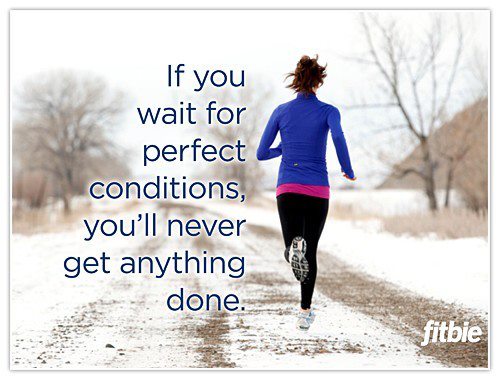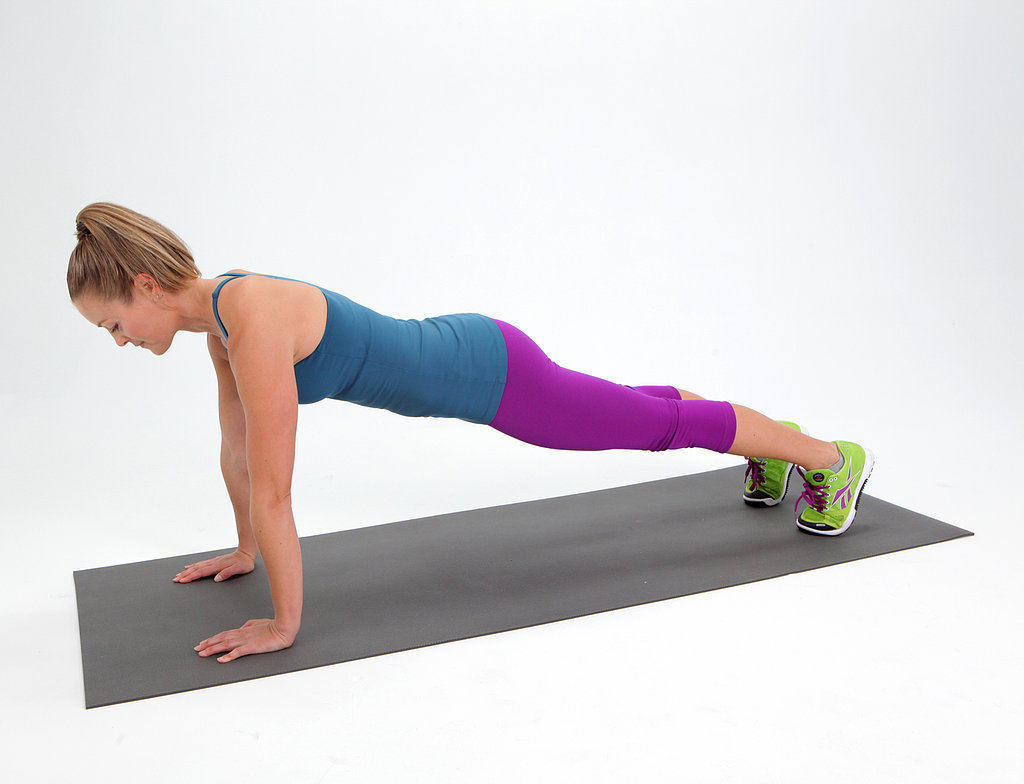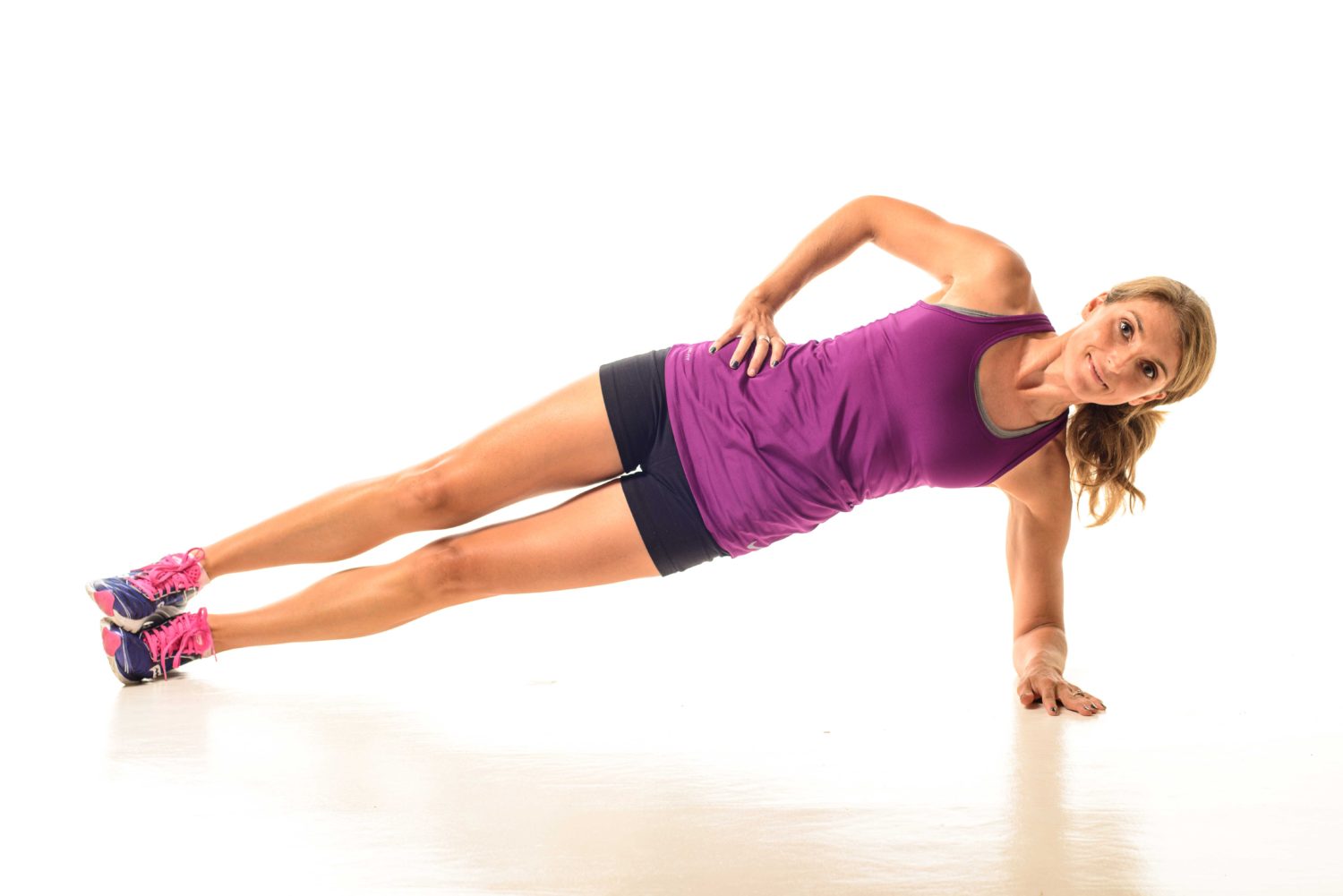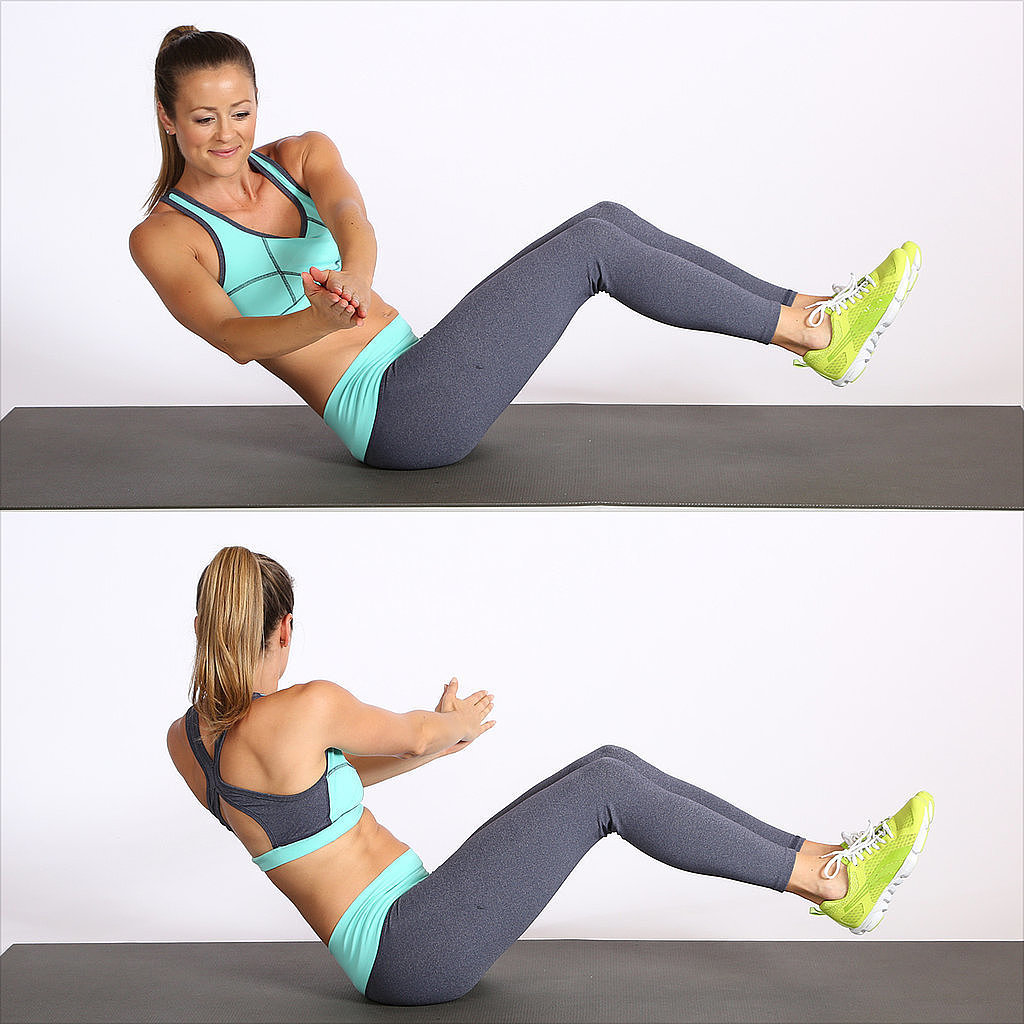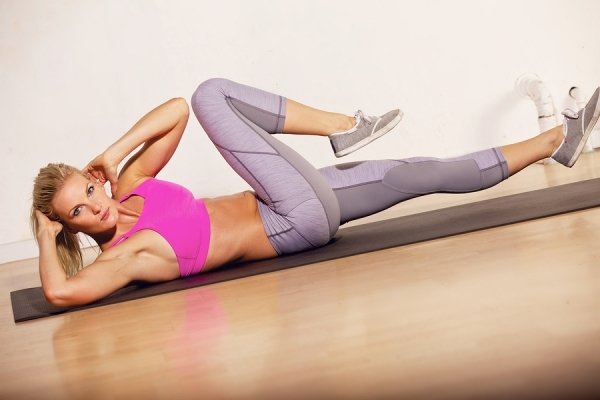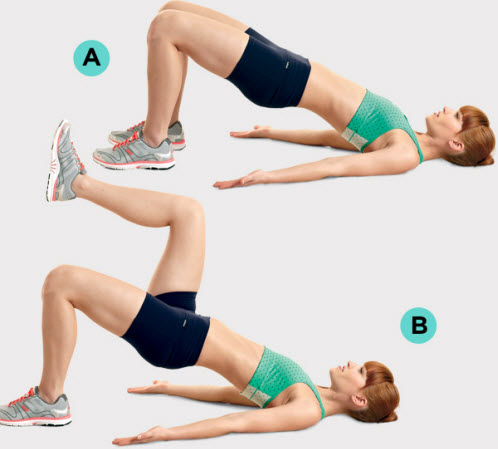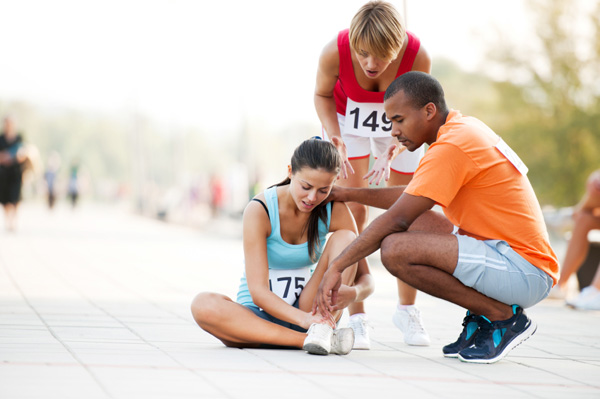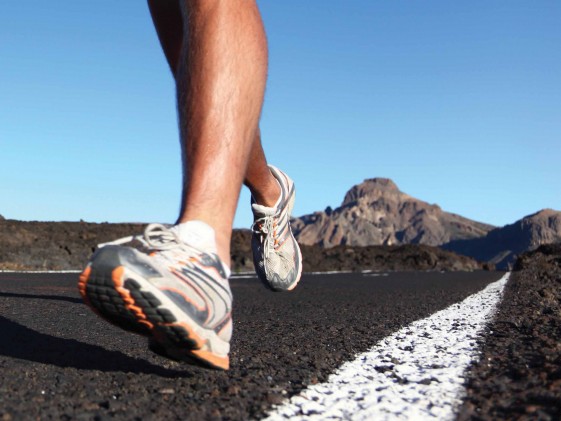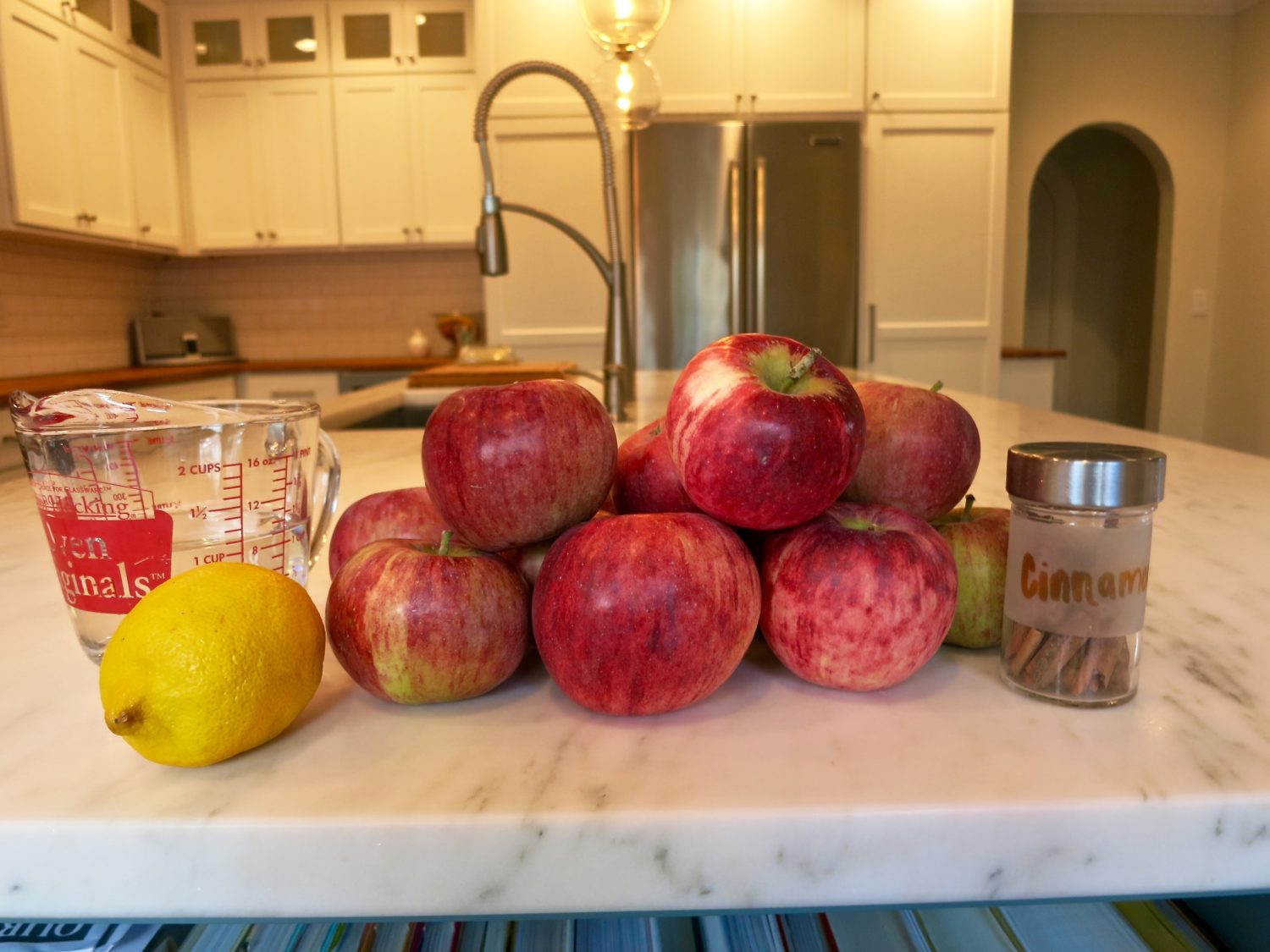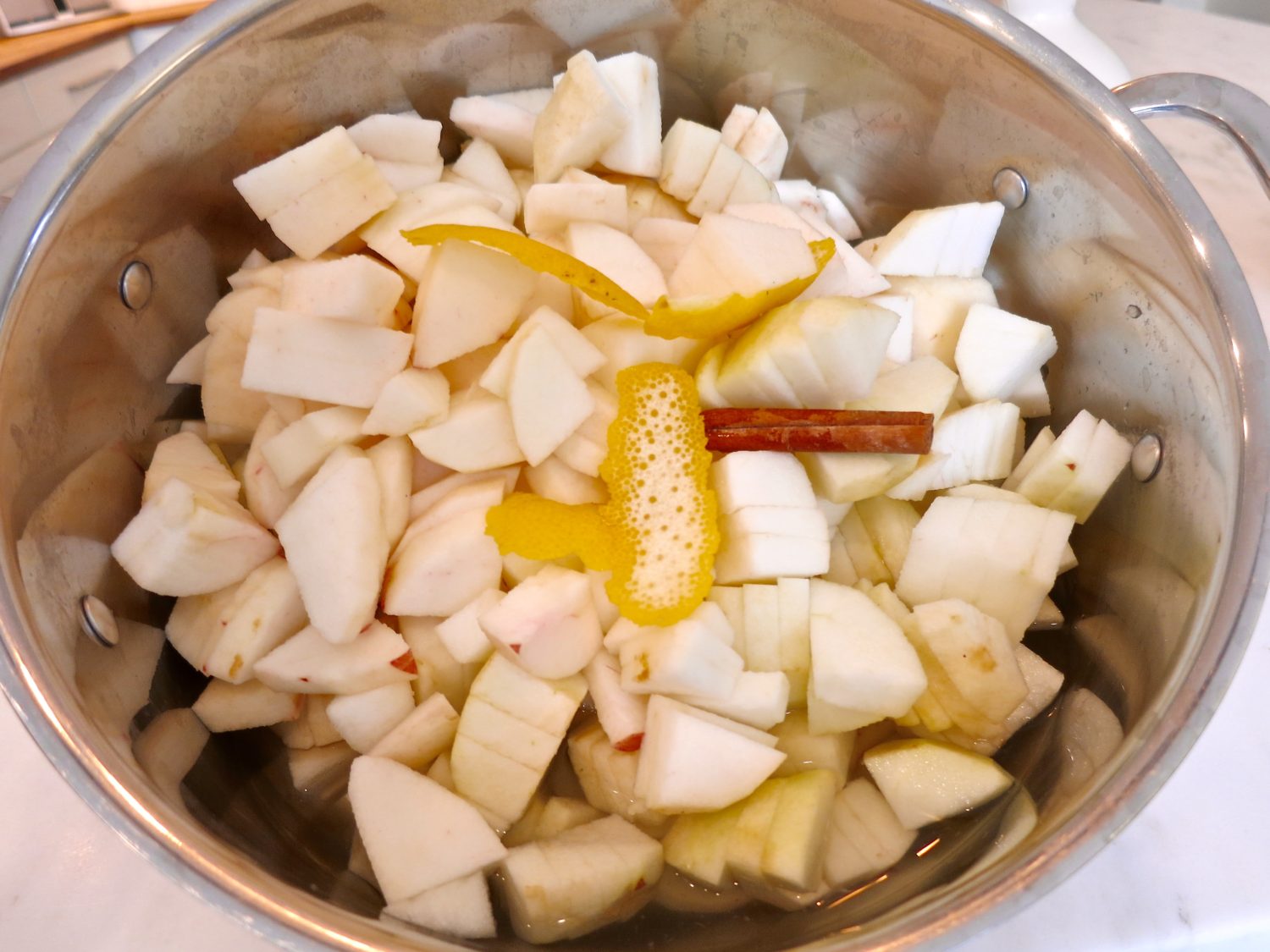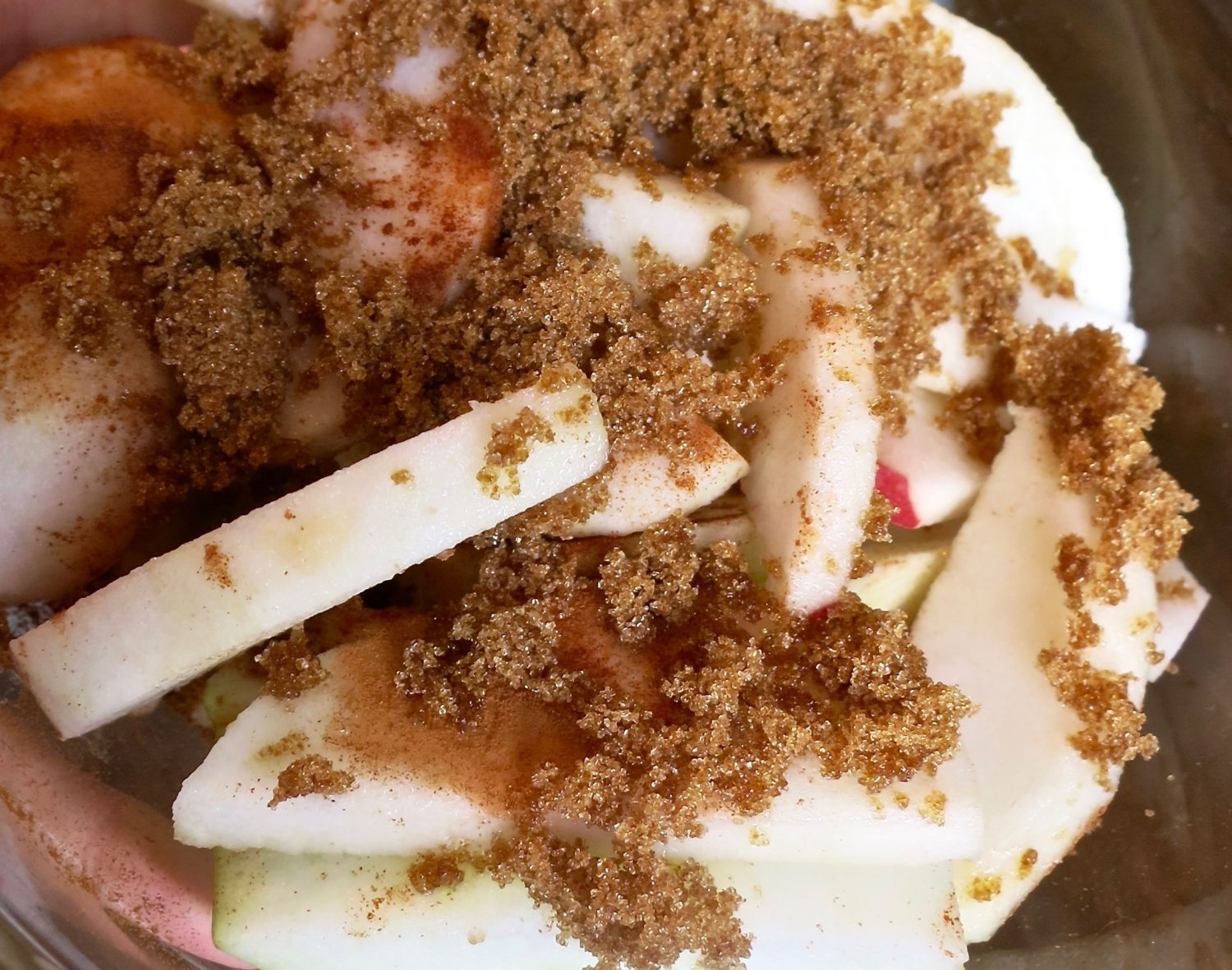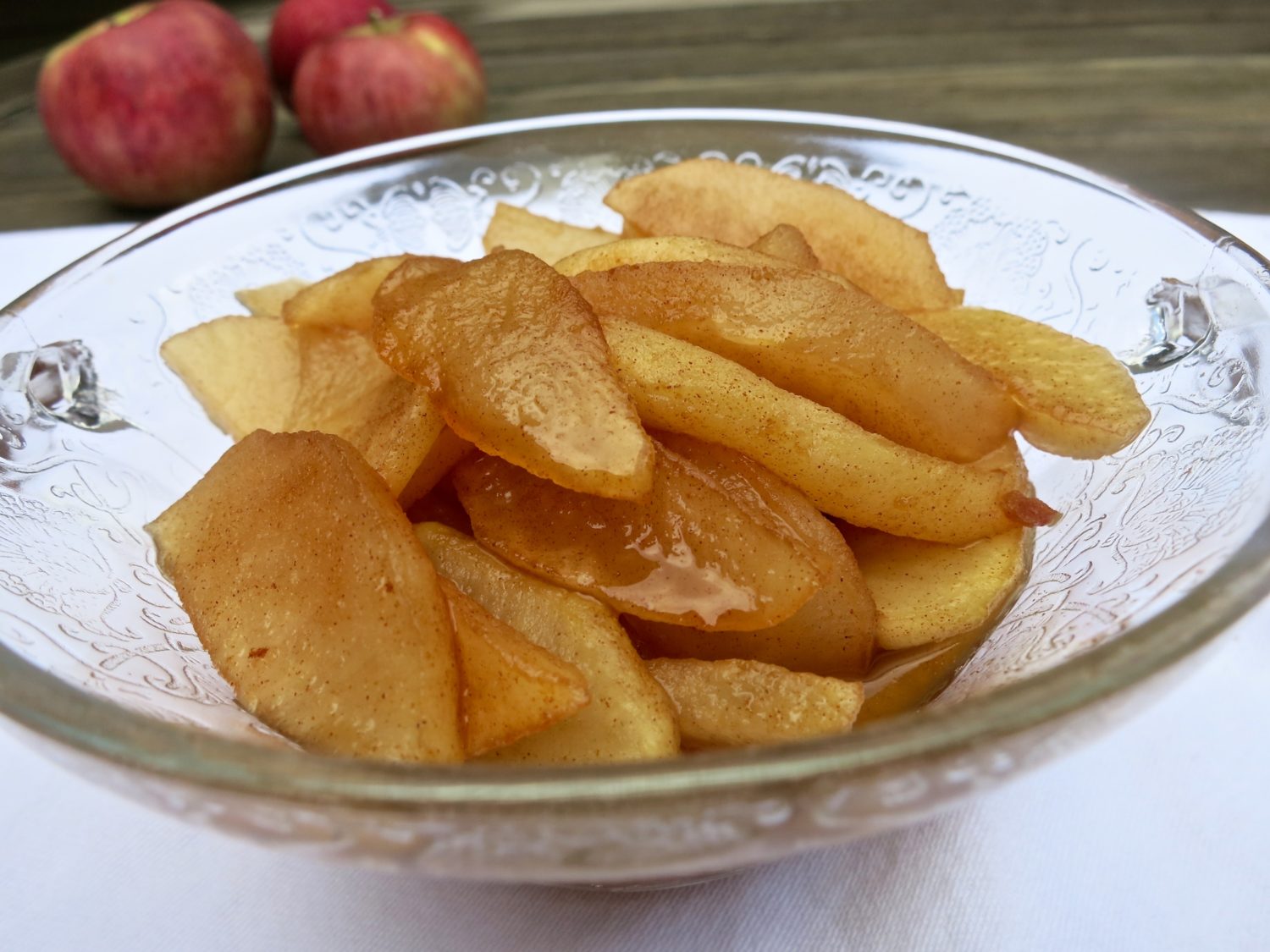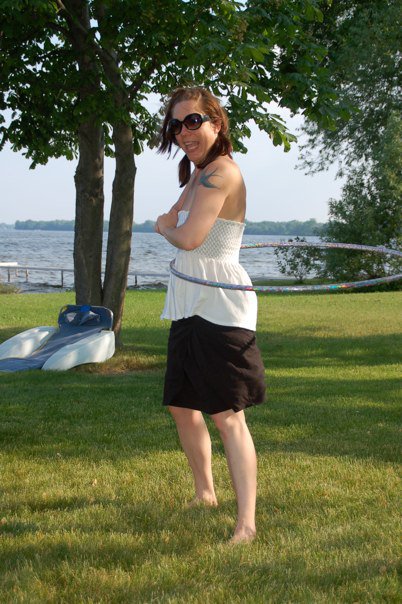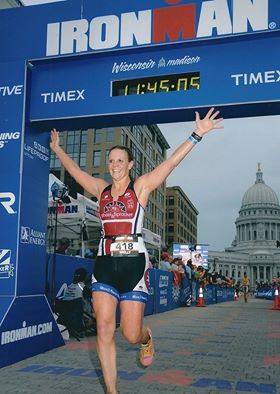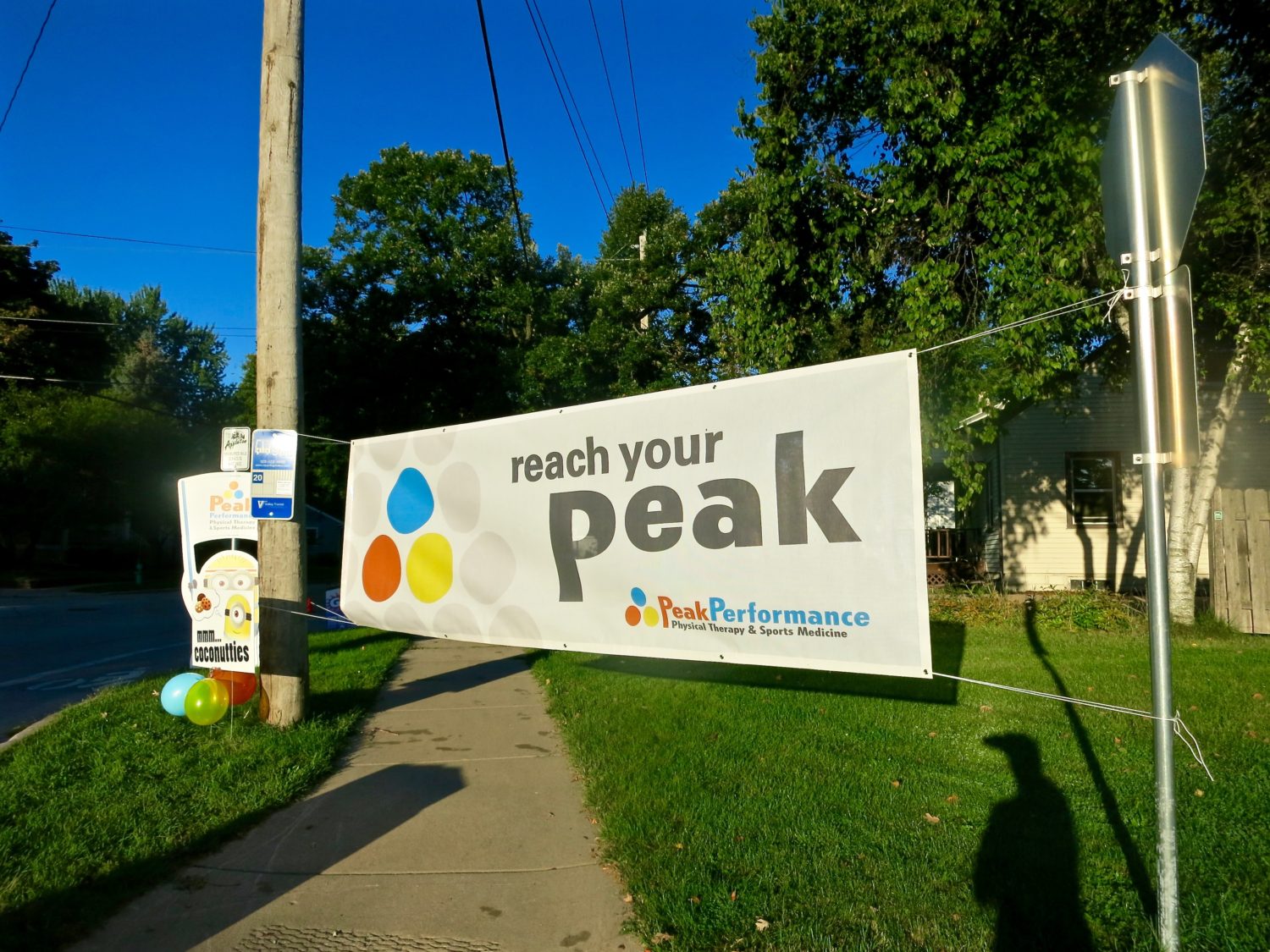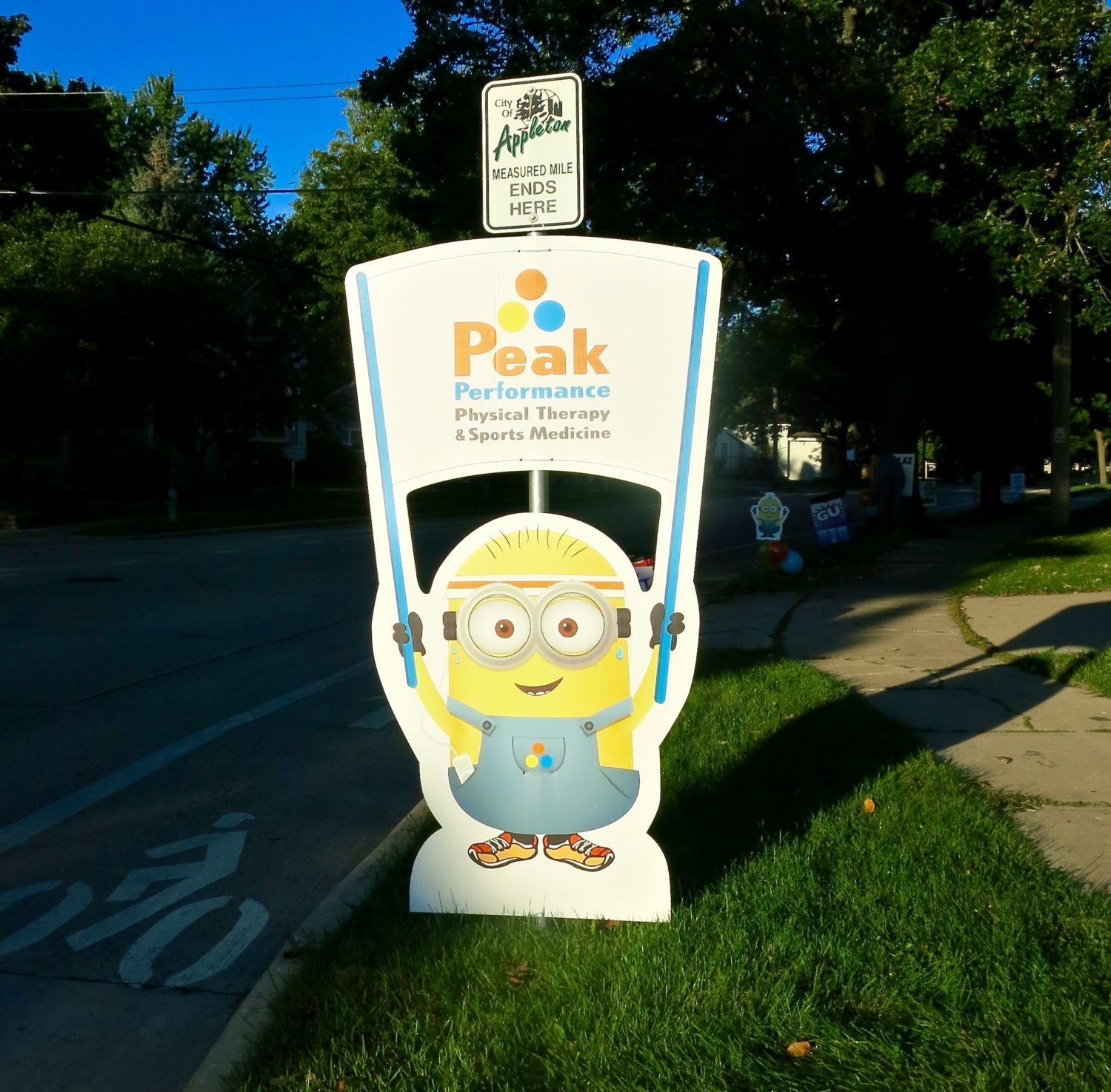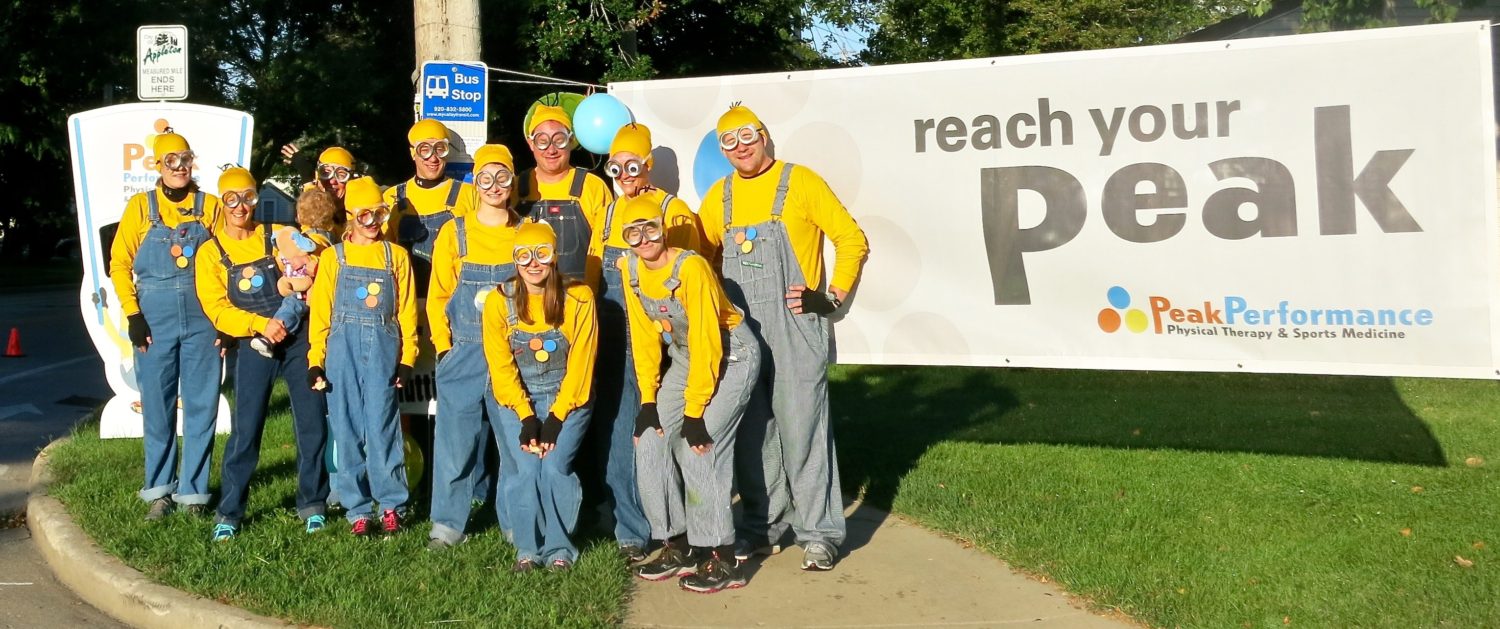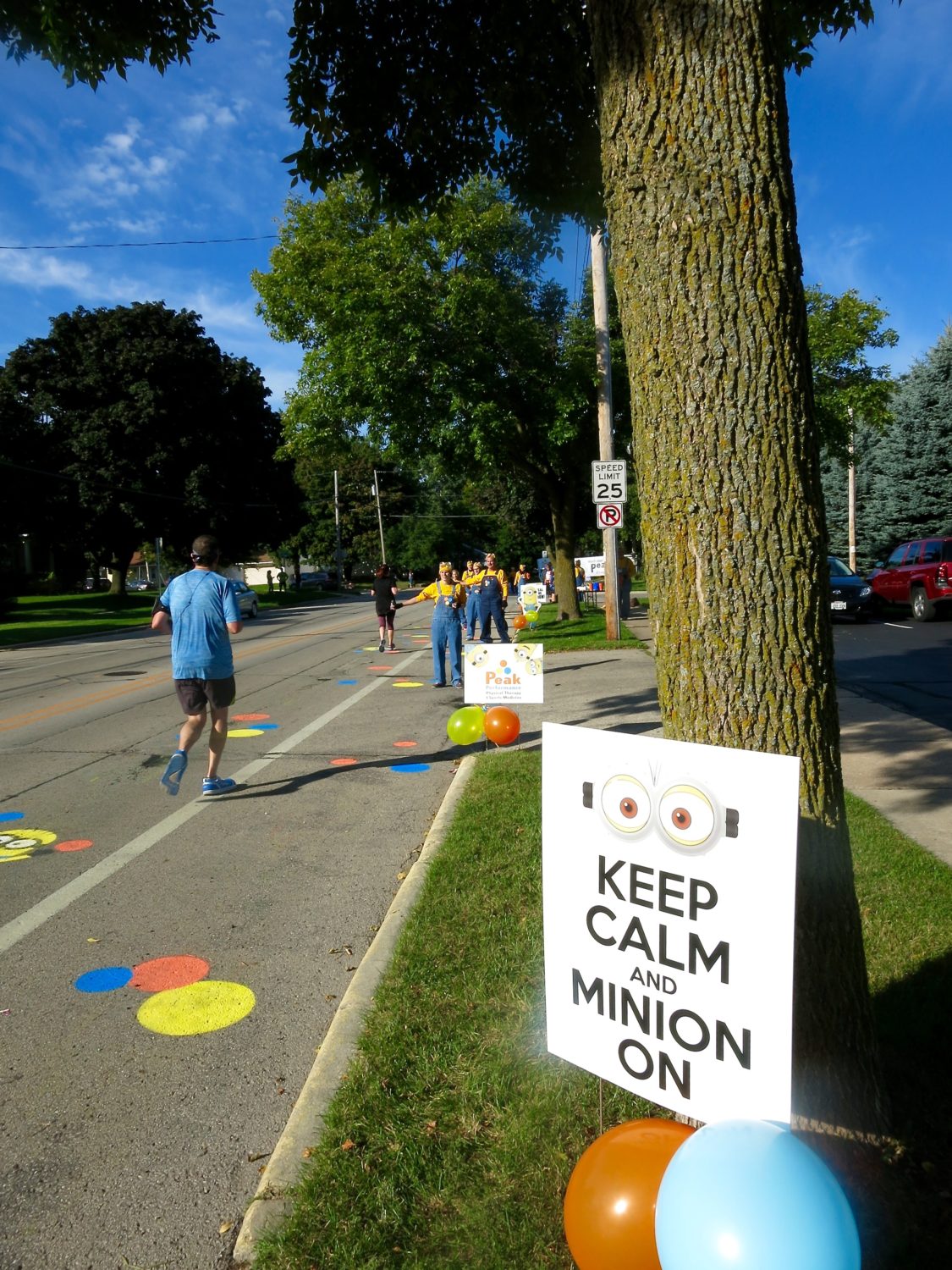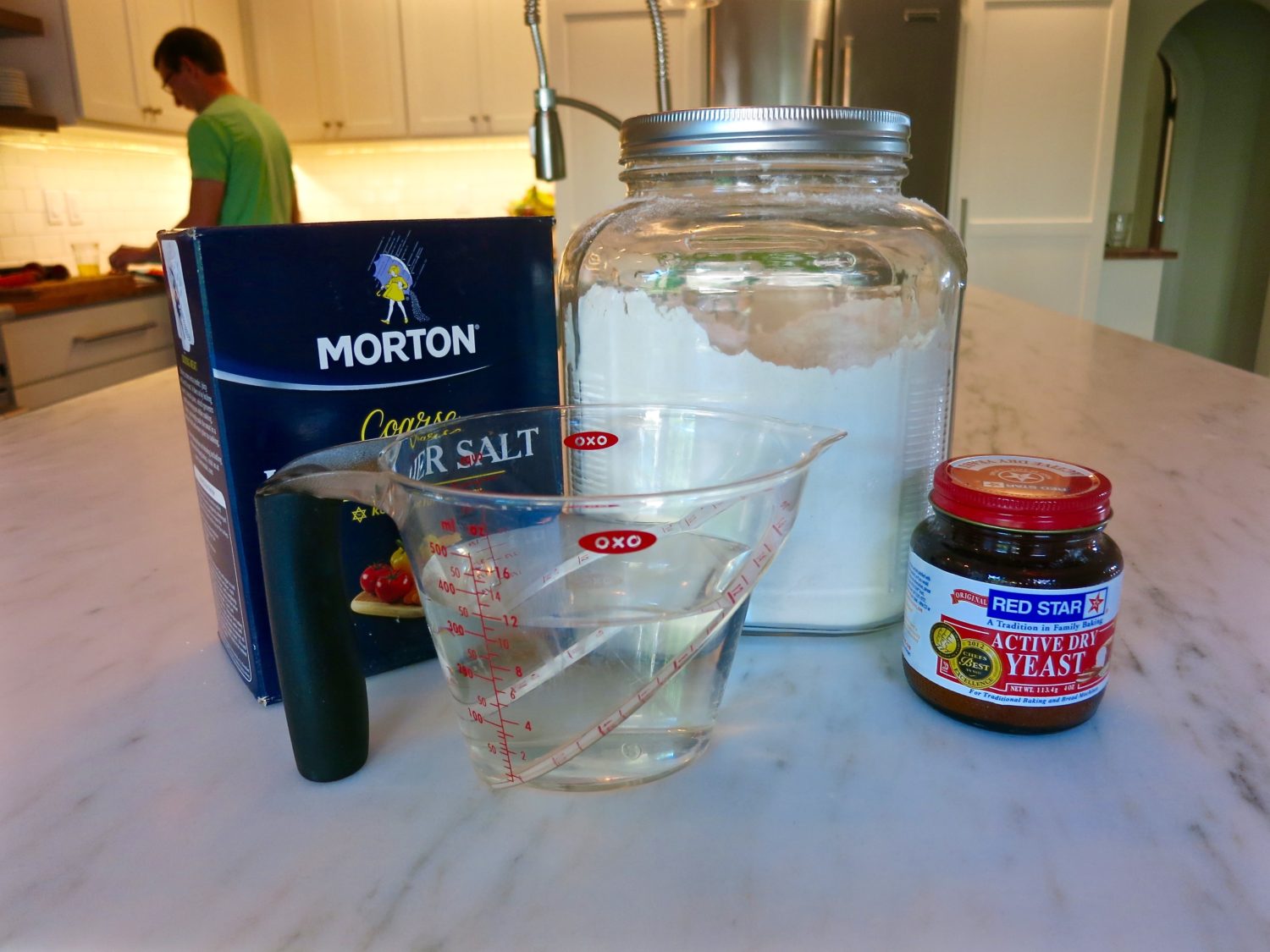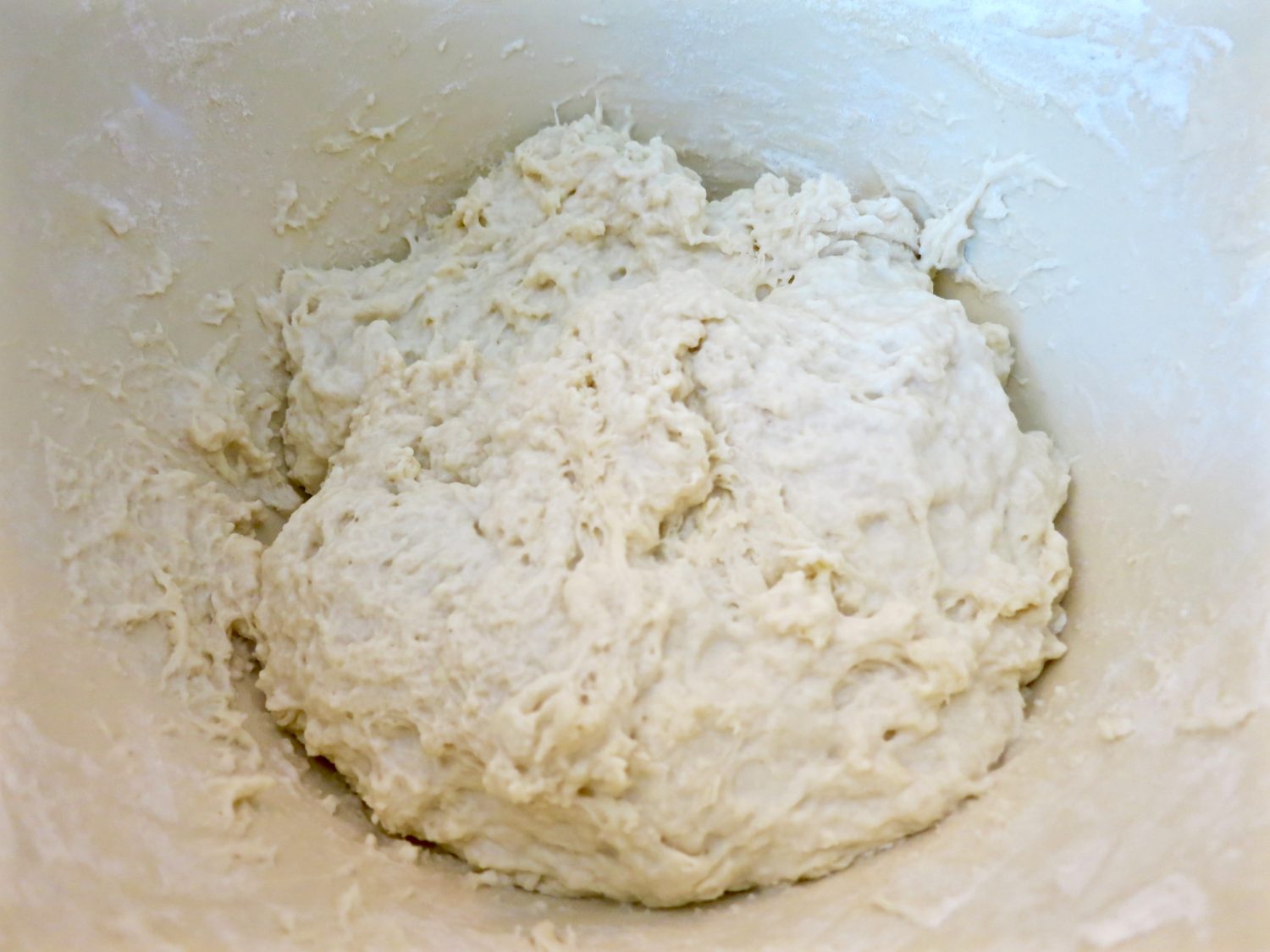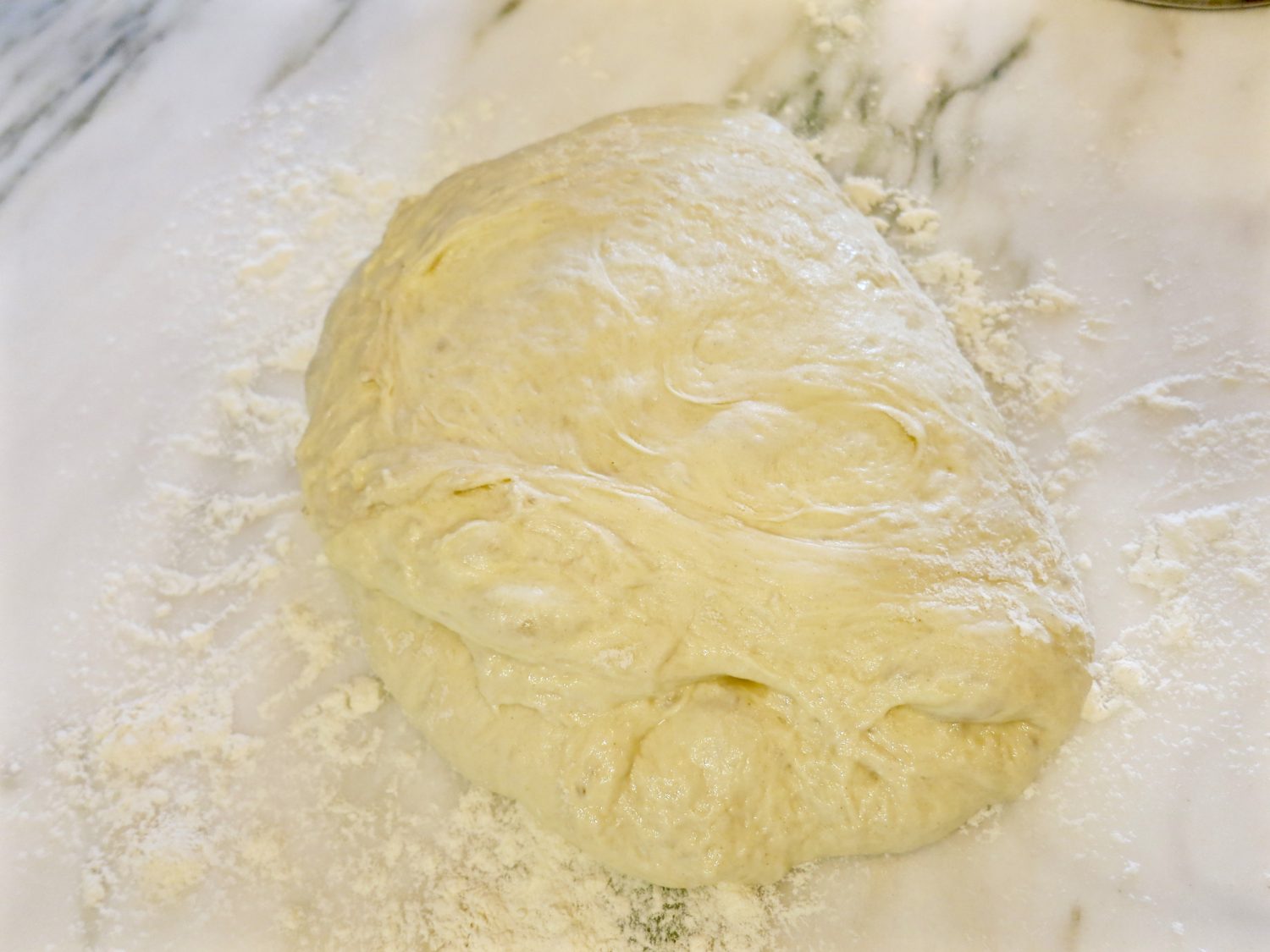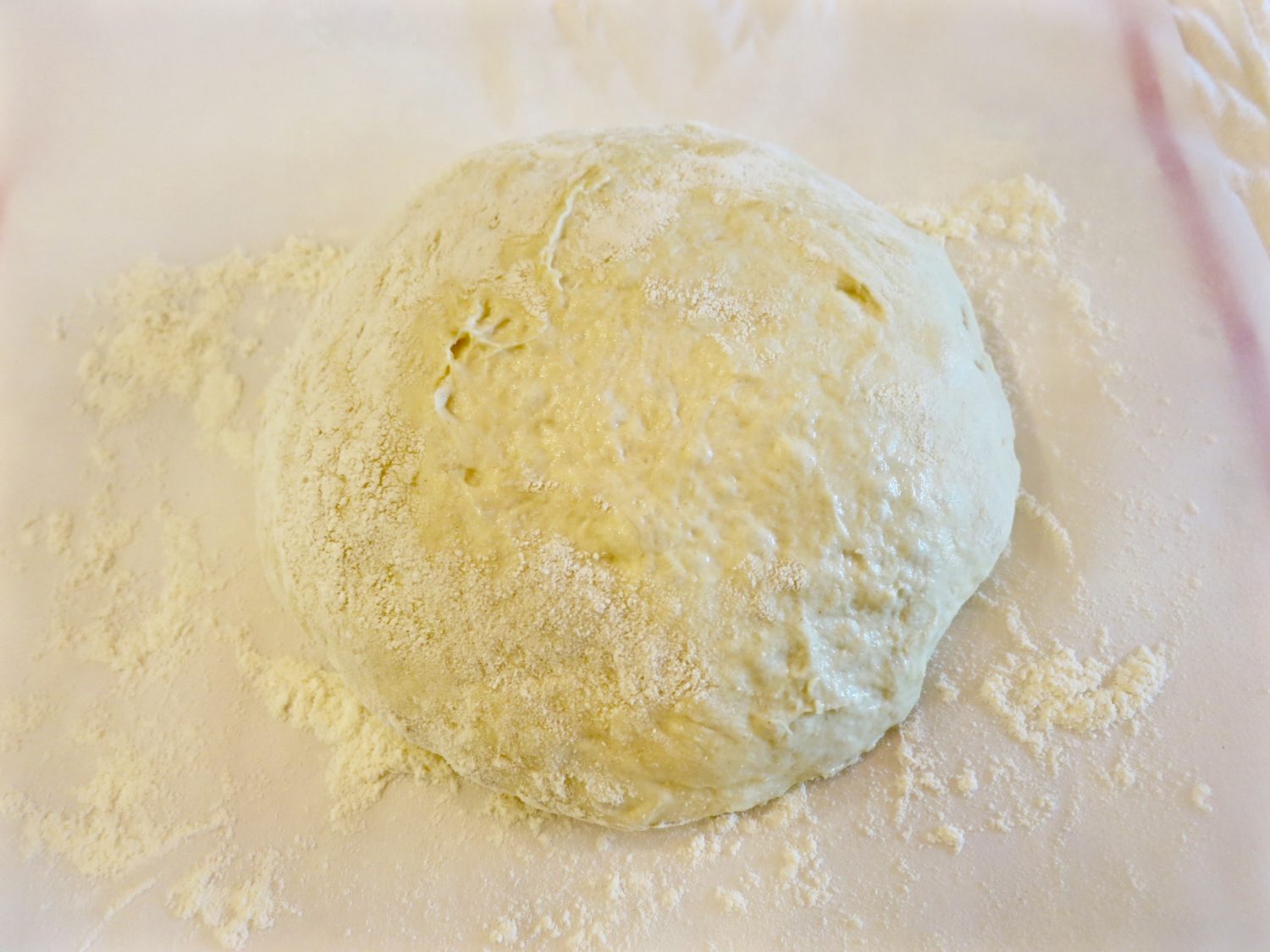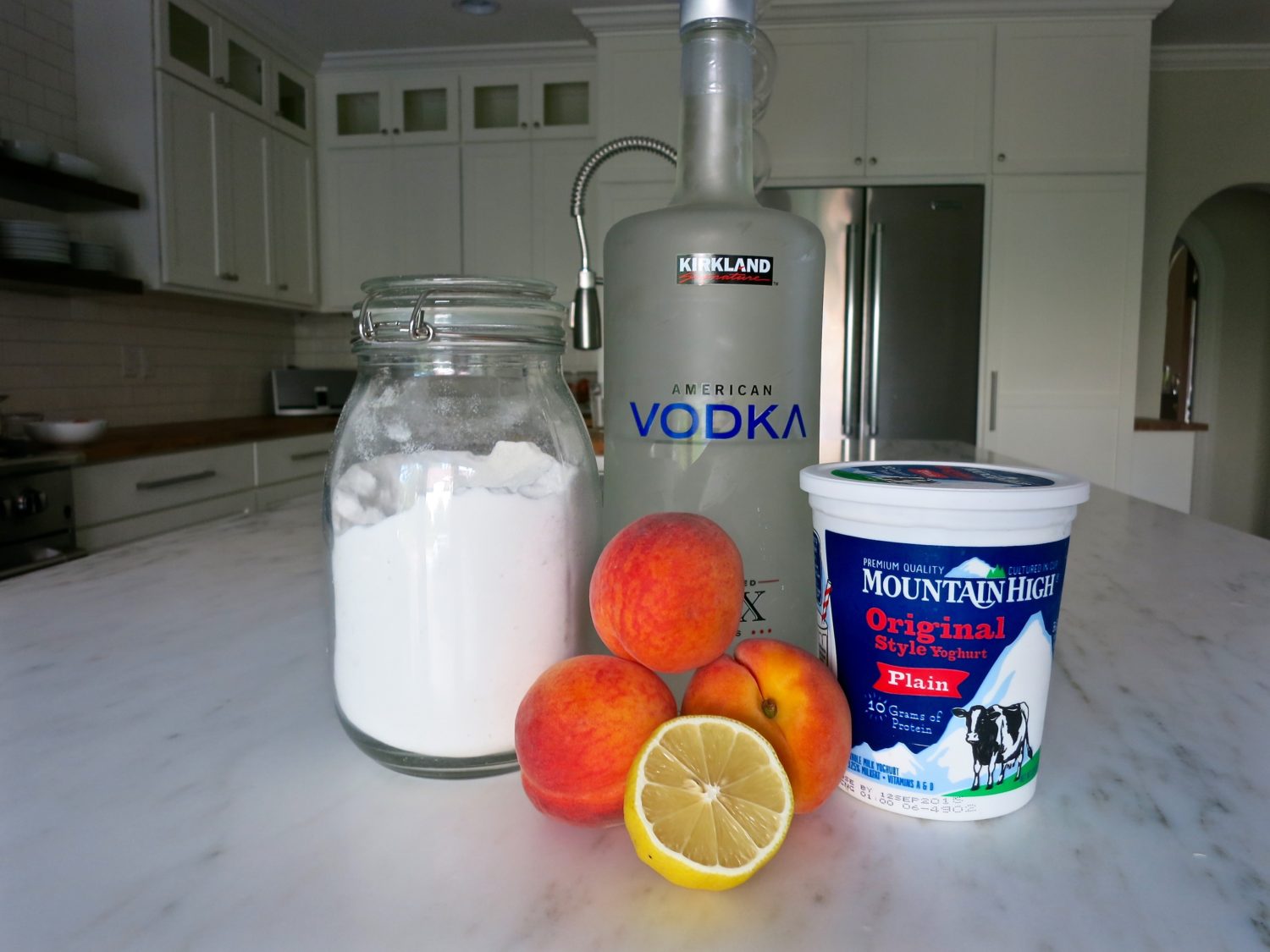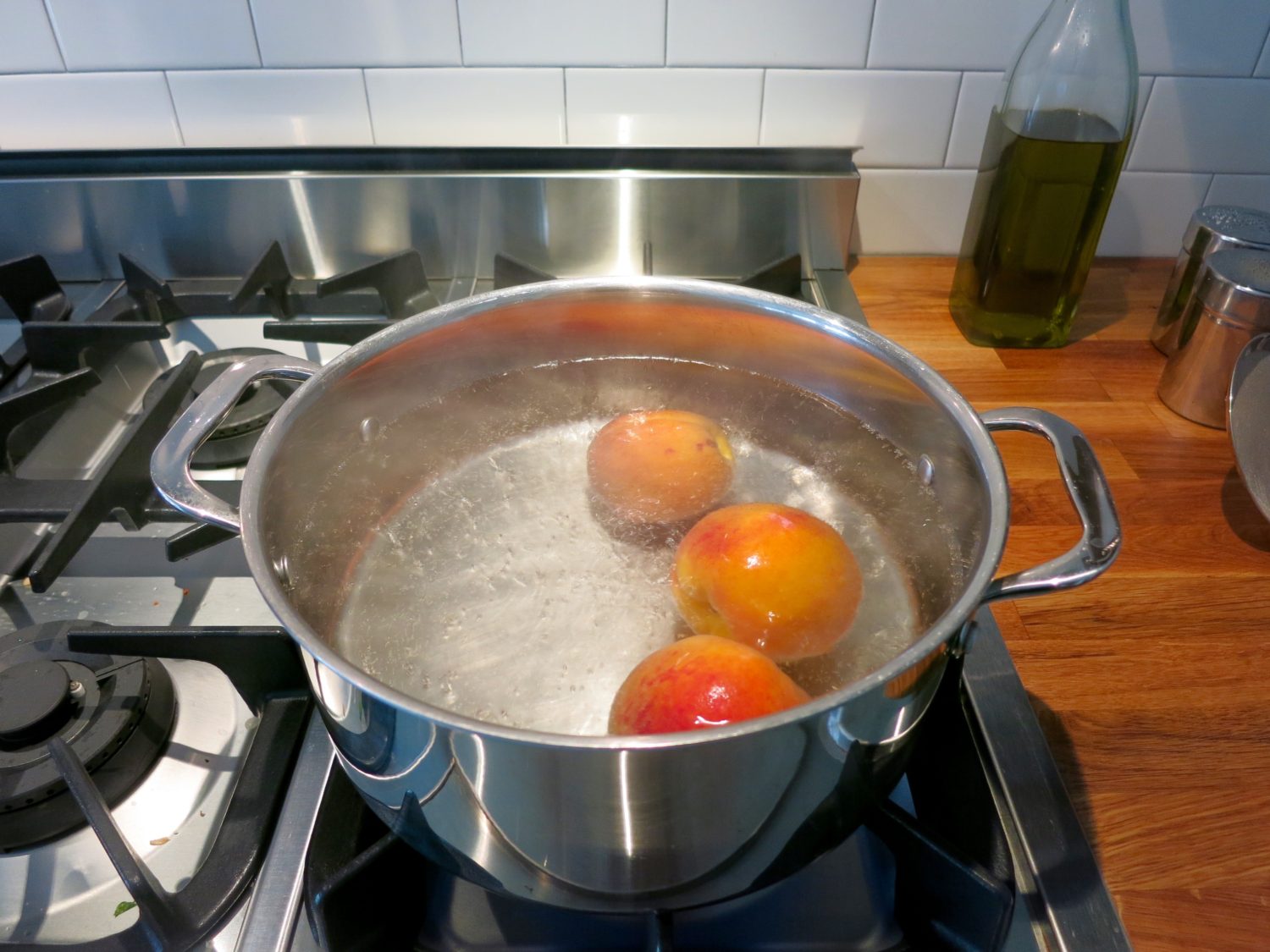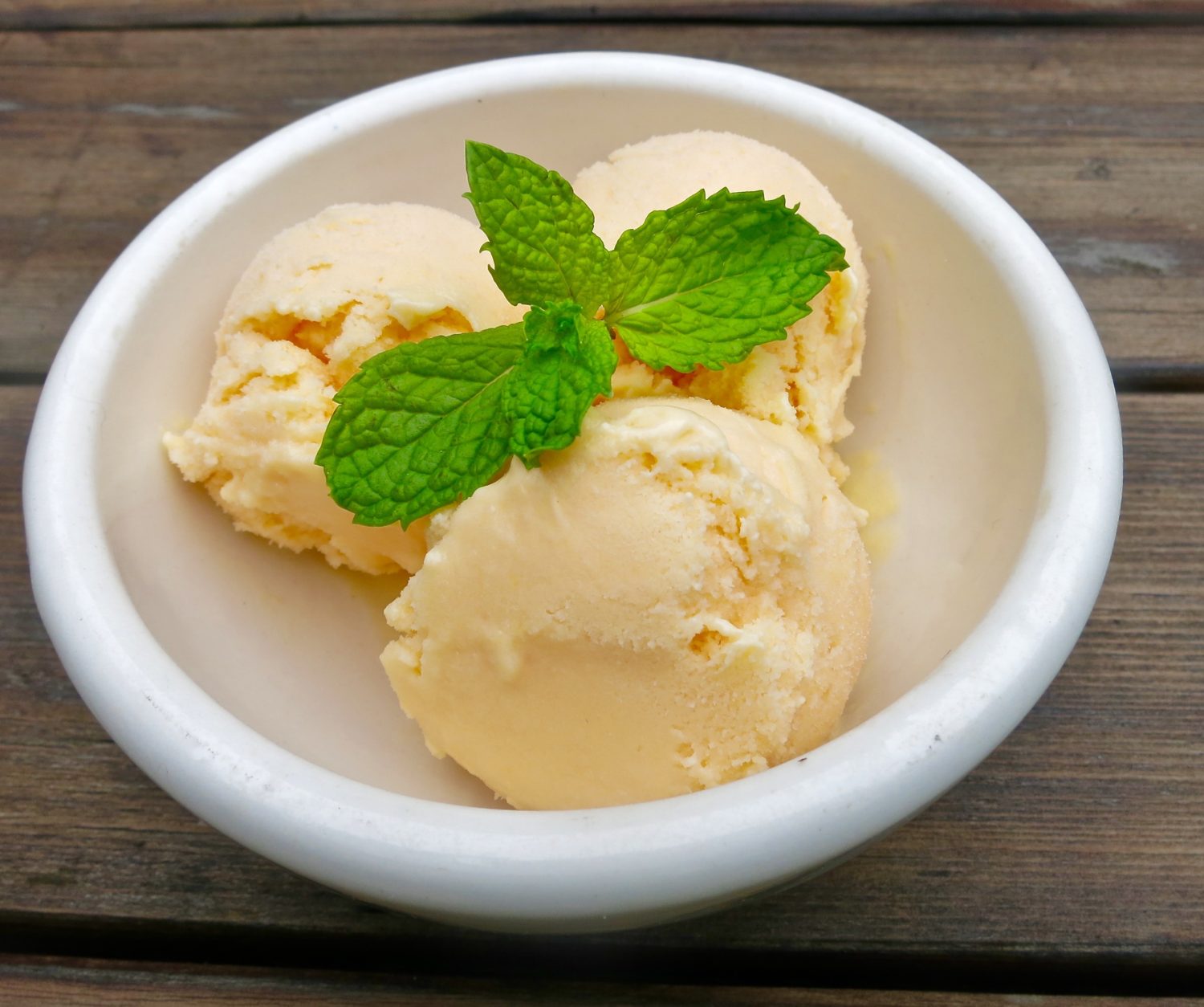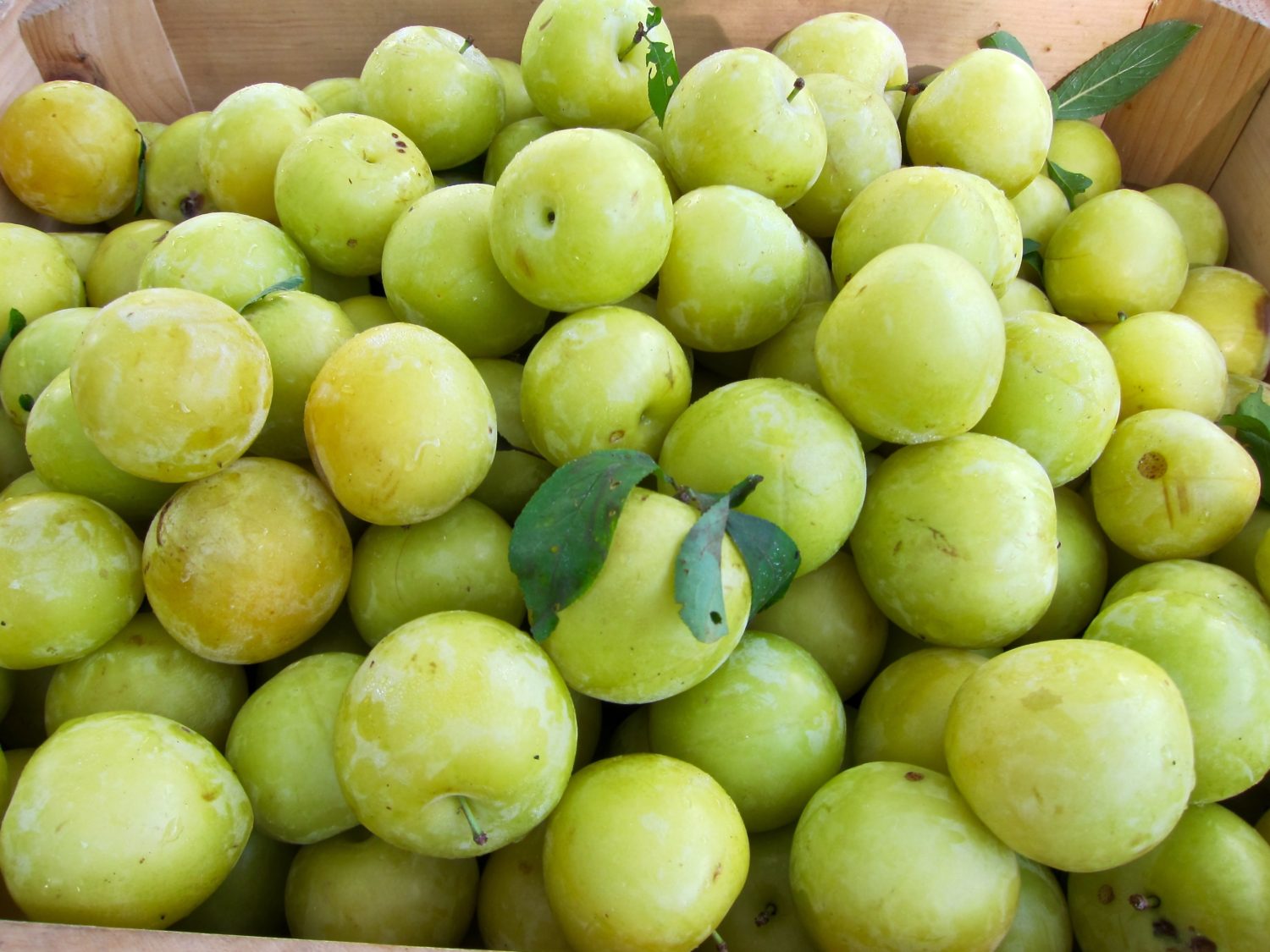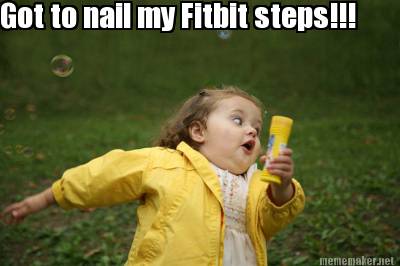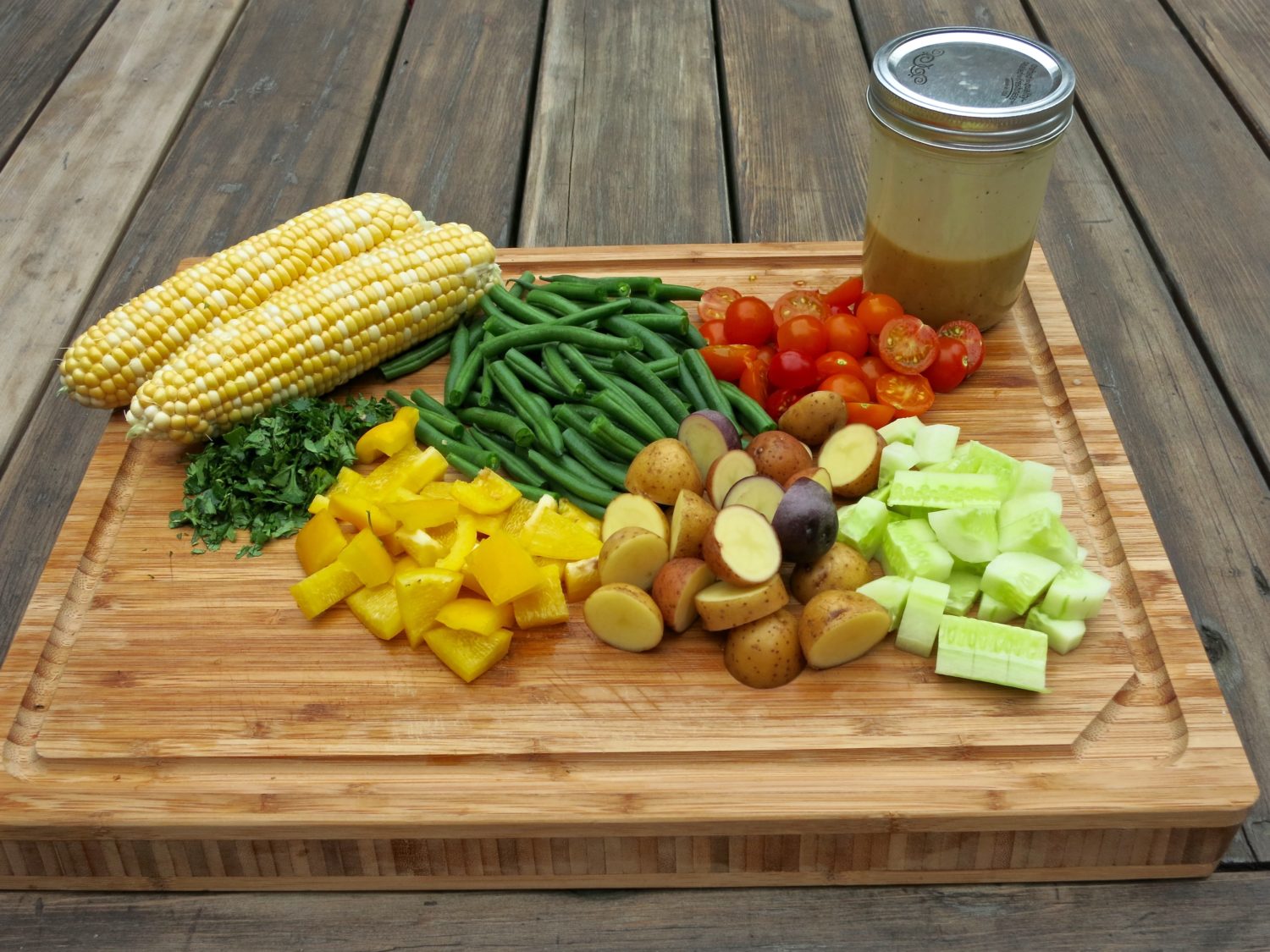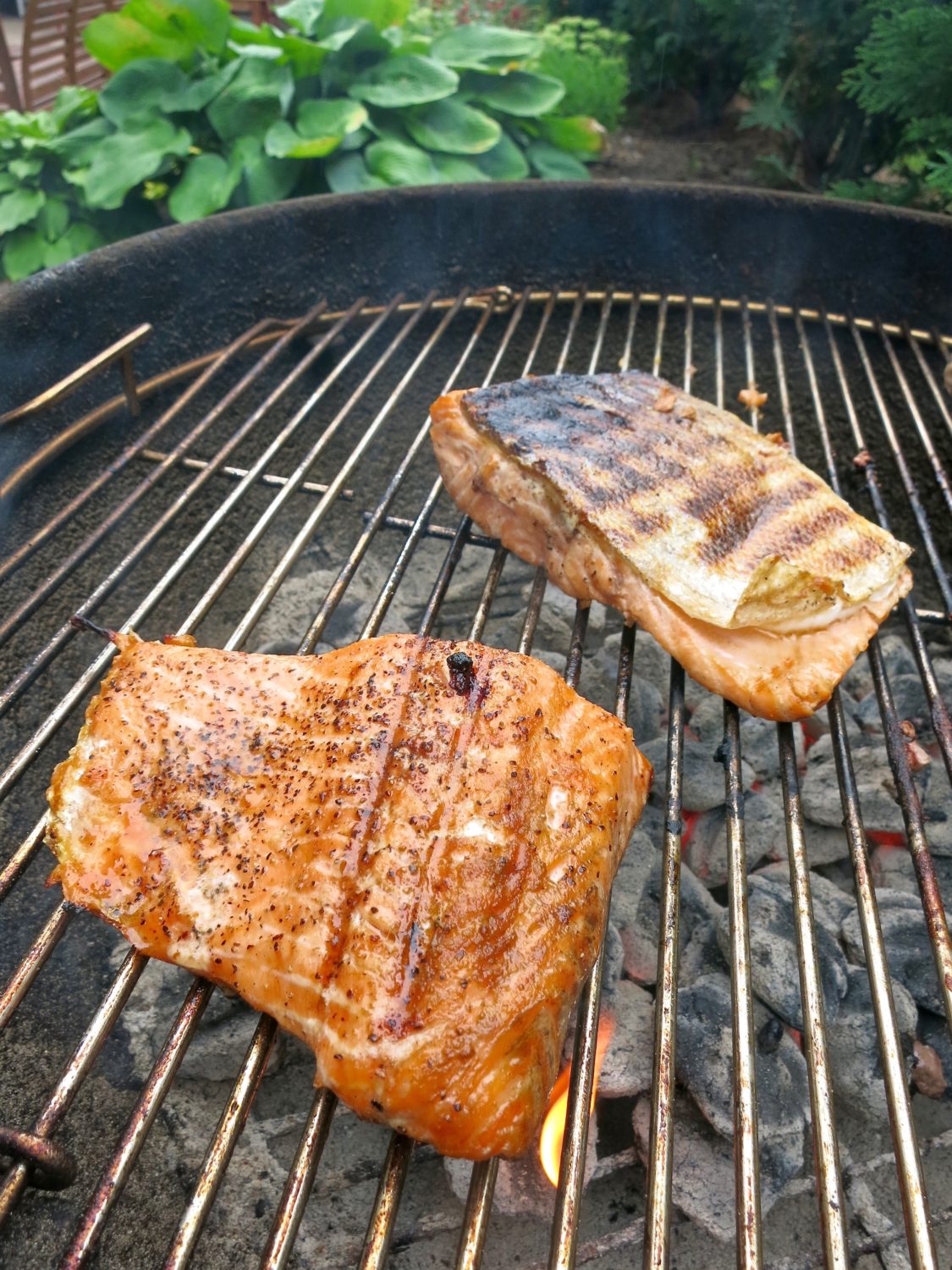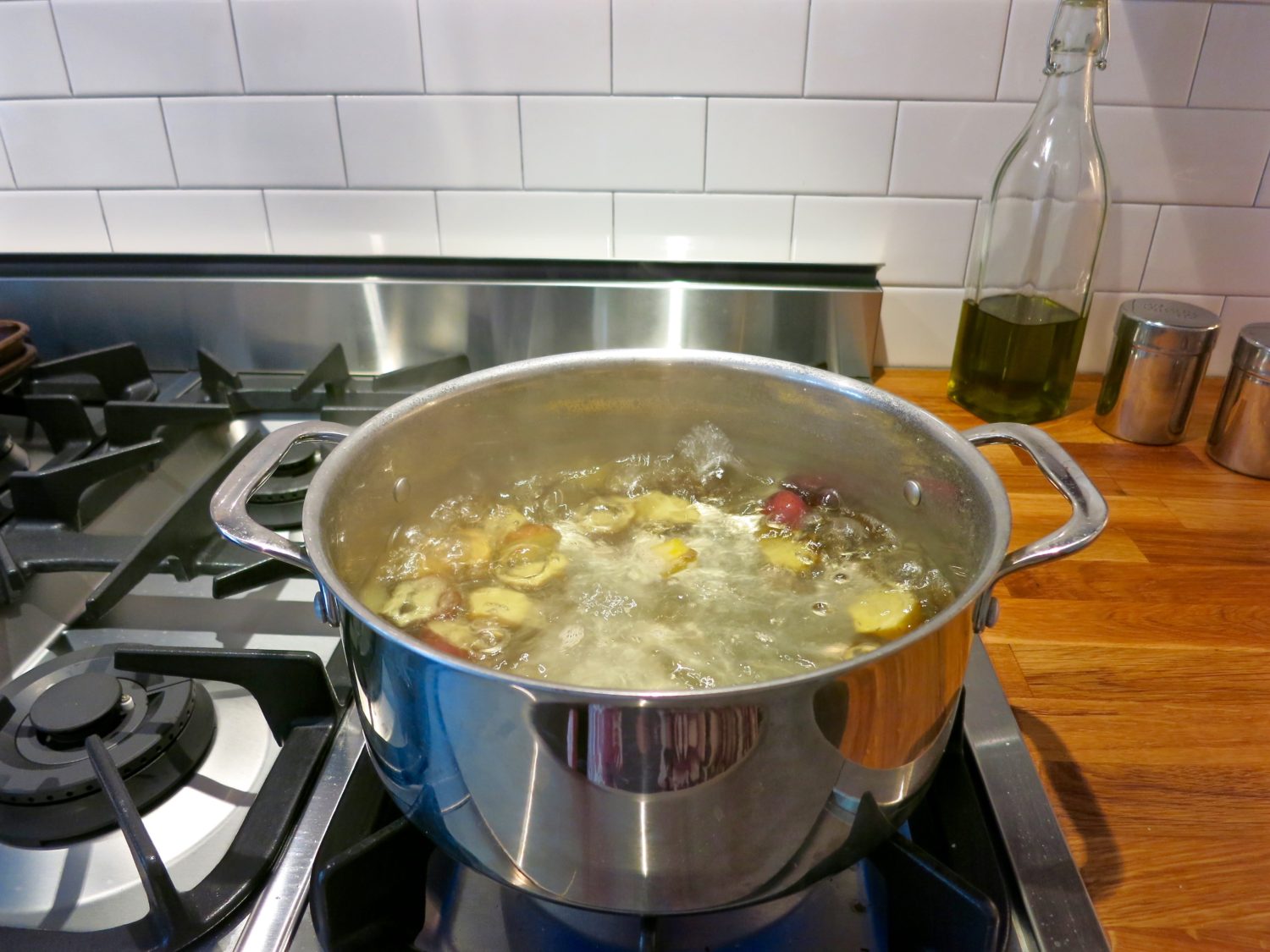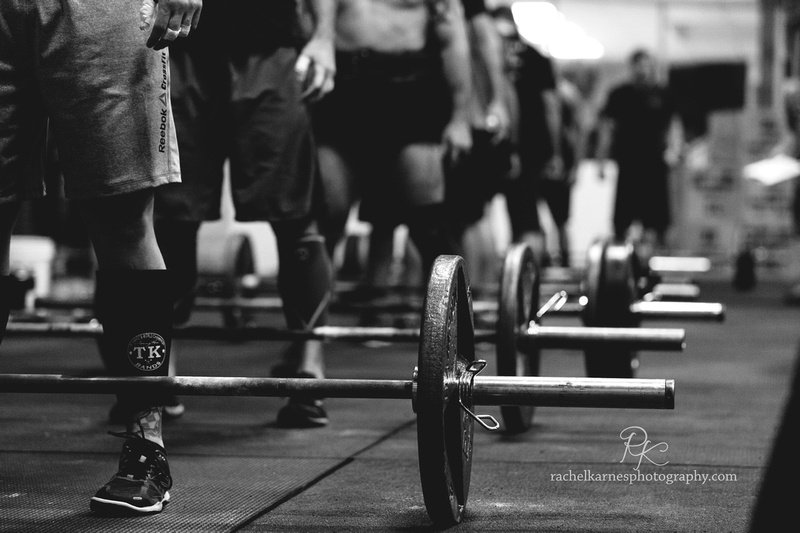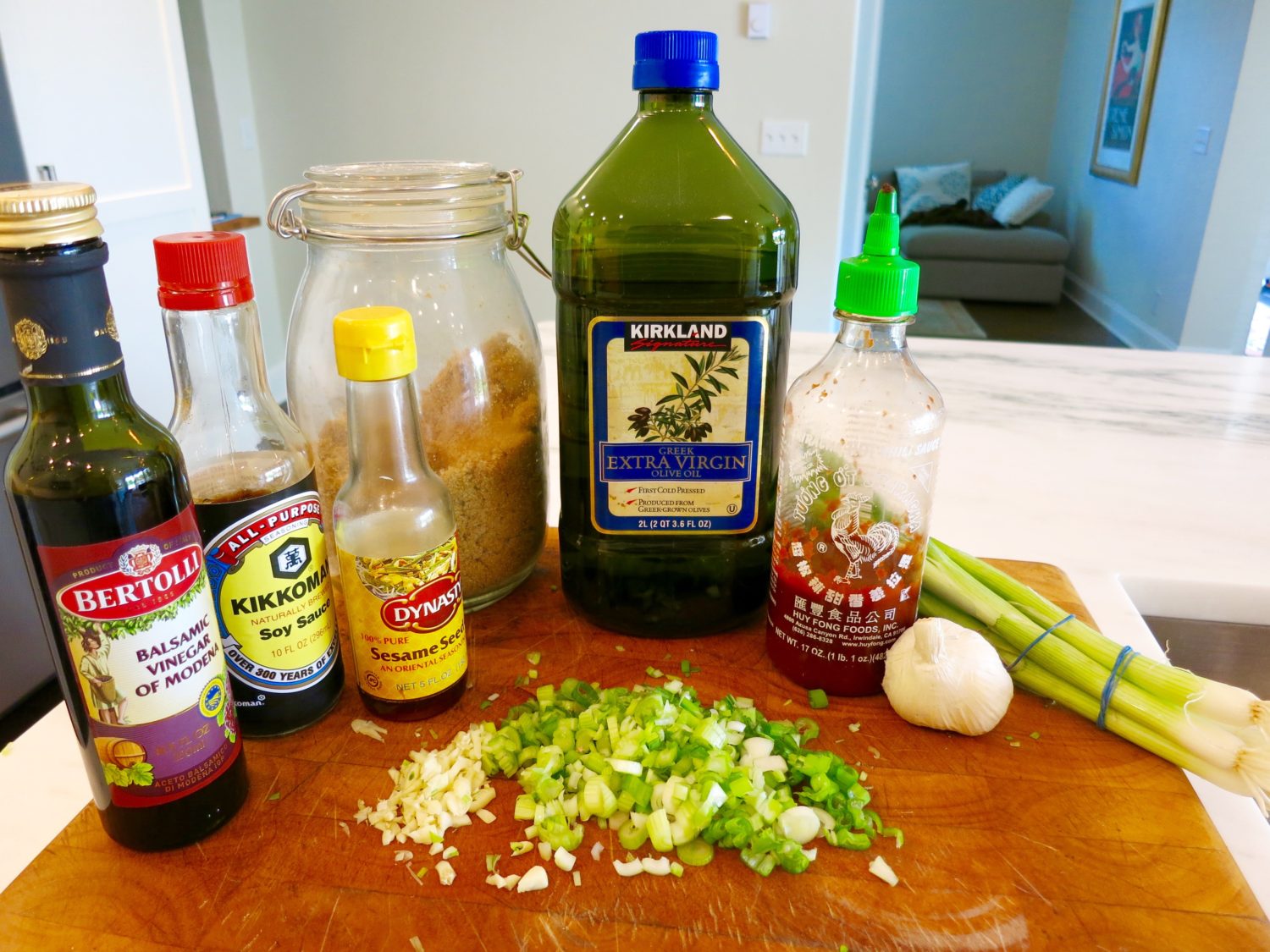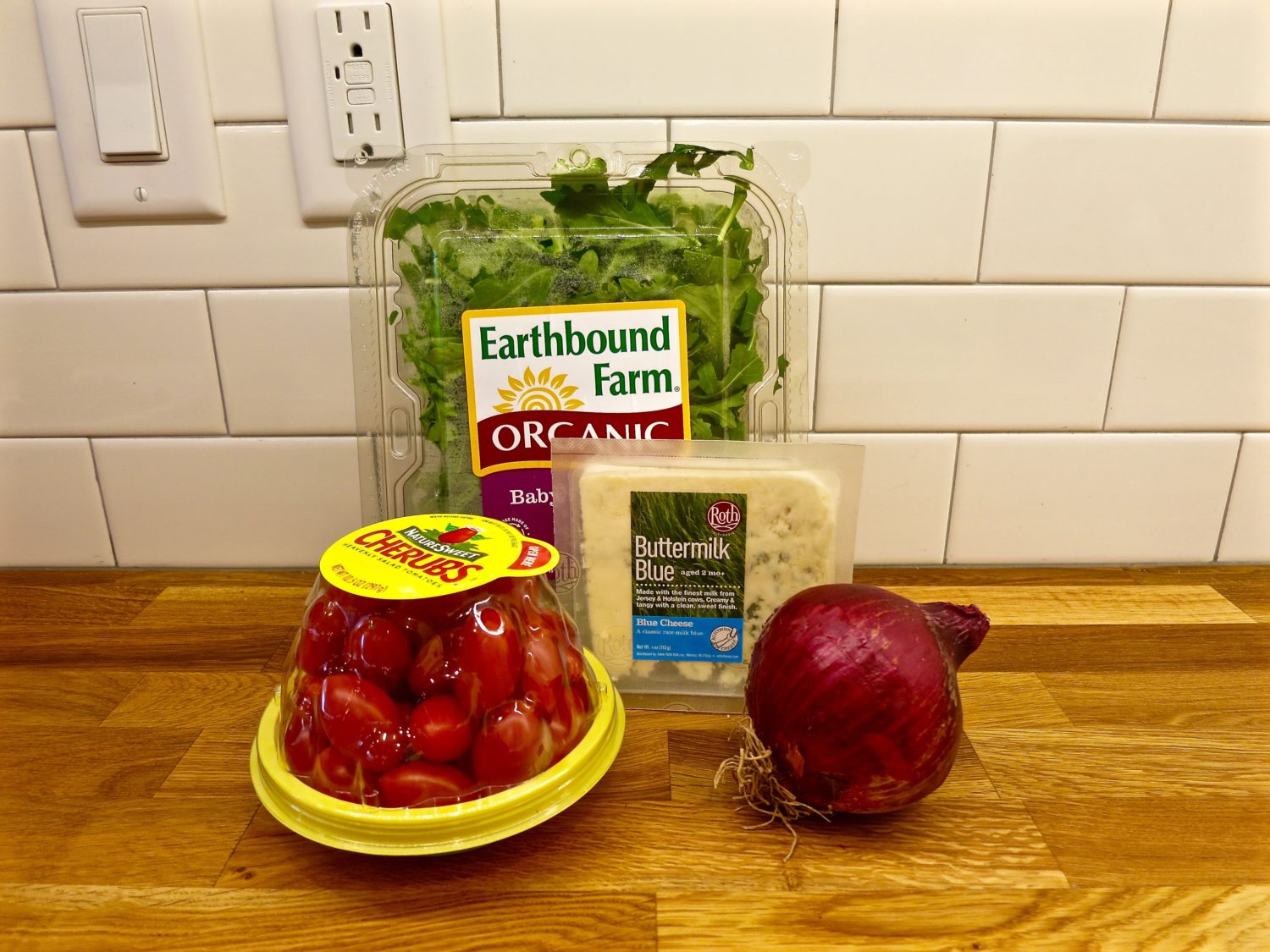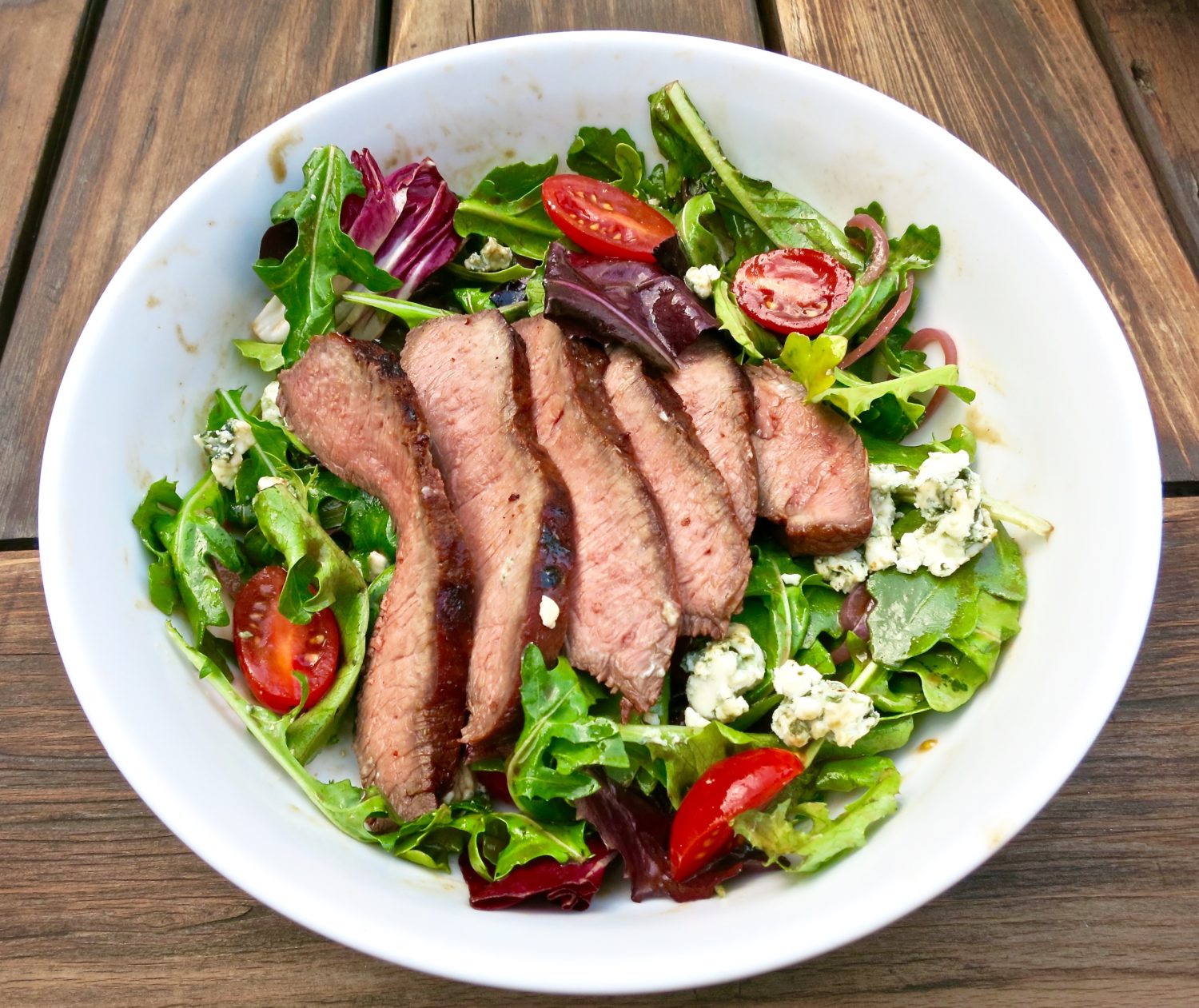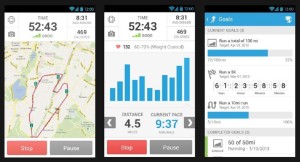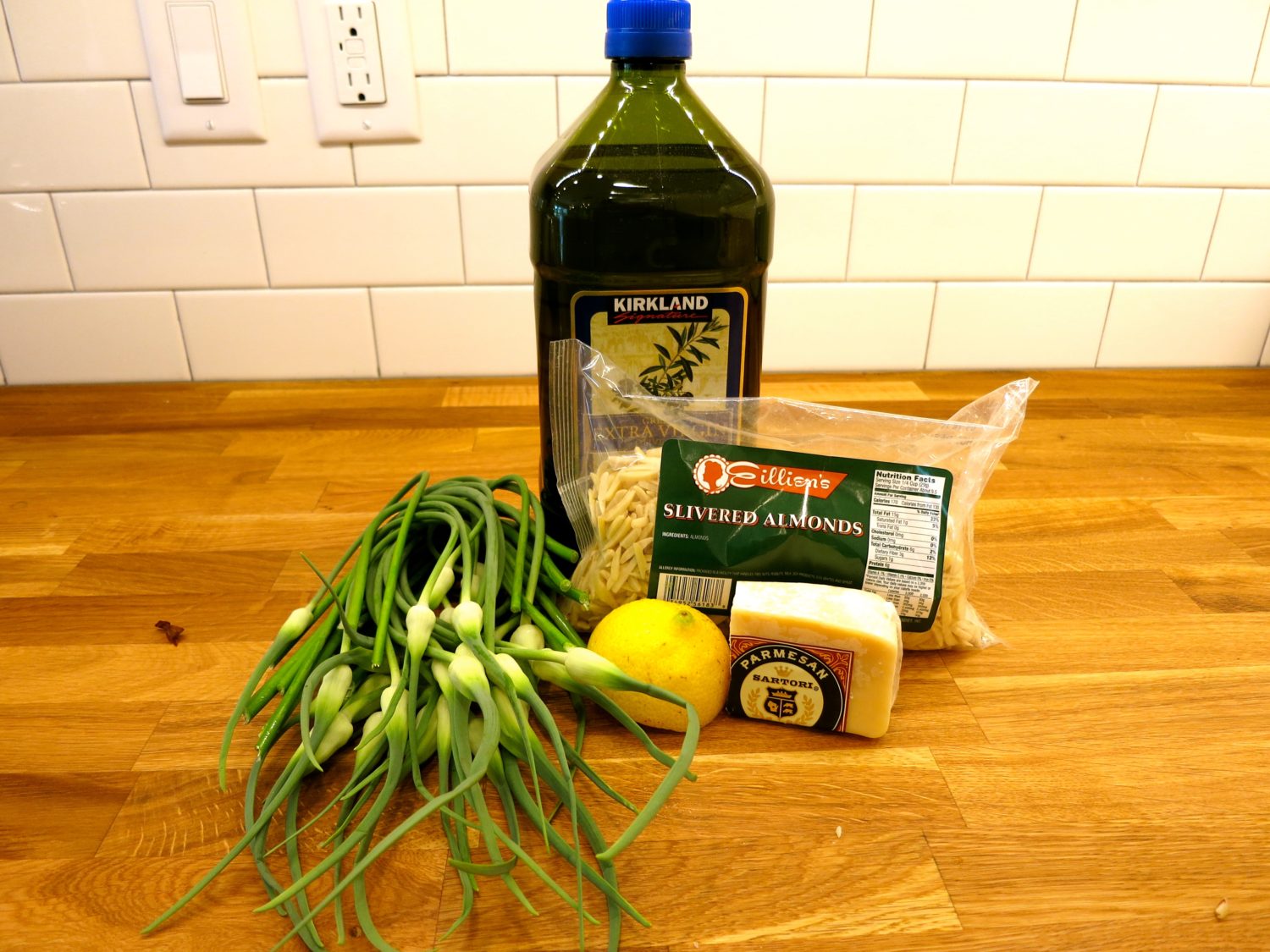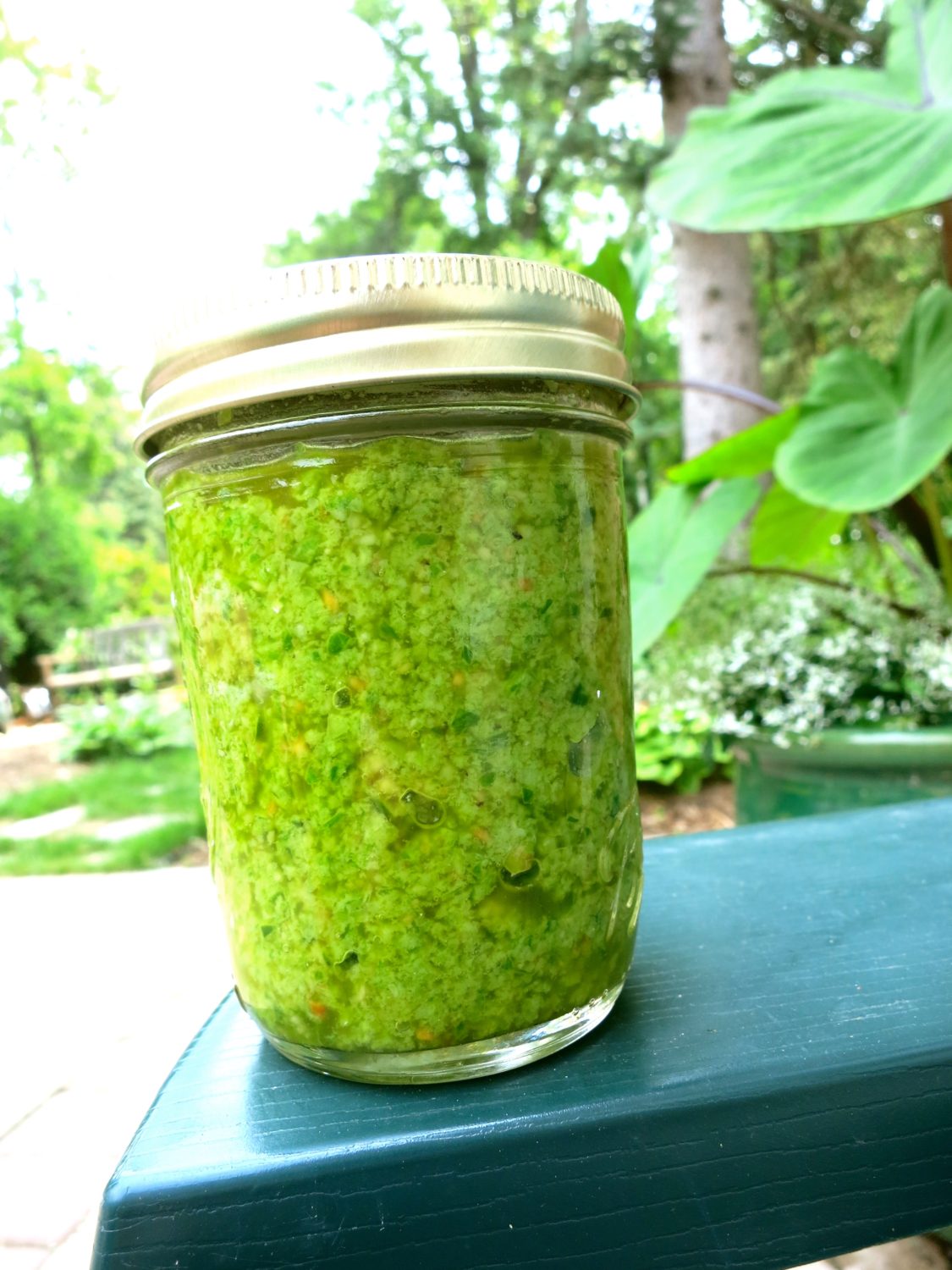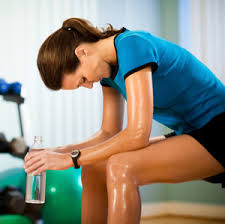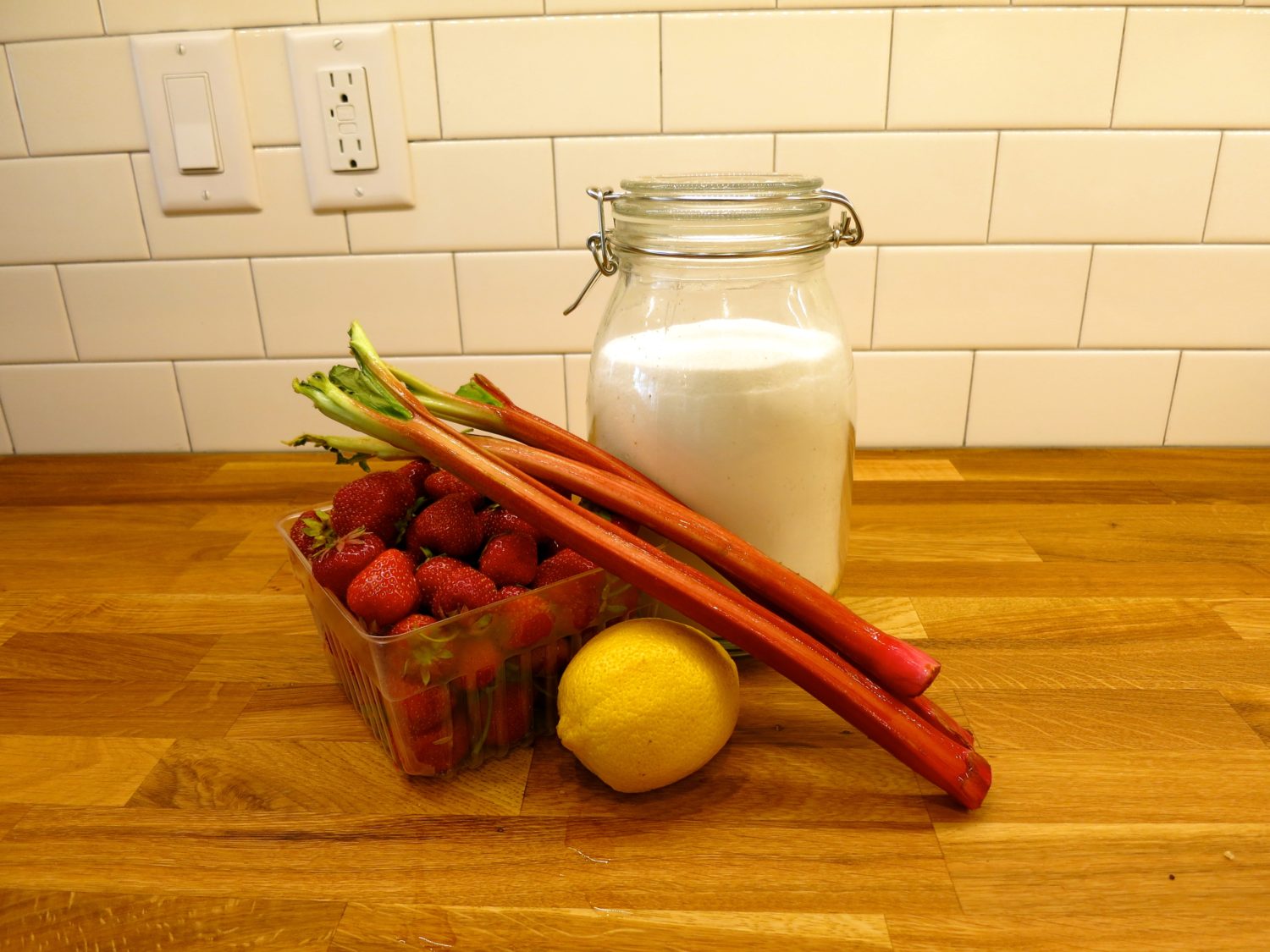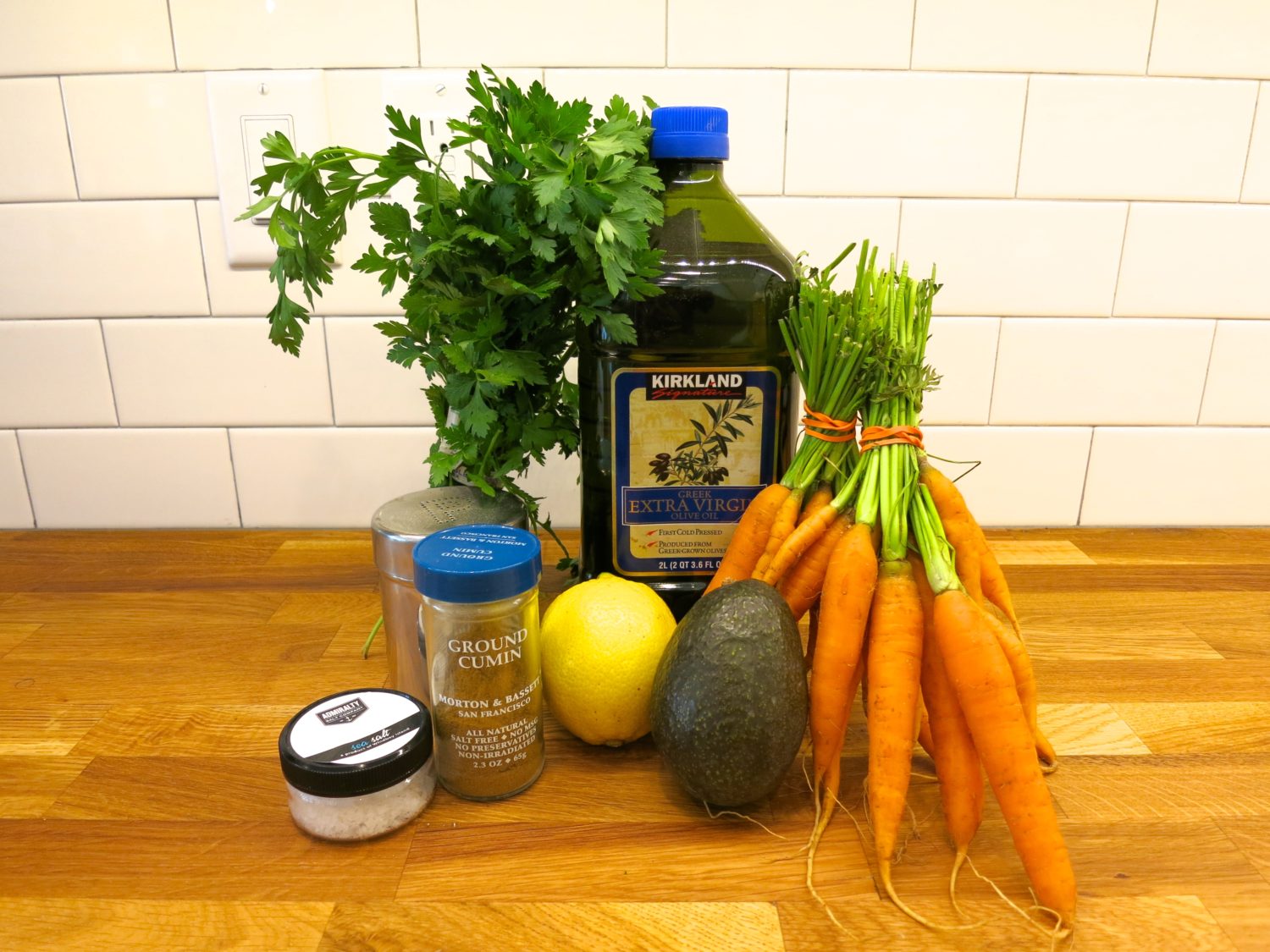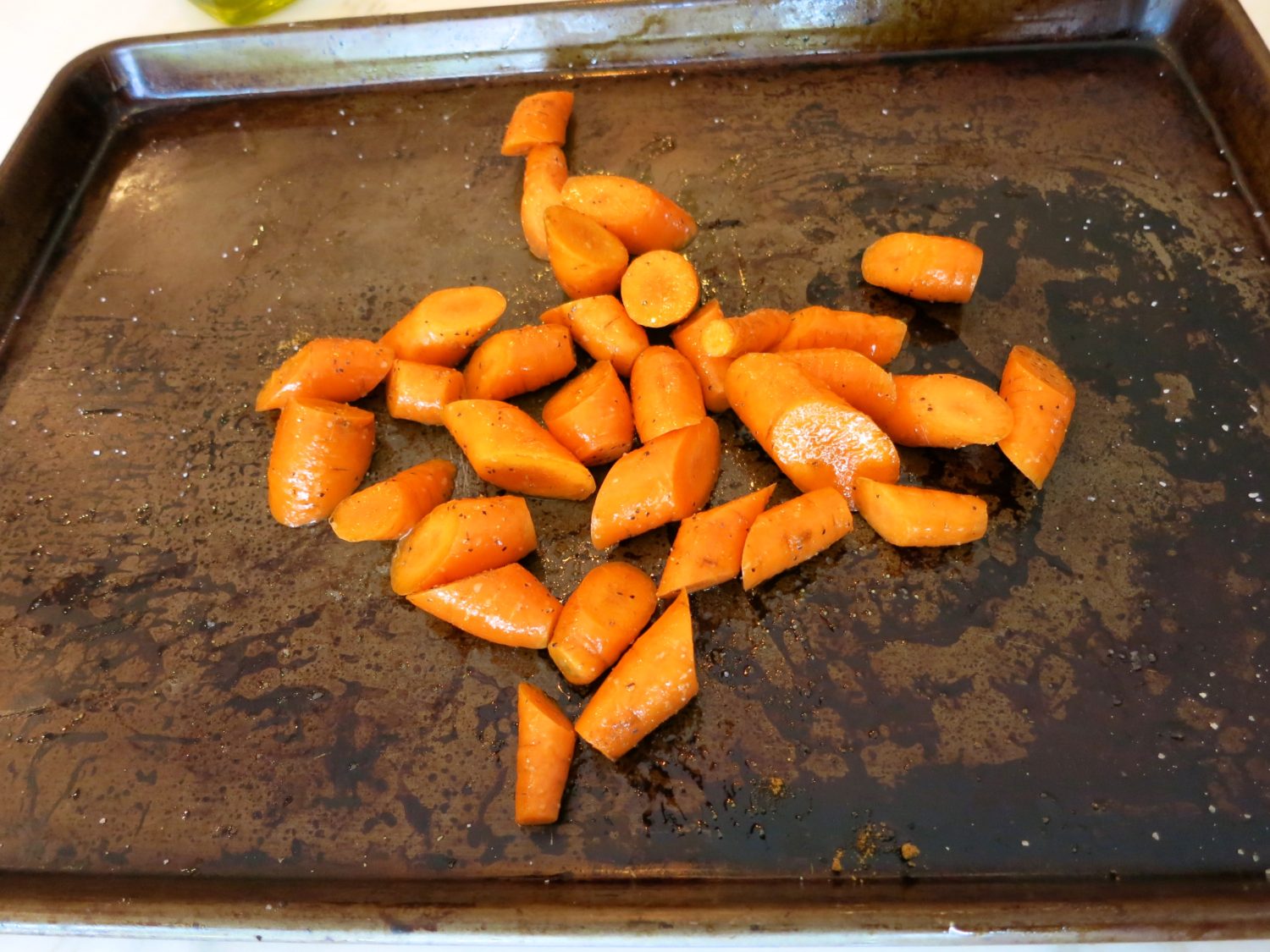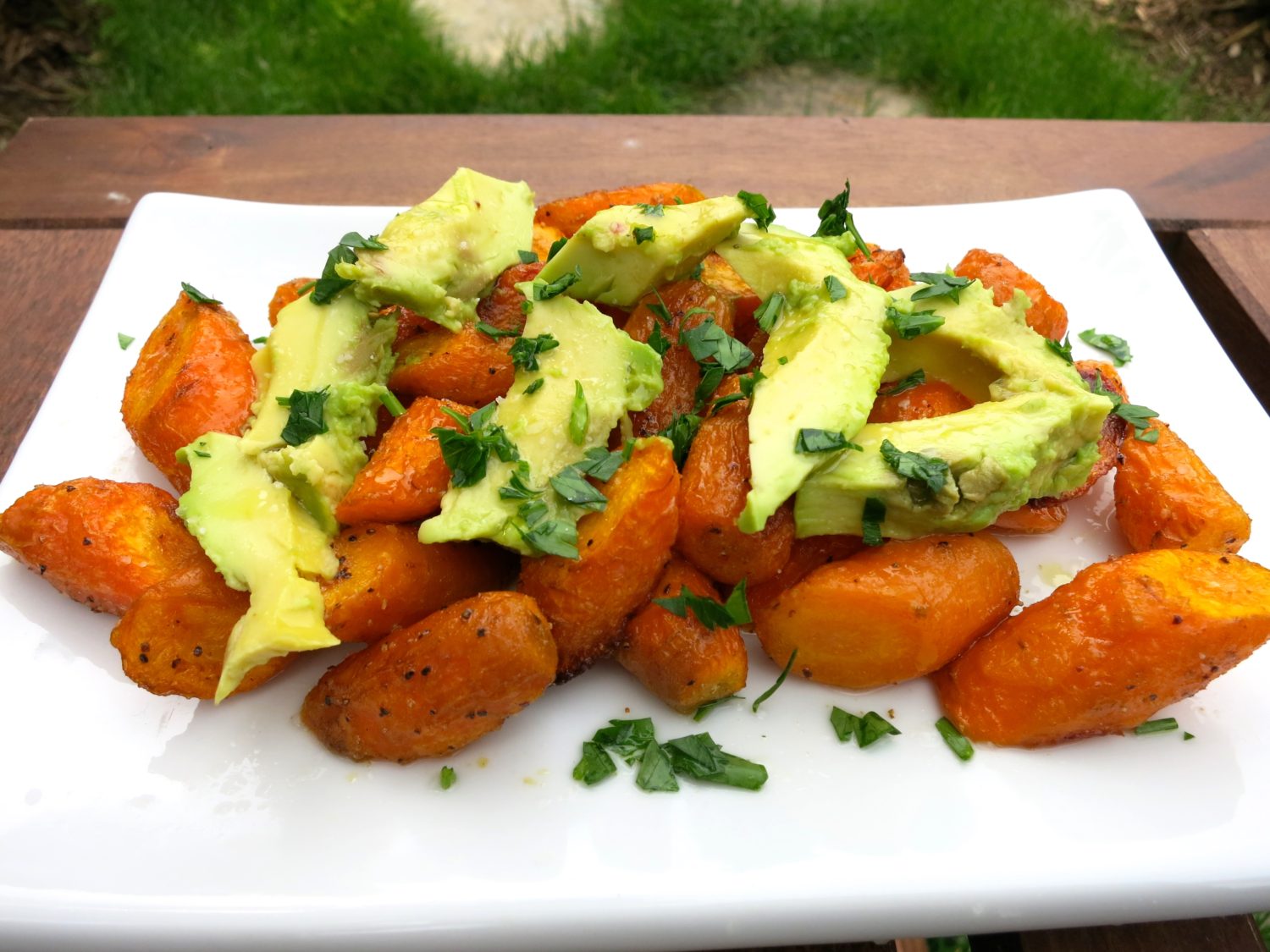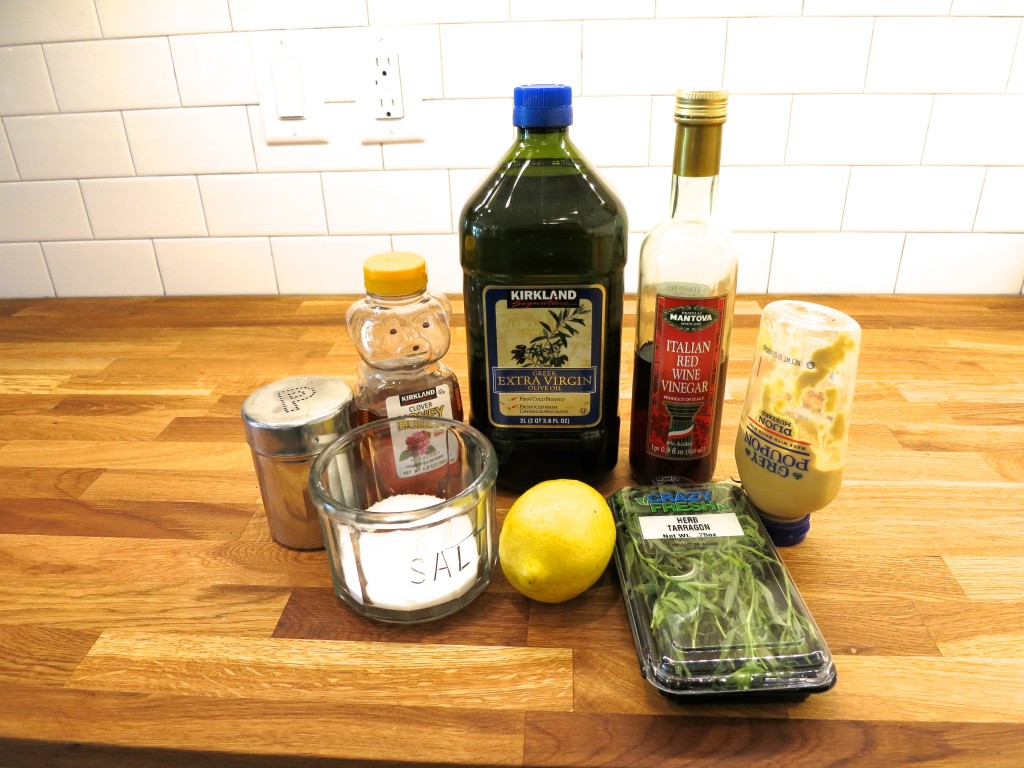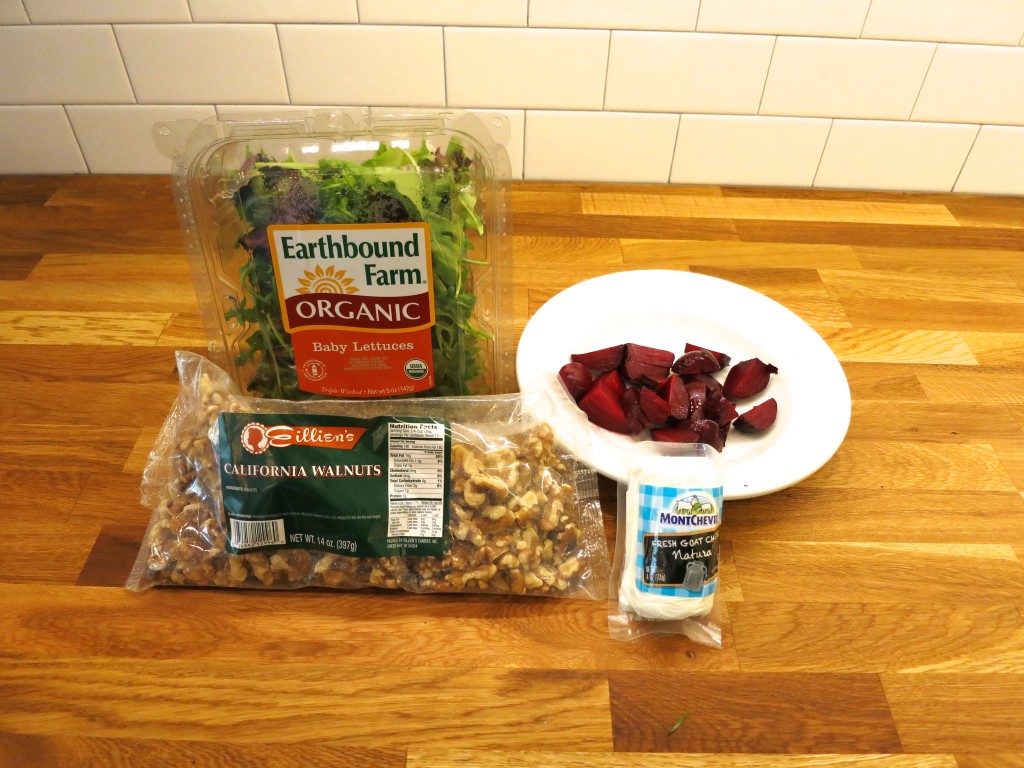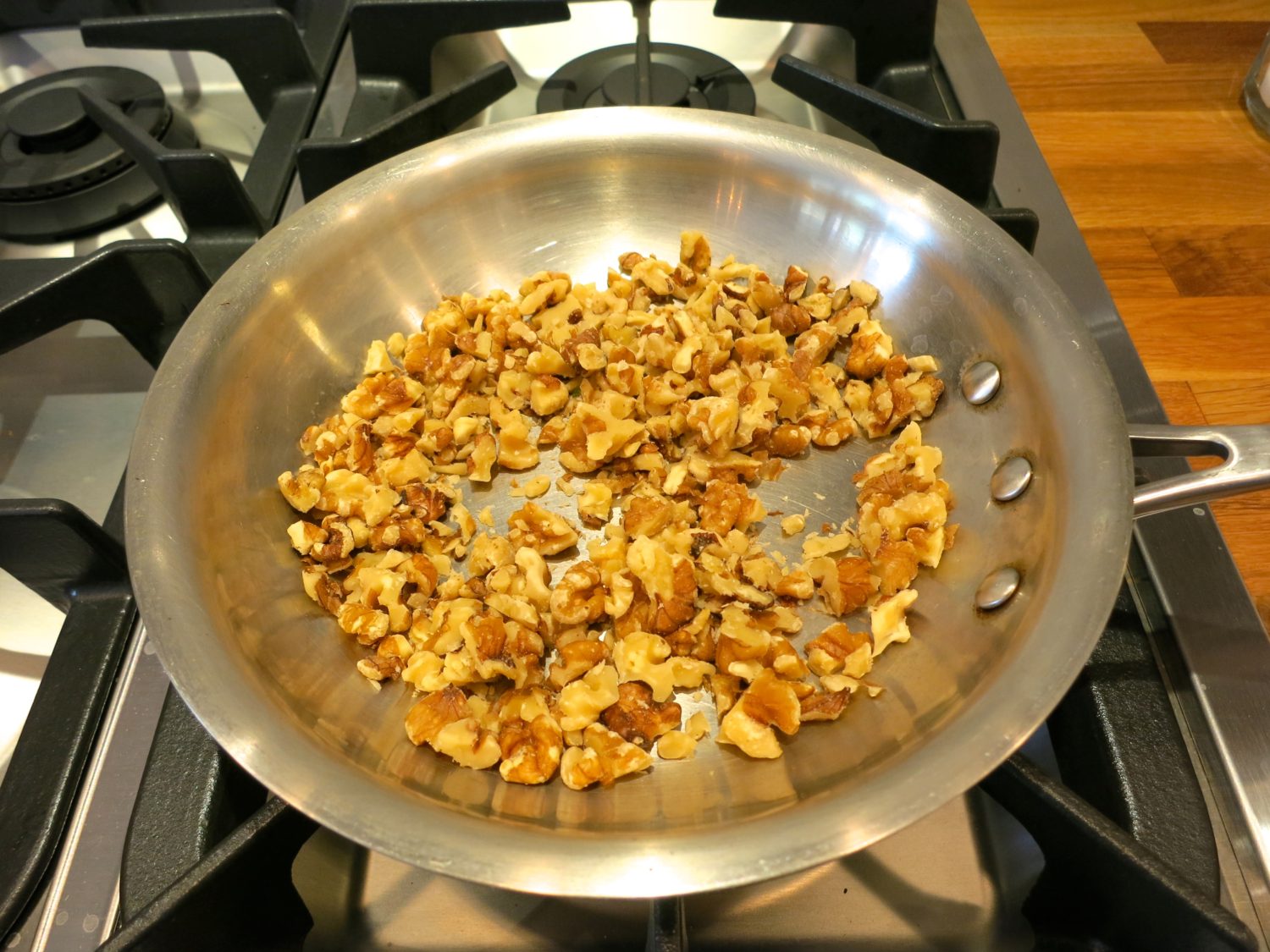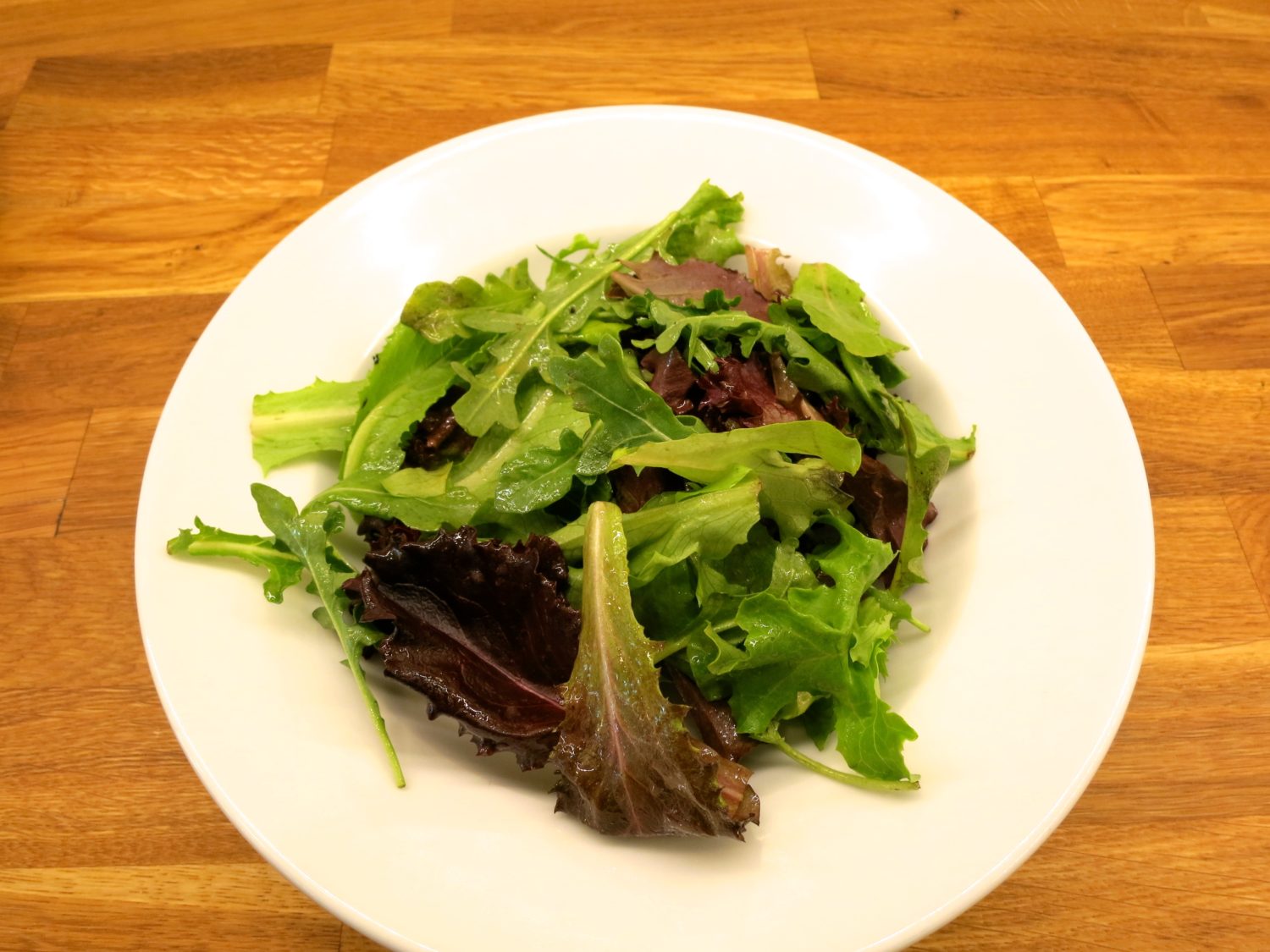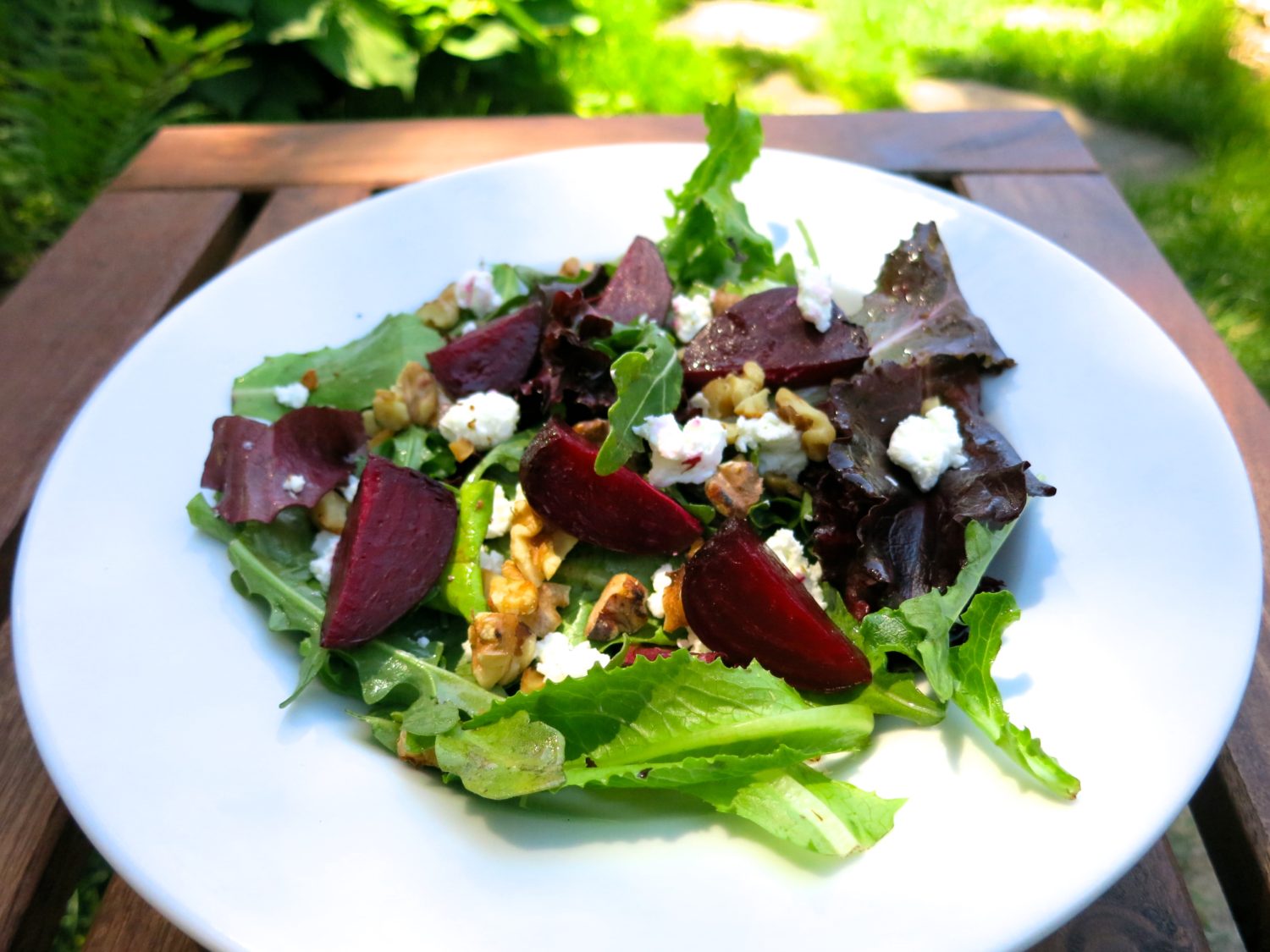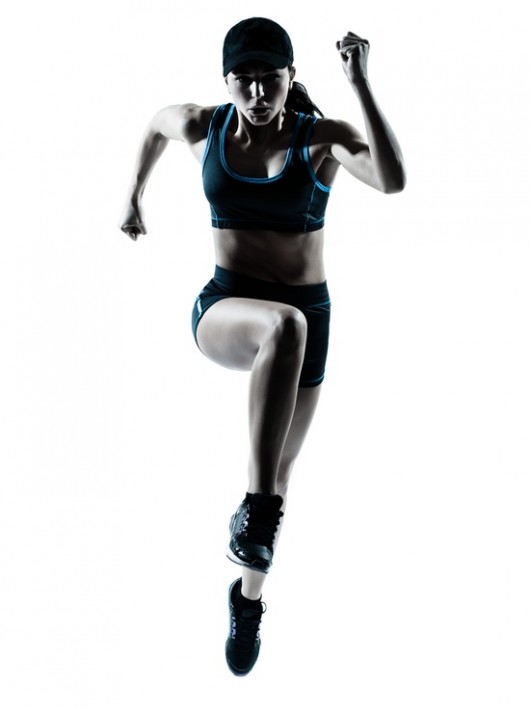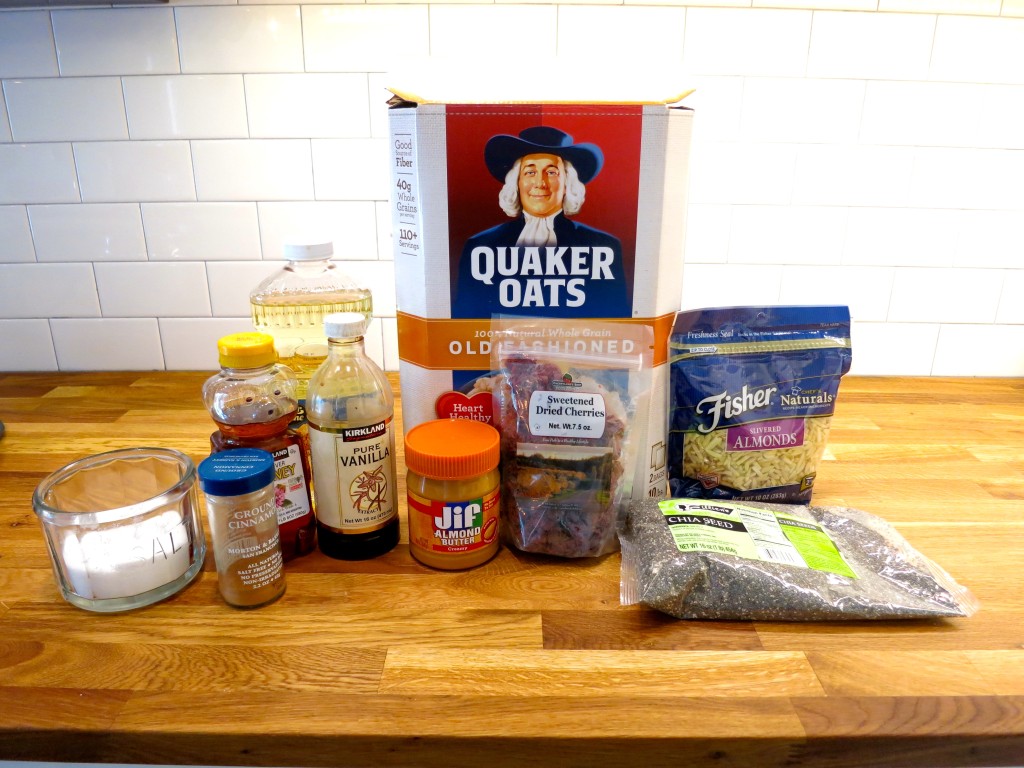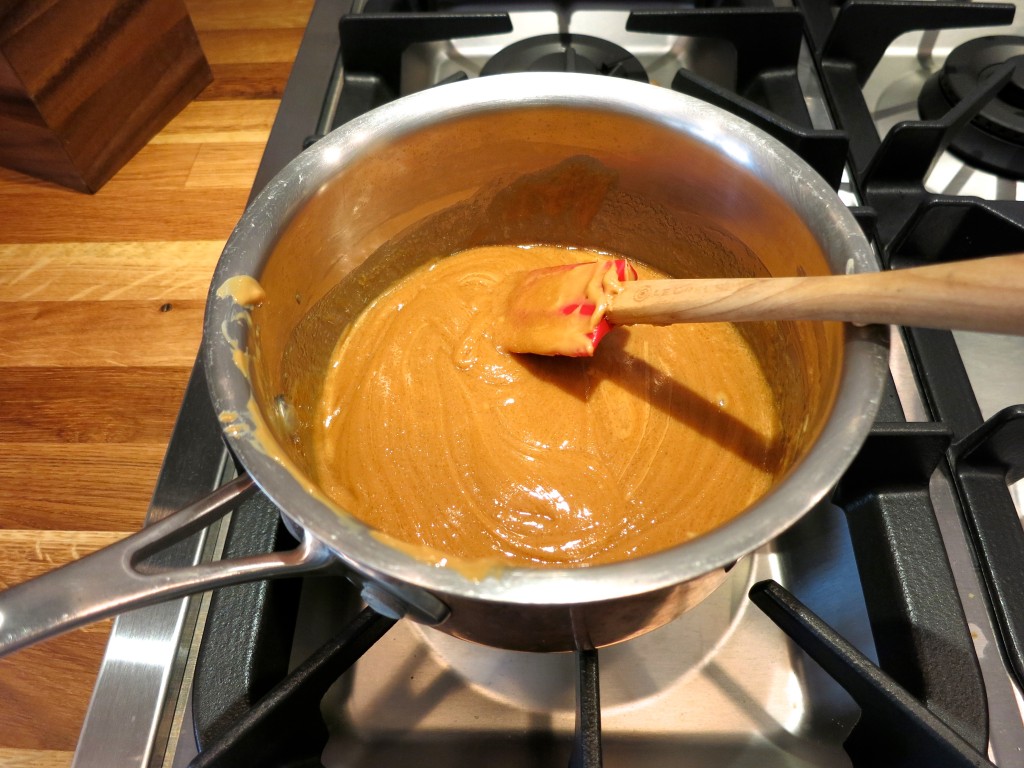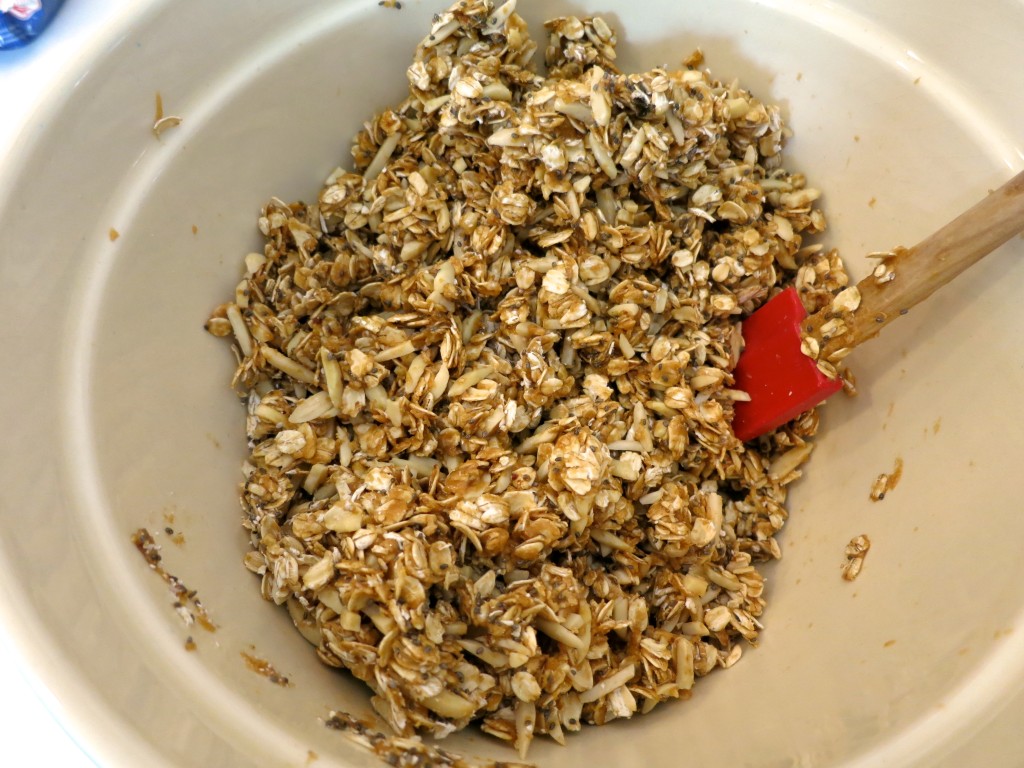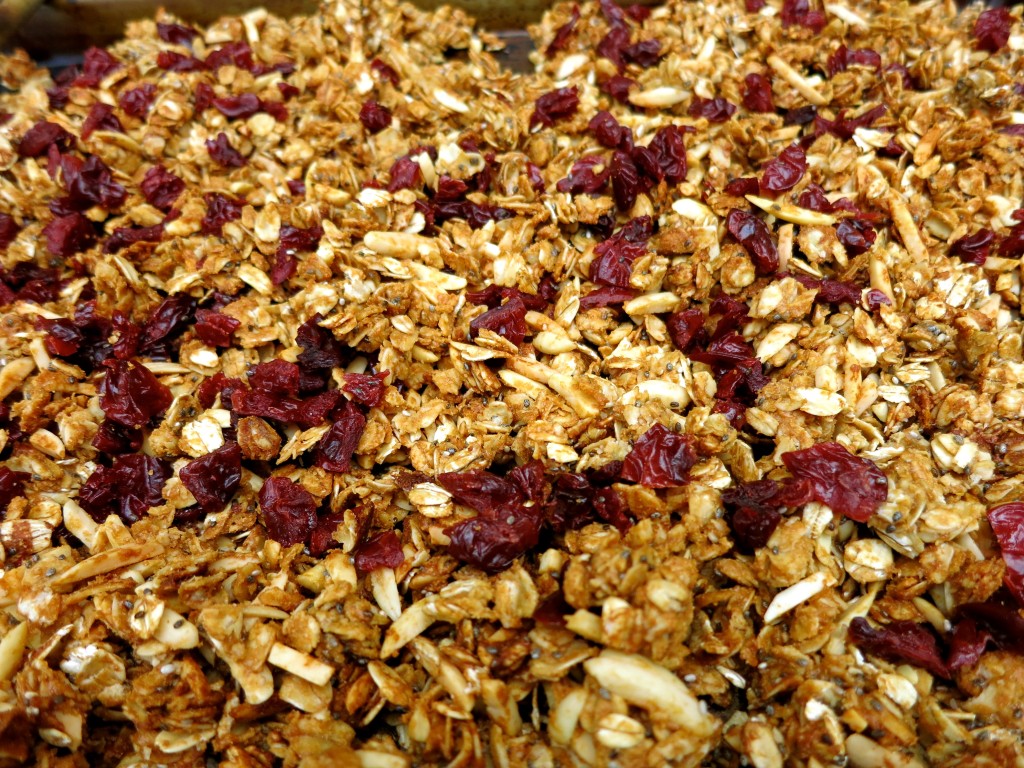Request an Appointment
Testimonials
How pregnant and postpartum women can benefit from treatments aimed at reducing the effects of Diastasis Recti Abdominus (DRA).
Diastasis Recti Abdominus (DRA), often referred to as abdominal separation, is a common condition that many women face during or following pregnancy. It can lead to discomfort in daily activities and changes in body appearance which can cause frustration in postpartum recovery. DRA is defined as the separation of the rectus abdominus, also known as the “six pack”, that runs along the abdominal wall. Certain factors in a woman’s pregnancy can also play a role in the likelihood of developing this condition. These risk factors include:
- Multiple births
- Multiparity
- Older maternal age
- High maternal weight gain
What DRA looks like
DRA is most prevalent in pregnant women and postpartum women, but this condition can also occur in infants, postmenopausal women, and men. It is usually seen as a bulging around, above or below the midline of the abdomen. Lower back pain, constipation, or bloating can also be indicators of the abdominal separation occurring. DRA is most noticeable when engaging in activities, like something as simple as getting out of bed, where the abdominal muscles are used.
Women, actively pregnant or postpartum, are more susceptible to DRA as the baby develops and the body adapts via internal organ movement or expansion (like the uterus) and the stretching of nearby muscles. In an article from Healthline, “One study found that up to 60 percent of women may experience diastasis recti during pregnancy or postpartum”. Symptoms of DRA can follow a new mother long after the birth of her child which can incite complications and irregularities in daily functioning.
Why Physical Therapy is so important
Supporting your body during pregnancy and after birth is essential in maintaining the natural flow of your body mechanics. Regular exercise during pregnancy is one way in which a mother can prepare her body for the changes that pregnancy demands, and it also has the added benefit of reducing the chance of developing DRA. Should a woman develop DRA during their pregnancy or after the birth of their child, then physical therapy is the next important step in your recovery. PT can help reduce the effects of DRA, like a bulging abdomen or discomfort, which can help return your body back to its prior level.
What Peak can do for you
Although abdominal support bracing and binders are additional ways to help ease the effects, it is not enough to just manage your DRA. A specialized abdominal program will significantly transform the outlook of your diagnosis. Our physical therapists have developed abdominal training guidelines that will be tailored to your body. There are three key features in our program which dramatically reduce DRA:
- Activation of the transverse abdominus muscle
- Resistance training of the rectus abdominus
- Resistance training of the obliques
If symptoms and separation do not improve after consecutive physical therapy treatments, then surgical intervention, often considered an elective surgery, may be an option. At Peak Performance, our physical therapists will ensure you receive the best possible care to reduce the effects that DRA has on your body. Your mobility, your health, and your comfort are our top priorities.
Contact us today to see if physical therapy is right for you!
Recovering from a sports-related injury or loss of muscle mass after surgery doesn’t have to be overwhelmingly strenuous on your body with Blood Flow Restriction Rehabilitation! Research has shown that it is possible to strengthen muscle after a time of inactivity with low load training versus the typical assumption that muscular hypertrophy (growth) is only achieved through heavy lifting.
How is that possible?
With Blood Flow Restriction Rehabilitation (BFR)!
Studies have found that patients who are recovering from an injury or surgery benefit from lighter exercises aided by a restrictive agent. The reduction of blood flow stimulates and tricks your muscle into thinking it’s working harder than it really is (smart, right?).
So, how does it work?
Blood Flow Restriction Rehabilitation utilizes light weight exercises with the addition of a tourniquet cuff to stimulate and strengthen your muscle while simultaneously fighting anabolic resistance. Anabolic resistance is defined as “the condition in which a limb in a period of disuse, such as after surgery or injury, reduces protein synthesis specifically within that limb” (Glover 2008). This resistance is often the cause of frustration for many patients. Muscles, in the recovery phase of an injury or post-operation, struggle to combat the dormancy stage they were previously in, leading to slow progress and unsatisfactory results.
The reduction of blood flow to the extremity, along with the movement of the exercise, causes a build up of lactate to occur which has many positive effects on your muscle. After a session of BFR, the accumulation of lactate creates:
- An increase in muscle protein synthesis
- Anabolic muscle growth factors
- An increase in Growth Hormones, Insulin like Growth Factor, and Myogenic Stem Cells
The restricted blood flow induces muscle swelling which leads to the initiation of protein synthesis, thus allowing hypertrophy to occur. Compared to weight training without a tourniquet, BFR manipulates the body’s normal chemical processes associated with muscle growth.
Who does it benefit?
Blood Flow Restriction Rehabilitation is an extremely beneficial choice of therapy for patients recovering from any injury where muscle mass was lost. This could include recovery time for a sports-related injury or even the downtime that occurs after an operation. It is common for people with ACL tears, knee replacements, and rotator cuff injuries to seek this treatment in order to strengthen the muscle for future activity. The low intensity, low weight exercises work to create positive muscle growth without stressing the recovering muscle.
Are there side effects to BFR?
As long as BFR is performed properly and by a certified professional, there should be no substantial or long-lasting effects. Besides some slight bruising or possible tenderness in the area where the tourniquet is applied, no potentially harmful or life-threatening injuries should occur.
What are my next steps?
Don’t wait to seek help in your recovery journey, contact Peak Performance Physical Therapy to learn more about how BFR can benefit you! Muscle recovery IS possible after an injury or surgery, and you can see results sooner than you think. With Blood Flow Restriction Rehabilitation (BFR), muscle growth and strengthening can be initiated with low weight exercises and a tourniquet system to ensure your muscles are returned to the strongest, healthiest condition achievable without the risk of further injury.
A woman’s body is capable of remarkable things- pregnancy being one of the most awe-inspiring of them all. The ability to adapt, support, and provide nourishment from the moment of conception to the moment of childbirth is an incredulous feat. But with the changes that the body goes through during a pregnancy, comes the discomfort and pain that you may experience during those nine months.
About four years ago we published a blog post about physical therapy during pregnancy, and as it becomes more popular we thought we would take the time to expand on some of that information – like the root causes of pain during pregnancy, benefits of PT, and what to expect in a session. In this new post, we will also hear from an actual patient who utilized PT sessions at Peak Performance both before and after delivering her baby.
One of the great things about physical therapy is that it is common for sessions to be covered by your insurance! This takes the financial burden off of the expectant mother, allowing her to fully embrace her physical therapy journey as she adapts to her evolving body.
Before we dive in, here is a quick look at some of the main points from our previous blog post, which you can find here:
- Seven out of ten women experience lower back pain during pregnancy
- PT is a medically based profession so most medical insurance plans cover the cost of a session
- Hormonal fluctuations cause ligaments to relax, leading to changes in posture which can cause pain in the pelvis, hips, or back
- Weight gain and changes in the center of gravity add stress to the lower body
PT During Pregnancy
In prenatal mothers, a major cause of pain and discomfort comes from the added weight put on as the baby grows and develops. In a domino effect, the center of gravity changes, as well as the woman’s posture as her body responds. This can then put stress on the lower back, as well as the pelvic floor muscles, which is a common problem in moms-to-be. In an article from Intimina, they write that “During pregnancy the pelvic floor supports the extra weight of the baby, and then it helps in pushing the baby through the vagina during childbirth”. Pelvic floor strengthening exercises are one of the ways in which Peak Performance works to prepare women for the strain that pregnancy and childbirth have on their body. These sessions are tailored to each individual woman to assist in maintaining the strength of those muscles.
To address the weight and posture changes that arise during pregnancy that can cause lower back pain and decreased flexibility, sessions can include stretching, abdominal strengthening, bracing, postural education and exercises, and much more! There are other ways to address the pain you are experiencing as well. On our Physical Therapy and Pregnancy page you can also find tips and advice on how to adjust to your changing body in addition to attending PT sessions.
Physical Therapy after Childbirth
In postpartum mothers, we recommend attending at least one to two PT sessions to rehab the muscles after the trauma of labor, and the pregnancy as a whole. If the birth was by means of vaginal delivery, mothers can start as soon as 2-4 weeks post-birth, and if it was a cesarean delivery, new mothers can attend 4-6 weeks post-op (if given clearance from your medical advisor).
Physical therapy, postpartum, gives women a chance to get their bodies back to feeling, and moving great with daily and recreational activities. A large part of that recovery has to do with postpartum posture care and body mechanics. As a baby develops over the course of those nine months, so do the ways in which a woman functions. From sleeping, to sitting, to lifting, to physical changes that are difficult to see, there are many reasons why PT should be a necessity after childbirth.
Physical therapy sessions strengthen your muscles, boost flexibility, and reduce or eliminate abdominal separation that may have occurred during pregnancy which can help alleviate some of the added stress on your spine. By strengthening your body, you ultimately provide the foundation for a faster, and more thorough recovery, meaning you get to spend more time with your newborn, without pain or discomfort.
Q&A Time with a Peak Performance Patient
 Hear from a real patient who attended PT sessions at Peak Performance during pregnancy and after giving birth!
Hear from a real patient who attended PT sessions at Peak Performance during pregnancy and after giving birth!
Q: How far into your pregnancy were you before experiencing any pain or discomfort?
“I was around 20 weeks or about half-way through my pregnancy when I started experiencing quite a bit of pain and discomfort.”
Q: How did you come across PT as a source for alleviating said pain or discomfort?
“Right before I began my third trimester, I had brought up to my OB how much discomfort and pain I was having at that point. I was seeing a chiropractor on a regular basis and it wasn’t helping to the extent I was hoping. She recommended PT and referred me to Nikki at Peak Performance.”
Q: If willing to share, what was the source of that pain or discomfort?
“A lot of the pain and discomfort stemmed from my lower back. I also had some pain in my third trimester that sourced from round ligaments.”
Q: Were you recommended by a primary care physician, OB/GYN, or other source?
“OB/GYN”
Q: How many sessions of PT did you attend? Were they covered by your insurance?
“I believe I attended around 12 sessions of PT during pregnancy. They were all covered by insurance.”
 Q: Do you feel that PT helped alleviate the pain you were experiencing?
Q: Do you feel that PT helped alleviate the pain you were experiencing?
“Yes, PT definitely helped alleviate a lot of discomfort and pain overall. Even when I had pain or discomfort flare ups, I was able to utilize the things I learned through PT to help alleviate those.”
Q: After giving birth, did you ever utilize PT for postpartum pain or discomfort?
“Yes. I have had issues in the past with arthritis/bulging discs which had actually gotten worse after pregnancy than they were prior to pregnancy. I was referred backed to PT by my rheumatologist around 8 months postpartum.”
Q: Anything else you feel would be beneficial for expectant or new mothers to know about PT for pregnancy?
“Don’t be afraid to talk to your healthcare provider during pregnancy and/or after about any pain or discomfort you are experiencing. Don’t hesitate to ask if they think PT would be a good option for you.”
To all the mothers out there: You have to care for yourself and your body first, in order to unconditionally care for your child!
Peak Performance physical therapy sessions are a proven way to decrease the pain and discomfort on your body during pregnancy or even strengthen your body postpartum. At the first sign of strain or affliction, talk to your primary care physician or OB/GYN about attending physical therapy sessions. And remember, physical therapy is a medically based profession so the likelihood of your sessions being covered by your insurance policy is very high.
Call (920) 738-0671 to book an appointment, ask questions, or see if physical therapy is something you could benefit from as an expectant or postpartum mother (chances are you will)! Or request an appointment online.
Special note: Thank you to Mikayla Sullivan, digital marketing student at the University of Wisconsin – Oshkosh for helping our team as the author of this blog post.
Our membership to the American Physical Therapy Association provides our team with access to their library of physical therapy podcasts.
There is one podcast that’s caught our attention because it includes the latest research by physical therapist and neuroscientist Joyce Gomes-Osman.
Osman and her research associates have concluded that when it comes to brain health, the overall and cumulative effect of physical activity is what’s most important.
The Benefits of Exercise on Brain Health
Podcast length: 38 minutes
If you struggle with a disability that impacts mobility, physical therapy is necessary part of your treatment plan. When your condition has no cure, a custom exercise program created by a certified physical therapist is more than a plan: it can be a life saver.
The Peak Performance Physical Therapy team has experience in helping patients with Postural Orthostatic Tachycardia Syndrome (POTS). This disorder, described as a malfunction of the autonomic nervous system condition, is starting to gain more attention in the medical community, thanks to with work of Lauren Stiles, founder of Dysautonomia International and Tori Foles, wife of Philadelphia Eagles MVP Nick Foles.
POTS syndrome patients are seeking treatment from physical therapists because research studies show 30 minutes a day of exercise three times a week can improve blood flow volume and circulation. For many patients, it can also improve mobility and stamina.
Emily, a 25-year-old teacher from Appleton, is a patient entering her second month of physical therapy at Peak Performance. She was diagnosed with juvenile onset Postural Orthostatic Tachycardia Syndrome (POTS) when she was 13 years old. She struggled with fatigue, headaches, lightheadedness, exercise intolerance and nausea. Exercise was extremely difficult for her due to her lower oxygen uptake.
Finding a physical therapy clinic who would treat her was difficult. She called several practices in the Fox Cities region who said they weren’t comfortable treating patient with her condition.
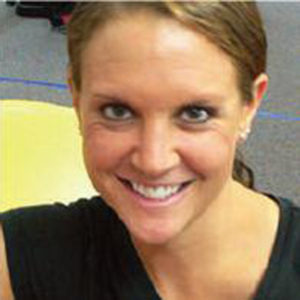
Peak Performance PT Molly Van Zeeland
Peak Performance physical therapist Molly Van Zeeland, embraced the opportunity to help. Her approach is to follow the Levine protocol closely.
Approximately half of the sessions with patients like Emily focus on endurance training, while monitoring her heart rate at all times. According to studies by Dr. Benjamin Levine, endurance training under the supervision of a certified physical therapist helps expand blood and plasma volume, increases cardiac size and mass and improves orthostatic tolerance.
Emily has seen improvements to her quality of life as a result of her experience with physical therapy. She started off well with Molly because her questions were answered in a manner where she felt comfortable with her therapist and plan. Here is a list of several topics covered, to help others with POTS syndrome find the right physical therapist for their needs.
Questions to Ask a Physical Therapist
- Will you have the same therapist for each visit? What is the level of commitment to learn about your specific POTS condition?
- How slowly is the therapist willing to work? For patients with POTS syndrome, slow progress is better than no progress!
- What is the POTS treatment protocol (make sure it aligns with your needs).
- How does the therapist help POTS patients work through anxieties?
- How will the therapist help set goals and meet them?
- Is the exercise equipment available to use at any time? At Peak Performance, patients can use our equipment, even after they are discharged.
- Are there other value-added insights your therapist brings to the relationship? Coping skills? Diet advice? Meditation ideas?
POTS Resources
- Wisconsin Facebook Support Group
- National Institute of Neurological Disorders and Stroke
- Dysautonomia International
- Dysautonomia Youth Network of America, Inc.
- POTSGrrl Blog
As more patients are correctly diagnosed with POTS syndrome, the Peak Performance team hopes to provide the opportunity to improve the lives of others.
Contact us to set up a free consultation.
![]()
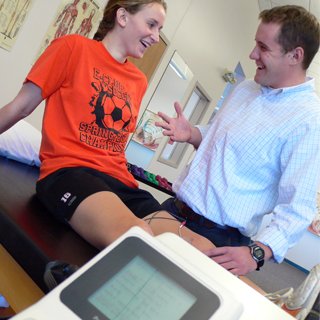 Did you know seeing a physical therapist can help you save money for your overall healthcare? If you have ever taken medications, had a surgery or needed imaging, you know the cost of care adds up quickly. Many of our patients find that by investing in physical therapy at our clinic they save money on medications, visits to doctors and procedures. We have even helped patients avoid surgery!
Did you know seeing a physical therapist can help you save money for your overall healthcare? If you have ever taken medications, had a surgery or needed imaging, you know the cost of care adds up quickly. Many of our patients find that by investing in physical therapy at our clinic they save money on medications, visits to doctors and procedures. We have even helped patients avoid surgery!
Our patient testimonials on our website and social media (Facebook. Yelp and Google) describe how our practice operational model helps patients save money. We focus on patient-centered and quality care. We don’t double-book appointments and patients receive 1-on-1 care with a licensed physical therapist. Our assessments are efficient because we stay current with evidence-based research and are well versed in multiple specialty areas.
Physical Therapy Costs Explained
Our team addresses insurance and financial questions during our first consultation with a patient. While every situation is unique, there are a few physical therapy cost questions we often address. For the benefit of our patients, we have answered three common questions in this blog post.
Q: My health plan does not provide physical therapy benefits. How can I receive physical therapy care?
A: Physical therapy should be a mandatory covered service as of 2015. We advise patients to call and check on their insurance benefits and ask their provider for Certificate of Benefit (COB) documentation.
Q: I have a co-pay on my health plan. How can physical therapy sessions be affordable for me?
A: We have a discussion with every patient on what would be affordable for them. We offer payment plans and take credit card as a form of payment. We also provide Care Credit.
Q: I need to pay cash for my physical therapy services. What can we do to address my physical therapy costs?
A: In addition to the payment options discussed in the previous question, we work with patients to develop a self-care plan. This process often reduces the additional formal sessions needed with a physical therapist.
Complementary Consultation Offered to Every Patient
Our therapists are committed to helping you feel better while respecting your concerns regarding physical therapy costs. Come in for a complementary evaluation with one of our licensed physical therapists to create a mutually agreed upon plan.
![]() Since 2001, the licensed physical therapists at Peak Performance have been committed to providing the best physical therapy care for patients after knee surgery for ACL reconstruction. Their approach focuses on getting to work on range of motion early. Kari Sturtevant, owner, says “There is only a window of time to work on motion, but all the time in the world to work on strength”.
Since 2001, the licensed physical therapists at Peak Performance have been committed to providing the best physical therapy care for patients after knee surgery for ACL reconstruction. Their approach focuses on getting to work on range of motion early. Kari Sturtevant, owner, says “There is only a window of time to work on motion, but all the time in the world to work on strength”.
Just what exactly is the ‘window of time’ to get started on physical therapy after knee surgery? Ideally, it needs to happen within the first week after ACL surgery. Peak Performance physical therapists work closely with a patient’s orthopedic team, typically following an accelerated therapy protocol developed by the Cincinnati Sportsmedicine and Orthopedic Center. Patients are in the office within 48 hours of their surgery!
Why do patients require physical therapy after knee surgery for ACL reconstruction?
There are several reasons why patients need physical therapy after ACL surgery. The licensed physical therapists at Peak Performance focus on helping patients retrain their body mechanics, which focuses on improving posture and coordination. Often, improper body mechanics can be a contributing factor that led to the injury in the first place.
A second reason is the likelihood of a successful transition to normal activities increases when a patient works with a therapist to successfully complete a rehabilitation protocol. The approach adopted by all Peak Performance physical therapists includes range of motion and weight bearing exercises, mobilization, modalities like Electrical Muscle Stimulation, stretching, balance training, strengthening, return to sports activities and conditioning.
The Stages of ACL Rehabilitation
The Cincinnati Sports Medicine Program includes five phases in the first twelve weeks of rehabilitation. Nikki Strick, licensed physical therapist at Peak Performance, describes the approach in three main stages for patients, as to not overwhelm them with treatment protocol. Nikki, like all therapists at Peak Performance, sees each patient from start to finish. This continuity of care is distinctive, as other practices may have aides or other therapists assigned to a patient.
FIRST STAGE: Quadriceps Activation/Range of Motion
The first stage for therapy after knee surgery is for the patient to regain range of motion and get the quadriceps muscles to function. Patients work on walking, knee flexion range of motion, isometrics and regaining full knee extension. This first phase can be tricky for some patients, especially if they have fibrous or scar tissue issues.
SECOND STAGE: Progress to Strength and Full Range of Motion
As patients progress through the accelerated ACL treatment protocol, range of motion continues to improve with a goal of at least 135 degrees of flexion. The continued growth in their relationship with their physical therapist becomes paramount. Regular weekly visits, as well as consistent follow-through for completing exercises at home increases the likelihood of the ability to be cleared for normal activities. Peak Performance offers use of their training facility for all patients free of charge during and after their treatment programs. Often, patients continue their exercises at Peak Performance because the environment is comfortable for them.
THIRD STAGE: Return to Sport for Athletes
Finally, Peak Performance works with athletes to return to their sport. This part of the protocol is unique to Peak Performance, as the team of therapists are the only ones to provide SportsMetrics in Northeast Wisconsin. The return to sport exercises and plyometrics for athletes decreases the possibility of re-injury.
Without a third stage for athletes, they may return to playing their sport too early. Nikki, who has successfully completed her own rehabilitation for both of her knees, can relate to the athlete’s desire to get back to playing as soon as possible. “I work with each athlete on awareness of their body mechanics. Together, we work on new patterns. It’s very individualized and I love helping them return back to their sport with confidence.”
To learn more about physical therapy after knee surgery for ACL reconstruction from Peak Performance, we invite you to schedule a complimentary consultation with a licensed physical therapist on our team. Contact us using our form or give us a call at 920-738-0671.
Peak Performance Experts Explain the Condition and How Physical Therapy Can Shorten the Recovery Time
Are you living with the following symptoms in your shoulder: stiffness, decrease in range of motion, inflammation and pain? You could have frozen shoulder, also known as adhesive capsulitis.
The condition known as ‘frozen shoulder’ got its name because the more pain that is felt, the less likely a shoulder will be used. This lack of use causes the strong connective tissue surrounding the shoulder joint to become thick, stiff and inflamed. Without a proper physical therapy protocol designed to loosen the tissue, the shoulder can remain ‘frozen’ for up to three years.
Brad McMahon, licensed physical therapist with Peak Performance, is a recognized resource for helping patients improve their frozen shoulders in a matter of months. His approach centers on a patient-centered treatment protocol and close relations with orthopedic surgeons and primary care physicians.
He states, “The first thing patients need to understand is what frozen shoulder is and when symptoms can arise. Frozen shoulder can happen after a surgery or fracture, but that is not always the case. The key is to make the proper assessment and not irritate the shoulder when it’s in the freezing stage. At any given time, up to fifty percent of my cases are patients with shoulder injuries, so it really comes down to my collective experience in properly identifying the condition and delivering the right treatment protocol.”
Brad’s patients each have a different set of circumstances that led to their frozen shoulder condition. The common thread among them is the need for physical therapy to help relieve the shoulder pain. Frozen shoulder does not go away quickly on its own.
In order to help our patients understand what frozen shoulder is, we walk them through the definitions of the three stages. As their physical therapy partner, our goal is to help them get to the recovery stage as quickly as possible.
The ‘freezing’ stage:
In this stage, the shoulder becomes stiff and is painful to move. We assess the severity with a measurement tool called a goniometer. We measure shoulder flexion, external rotation in two positions and internal rotation.
The ‘frozen’ stage:
In this stage, pain may lessen, but the shoulder remains stiff. This makes it more difficult to complete daily tasks and activities. When the shoulder is frozen, the key is to help them with proper mobilization at our clinic. It is important for our patients to know and respect that strengthening exercises are not part of a treatment protocol during this stage!
The ‘thawing’ (recovery) stage:
In this stage, the pain lessens and ability to move the shoulder slowly improves. Once motion is full, we add rotator cuff strengthening and scapular stabilization exercises.
At Peak Performance, we take great care in knowing each of our patient’s history and develop a frozen shoulder treatment plan that is achievable and sustainable for them. The results are best described by our patients.
Betty recently completed her physical therapy program for frozen shoulder with Nikki Strick, licensed physical therapist with Peak Performance. Her shoulder stiffness began about a year ago. Her orthopedic surgeon referred her to Nikki about three months ago. Through her commitment to doing the exercises Nikki taught her, she has full range of motion back in her shoulder. She states, “The care I received was so helpful; if I couldn’t do one of the exercises, Nikki would find an alternative way of doing things. She is great!”
If you or someone you know could benefit from a frozen shoulder assessment, contact Denise or Paula (patient care coordinators) at (920) 738-0671 to schedule a free 15-minute injury consultation.
This blog likes to pride itself on not following trendy fads while also emphasizing a healthy lifestyle. Something caught my I eye that other day while I was cooking. I often use diced frozen onions in recipes, they’re convenient, but mainly it’s because chopping onions makes me cry horribly and leaves me with mascara smeared raccoon eyes. Anyways, I was checking out the packaging on the onions. It had the usual phrases, “No Additives” and “Cholesterol Free”, but then I was struck by one that seemed out of place: “No Sugar Added”.

Is this a real concern? Is there an insurgence of sugar laden onions on the market? Maybe we haven’t gone as far as candied onions, but our society has become overloaded with sugar and most of it is hidden in plain sight.
It’s no secret that sugar is harmful to your health. Over consumption of sugar can lead to diabetes, heart disease and exacerbate auto-immune diseases. The American Heart Association recommends no more than 6 teaspoons of sugar a day for woman, 9 teaspoons for men and 3 teaspoons for children. Unfortunately the average American eats about 25 teaspoons a day or averages about 2 pounds of sugar consumption a week. Here’s a link that goes a little more in depth: Sugar Intake Recommendations
Remember when there was a cereal called Sugar Smacks?
I can respect a product like that because you knew exactly what you were going to get, they weren’t trying to hide anything. I miss the honesty of those days.
You try to eat healthy, but as I’m sure most of you are aware sugar is hidden everywhere. It’s a cheap additive to make products more delicious. Avoiding hidden sugar can be tricky.
READ LABELS: You may think that you are shopping smart by purchasing healthy products like low-fat yogurt, but it’s important to read labels. Low-fat or fat-free versions of food usually contain more sugar than their whole fat counterpart to make the product taste more appealing. Fat-free mayo is another perfect example of this, the “diet” fat-free version can contain up to 10 times the sugar content as the full fat version. I’m not using this example as a licence to blow off eating healthy and eat full fat everything, but rather a cautionary tale to educate yourself.
Other labels worth reading belong to meal replacement and protein bars. On the surface they seem like a healthy option when you are trying to eat on the run or needing a pick me up after a work-out. Again read the label, some of these bars are packed with so much sugar you would have thought you hit up the candy bar rack.
CUT BACK: Yes, it’s perfectly acceptable to treat yourself, but be aware of what you’re putting in your mouth. Maybe you have a habit of getting through Monday morning with a large blended coffee. Do your research, the frothy deliciousness can hide a ton of sugary syrups that pack upwards of 20 teaspoons of sugar in your cup-that is the equivalent of drinking a liter of cola. I’m sure your intent was not to sit down and consume 4 times the daily recommended amount of sugar, but unfortunately that is what’s happening. You can still have your coffee treat, but make sure you know what you’re consuming.
I admit that I’m a creamer junkie. I never went for the crazy flavored creamers, instead opting for the “healthier” all natural, no-additive Sweet Cream. One day I realized I was going through a lot of creamer. I began to think, how many calories and sugar am I adding to my morning ritual?
When cutting down on anything, especially sugar, it’s hard to go cold turkey, you often dislike the radical change and go back to your old habits. I found a tip, in I Quit Sugar by Sara Wilson, to first cut your creamer intake by half and substitute milk for the other half. From there you can continue to step down. I was skeptical at first, but quickly realized I didn’t miss my sweetened creamer. I might even be a black coffee drinker before long. 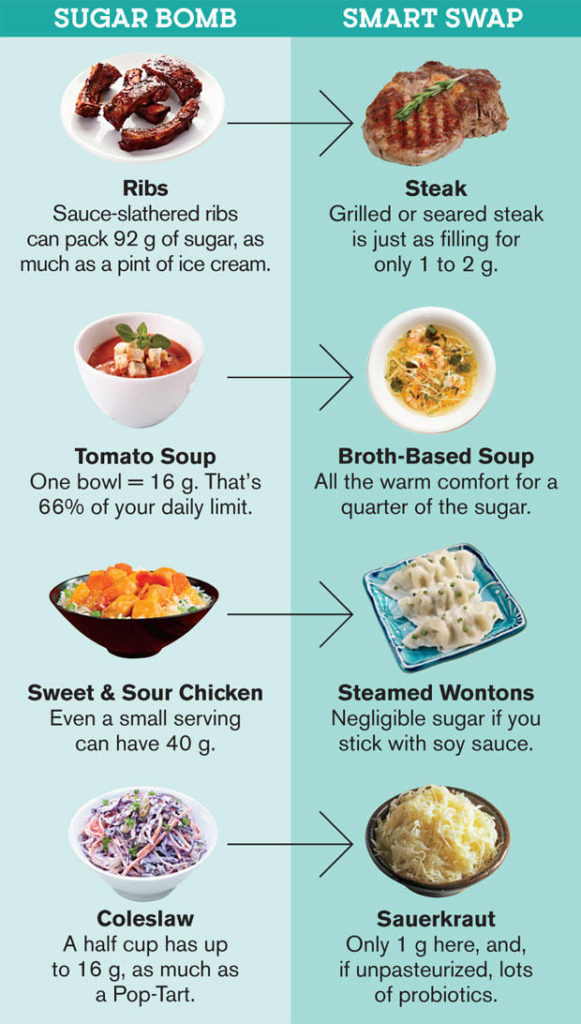
SUBSTITUTE: Eating out can be another area where avoiding sugar can be tricky. Don’t feel that you can’t go out and have healthy enjoyable meal, but why load up on hidden sugar throughout the meal when easy swaps can be made. This chart of easy swaps, from Prevention, can help you avoid some of the land mines.
Sugar consumption is a lengthy topic that I just scratched the surface on. Hopefully you will take away the key points of educating yourself on what you’re putting in your body and reducing your intake. After cutting back on sugar, you may find yourself feeling better, more energetic and possibly lose a few pounds.
Some of the resources I found helpful while researching this topic were:
I Quit Sugar by Sarah Wilson
https://www.healthline.com/nutrition/14-ways-to-eat-less-sugar
By: Kari Sturtevant, DPT, OCS, President / Physical Therapist
About a year ago, our team of physical therapists at Peak Performance decided to start a patient referral program. The program we created is simple. For every referral that schedules and physical therapy appointment and then becomes a patient, we provide a gift card from a local business to the person who referred.
Within the first few months of launching the program, we began to notice a common pattern of behaviors among patients. They referred the people in their closest inner circles: their spouses, parents, children and best friends.
We started to talk among ourselves about this discovery. What did we do as therapists to earn a level of trust that led them to referring people they care about? Was it the physical therapy, the relationship, or a delicate balance of the two? We didn’t know the answer, so we turned to our patients to learn what is important in physical therapy care.
After a patient received a gift card, we asked them to share their reasons for recommending us. Here are a few common themes that surfaced as we talked to people who referred.
Full Physical Therapy Appointment: Our patients appreciate knowing their appointment won’t be cut short by any interruptions. They describe the time they spend with their therapist as a ‘full physical therapy appointment’, with quality one-on-one time and complete attention to their needs. Our team also provides a full appointment in forty-five minutes when the industry norm is sixty. For patients paying for sessions out-of-pocket, this means they receive more value for their investment. One patient even said, “This is not a money hungry facility, but one that actually cares and treats patients at a high-quality level.”
Specialization: Our therapists cover the full spectrum of physical therapy, as well as specialties. This means we can tap into our expertise for the benefit of all patients. For example, a patient was receiving therapy from Brad McMahon for her shoulder. She also described her issues with severe headaches. Brad recommended a specialty, dry needling, which provided relief and eliminated her need for medications. This patient has shared her experience on social media and has referred several friends to the practice.
One Clinic Location: As a mid-sized practice with one location, our therapists can be aware of every person who comes to the practice. Our patients described how they liked how the entire team knew their names and a little about them. We use our one-clinic location as a point of difference and have discovered that they will travel for the best care. As one patient states, “I live two miles from another physical therapy clinic. I drive 82 miles from Green Bay to Peak Performance twice a week because the staff is awesome.” Other patients describe our clinic as professional (comfortable) environment and a staff with impressive credentials.
We are so fortunate to have developed a level of trust with our patients that encourages them to recommend people who are important in their lives. Now that we know the reasons behind their referral, we can say with confidence that we are recommended by family and friends you know and trust!
To schedule a physical therapy appointment, contact Denise or Paula (patient care coordinators) at (920) 738-0671.
A year ago I wrote a piece about the Loop the Lake Project in Neenah and Menasha. Recently I’ve seen several yard signs in my neighborhood reading, “I support the Loop Lake Project” and it got me thinking, where are they on that project?
In April the project had a setback when the construction bids came back $800,000 higher than the $3.2 million dollar budget. The Loop the Lake supporters as well as the cities of Neenah and Menasha have some ideas to close the gap.
A little background, the original $3.2 million budget comprised of $1.6 million coming from a state grant, $1 million from private donations, and $300,000 each from Neenah and Menasha. 
The last time I was at the Neenah Farmer’s Market the Future Neenah sign showed that they have almost reached their $1 million dollar goal. They are still collecting tax deductible donations, contact Future Neenah for more information.
So how do they close the gap?
According to the Appleton Post-Crescent, “Neenah and Menasha leaders worked with state lawmakers to include and an additional $400,000 in the 2017-19 state budget.”
They are still waiting for the bill to pass…
The rest of the gap will need to be filled with a combination of additional donations and local funds. When the funding is in place the construction can begin, hopefully spring of 2018.
Did you know 15% to 20% of adults will experience low back pain this year? Another 50% to 80% will have least one episode of back pain during a lifetime. That is what a study at the Mayo Clinic College of Medicine in Rochester, Minnesota confirmed ten years ago.
Thankfully, physical therapists are adopting an early intervention approach based on clinical practice guidelines to give patients with low back pain quicker access to treatment. This protocol is showing signs of better patient outcomes and lower healthcare costs and utilization.
Last month in Milwaukee, Dr. Paul Reuteman, a highly regarded clinical professor at UW La Crosse, shared research and techniques to help physical therapists formulate treatment plans for patients who choose to treat their lower back pain. Miles Weber, physical therapist at Peak Performance, participated in this seminar.
Weber encourages patients with low back pain to try physical therapy as their first defense to combating their issues. A self-referral (contacting the physical therapist practice directly) is less complex than a medical visit. It can also result in fewer visits overall and reduce costs up to 250%! *
Why is physical therapy effective for low back pain? Reuteman and others advocate the use of subgroup classifications before developing a treatment plan. This begins with understanding how the patient is presenting from both a physical and psychological perspective. Weber utilizes his educational background in psychology to understand not only the functional setbacks low back pain is causing, but the emotional ones as well.
Weber develops a rapport with patients by taking the time to let them describe their low back pain in their own words. Early intervention can be effective when someone begins to notice low back pain, pain down their legs or simply cannot get out of bed easily.
“As a licensed physical therapist, it’s my responsibility to attend continuing education seminars by practice specialty experts. It keeps my skills sharp and provides an interactive forum with peers to listen to the descriptions provided by experts in lower back pain. After attending this seminar, I am excited to apply what I learned to help our patients,” states Weber.
To schedule a consultation with Miles for your low back pain, you can use our online contact form or call us at (920) 738-0671.
* Source: Journal Health Services Research, Julie M. Fritz, PT, PhD, FAPTA, Gerard P. Brennan, PT, PhD, and Stephen J. Hunter, PT, PhD, OCS
Meal prep is a great idea for a number of reasons-convenience, cost effective and keeps you eating healthy. Hopefully you will enjoy trying out these lunch bowls.
I am the first to admit that I’m kind of a procrastinator. I’m not the pack your lunch the night before kind of girl. I have the best of intentions in the morning, but then it turns into me doing the math on how much of my morning routine can I sacrifice to stay in bed an extra 10 minutes. Unfortunately this spills into my lunch prep time and I’m usually left grabbing odds and ends on my way out the door or diving into the delivery menus.
How do I break this cycle? Meal prep
I am going to try the following two recipes and see if I can break my pattern. Not only are the these recipes easy, they’re also healthy and sound delicious.
I took this recipe from a Buzzfeed video that popped up on my Facebook feed. Sometimes I see the videos that pop-up and think “Does anyone ever make these? Especially the crazy complicated ones?” Well this one seems very easy and doesn’t require a lengthy time commitment. These recipes can be made simultaneously and the dressings can be made while the veggies are baking.
Vegetarian Grain Bowls
Roasted Chickpea & Veggie Brown Rice Bowl with Lime Cilantro Dressing 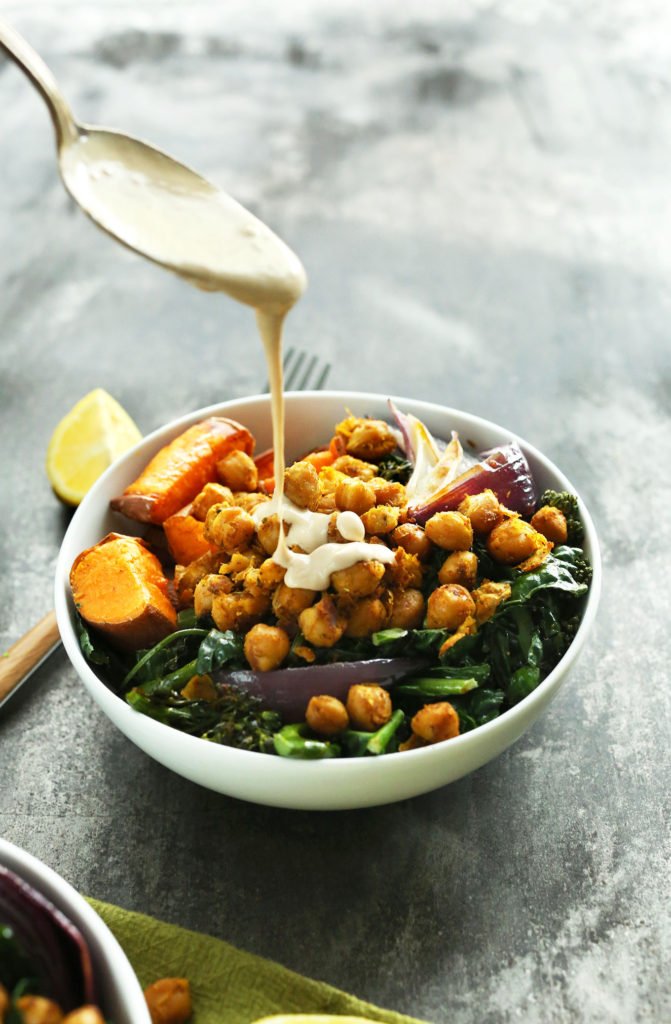
1 sweet potato, peeled and quartered
1/2 pound Brussels sprouts, trimmed and halved
1 yellow bell pepper, chopped
1/2 red onion, chopped
1 can chickpeas, drained and rinsed
Olive oil, salt, pepper, and paprika to taste
2 cups brown rice cooked
Cilantro Lime Dressing
1/4 cup plain Greek yogurt
2 TBSP lime juice
1 TBSP fresh cilantro, chopped
Salt and pepper to taste
Roasted Veggie and Quinoa Bowl with Soy Maple Dressing
2 carrots, peeled and sliced
1 head of broccoli florets
1 red bell pepper, chopped
1 cup sugar snap peas
1/2 head of red cabbage, sliced
Olive oil, salt, pepper, garlic powder and onion powder to taste
2 cups quinoa cooked
Soy Maple Dressing
1/4 cup soy sauce
2 TBSP pure maple syrup
1 tsp fresh ginger, minced
1 tsp fresh garlic, minced
Pepper to taste
Preparation:
- Preheat oven to 425 degrees
- On a baking sheet lined with parchment paper season the first group of veggies and chickpeas with the olive oil, salt, pepper and paprika.
- One a separate baking sheet lined with parchment paper season the second bowls veggies with the olive oil, salt, pepper, garlic powder and onion powder.
- Bake both pans 15-20 minutes or until veggies are done to your liking.
- Divide the rice between two bowls. Then divide and add the roasted veggies and chickpeas to the rice bowls.
- Divide the quinoa between two bowls and top with the roasted sugar snap peas veggies.
- Mix the lime cilantro dressing ingredients in a bowl and divide between two dressing containers. Place in the chickpea bowls
- Repeat the above step with the soy maple dressing ingredients, divide between dressing containers and place in the quinoa bowls.
- Cover and store in refrigerator for up to 4 days.
- To serve, remove dressing container and microwave the veggie bowl. Pour dressing over the bowl, mix and enjoy!
Hopefully you will try these recipes with me. I’m looking forward to having a delicious and healthy lunch ready for me to grab as I go out the door!
Tis the season to enjoy our local Farmer’s Markets!
The weather is warmer and our growing season is in full swing. Menasha’s farmer’s market started last week, Appleton and Neenah’s begin tomorrow! One of the best things about summer is the array of fresh produce we have at our local markets.
I love to get up early and be one of the first at the market, returning home by mid morning. I’m usually hungry and want some sort of quick brunch fare. Asparagus is in peak season and this recipe from Health.com is quick and flavorful.
Roasted Asparagus with Egg and Tomato 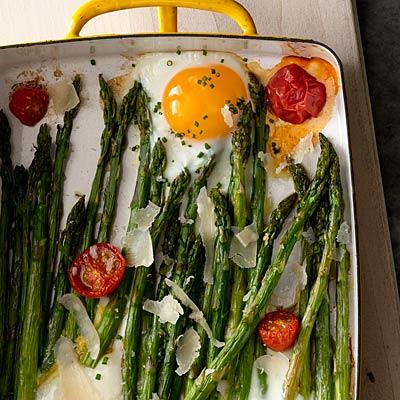
Prep Time : 10 minutes
Cook Time : 20 minutes
Serves 4
Ingredients
1 pound asparagus, trimmed of woody ends
1/2 cup cherry or grape tomatoes, halved
1 1/2 tablespoons olive oil
1 tablespoon balsamic vinegar (optional)
4 large eggs
2 tablespoons coarsely shaved Parmesan cheese
1 tablespoon chopped chives
- Preheat oven to 425 degrees. Toss asparagus and tomatoes with olive oil. Place into shallow baking dish so vegetables all lay in a single layer. Roast, shaking pan halfway through to turn vegetables. Roast until asparagus is tender and tomatoes have wilted, about 12 minutes. Immediately drizzle with vinegar if desired.
- Crack eggs over asparagus mixture. Return to oven and roast until egg whites are just set, about 7 minutes. Top with cheese, sprinkle with chives and serve. (I also add salt and pepper to taste)
This recipe is great served with a side of bread or toast.
Hopefully you feel inspired to go out and enjoy your local farmer’s markets and indulge in some of the great tastes of the season!
If you have plantar fasciitis you want the pain to go away, but what will help? Physical therapy has several options!
It’s a pain I can relate to, sliding out of bed, immediately greeted by heel pain and having to make an awkward painful shuffle to the coffee maker. Usually my heel pain goes away after my first couple steps and as long as I make a smart shoe choice for the day I’m good to go, but others aren’t as lucky.
If you’ve never suffered from plantar fasciitis consider yourself lucky, but if you’re one of the more than 3 million cases of plantar fasciitis that occur annually you don’t need to suffer any longer. Physical therapy may be the answer to your aching heels.
First things first, what exactly is plantar fasciitis?
The plantar fascia is a thick band of connective tissue that runs along the sole of the foot and supports the arch of the foot. Plantar fasciitis occurs when this tissue becomes irritated or inflamed. 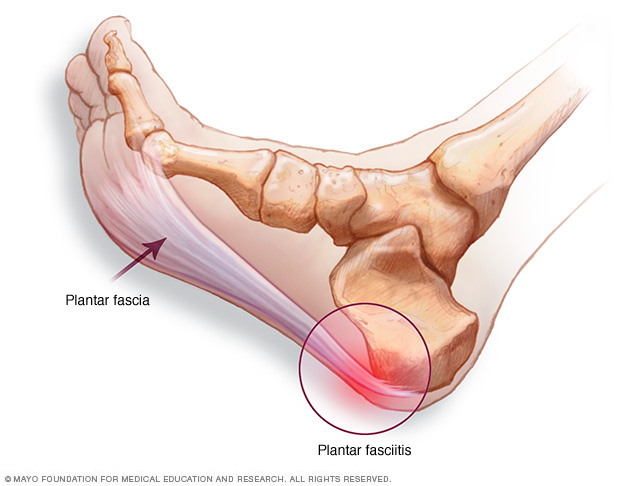
Plantar fasciitis typically presents a couple different ways, most commonly as sharp heel pain, usually worst in the morning, or increased heel pain when weight bearing especially if you have been sitting or resting for a period of time. Some other symptoms that are less common are pain radiating from the heel, numbness and tingling.
Causes:
-Foot pronation (rolling foot inward) while walking or running
-Obesity
-High foot arches
-Tight Achilles tendons
-Wearing soft soled shoes
-Prolonged standing
How can physical therapy help?
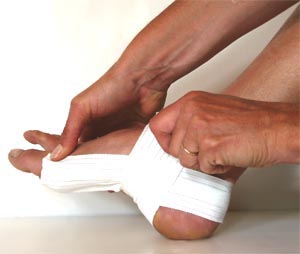
An example of Low Dye taping
Iontophoresis- If you’re new to physical therapy I’m sure this is a term you’ve never heard before. Iontophoresis is a way to administer medication without an injection. A weak electrical current is used to draw medication through your intact skin to treat the irritated area. You might be thinking electrical current? That sounds painful! I can tell you from personal experience it is not, your therapist can adjust everything to your comfort level.
Low dye taping- Taping of the foot can be helpful for pain relief as well as a determining if orthotics will be beneficial. The goal of taping is to support the arch of the foot as well as stop pronation of your foot.
Lower extremity control- If your plantar fasciitis is caused by pronation of your foot, physical therapy can help with muscle control. The goal is to take pressure off of the plantar fascia by teaching you to pronate your foot less.
Casting for custom orthotics- Your therapist can cast your foot for custom orthotics. Orthotics support your foot and can relieve your symptoms if you are pronating your foot or have flat feet.
Cross friction massage- The goal of cross friction massage is to work on a specific area, your heel, focusing on the deeper structure of the muscles and fascia.
Calf stretching and strengthening- Since one of the causes of plantar fasciitis is a tight Achilles tendon, working with a therapist on stretching, strengthening and increasing your flexibility can relieve your symptoms.
Plantar fasciitis can be treated at home and there are several over-the-counter treatment options, but physical therapy still has its place. An accurate diagnosis and finding the cause of your symptoms is equally as important as the treatment.
So if you’re suffering take a step in the right direction (pun intended) to rid yourself of heel pain. Soon you’ll be able to hop out of bed and get on with your day!
We are continuing our meet the Peak team series, this time focusing on Molly Van Zeeland.
Molly is one of our physical therapists here at Peak. She graduated from Lawrence University with a Bachelor of Arts in Bio-Chemistry. Molly’s interest in physical therapy began at Lawrence. She served as a student athletic trainer, helping athletes rehab and return to their sports. This, combined with her own experience as a student athlete, participating in volleyball, basketball and softball, started her on the path to her current career. Molly went on to earn her Doctorate in Physical Therapy from the University of Wisconsin-Madison. She has numerous professional achievements and continuing education credits that can be found her on our website, it’s an impressive read.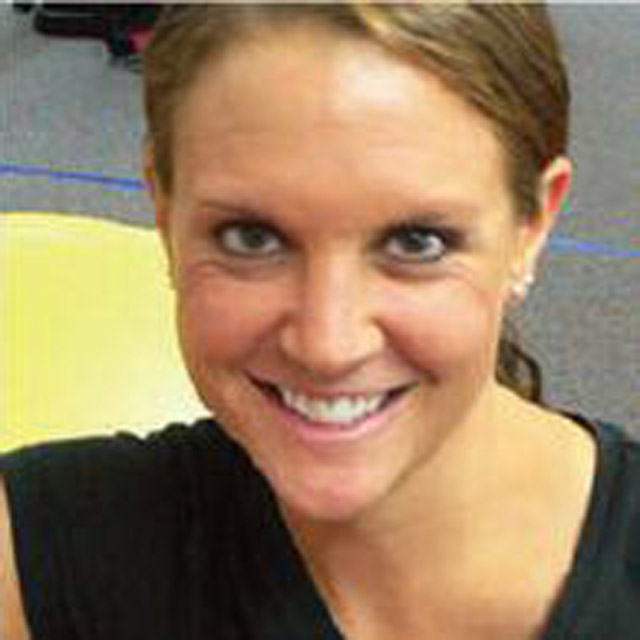
Molly was nice enough to take some time out her schedule to answer some questions about her favorite things she participates in outside of Peak.
What are some of the that keep you active outside of work?
“I am a mother of two young daughters ages 2 1/2 and 10 months.”
Has your workout changed since you’re occupied with two little ones at home?
“Yes, right now my daily routine consists of walking and lifting weights, but I hope to return to running this summer.”
Do you have a lot of experience with running and competitive racing?
“I have done road races of all distances including 3 marathons and several half marathons. My true passion is triathlons, but due lack of time right now it will be a couple of years before I return to racing.”
Have you competed in a lot of triathlons?
“Yes, I have done several over the past 8 years including Sprint, Olympic, half and full Iron-man distances.”
What about watching sports, any favorites teams?
“Definitely the Green Bay Packers and of course my alma mater the Wisconsin Badgers. I belong to an all women fantasy football league; last year I took first place, winning 6 bottles of wine!”
So is it safe to assume wine is also an interest?
“My husband and I pretend to be wine connoisseurs. We have visited Napa the past 4 years. We also enjoy going out for dinner paired with the perfect wine.”
Any favorite places for date night?
“Several, Chives, Rye, Bleu Al Corso and Katsu-Ya are at the top of our list.”
Hopefully you enjoyed getting to know a little more about Molly. She is part of what makes our team at Peak a success!
Do you need to change up your cardio routine? Have you ever considered roller skating? I know what most people think, “Roller Skating? Yeah that was fun at my best friend’s birthday party when we were 10 years-old, but I hung up my skates a while ago”. I can identify with the above statement; as a child of the 80s I used to cruise all over town in my skates. Unfortunately like most, skating fell by the waste side as I aged. After researching this article I’m sad I let that happen. Read on to see why roller skating deserves a spot in your repertoire.
During my research I found a great piece on the site Health Fitness Revolution titled “Top 10 Health Benefits of Skating”. For the sake of space I am going to bring you my favorite four:
- Calorie burning- An average sized person can expect to burn 500-600 calories an hour.
- Great cross training exercise- Skating is equal to jogging with respect to health benefits and caloric consumption.
- Works simultaneous muscle groups- Skating builds strength and endurance in your leg muscles while also using your arms and core for balance. Stronger muscles and better coordination helps prevent injuries and keeps you limber.
- Strengthens the heart an improves endurance- Roller skating is recognized as an aerobic activity that helps strengthen the heart.
If you are interested in skating, but the last time you strapped on a pair of skates was 7th grade, you might want to know some of the different varieties so you can pick one that works best for your needs. 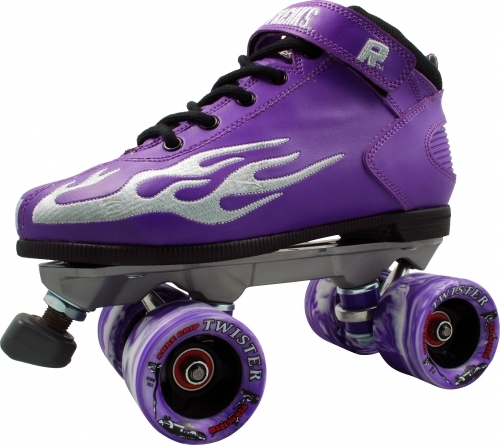
Speed Skates-These are exactly what they sound like, skates built for speed. They are low top for easier cornering and have wheels that are designed to spin faster.
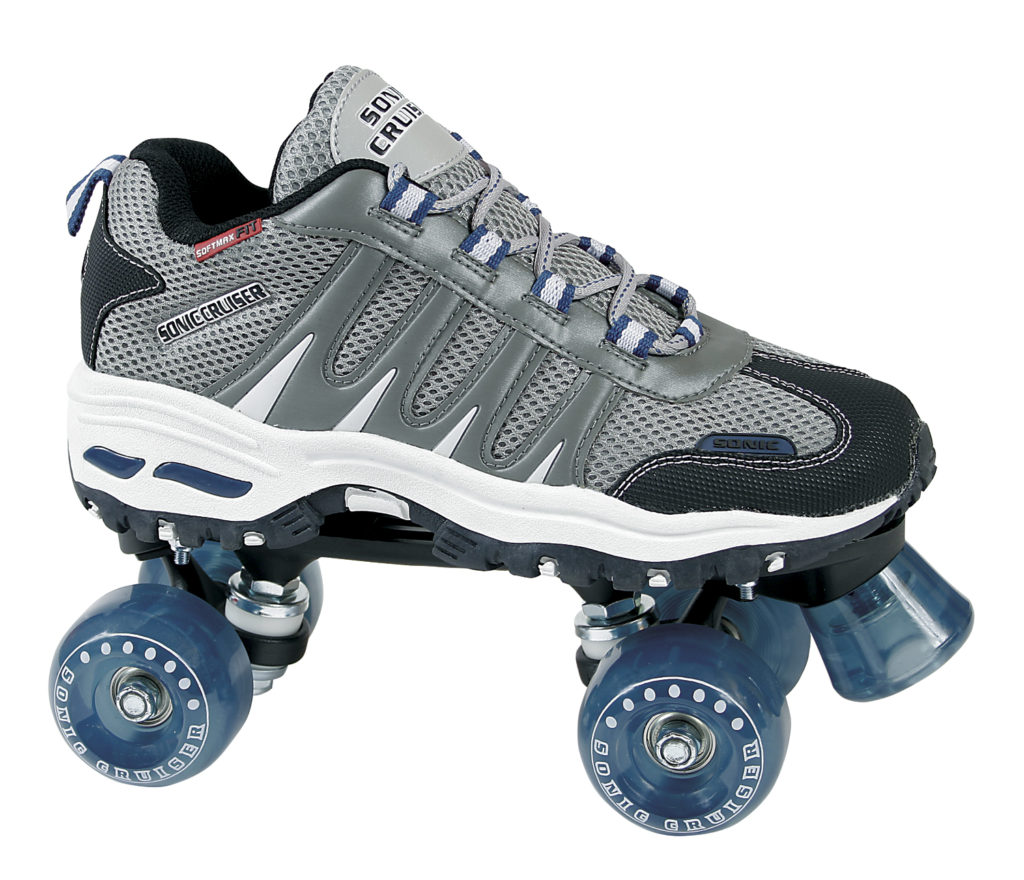 Outdoor Skates-They are similar to speed skates with the exception that they have a “softer” wheel allowing for a smoother ride over uneven terrain.
Outdoor Skates-They are similar to speed skates with the exception that they have a “softer” wheel allowing for a smoother ride over uneven terrain.
Inline Skates- There are several varieties of these, but the type most people use are recreational skates. They feature a high boot for foot and ankle support. They are usually more comfortable than Speed or Roller Hockey inline skates allowing you to skate longer distances. 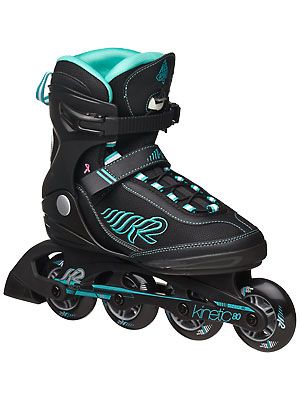
Of course you wouldn’t be complete without a helmet and protective pads.
Now that the weather is getting warmer, most people are itching to get back outside. While winter may be done with us, we still have to deal with those April showers. Roller skating is versatile and can be done indoors as well as outdoors. If open skate at the rink isn’t your thing, our area boosts a number of paved trails that are great for getting your skate on.
While writing this piece I became inspired to seek out some people active in the skating community, these woman not only found their way back to skating, it has become a major part of their lives.
St. Abby von Shanks and Derrierness are skaters in the Fox Cities Roller Derby. They were kind enough to take off their skates and answer a few of my questions:
What interested you in roller derby?
St. Abby von Shanks (AVS)- “I was a 3 sport athlete in high school and wanted to get back into a team sport. I was watching TV when a documentary, “Roller Girls”, came on. It looked like fun.”
Derrierness (D)- “I saw the sport on a morning show and realized I knew the lady that had started the league. I had not skated in 17 years when I signed up.”
How much training is required?
AVS- “I attend 7 hours of practice a week.”
What are some strengths needed to compete in roller derby?
AVS-” Core, balance and leg strength. You also need upper body strength for bracing. People think derby is skating, it’s more like a combination of hockey and NASCAR.”
D- “Cardiovascular endurance is key, one of the league requirements is being able to skate 27 laps in 5 minutes. Being strong mentally is also a must, when you’re skating your 27 laps and you feel like your lungs are bleeding you have to be able to focus and keep going. Also, you will get hit. Be prepared- my job is to knock you on your butt.”
Any injuries?
D-“Torn ankle tendons, broken nose, 2 concussions and a dislocated coccyx”
AVS- “My foot dislocated causing me to fracture my ankle in three places. It required some plates and screw to put back together.”
How do you think the public views roller derby? Is it accurate?
D- “I think the general public remembers the roller derby of the 1970s, and thinks we’re staged like WWE. We are not staged. Roller derby is less like skating and more a collision sport like hockey.”
Both of these ladies exuded the camaraderie that goes along with this sport. Their passion for roller derby was evident while interviewing them. They have an event coming up this Saturday April 8th, head over to Skater’s Edge and check them out!
http://www.foxcitiesrollerderby.com/
Hopefully you found this post informative and eye opening about the world of roller skating. Now strap on a pair and get out there!
This time of year you might find yourself spending a lot of time with your TV taking in March Madness. What goes good with basketball? Pizza of course!
We’re doing a Throwback Thursday and digging into our archives. Making your own pizza dough is easy and delicious. By making pizzas at home you can create whatever fun, fresh and favorable combination you desire and also control the calories. Enjoy!
We enjoy writing this blog and hope you enjoy reading Peak’s posts. If you’re reading this you obviously found our blog, but do you subscribe to it? Since we write this blog for you, we thought it would be a good idea to get some feedback from someone who subscribes to Peak’s blog.
Angie is in her 30s and a busy mother with two small children. She subscribed to our blog after moving to the Valley a year ago. She took some time out of her busy schedule to answer some questions about P Blog.
What are some of the features that attracted you to Peak’s Blog?
“Many health sites provide readers with the how, but not the why. For example, a site might show readers how to strengthen their cores, but not why. The emphasis is too often on physical appearance alone, and Peak Performance further focuses on body benefits, injury avoidance, and overall health information. I feel better educated and I appreciate that. I feel that the goal of the blog is to inform.”
Do you feel that blog effects your daily routine?
“Yes, it offers simple and effective tips for maintaining a healthy diet. One tip I’ve referred to frequently (from Healthy Holiday Strategy) is the holiday treat trick. The post posed a simple question, “Would I be eating this if it weren’t a holiday?” For example I when I was tempted by pumpkin pie at Thanksgiving I stayed the course, because normally I wouldn’t indulge.”
Has subscribing to the blog changed your workout routine?
I’m not a runner, so I appreciate that the blog offers alternative exercise activities. I was in jazz dance as an adolescent and I’ve now found my way back to dance as a fun exercise routine and stress reliever.”
Any other thoughts?
“I like that the articles are timely. Like one post stated, I have a tendency towards hibernation in the winter. However, the blog offered great suggestions for winter activities. I now plan to take my family snowshoeing.”
Hopefully your experience with the blog is a similar experience. We welcome your ideas, and enjoy reading your comments.
If you haven’t subscribed yet what are you waiting for? It only takes a minute:
- Go to the Peak Performance page
- Click on the Blog tab from our menu
- Enter your info on the right border
That’s it! Now you’re set and will be notified when every a new post is published.
If you’re not a subscriber we encourage you to sign-up. We look forward to providing you with more patient success stories, community events, and recipes to round out your healthy lifestyle.
For our third installment of Meet Your Peak Team we are focusing on Brad McMahon
Brad is a native to the Fox Valley, originally from Little Chute. He graduated with high honors from Carroll College with a Bachelor of Science Biology degree. He then went on to earn his Master of Physical Therapy from Caroll as well. Brad has several continuing education and professional accomplishments to his credit, as well as volunteer work with numerous local organizations. Since there are too many to list, they can be found on Peak’s website.
Now let’s get to know Brad a little more in depth, starting with two truths and a lie:
- Brad caught marlin while on a fishing trip in Mexico
- An avid fisherman he’s been a boat owner since high school
- Brad has had three ACL surgeries
We asked Brad to share some of his personal interests and things that keep him busy outside of Peak.
“I have a beautiful, loving wife and three busy boys ages 8, 5, and 3. We try staying as active as possible since the boys have an enormous amount of energy. We love the outdoors and take part in several activities that get us outside. This winter my wife and I will be traveling to Breckenridge, CO for a downhill skiing trip; this will be our 3rd time skiing out west. ” 
“Last winter we loaded up the minivan and the 5 of us took a road trip to Destin, FL for spring break. We rented a beach house with 4 couples and had 11 kids under the age of 9 under one roof! The 17 hour trip went much better than expected and we are thinking about attempting it again next month.”
“I enjoy any activities or sports that get me outdoors. I am an avid fisherman and love to fish bass tournaments throughout the summer. In the fall I turn to another passion of mine-hunting! Last September I was lucky enough to get my first bear tag. The whole family got involved in the baiting process. Even though my hunt was unsuccessful, I learned a lot and was able to capture tons of action on my trail cam; I had a lot of fun!”
After reading Brad’s bio do you think you figured out the answer to his 2 Truths and a Lie?
The lie is number one! Brad did go on a fishing trip while in Mexico and while catching marlin was the goal, he only caught barracuda.
As I’m sure you took from above, Brad enjoys fishing. He really has been a boat owner since high school and adds that he even took one with him to college so he could fish!
Lastly, Brad has had three operations on his ACL. He initially tore his anterior cruciate ligament (ACL) while playing football in college. He had two subsequent ACL surgeries following graft failures. The rehab Brad had following this ACL surgery provided him an amazing first hand learning experience. If you find yourself in his care, you can trust that he truly has empathy for you’re going through having been there himself.
Hopefully you enjoyed getting to know more Brad, another great piece of the amazing team we’ve assembled at Peak!
We are reaching back into the archives to revisit a post on the importance of core strength. This time of year exercising outside can become more difficult but there are plenty of activities to keep you busy indoors. Core exercises help train muscles that improve your stability and balance and is an important part of your overall health.
Kari obtained her Bachelor of Science degree in Physical Therapy from Marquette University. She then went on to earn her Doctorate in Physical Therapy from Massachusetts General Hospital Institute of Health Professionals with an emphasis in lower extremity bio-mechanics and running related injuries. Kari is one of a few therapists working in Wisconsin certified as a clinical specialist in Orthopedic Physical Therapy.
She has several other continuing education and professional achievements to her credit, all of which are mentioned on this site and we encourage you to take a minute to read.
The purpose of our bio series is to get to know everyone on a more personal level so we asked Kari some questions and of course brought back the popular Two Lies and a Truth…
Kari’s Two Lies and a Truth:
1. She broke her pelvis mountain biking.
2. She bungee corded off the Sydney Harbour Bridge.
3. Sea urchin is her favorite delicacy.
Like always, you’re going to need to read on for the answers...
We asked Kari some of her interests and activities that she enjoys taking part in away from Peak:
“I love to travel. Since I have a three year-old I haven’t done as much traveling as in previous years. However this fall I finally worked up the nerve, we boarded a plane and set off across the pond! I have very dear friends that live in Rennes, France and we were able to have a wonderful visit with them. We traveled the northern coast of France- walked the beaches, explored ancient fortresses, and wandered through quaint villages. Of course being in France, we enjoyed a lot of cheese. An added bonus to the trip was getting to see my best friend from high school; she and her family had recently moved to Paris. We are both horrible at keeping in touch and hadn’t seen each other in 15 years. We joked that it only took her moving to another continent for us to finally get together. My son loved playing with her children and visiting the “weiffel” tower.“ 
“I also love cooking and have been known to spend an entire day in the kitchen! Since the birth of my son I am more efficient in the kitchen leading me to become creative with our meal planning. I like starting the week by making something like roast chicken which I can then turn into other meals throughout the week like chicken salad, tacos or soup. My love of cooking is complimented by a love of gardening. My veggie garden has taken over my backyard, with passersby often stopping to gawk at my tomato plants. I love preserving my produce so we can enjoy it throughout the year.”
“I’m also quite an environmentalist, I compost and recycle as much as possible. My son and I try to walk or bike most of our errands. I enjoy running with my son in a stroller. As he grows it becomes more of a workout- he is getting kind of heavy. I love the challenge!”
“The last little known tidbit about me is that I enjoy knitting. I learned as a child from my mother and grandmother. My childhood was spent knitting halves of many things. I put down my knitting needles during my high school and college years, and then a couple years ago I realized I needed a winter activity, so I resumed knitting and haven’t stopped since. I mostly make kids sweaters, hats and baby blankets. I’m not great at sizing, so it’s probably best that my subjects are still growing.”
What are you doing this winter?
“I hate winter and spend it wondering how many days there are until spring. I trick myself into running outside and trying to remain active. Anyone have any ideas on how to enjoy the winter? I’m open to suggestions.“
Now back to Kari’s two lies and a truth:
The truth is #1! As Kari describes it, it wasn’t the mountain biking that broke her pelvis, it was landing after the epic flight through the air. “I was in denial, climbed back on the bike and tried to complete the ride. After I fell off again, I realized I was indeed hurt.”
Kari admits to being terrified of heights. While she has toured the Sydney Harbour Bridge it was done while being securely fastened to a safety rail.
As for sea urchin being her favorite delicacy, she is adamant that it’s the worst thing she’s ever eaten.
Hopefully you enjoyed getting to know a little more about Kari!

What are you looking forward to the most in 2017? My husband and I are expecting our second child in March! My growing bump is exciting for our family, but it’s also a reminder of the significant changes beset by pregnancy (both physical and hormonal). During the last few months, I’m more acutely aware of how I move as my body expands to accommodate the needs of our growing baby. It’s my desire to use this attentiveness to help patients experiencing pregnancy pain, including back and hip pain, muscle strains and other discomforts.
In my thirteen years as a therapist, I have helped hundreds of women prepare their bodies for an easier pregnancy and delivery. Equally important are the therapies I provide for women who need guidance on how to properly carry their rapidly growing babies (as well as the arsenal of bags and strollers). It’s one of the most fulfilling things I do as a professional.
When a woman has her first consultation with me, I let her know the need for physical therapy during pregnancy or after childbirth is not uncommon, and it’s completely safe at any time.
The American Physical Therapy Association estimates that seven of every ten women experience low back pain during pregnancy. Weight gain and change in the center of gravity adds stress to the lower body, even interfering with the pelvic floor.
The cause of much of the pregnancy pain and discomfort can be traced to hormones, which causes the ligaments to relax. It can lead to postural changes, causing pelvic, hip, or back pain.
Physical therapy is a medically-based profession, which means the services we provide are covered by most medical insurance plans. The treatment plans developed by me and others on our team at Peak Performance are effective for improving typical triggers of pain and discomfort for pregnant women, including:
- Poor Posture
- Joint Malalignment
- Muscle Weakness
- Decreased Flexibility
- Irritated Nerves
Regular therapy sessions, receiving exercises to target trigger areas, and recognizing the changes the body is undergoing, all help relieve several issues for moms-to-be, such as:
- Back ache
- Neck pain
- Joint pain
- Sacroiliac joint (SI) discomfort
- Sciatica
- Pelvic floor weakness and pelvic pain
- Abdominal weakness
Treatment techniques include:
- Postural exercises and education
- Ergonomics training (i.e. lifting and carrying baby)
- Abdominal strengthening (to stabilize and support the body)
- Stretching
- Activity modification
- Hands on therapy to improve alignment
- Bracing (to unload or to stabilize the pelvis and spine)
For a few patients, I also perform Kinesiotaping, especially to decrease pain for SI and back pain. Recently, a patient pregnant with twins had her husband join her at one of our sessions. He took video of me taping so he knew exactly how to help (what a great spouse)!
As the months progress, I’ll share updates on physical therapy for women in the second and third trimesters of pregnancy. I recently attended a continuing education session focused on pelvic floor exercises and pregnancy pain. I’ve enhanced my Kegel exercise program for patients and look forward to helping them gain strength that will help them during and after childbirth.
To learn more about the pregnancy physical therapy program at Peak Performance, contact us at (920) 738-0671 or request an appointment online.
Now that winter has come and the snow has fallen many people hibernate and seek shelter until more desirable temperatures return. This doesn’t have to be the case, you can get out and enjoy the many opportunities the snow brings. Whether you’re an avid enthusiast or new to the winter activities scene there are several choices for you to try. The majority of us are familiar with options like downhill skiing, snowboarding and ice skating. While these are all great activities, sometimes they can seem daunting or difficult to learn as a beginner. I have listed some alternatives below that are great for newbies as well as seasoned outdoor enthusiasts.
Cross-country Skiing
Growing up in a rural area this was a winter activity I remember loving even as a child. It requires very little equipment and unlike downhill skiing there is usually more miles of trail opportunities. Cross-country skiing is a great low impact cardio workout. Skiing for an hour at slow pace burns 400-500 calories an hour; if you speed up to a moderate pace you burn closer to 600 calories an hour. Not bad for spending an hour taking in some beautiful winter wonderland. Several parks and ski hills offer equipment rental if you’re interested in trying this sport out.
Snowshoeing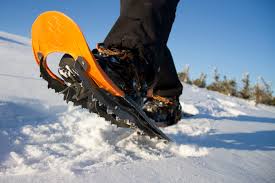
I will admit, this is not an activity I have done first hand, but am interested in trying. Like cross-country skiing, snowshoeing is low impact. It mainly works your hamstrings, quads and calf muscles but if you add poles you get the added benefits of an upper body workout too. The amount of calories you burn depends greatly on terrain, speed and snow density. Expect to burn about 350 calories in an hour on a flat trail with a slow to moderate pace. If you add some hills, poles and speed to your course you can burn upwards of 800 calories an hour. Another nice thing about snowshoeing is you can participate even if you’re a city dweller, there are many walking trails to utilize.
Fat Tire Biking
Fat tire biking is relatively new, only gaining attention within the past few years. If you’re unfamiliar with the concept it’s basically a mountain bike fitted with fat tires. While they can be ridden over several different terrains they have gained popularity in this region due to their ability to ride through snow. Fat tire bikes are pretty user friendly due to the size of their tires they are easy to learn for beginners and provide a cushioned ride over varying terrain. The calorie benefits of these bikes comes into play when you consider the terrain you will be riding and the fact that a lot of these bikes only offer one speed. One speed means you are going to need to use your legs to push through the snow and hills. Again, this is an activity you can do whether you’re in the city on country. The NEW Zoo in Green Bay offers bike rentals and 2-6 miles of trails to ride. There are several parks and rental outlets available, check your local area.

Hopefully you one or all of the above activities inspired you to go out and enjoy the winter. The best part of all of them is getting outside and enjoying the season. Unfortunately winter can sometimes put people’s work-out routine into a boring indoor only rut. Get outside, breathe in some fresh air and benefit your health at the same time.
We are very proud of the team we have assembled at Peak and from week to week we would like you to get to know them a little more in depth.
First up is Nikki Strick: Nikki earned her Bachelor of Science degree in Kinesiology with Distinctive Scholastic Achievement from the University of Wisconsin-Madison. She then went on to earn her Master’s Degree in Physical Therapy from the University of Wisconsin-Madison.
She has countless continuing education and professional activities to her credit, all of which are listed on this website, but we thought that we would get to know her on a more personal level.
For some fun we asked her to participate in 2 Truths and a Lie; see if you can separate her fact from fiction:
- Nikki biked 150 miles over two days while 29 weeks pregnant
- She once danced and assisted David Copperfield with his act
- Nikki has participated in the Ironman Wisconsin
Keep reading for the answers!
So Nikki, what are you up to this fall and winter?
“I started off the football season by cheering on my Alma mater as the Badgers took on LSU at Lambeau Field. I was also fortunate enough to take in College Game Day while I was there. It was a fun day with a lot of great energy and school spirit from both teams. The icing on the cake was a Badger win!”
“I am also looking forward to my younger sister’s wedding over the Thanksgiving weekend. It will truly be a family affair as my husband is officiating, my 2 year-old son is the ring bearer and I get the privilege of being her matron of honor.”
“I continue to stay active in Spin classes as well as Body Flow, which is a mix of Tai Chi, Pilates and Yoga.”
“My husband and I are also excitedly preparing for the birth of our second son this Spring!”
On a professional note, Nikki recently visited a local employer to discuss workplace injury prevention. Our blog will feature more on this topic in our next post.
Now for the answers to Nikki’s 2 Truths and a Lie…
The lie is…number 3. While Nikki has participated in triathlons, she has done the Olympic distance not the Ironman. Still impressive.
Since her truths are so interesting, we asked her to elaborate. Nikki was asked to assist David Copperfield while seeing his show last year in Las Vegas.
She really did bike 150 miles while 29 weeks pregnant. Nikki participated in the Scenic Shore 150 from Mequon to Sturgeon Bay. A funny anecdote about this truth is that now her son loves to bike!
Hopefully you enjoyed getting to know a little more about Nikki. She is one of many that make up the great team at Peak!
This time of year can be a slippery slope of Halloween candy, turkey with stuffing and holiday parties with countless trays of hors d’oeuvres. If you have a healthy holiday strategy you can easily navigate this difficult time of year.
Recently there was a letter to the editor published in the New England Journal of Medicine about the effects of the holidays and your weight. Basically the study showed that the month of October is the skinniest you’ll be all year. Halloween to New Year’s is the toughest time of year for people’s waist line. The study also showed that the weight you gain during the holidays doesn’t start coming off until April. It usually takes until mid-summer before you’re back to your pre-Halloween physique. I’m sure that this is something that we’ve all experienced. As depressing as this study is, it doesn’t have to be true.
By being mindful of your diet and staying active throughout the season you can keep yourself from being another holiday statistic.
This time of year as the weather begins to cool and the days shorten it may become harder to keep up your routine and easier to turn into a couch potato. We’ve been fortunate to have a mild and lengthy autumn, get out there and make the most of it!
Get Outdoors: We have countless walking paths, nature trails and biking routes to enjoy. You can also enjoy some nature preserves like 1000 Islands in Kaukauna, Mosquito Hill outside of New London, or Gordon Bubolz in Appleton just to name a few.

Sign-up for an Event: There’s the Turkey Trot, Appleton is hosting a fat tire biking event, and there is an Ugly Sweater Run/Walk coming up in Manitowoc. These are just three of several upcoming events. I found these by utilizing Facebook Events and searching the Sports and Fitness category. You can go there to find out more about the above mentioned activities or find one of your own.
Make the most of your chores: Maybe ditch the riding lawnmower to rake and bag your leaves by hand. Get your gardens and flower beds ready for winter. There are several fall clean-up activities that can help you expend some energy and calories.
Now to the second part of your healthy holiday strategy- diet.
No, you don’t actually need to go on a diet during the holidays. As if the holidays aren’t stressful enough, who wants to count calories? That last sentence shouldn’t be interpreted as free license for you to eat what ever you want and worry about it January 1st. It’s more intended for you to stay on your healthy path regardless of the time of year.
Try keeping your regular schedule- Some people like to skip lunch or fast all day because they know they’re going to a party or family get together with all the trimmings. What happens when you get there? You’ve been starving yourself all day and then over eat on the first appetizer you see or throw portion control out the window because you tell yourself, “it’s okay, it’s my only meal today”.
Ask yourself, would you be eating this is it weren’t the holidays? 
We are constantly surrounded by temptations, just after Halloween can be the worst. When else is there a large supply of candy sitting around your house? Either you over bought for the tricker treaters or your kids are picky about some the candy they received, regardless the temptation is there.
Often this time of year brings several gifts in the forms of cheese and sausage baskets, tins filled candy, plates of cookies. Several of us have break rooms that are a constant source of empty calories. You again have to ask yourself, “if this wasn’t here, would I normally be eating a giant pretzel rod dipped in caramel, peanut butter and chocolate as an afternoon snack?” Probably not.
Of course there’s some wiggle room. Toast that glass of egg nog or have seconds on the sweet potatoes. Enjoy your favorites in moderation. Chances are this is the only time of year some of these treats come your way. It’s about savoring some of your favorite things, not sampling everything that gets dipped in chocolate and put in front of you.
Bottom line is if you keep active and stay the course, you won’t need to worry about New Year’s resolutions and having to wait until nest summer to lose those pesky pounds.
If you’re looking to cross train, or a couch potato trying to get back into a workout routine, dance is a wonderful place to start.
Not everyone fits into the treadmill, elliptical, weight lifting world. For those of you that fall into this category or just want to change up your routine, we are going to be writing some posts that focus on thinking outside the gym. Today we are focusing on dance.
We like to focus on healthy lifestyles and activities. This blog has several great posts focusing on exercise, especially running. If you’re a runner, that’s great. We’re happy you found something you enjoy. Others might more accurately describe their running experience by wearing a shirt like this. 
The benefits of dance:
Great cardio workout-helps with weight loss, strengthens heart and lungs, increases bone density, better sleep
Increased flexibility-assists with posture, balance and reduces risk of injury during daily activities
Helps gain and maintain a healthy core– strengthens muscles, improves endurance, reduces chance of or helps with back pain, stronger performance in other athletic endeavors
Weight management– for the above listed reasons dance burns calories
There are several different types of dance: 
Ballroom-Swing, Waltz, Tango, Foxtrot the possibilities are endless. Bonus ballroom dance burns 400 calories an hour
Ballet-Adult ballet is becoming more popular with offerings like Barre classes, focusing on sculpting muscles, posture and balance.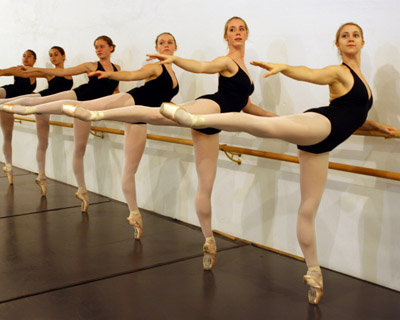
Belly Dance-Shake and shimmy your stress away. Belly dance is more than just shaking your hips. It focuses on precise isolated movements of arms and ribs as well as hips
A little about my own experience. I found my way into dance by chance. I was trying to find a low impact exercise to improve my flexibility and maybe burn some calories at the same time. My first idea was to enroll into a Pilates or yoga class. Looking at the YMCA class list, these choices conflicted with my schedule. Upon further review there was one class that fit with my availability- belly dance! I had taken Dance Appreciation in college and really enjoyed it. I was a little wary at first but after my first class I was hooked.
Admittedly during the first class I got a little sweaty and thought “This is fun, but not much of a workout.” The next morning when I got out of bed I was proven wrong! I quickly realized that you have several hip and inner thigh muscles that are taken for granted.
You can get started in a number of ways:
Look into local dance studios and see what interests you
If you belong to a gym check out their class lists
Community centers and colleges offer dance workshops
If you’re a little shy to try your moves out in public there are a variety of DVD’s and videos online
Like any exercise routine try a variety and see what speaks to you. If you’re looking to add to your routine or just get started dance is a great avenue. The point is just to get out there and get moving. Again not everyone fits into the gym routine and dance is a great way to think outside the gym.
Occasionally we will be re-sharing our posts from the past, kind of a Flashback Friday if you will. We felt this post from two years ago was still very relevant with great ideas to free yourself from the PB & J rut.
Now that kids have been back in school for a month you may already find yourself falling into the same lunchbox routine. A variety of healthy school lunches are easier than you think.
School lunch is an essential part of your child’s day. There are several studies that show children that eat nutritious lunches have more active lifestyles and are more likely to excel in school. Poor nutrition can be responsible for inability to focus and students feeling sluggish or tired.
This article is very applicable to packing your own lunch too, as adults we are guilty of “Do as I say not as I Do”. During the busy work day skipping lunch to run errands seems very acceptable, until you crash around 2 o’clock. A lot of the lunch ideas in the attached article are just as appealing to adults. Get yourself a fun lunchbox and enjoy!
From time to time we would like to share some of our patients’ success stories. We find patients are more than happy to share their stories of trial and error, hard work, determination and ultimately success. Today we are sharing Kelly’s story.
Kelly is an active mother of two young boys in addition to having a busy career as a nurse. She started noticing shoulder pain with activities like playing with her sons or participating in sports like volleyball. Like most people she tried playing through the pain, especially since she didn’t have a specific injury to the shoulder. When her shoulder pain became progressively worse and interfering with her daily activities she knew it was time to get answers.
She was evaluated by Dr. Timothy Mologne, an orthopedic surgeon, and diagnosed with multi-directional instability (MDI) of the shoulder.
What is MDI?
In the simplest of terms MDI is increased laxity of the shoulder joint. MDI isn’t always a bad thing; a lot of athlete’s, especially baseball pitchers, have increased shoulder laxity. MDI becomes an issue when the increased movement of the humeral head irritates the rotator cuff. If you have MDI, the muscles of the rotator cuff have to work harder to keep the humeral head stabilized. When this takes place, the tendons become aggravated.
What are the common symptoms of MDI?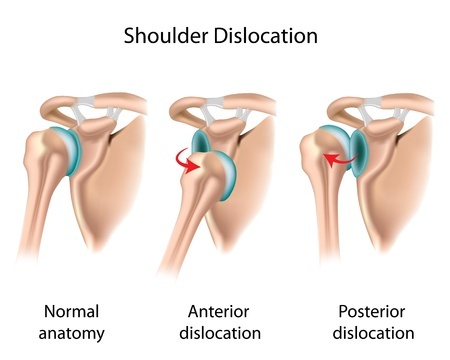
- Deep seated aching pain of the shoulder joint
- Occasional numbness and tingling in the arm
- Pain with overhead activities and overhead sports
- Voluntary instability (ability to “pop” the shoulder out of the socket at will)
How is MDI treated?
The most common treatment for MDI is physical therapy. Patients with MDI usually have weakness of poor control of their scapular muscles. The goal of physical therapy is to strengthen the stabilizer muscles of the shoulder to give the arm a more stable base.
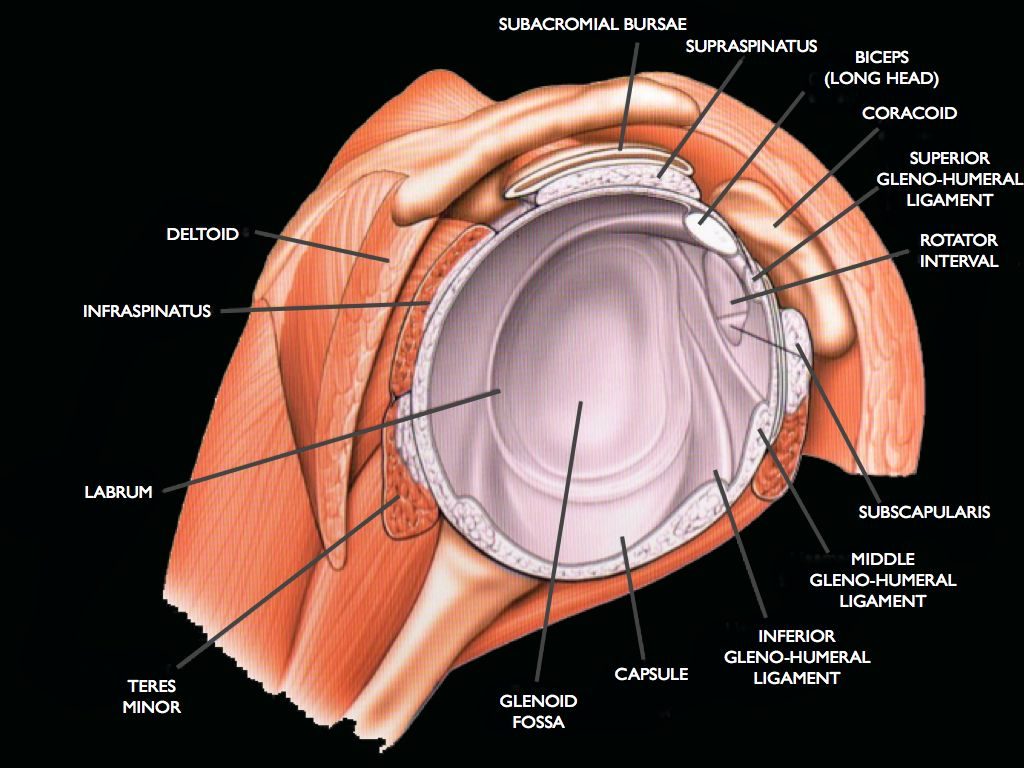
Proof that your shoulder is a very complex joint
Now back to Kelly’s story. Kelly worked with Nikki Strick, a physical therapist at Peak Performance. Nikki’s goal was to return Kelly to the active lifestyle she had before her shoulder pain. She began with working on gaining her full range of motion and then added strengthening of the rotator cuff muscles, surrounding shoulder muscles as well as scapular muscles. Nikki also worked with Kelly on her posture and core strength, each of these things playing an important part of the shoulder’s function. These goals are accomplished with 1-2 therapy visits a week for 6-8 weeks. Nikki openly communicated with Kelly’s physician regarding her progress. MDI is a fairly common diagnosis and your therapist is very knowledgeable as to what goals their patient should be meeting. The normal time frame for a patient to return to their normal function is around 12 weeks.
Unfortunately, Kelly’s shoulder symptoms continued despite physical therapy. She was again seen by Dr. Mologne and the option of surgery was discussed and offered. She had a capsular plication of her shoulder performed to tighten the shoulder capsule. Kelly resumed physical therapy the same week her surgery was performed. Nikki’s goal for Kelly following surgery was to resume her shoulder range of motion by approximately 12 weeks post-operatively. She then progressed her to strengthening and stability exercises. Finally, Nikki started Kelly on sport and activity drills. Patients are usually able to return to their full activities including overhead sports and activities at 6 months post-op.
Kelly again put in the hard work needed and began noticing improvement of her shoulder symptoms. Ultimately she was able to return to playing catch with her sons and things that most people take for granted like lifting her arm overhead without pain. Nikki truly enjoyed working with Kelly and is proud to say that she is a Peak success story.
An alternative title for this article could be “If Cavemen Ate So Healthy Why are They Extinct?”
- The Werewolf Diet- A diet that revolves around fasting and specific diets that change with each lunar cycle. This is a new and improved variation of the popular grapefruit diet.
- The Tapeworm Diet–Exactly what it sounds like, you swallow a capsule that contains a tapeworm parasite. Once the tapeworm sets up shop in your GI tract it takes a portion of what you eat causing you to lose weight without having to alter your eating habits. Once you have lost the desired amount of weight you are prescribed medication from a physician to rid yourself of the tapeworm.

- The Cotton Ball Diet- You swallow cotton balls soaked in orange juice causing a feeling of fullness in your stomach, this full sensation will cause you to be disinterested in consuming food. I am quite certain this diet will cause you to lose weight. Unfortunately it will be because of the hospital food you have to endure after you’ve been hospitalized for the bowel obstruction you gave yourself from ingesting cotton balls.
- The Sleeping Beauty Diet- “You can magically sleep the pounds away”. The thought process behind this diet is that you can’t be eating calories while you’re fast asleep. How do you attain the large amounts of sleep needed to achieve this? Heavy sedatives of course! Elvis was a fan of this diet, not a great endorsement.
So I pose the question to you again- Which Fad Diet is Right for You?
Obviously the above examples are extreme, but what is scary is that they are still around. Madonna and Demi Moore promote the Lunar Diet. The tapeworm diet originated in the 1920s, but has had a recent reemergence. There are several reported cases of people being treated for tapeworms that have found a way out the GI tract and found cozier digs, like your brain! Fad diets continue to remain popular because they all promise the same thing-maximum weight loss with minimal lifestyle changes.
Why don’t fad diets work?
- They rely on extreme restrictions for a short duration which cause unrealistic weight loss
- They are often not geared toward promoting a long-term healthy lifestyle
- Fad diets are so extreme that the weight lost is quickly re-gained after person returns to their normal lifestyle
While I’m sure you’re telling yourself that you would never fall into the trap of a fad diet, don’t be too sure. Today’s diets are re-branded often with scientific claims to support their reasoning some examples include: Atkins, Paleo and Raw Diets. Of course these diets are very popular and to a certain degree healthier that the above mentioned fad diets, but they are not the miracle cure all.
I remember when Atkins became popular about 15 years ago people were ecstatic! The basic principle people took from it is you can eat whatever you want unless it’s an evil carb. The public translated it to mean I can eat a pound of bacon a day as long as I hold the pasta. 
Raw diets sound very healthy, and you meet your caloric needs in a healthful way. The issue is your GI tract is not equipped to absorb enough nutrients from the green shakes and uncooked foods. Some people have had issues with malnutrition when they try switching to 100% raw lifestyle.
Paleo has some of the same issues of past fad diets because it restricts food groups from your diet, relying heavily on food that your caveman ancestors ate. Well first off, pushing a cart to the meat department is not expending the same calories as it took our ancestors to hunt and gather. Also you need to consider what they were eating compared to us. They truly hunted lean, healthy wild game, slightly different than what we find at the butcher shop. Ultimately we can’t be positive of exactly what was eaten in the paleo days, how can we base our eating
So what’s the answer?
Same as it’s always been, try eating a well balanced diet including a wide range of healthy ingredients. Weight loss can be achieved by eating the proper amount of calories and regular exercise.
It also helps to speak with your doctor. Depending on your current health conditions some diets might be contraindicated. You might also consider meeting with a dietitian to set you on the right path with meal plans and education about proper portions etc,
Avoiding fad diets and replacing your eating habits with healthy choices may take some time, but ultimately it is the path that will set you up for the most success.
Although it has a mythical reputation for being a scary, unapproachable food, tofu can actually be really good. And apart from tasting good, it also does a lot of good for your body! Most people think that tofu is reserved for vegans and vegetarians, but in reality, it makes a great addition to virtually any meal. Here are a few reasons to consider trying tofu:
-
It’s an awesome source of protein.
-
It’s also high in calcium, low in calories, etc. The list goes on.
-
It’s a great bang for your buck.
-
It’s extremely versatile and can replace meat/poultry in most recipes.
Sounds pretty good, right? If you think you’re ready to start experimenting with tofu, here are two basic ways you can try it out:
1. Give it some flavor and bake it.
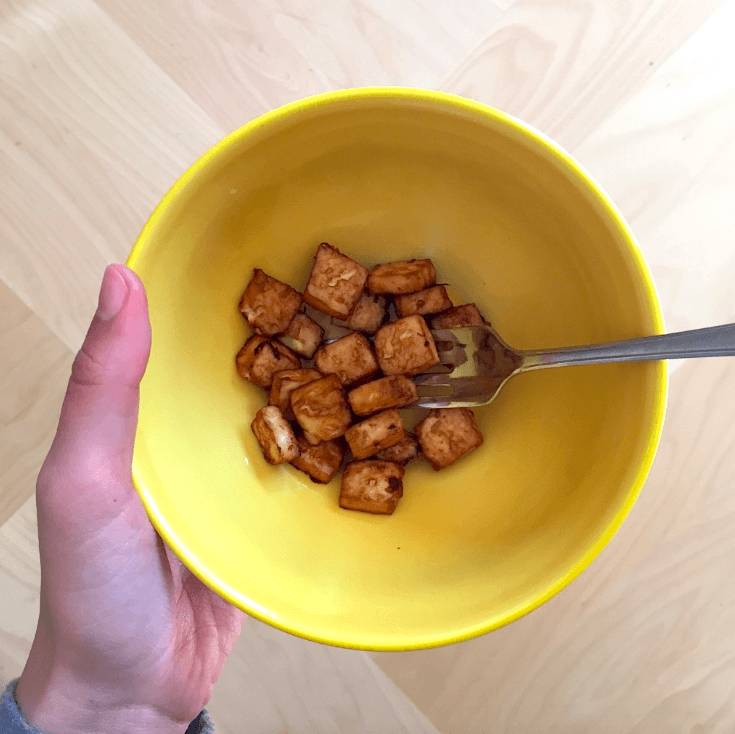
Try coating squares of tofu with a mixture of sriracha, soy sauce and olive oil. Throw them in the oven for 10 minutes at 425 degrees, flipping halfway through. What you’ll be left with is a crispy-on-the-outside, soft-on-the-inside snack or side dish.
Side note: Most tofu has to be pressed dry before it’s prepared because it is packaged and sold in water to keep it from drying out. To avoid spending tons of time on the pressing process, you can buy extra firm or super firm tofu.
2. Add it to tacos, stir fry or any other meal that would usually contain meat.
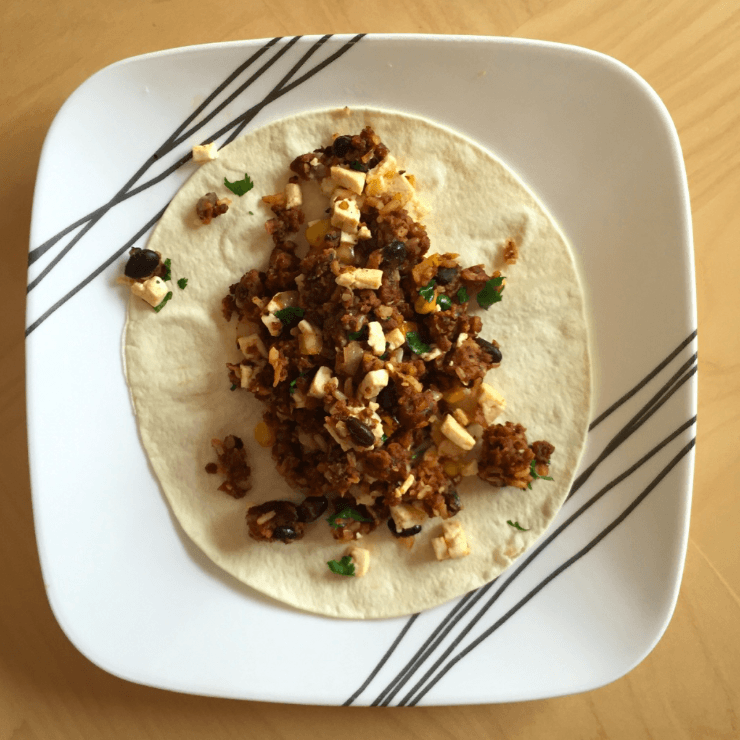
Once you bake the tofu, it’s ready to be added to anything. Of course, you can fry it as well, but baking is a healthier option.
So what do you think? Doesn’t seem so scary after all, right? Of course, this is just the beginning. There are so many delicious ways to try this protein-packed food. If you decide to mix up your next meal with tofu, let us know!
Last month, we watched as some of the best athletes in the world met in in Rio for the 2016 Summer Olympic Games. But the Games aren’t over! This month, Paralympians are taking their turn in the spotlight, showcasing their strength and skill in a wide range of events.
The Paralympics and Olympics have a few sports in common, such as archery, powerlifting, swimming and rowing. Many other sports have the same premise, but are adapted to allow Paralympians to compete at the highest level. For example, there is sitting volleyball, wheelchair basketball, wheelchair tennis, etc. However, there are two events in particular that are completely unique to these Games:
1. Boccia
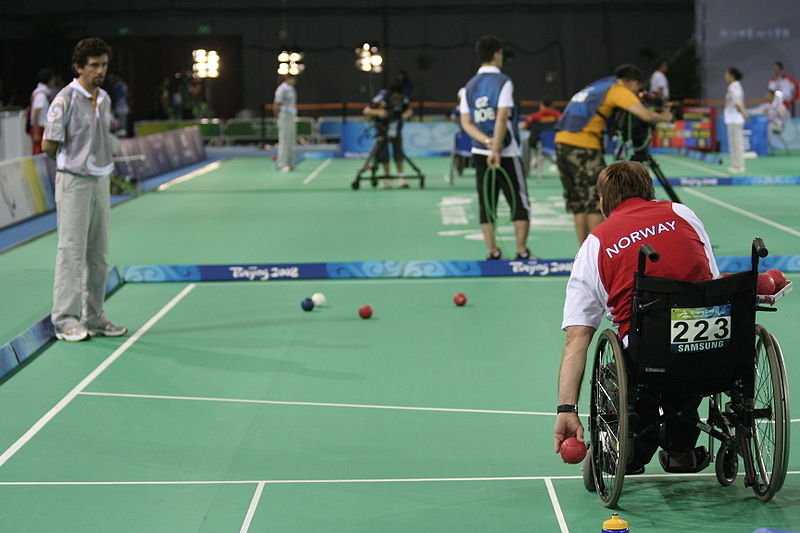
Photo by Stig Morten Skjæran, Wikimedia Commons
Since its Paralympic debut in 1984, boccia has been known as one of the few sports in which men and women play together, as well as against each other. This game of strategy requires players to throw or roll their colored balls as close as they can get them to a white target ball. The winner is the player or team with the most balls near the white “jack” ball. Find out more about boccia here!
2. Goalball
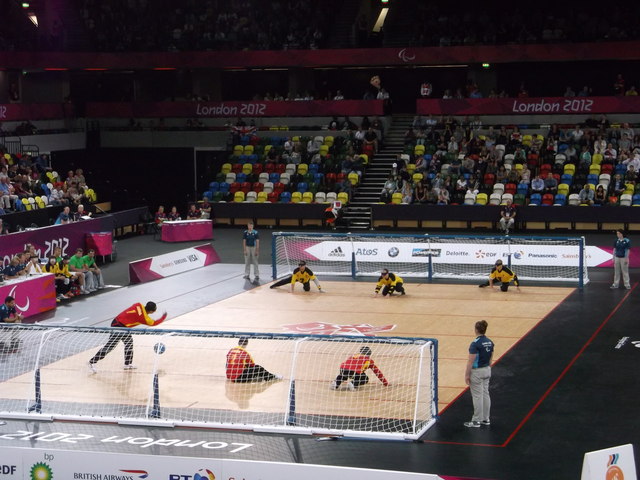
Photo by David Anstiss, Creative Commons
Goalball has been part of the Paralympic games since 1976. It was originally developed in Germany in 1946 as a sport to help rehabilitate war veterans. The sport is played by visually impaired athletes who wear eye masks to ensure equality. There are two teams of three players who try to score points by throwing a ball with bells at high speed (up to 100 kph) into the opposing team’s goal at the opposite end of the court. Learn more about goalball here!
Find out how and where to catch the remainder of the Rio 2016 Paralympics, which runs through Sept. 18, here.
When you’re picking up produce at a grocery store or farmer’s market this fall, you’ll be sure to find a rich harvest of fruits and vegetables. Autumn’s in-season produce vary in color, flavor, size and texture, which makes for beautiful, mouth-watering fall dishes! Here are a few fruits and veggies to keep an eye out for this fall, along with tips for choosing the best ones and healthy recipes you can try at home:
Apples
How to choose them: Pick the ones that are deeply colored, firm and naturally shiny.
How to eat them: Apple, Goat Cheese, and Pecan Pizza

Photo: pixabay.com
Mushrooms
How to choose them: Make sure the stems are firm and have a uniform color, and that the gills are dry. Avoid slimy, bruised, or shriveling mushrooms.
How to eat them: Wild Mushroom & Barley Risotto

Photo: pixabay.com
Winter squash
How to choose them: Whether it’s acorn, butternut or spaghetti squash, winter squash should have intact stems, no soft spots, and feel heavy for their size.
How to eat them: Butternut Squash Lasagna

Photo: Tim Sackton, flickr.com
Sweet potatoes
How to choose them: The yummiest yams will have firm, unwrinkled skin and no cuts or bruises.
How to eat them: Maple-Pecan Sweet Potato Mash

Photo: pixabay.com
Pears
How to choose them: Choose pears that don’t have any bruises and look for any that are getting soft just below the stem.
How to eat them: Peppered Pork and Pears

Photo: pixabay.com
Pumpkins
How to choose them: When picking out a pumpkin to cook instead of carve, look for one that is between four and eight pounds with no big bruises or soft spots.
How to eat them: Pumpkin Oat Pancakes

Photo: pixabay.com
Brussels sprouts
How to choose them: Skip the sprouts with wilted outer leaves and choose the ones that are bright green and compact.
How to eat them: Maple-Glazed Salmon With Roasted Brussels Sprouts
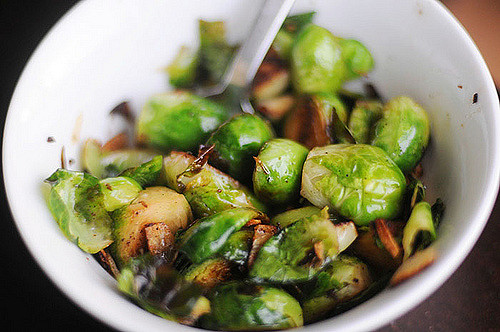
Photo: Mackenzie Kosut, flickr.com
Cauliflower
How to choose it: Tightly packed, creamy white florets are signs this veggie is at its best. Avoid spotted, yellowed or flowering florets.
How to eat it: Cauliflower Crust Pizza

Photo: pixabay.com
Broccoli
How to choose it: The best broccoli has firm stalks and crisp green leaves. Like cauliflower, avoid yellowed or flowering florets.
How to eat it: Skinny Chicken Broccoli Stir Fry

Photo: liz west, flickr.com
Cranberries
How to choose them: Cranberries should be firm, plump, shiny and fire-engine red.
How to eat them: Whole-grain Cranberry Oat Bars

Photo: Pen Waggener, flickr.com
Eggplant
How to choose it: The best eggplants will have smooth, naturally shiny skin that gives slightly and bounces back when pressed gently. Unripe flesh won’t give, and overripe flesh won’t bounce back.
How to eat it: Eggplant and Zucchini Parmesan

Photo: יגאל שרגיאן, Wikimedia Commons
Kohlrabi
How to choose it: Select firm, heavy kohlrabi with crisp, deeply colored leaves that show no signs of yellowing on their tips. The base shouldn’t have any cracks.
How to eat it: Kohlrabi Slaw

Photo: pixabay.com
Grapes
How to choose them: Firm, plump grapes are the best. Try to avoid getting grapes that look wrinkled.
How to eat them: Green Grape and Avocado Quinoa Salad

Photo: publicdomainpictures.net
It’s no secret that exercising isn’t always a blast — the views from a treadmill are never too exciting and stationary biking can only take you so many places. But what if there was an activity that would allow you to:
a. enjoy the outdoors
b. get some exercise
c. explore your community
…you’d jump at the opportunity, right? Whether they are gravel, paved or grassy, trails are the perfect place to exercise outdoors!
In the Fox Cities
The Fox Cities and surrounding areas are filled with trails for hiking, biking, walking and running that will make your next workout a fun, new adventure! In addition, studies have proven that there are actually several benefits of exercising outside. Check out this interactive map to discover all of the trails near you.
In Wisconsin
If you want to expand your adventures outside of just the Fox Cities area, check out the more than 3,730 miles of hiking and biking trails that wind through Wisconsin’s many state parks, forests and other recreational areas.
Comment below with your favorite trails in the area! (Feel free to share pictures, too!)
Horicon National Wildlife Refuge
Becoming a vegetarian isn’t for everyone, but it does have some fact-based health benefits that are worth considering.
“A large body of scientific literature suggests that the consumption of a diet of whole grains, legumes, vegetables, nuts, and fruits, with the avoidance of meat and high-fat animal products, along with a regular exercise program is consistently associated with lower blood cholesterol levels, lower blood pressure, less obesity and consequently less heart disease, stroke, diabetes, cancer, and mortality.” – Winston Craig, MPH, PhD, RD
Luckily, making the transition to a plant-based diet isn’t as hard as you might think! So whether you’re thinking about cutting back or cutting it out all together, here are three easy-to-follow steps to removing meat from your diet:
1. Hit the books — or, well, the Internet.
The most important part of adopting this new lifestyle is having a well-rounded idea of what you’re getting yourself into. Along with figuring out meatless protein sources and other tips for crafting meat-free meals, you might also want to research the facts about why cutting meat out of your diet is good for your health and the well-being of the environment. This will help reaffirm your decision to go meat-free and will ultimately make the transition easier for you (and easier to explain to your curious friends and family).
2. Wean yourself off.
This part can be tricky! However, vegetarianism is very personal and looks different on everyone; there’s not one right or wrong way to go about it. While one person might actually find it easiest to just stop eating meat cold turkey (no pun intended), another person might need a few weeks or a few months to slowly replace meat in their diet with plant-based alternatives.
3. Experiment!
This is where the fun begins! Try new vegetarian recipes, figure out how to use new ingredients and explore the vegetarian/vegan section of your local grocery store.
Again, being a vegetarian can be whatever you want it to be. Figure out what works for you and go with it. Do you still want to eat fish? Okay, that’s fine! Eggs? Totally fine, too. You can even decide to still keep some meat in your diet if you decide that’s what works best for you (i.e. just cut out red meat, still eat sustainably sourced meat on occasion, etc.). It’s all up to you and your well-being!
If you want to learn more about a vegetarian lifestyle as it relates to your health, here are a few awesome resources:
- http://health.usnews.com/best-diet/vegetarian-diet
- https://www.nutrition.gov/basic-nutrition/eating-vegetarian
- http://www.mayoclinic.org/healthy-lifestyle/nutrition-and-healthy-eating/in-depth/vegetarian-diet/art-20046446?pg=1
A healthy lifestyle is composed of several elements that all work together to keep you and your body in tip-top shape. And I’m not just talking about physical shape. Taking care of your body includes taking care of the thing that protects it: your skin.
According to the Skin Cancer Foundation, one in five Americans will develop skin cancer at some point in their lives due to exposure to ultraviolet (UV) radiation from the sun. But there are things you can do to avoid becoming part of that statistic!
Whether you’re laying on a beach, working in the garden, going for a swim or taking a leisurely outdoor stroll, here are some need-to-know tips about sun safety — some of which you might not have known to be true (or false!):
You can’t get sunburned on a cloudy day.
UV radiation can penetrate clouds and in some cases might even be more intense due to reflection off the bottom of the clouds. And since UV radiation doesn’t correlate with temperature, it’s important to still wear sunscreen on cool days. If you want to know how cautious you need to be, you can check each day’s UV index.
Having a “base tan” means you won’t burn.

Studies have found that when it comes to having a base tan to protect yourself against future sunburn from UV exposure, the benefits are slim to none. To be more specific, a base tan only provides a sun protection factor (SPF) of about 3 or less. And what’s worse, obtaining a base tan from a tanning bed would only offer an SPF of about 1.5 (not to mention all the other serious downsides of tanning beds).
Your risk of getting burned is higher when you’re in the water or around sand or snow.

Because of the high UV reflective properties of these surfaces, you are more likely to get redder, faster. And if you’re in water, make sure to be applying sunscreen more frequently to ensure continual sun protection.
Taking certain medications can make you more sensitive to the sun.

Be extra cautious to sun exposure if you are taking specific types of antibiotics, anti-inflammatories, blood pressure medications, antifungals or chemotherapies.
It doesn’t matter if your sunscreen is expired.

Just like you wouldn’t put spoiled products into your body, it’s not in your best interest to put spoiled sunscreen onto your body. When sunscreen expires, it means it has lost power due to deteriorating ingredients. Check expiration dates before heading out in the sun to make sure you’re getting fully effective UV protection.
Sunscreen should be applied at least every two hours.
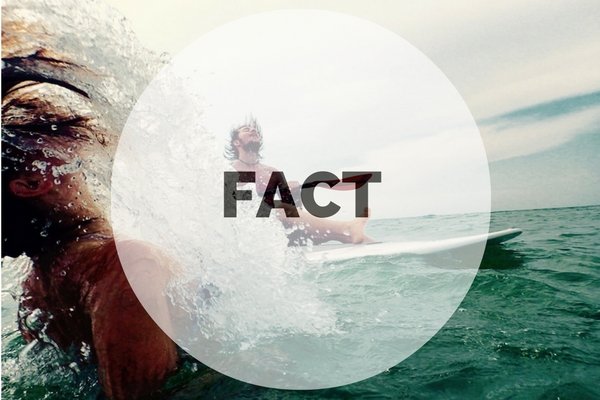
Lathering up one time at the start of your day in the sun isn’t enough to get the job done. Reapplication is suggested every two hours, and even more than that if you’re swimming or sweating.
You don’t have to apply sunscreen to your face if your makeup contains sunscreen.

If you know you’re going to be in the sun for a bit, you should apply regular sunscreen underneath your makeup. Most cosmetic products offer an SPF protection of much less than the recommended 30. You can protect your lips from getting burned by using a lip product that is at least SPF 30.
Be attentive. Know your moles, check your skin for any changes and be aware of anything that might be growing or bleeding. If you spot anything out of the ordinary, see your dermatologist as soon as you can.
For those of us who were fortunate to have grandparents that were farmers, we remember clean eating as a way of life. One of my favorite memories includes a Mason jar of pasteurized milk. I can remember my grandmother shaking it vigorously before pouring me a glass. While the milk was safe for consumption, it wasn’t homogenized causing the cream to float to the top, leaving me with the ultimate milk mustache.
Basic Principles of Clean Eating
By definition, a fad is something that is popular for a short time. Since the principles go back several years, it is clear clean eating is not a diet, fad or trend.
Let’s start with a list of what clean eating is not:
- Clean eating is not about removing entire food groups from your diet.
- Clean eating is not about restricting your caloric intake.
- Clean eating is not about making you shop in only one aisle of the grocery store.
- Clean eating is not about picking “low-fat” or foods with “35% less sugar.”
- Clean eating is not meant to be a weight loss solution.
 The key to eating clean is choosing to eat foods with the least amount of ingredients possible. My mind is going back to the old Breyer’s ads where children try (and ultimately butcher) reading the ingredients off a container of ice cream. Go ahead and treat yourself with ice cream, but maybe opt for the one with ingredients you can pronounce.
The key to eating clean is choosing to eat foods with the least amount of ingredients possible. My mind is going back to the old Breyer’s ads where children try (and ultimately butcher) reading the ingredients off a container of ice cream. Go ahead and treat yourself with ice cream, but maybe opt for the one with ingredients you can pronounce.
Getting Started
The best part about clean eating is that you can start today and it won’t require you to throw out your entire pantry.
Begin by choosing the healthiest version of the food you have on hand. A basic rule of thumb is to try avoiding foods that have long shelf lives or food that you know wouldn’t be sitting on a shelf if it didn’t contain a lot of preservatives.
For me, I am always slightly creeped out by strawberry or chocolate milk that doesn’t require refrigeration.
When replacing items, make better food choices such as buying peanut butter with fewer additives or opt for the whole grain pasta instead of regular.
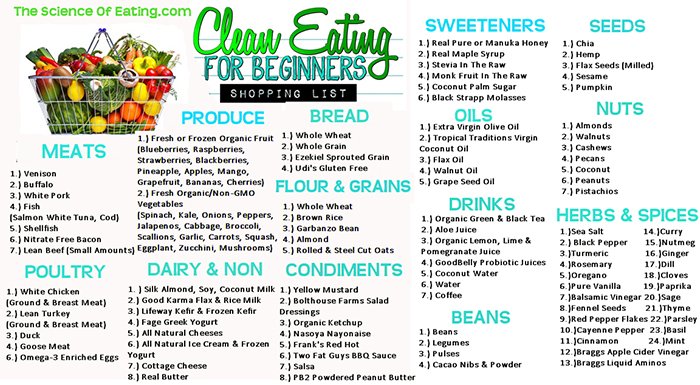 Here’s a list of other ideas:
Here’s a list of other ideas:
- Search for shopping lists (here is one we recommend).
- Create a Pinterest board filled with recipes you want to try.
- Visit Appleton’s farmers market as it’s a gold mine when it comes to choices and selections, stocked with fresh produce, local meats, honey and the like.
Spending Time in the Kitchen
Clean eating is not going to add hours to your kitchen routine. There are many ways to vegetables and proteins to make meal combinations that last for several days.
Right now, I’m kind of obsessed with brussels sprouts and cauliflower. I like to toss it with a small amount of olive oil and spices, then roast it in the oven or make a foil packet for the grill. I add a chicken breast or piece of fish to complete the meal.
You could also try the same meal with a homemade marinade as they are easy and provide clean eaters with endless options. Typically, recipes contain an oil, acid and a herb. I usually stick with extra virgin olive oil, lime or lemon juice or perhaps red wine vinegar for an acid and a herb such as oregano, basil or rosemary.
When making the above meal I try to make extra to have for lunch the next day, that way I have the convenience factor for packing a lunch and can stay away from processed lunch meat or frozen entrees.
My grandma made everything from scratch. Back in her day, families had large gardens and were able to butcher their own meat. I know that this is not a possibility for the majority of us. (I am a city dweller that somehow managed to kill off my herb garden and patio tomatoes.) But I have made a committment to cleaning up my diet and see this way of eating as a way of life, not just the latest trend.
If you have a favorite clean eating recipe, please share it in the comment section below.
If you’re like me, you’ve probably been spending a lot of time sitting in front of the TV this week cheering on team USA. Its time to get off the couch! Channel your inner Olympian and use Games as inspiration for your olympic-style workouts. The best part? You don’t have to go all the way to Rio!
Here are a few sports from the Summer Olympics you can try your hand at right here in the Fox Valley. And who knows, maybe you’re on your way to being the next Michael Phelps or Kerri Walsh Jennings!
Badminton
“Playing badminton builds and tones the quads, glutes, calves and hamstrings. In addition, your core muscles, arm and back muscles get a workout as well.” – Health Fitness Revolution
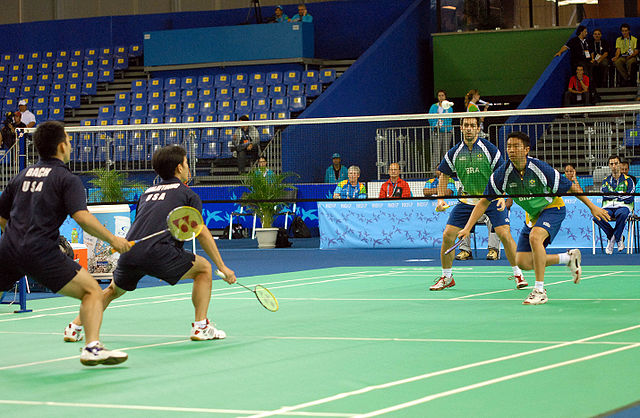
Photo: Wilson Dias/ABr
Basketball
“Running, jumping and quick lateral movements done in basketball provide a significant amount of aerobic exercise and can burn a great deal of calories.” – Health Fitness Revolution

Photo: AP/Christian Petersen
Biking

Photo: David Iliff
“Cycling is an excellent exercise for burning calories. A person cycling with a speed of 10 mph burns 260 calories in an hour.” – Organic Facts
Canoeing
“It’s a low impact activity that can improve aerobic fitness, strength and flexibility.” – British Canoeing

Photo: David Merrett
Soccer
“The constant walking, jogging and running helps keep the players’ heart rates up, providing excellent cardiovascular exercise.” – Health Fitness Revolution
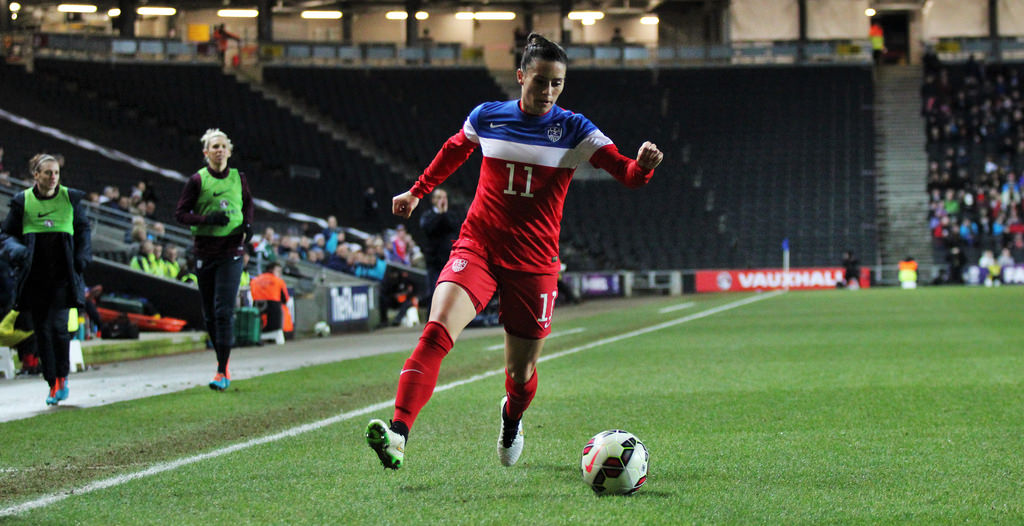
Photo: joshjdss, Flickr
Swimming
“You’ll get stronger from the resistance of the water, which is about 12 times the level of air resistance.” – Kara Mayer Robinson, WebMD

Photo: Doma-w, Wikimedia Commons
Tennis
“Tennis helps your bone strength and density by strengthening bones of young players and helping prevent osteoporosis in older ones.” – Jack L. Groppel, Ph.D., USTA

Photo: Edwin Martinez
Track & Field
“Studies have shown that running can help prevent obesity, type 2 diabetes, heart disease, high blood pressure, stroke, some cancers, and a host of other unpleasant conditions.” – Jennifer Van Allen, Runner’s World

Photo: Pixabay
Volleyball
“The physical activities involved in playing volleyball will strengthen the upper body, arms and shoulders as well as the muscles of the lower body.” – Health Fitness Revolution

Photo: akiwitz, Wikimedia Commons
Water Polo
“When you play water polo, you are guaranteed a non-stop, fat-burning workout.” – Health Fitness Revolution

Photo: Massimo Finizio
Weight Lifting
“Strength training can offer speedy results. It only takes two to three weekly sessions (for less than a month) to see muscles shape up.” – Laura Schwecherl, Greatist
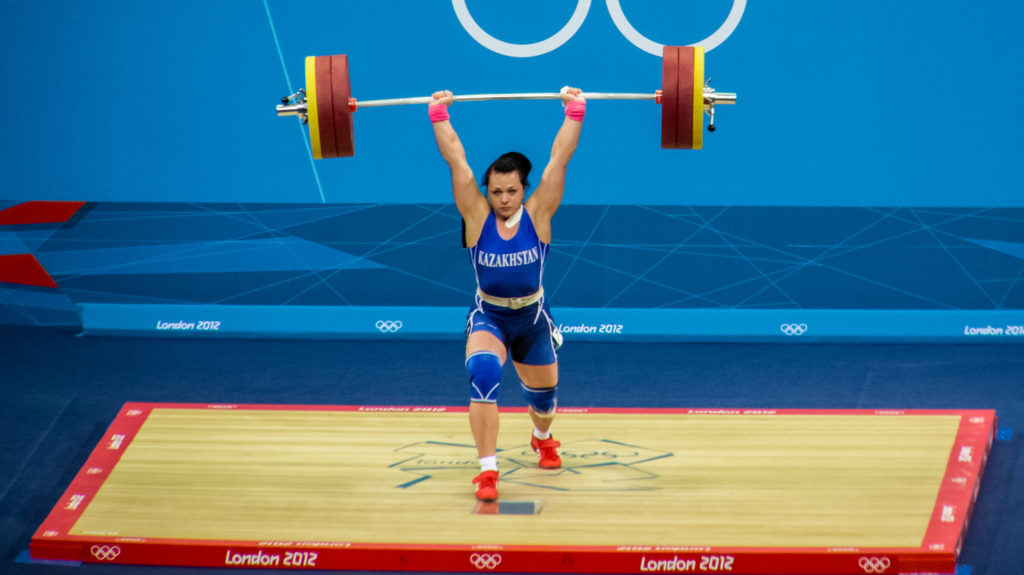
Simon Q, Wikimedia Commons
A nice, long drink of cold water on an 85 degree summer day is not only refreshing, it’s essential to your well-being! Without water, our organs can’t function properly, our bodies can’t maintain a stable temperature and our joints can’t stay lubricated. So, how can you fight dehydration during these hot summer months to keep your body running like well-oiled machine? Check out these simple tips and find out all you need to know about H20:
Know the symptoms
It’s important to be aware of your body and know that you may be dehydrated if you’re experiencing:
- Dry mouth
- Fatigue or sleepiness
- Headaches or dizziness/lightheadedness
- Confusion
- Extreme thirst
Spice it up
If you’re bored with the monotony of water, try adding some flavor! You can infuse your water with fruit, herbs, spices, vegetables and even edible flowers!
Follow the rule of 8’s
As a general rule, you should be drinking about eight 8-ounce cups of water each day. Some people need less and some people may need more, but the “rule of 8’s” is easy to remember!
Sip on tea or coffee
Even though these drinks are caffeinated, they can add to your daily water intake and can be a tasty break from your daily water routine!
Understand your risk level
You are at a higher risk of dehydration and need to pay closer attention to your H20 intake if you:
- Are pregnant or breastfeeding
- Have a fever or are sick
- Are either a child or older adult
- Have certain medication conditions
- Are outside during hot weather
- Are exercising
- Have been drinking alcohol
Turn to fruits and vegetables
About 20% of our daily water intake comes from fruits and veggies! Try out these foods that will help keep you hydrated.
Do the toilet test
Keep an eye on your urine. If you’re properly hydrated, it should be light yellow or even clear. Dark urine indicates that you may be dehydrated.
Keep a reusable water bottle with you
If you always have one with you, you can refill it multiple times throughout the day and don’t have to worry about wasting money on bottled water.
Remember that even though drinking enough water in the summer is extremely important, the importance of hydration is year round. Bottoms up!
‘Tis the season of farmers markets! It doesn’t get much better than fresh, local produce. Doing your weekly grocery shopping at one of the several farmers markets located in the Fox Valley this farm market season might just be the best thing you can do for yourself and your community! Here’s why:
Most produce items sold at local farmers markets are picked within a day of the market.
Fruits and vegetables begin to lose nutrients once picked. So if you’re eating carrots grown on a farm 12 miles down the road rather than from a store that had them shipped from a different state, you’ll be getting a bigger bang for your buck. Fresh-from-the-farm foods are as real, healthy and tasty as it gets!
Most food found at the markets are minimally processed.
This is in comparison to most of the food that you’ll find at your grocery store, which is generally quite processed and grown using pesticides, hormones, antibiotics, etc. And that’s not even taking into account what happens to food to keep it fresh during transit! Many local farmers take pride in using sustainable practices to ensure the freshest and most nutritious food possible for community members to enjoy.
Buying local helps support local farmers.
Today’s food industry is ruled by big companies, which doesn’t leave much room for small family farmers to compete. Buying local gives these farmers a fighting chance!
So, what are you waiting for? If you haven’t already, get out and explore one or more of these fantastic Fox Valley farmers markets this summer and into the fall!
Downtown Kaukauna Farmers Market
Farmers Market on Broadway (Green Bay)
Downtown De Pere Farmers Market
Downtown Fond du Lac Farmers Market
Downtown Oshkosh Farmers Market
Saturday Farmers Market (Green Bay)
Couch to 5k: RACE DAY!
Hello Friends and welcome to my Couch to 5k journey. This is the last post in the series but you can read more about me here. Last weekend I raced in my first 5k which was the first competitive event I have entered in 20 years. Now I can say that I am a runner and a racer. Although registering for the race provided the incentive I needed to train, I’m not sure I will enter another one. The satisfaction of completing the No Boundaries program and becoming a runner is reward enough for me. So how did I do? I am happy with my results. I was aiming for a ten minute mile and my pace ended up at 10:17. I finished 64th out of 376 in my age group and 1,374 out of 4671 overall. I felt okay during the run, not great and not terrible. After it was over I felt like I could have given it just a little bit more. The race included a lap around Lambeau which was novel but not very practical with so many runners. The narrow entryway created several bottlenecks and I had to briefly walk several times. Overall it was a great race. There is a lot of energy that comes with having so many runners. This year set a record for registrations, which pushed close to 5,000. The weather also could not have been more perfect. It was sunny, clear, warm and dry which is probably the only type of weather we didn’t experience on our training runs. As I have said previously I would do it again in heartbeat. It was such a rewarding and positive experience. If you have ever wanted to try running, or get in shape, or meet new people then this program is for you. There are so many reasons to participate. And if I can do it then so can you! Thank you for joining me here week after week. I hope you to see you on the trail! Until then keep running.

At Lambeau with Heather Veeser
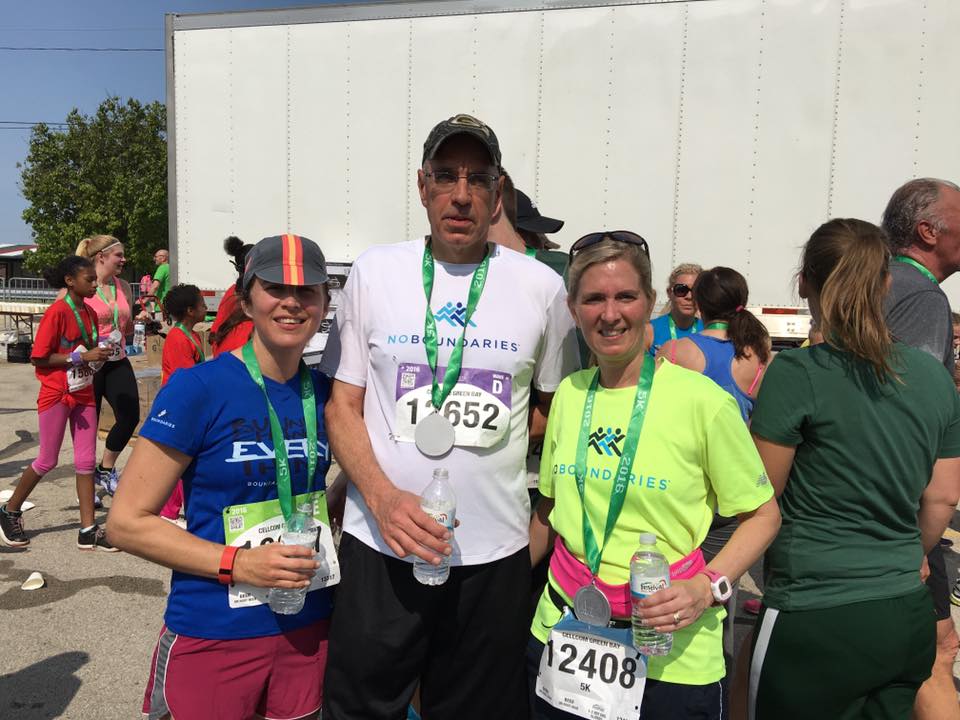
Me, Dave and Heather after finishing
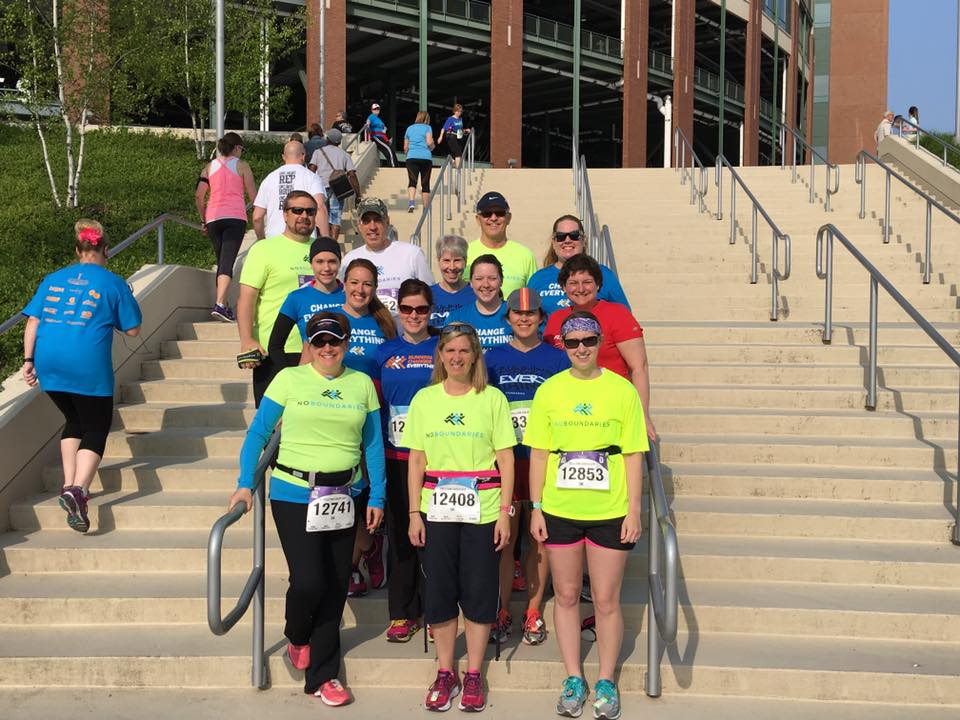
No Boundaries team
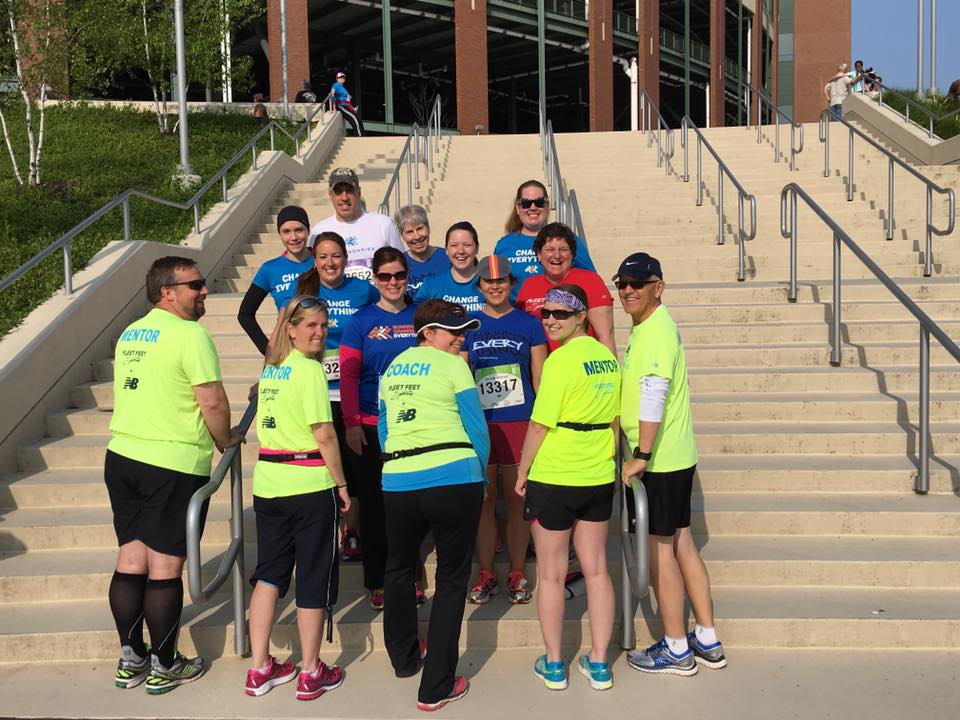
No Boundaries redux
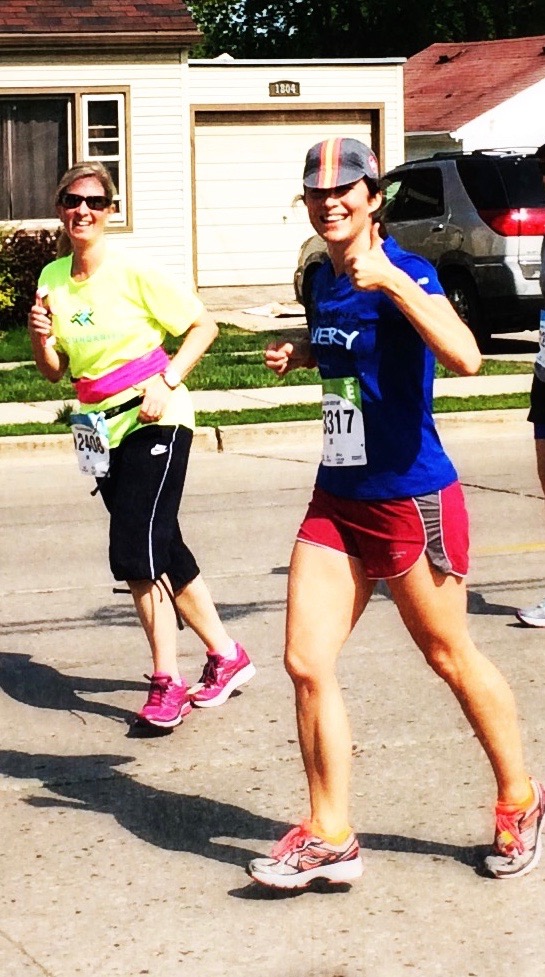
Thumbs up!
Healthy Diet: Lentil Salad with Roasted Vegetables
Whenever I think about healthy eating the first thing that pops into my head is lentils. Just the act of eating them makes me feel like I am supping at the fountain of youth. While there is no research to validate my theory, they are a nutritional powerhouse. Lentils contain potassium, calcium, zinc, niacin and vitamin K, but are particularly rich in dietary fiber, lean protein, folate and iron. Pair lentils with roasted vegetables and you have reached nutritional nirvana. Well, maybe not, but you can feel good about serving this meal to your family. The lentils taste earthy, the bacon adds smoky goodness and the roasted vegetables bring a hint of sweetness that comes with caramelization. The sherry vinaigrette and tangerine juice at the end ties it all together with its brightness. This recipe is the perfect make-ahead dish for any potluck party this summer, although I would wait for a cooler day to make it since you have to use your oven. It can either stand on its own or be a side dish. We ate it for dinner one night and then had the leftovers two days later as a side. If you plan on making it ahead, then reserve the radicchio and dressing until just before serving. Also, feel free to add whatever vegetables you have on hand. You can’t go wrong here.
INGREDIENTS
FOR THE LENTIL SALAD:
- 1 small whole butternut squash, peeled, halved, seeded and diced into 1/2-inch pieces
- 2 medium carrots, peeled and diced into 1/2-inch pieces
- 3 small beets, peeled and diced into 1/2-inch pieces
- 2 tablespoons extra-virgin olive oil
- ½ teaspoon salt
- 2 sprigs thyme
- 1 sprig rosemary, cut in half
- 4 slices (4 ounces) bacon, cut into 1-inch pieces (optional)
- 2 cups brown or green lentils
- 2 garlic cloves, smashed and peeled
- 1 bay leaf
- 1 ½ teaspoons kosher salt, more to taste
- ½ teaspoon black pepper
FOR THE SHERRY VINAIGRETTE:
- ¼ cup sherry vinegar, more to taste
- 2 teaspoons Dijon mustard
- ½ teaspoon salt
- ½ cup extra-virgin olive oil, more as needed
FOR SERVING:
- 1 head radicchio, sliced
- 2 scallions, thinly sliced (whites and greens)
- Parsley, roughly chopped, for garnish
- Flaky sea salt, to taste
- Cracked black pepper, to taste
- 1 tangerine, halved and seeded
PREPARATION
- Heat oven to 400 degrees. Place vegetables in one layer on one or two large rimmed baking pans, toss with olive oil and salt. Place thyme and rosemary on top of vegetables, cover pans with foil and roast for 25 minutes. Remove foil, stir in bacon and bake for 30 to 40 minutes longer, until vegetables are tender and golden all over.
- In a large pot, combine lentils, 6 cups water, garlic, bay leaf, salt and pepper and bring to a boil over high heat. Reduce heat to low and simmer for 20 to 30 minutes, until lentils are tender.
- In a small bowl, whisk together vinegar, mustard and salt. Then whisk in olive oil.
- Drain lentils and discard bay leaf; keep or discard garlic as you like. Toss lentils with half of the sherry vinaigrette while still warm. Add more salt, olive oil and vinegar as needed.
- Toss radicchio with enough of remaining vinaigrette to lightly coat it and arrange it on a platter. Combine lentils and roasted vegetables, adding more of the vinaigrette to taste; spoon mixture on top of radicchio. Garnish with scallions, parsley, sea salt and black pepper. Squeeze tangerine juice over the lentils and drizzle with more olive oil if needed.
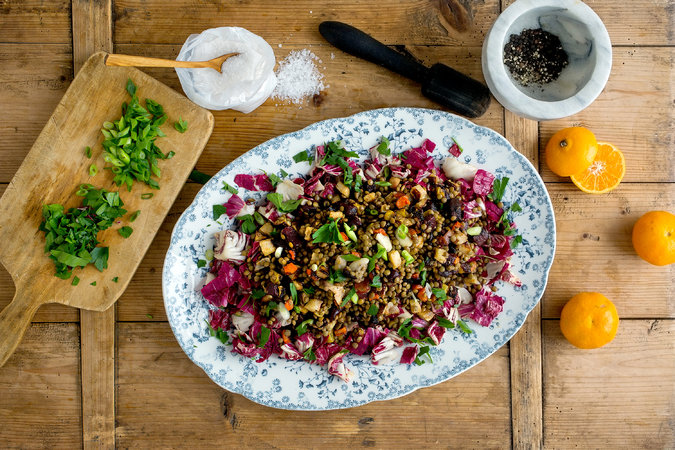
Lentil Salad with Roasted Vegetables
Hello Friends and welcome back to my couch to 5k journey. Thank you for joining me here each week. It has been a rewarding experience and I have enjoyed these moments of reflection on this blog. After nine weeks of training we have finally arrived at our longest distance yet: 3.5 miles. As I have mentioned in an earlier post I have tried running at various points in my life but failed with each attempt. I didn’t stick with it long enough to build up any endurance or confidence. Now I have both and I have this program to thank for it. I joined because a friend had recommended it to me. Now I am recommending it to you. Mostly I wanted to challenge myself to try something that had been difficult in the past. But your reasons might be different. You may want to improve your fitness or lose weight or meet new people or have more energy or be a role model. Maybe you want to do all these things. And, yes, there is a race at the end of the program but it’s not about completing your first 5K. This program is about changing your mindset, adjusting your lifestyle and becoming the best version of yourself. Whatever your reasons, just say yes. There are barriers, I know. I felt them too. Your mind will tell you lies that sound something like this: “You are too old, too fat, too slow”, “You look stupid”, “You will fail”, “You are not a runner and never will be”. But trust me, if you ignore these rantings and just get out there, all the other pieces will fall into place. You will not regret it.
Okay, that’s my spiel. On to my report for the week. On Tuesday it was rainy and cold. I think we have run the gamut for weather during this program – sun, clouds, rain, wind, and sleet. It rained our whole run and I might have stepped in more than one very deep puddle. We took the path by Thrivent which is more scenic than running though neighborhoods. I even spied some deer along the way. On Thursday it was much more pleasant. Both runs were great and I feel strong. I think I am ready for the race. I will see you back here for my last update on race day. Until then, keep running!
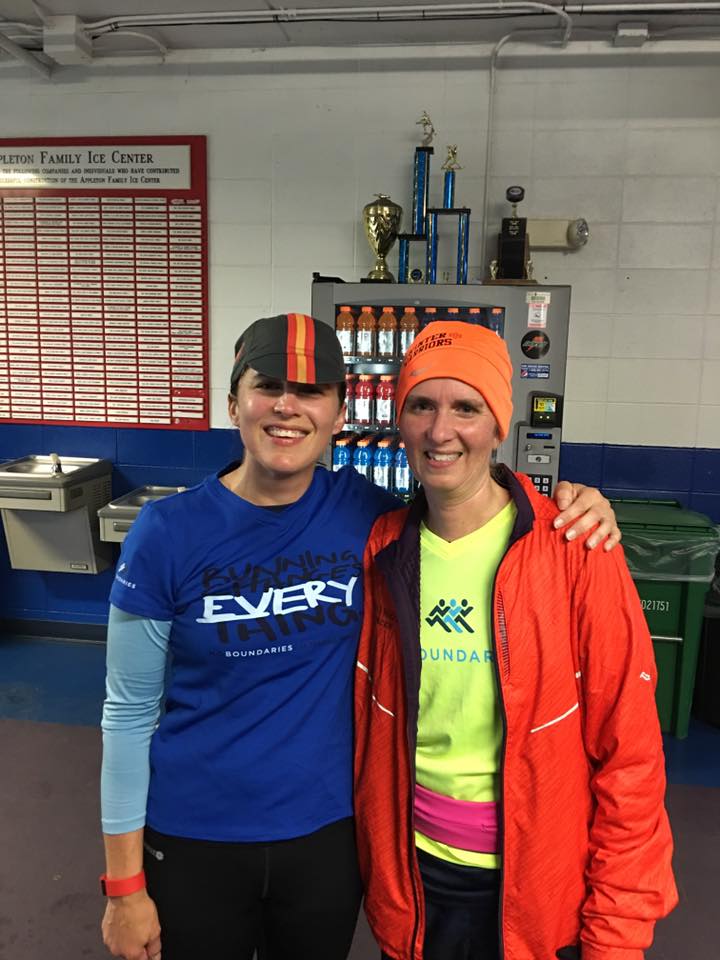
Me and my crooked hat. Thanks to Heather Veeser for remembering to take pictures.
Healthy Diet: Salmon Burgers
Adapted slightly from the New York Times
Let’s take a minute to discuss one of my favorite ingredients: salmon. Not only is salmon a super-food but it is one of those ingredients that seems to taste good no matter how you prepare it. The variations are endless. Try smoked salmon with spinach, blueberries and avocado for a “brain power salad” or perhaps pair it with asparagus and fettuccine for an easy weeknight pasta dish. Grilled salmon can be made into sandwiches, skewered with pineapple, or slathered in dill butter and placed atop brown rice. It can be made into a delicious dip, added to a spicy curry, or roasted with cherry tomatoes. And of course there is my very favorite way to eat salmon, especially in the summer: the ultimate salmon salad. I have prepared all of these recipes and can vouch for the unique deliciousness of each one. This week I added one more recipe to my collection: salmon burgers. Sure, I have tried salmon burger recipes before but none really impressed me. Most recipes use bread and egg as a binder which can make the burger feel cake-like. This recipe omits the bread and egg and, thus, it feels more “meaty”, like a burger should. I paired the salmon burgers with multigrain tortilla chips for an easy weeknight dinner but you could easily add a salad or asian coleslaw for a side. I will be making these burgers all summer long and I hope you do too.
INGREDIENTS
- 1 1/4 pound salmon fillet preferably wild, skin and small bones removed
- ¼ cup finely minced shallot or green onion
- 2 tablespoons capers, drained, rinsed and coarsely chopped
- 2 teaspoons grated fresh ginger
- 1 tablespoon low-sodium soy sauce
- Salt
- freshly ground pepper to taste
- 1 tablespoon sesame oil
- 1 teaspoon Worcestershire sauce
- 2 tablespoons chopped cilantro
- Olive oil for the griddle or pan
- Lime wedges for garnish
- Whole grain hamburger buns
- condiments of your choice
PREPARATION
- Take 1/4 of the salmon and roughly chop it. Add chopped salmon to a food processor and puree the fish into a paste. Mince the remaining salmon using a sharp knife. Do not use a food processor for this part. Add the minced salmon and its paste to a bowl. Add remaining ingredients (except the olive oil and lime wedges) and blend together with a spatula or spoon. Shape into 1/2-inch thick patties. The mixture will be very wet when forming the patties so take care. Refrigerate, if possible, for 1 hour. If you are short on time you can also stick the patties in the freezer for 10-15 minutes.
- Heat a heavy nonstick skillet or a griddle over medium-high heat. Brush with olive oil and turn the heat to medium. Sear the patties for 2 to 3 minutes on each side, depending on how cooked you want the interior to be. Serve on buns, if desired, with the condiments of your choice.
Yield: 4 burgers
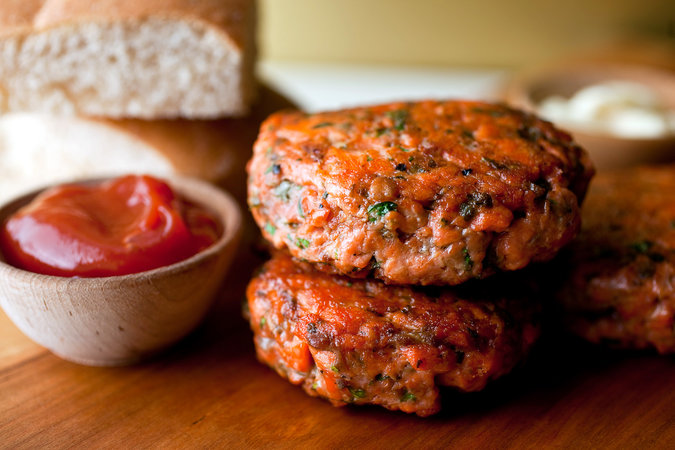
Hello Friends and welcome back to my couch to 5k journey. We are now 8 weeks in but if you’re new and want to know more about me then click here. We are now up to 3.25 miles for our practice runs. Running over 3 miles seemed impossible when I first started and now it feels like just another training run. The gradual increase in distance not only builds strength and endurance, it also builds self-confidence. Running is as much, if not more, a mental battle rather than physical one. At the beginning of this journey I had a negative mindset. I told myself “I’m too slow, I look stupid, I can’t handle this.” What I had before starting this program was a lot of self-doubt. I see now that these statements created limiting beliefs. My mind was limiting what my body could actually do. The best thing I have learned to do is think positively and believe in myself. It sounds cheesy but it works. Simple self-confidence will give you the ability to handle adversity, to stick to your game plan even when you encounter obstacles and to push yourself to places you haven’t been before. And even if you don’t feel confident the best thing to do is fake it until you make it. If you tell yourself you’re a confident runner, sooner or later you will become one.
This week my husband was out of town for work so I missed the group run on Tuesday night. Luckily I snuck in a run the next day while my daughter was at preschool. I ran a loop along the Fox River Trail – the same one the Mizuno Fun Run/Walk Group takes on Tuesday nights at 6 p.m. I added a couple of hill sprints for good measure. On Thursday night my husband was back but I was feeling so tired from single parent duty that I almost didn’t go. I used that trick I use to motivate myself and, as usual, it worked. I ran with the slow group for the first half and then as I started to warm up, I perked up enough to pick up the pace for the second half. Next week is our penultimate mileage of 3.5 miles. Race day is almost here! Until then keep running.

Healthy Diet: Fattoush Salad
Adapted slightly from Global Table Adventures
Last month for book club we read Life From Scratch: A Memoir of Food, Family and Forgiveness, which chronicles food writer and blogger Sasha Martin’s attempt to make a meal from every country in the world. She starts with Afghanistan and ends with Zimbabwe. In our book club the host always picks the book. We usually read fiction but we occasionally throw in a memoir for good measure. Our host picked this book because she loves food, both cooking and eating it. She made a variety of recipes featured in the book for us to enjoy. One was Fattoush Salad. I could not stop eating it. It is bursting with flavor and has lots of lively acidity to brighten your palate. It contains no meat but you could easily add grilled chicken or a can of drained chickpeas to give it more heft. Also, don’t let the name throw you. It is a simple salad with ingredients you can easily find in your grocery store.
Ingredients
- 2 lemons juiced but not strained
- 1/2 cup olive oil
- 3 cloves garlic, crushed
- 1 tsp salt
- pepper to taste
- 1 head romaine lettuce torn or sliced
- 1 cucumber, sliced in quarter moons
- 2 cups cherry tomatoes, halved
- 1 cup mint, chopped
- 1/2 cup parsley, chopped
- 1 green or red bell pepper (or both), chopped
- 6 green onions, sliced
- 2 pieces pita bread, toasted and broken into small pieces (shortcut: use store-bought pita chips instead)
- feta, crumbled to taste
- optional: 1 cup Kalamata olives, pitted and sliced
- optional: sliced radishes
- optional: artichoke hearts
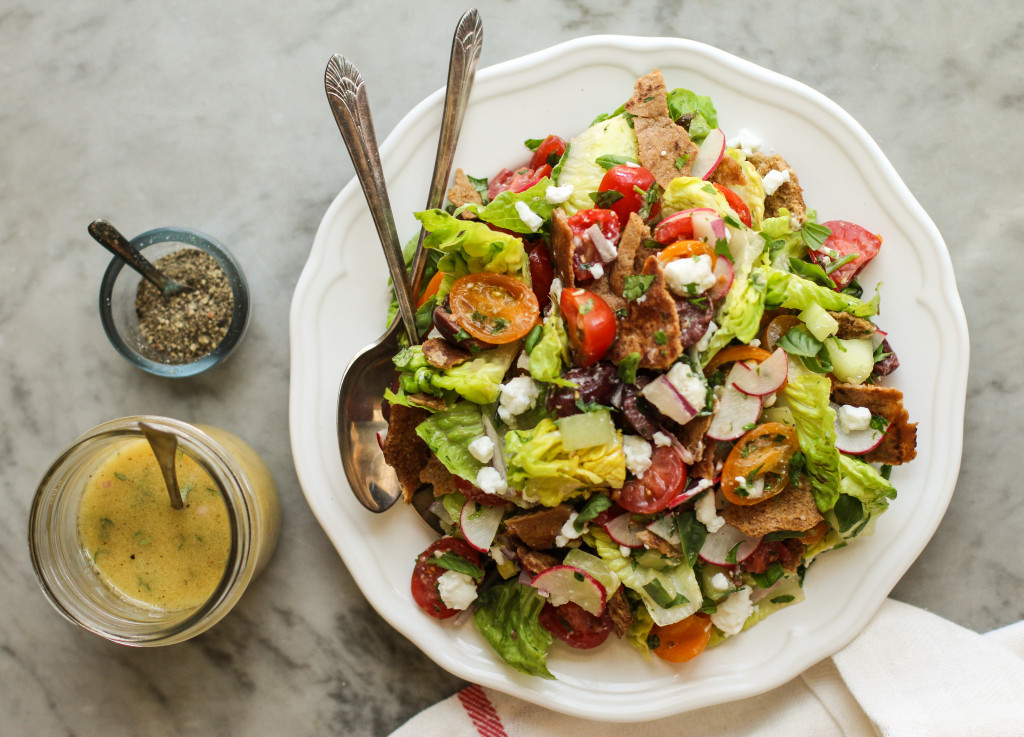
Photo credit: Girl on the Range
Hello Friends and welcome to week seven of my couch to 5K journey. You can read more about me here. It is hard to believe that there are only 3 weeks left in the program. Race day is just around the corner. I am more anxious about the program ending than I am about running the race. I want to keep running as part of my fitness regimen and I am worried that I won’t have the motivation to do it on my own. The bi-weekly group runs provide the accountability I need. Luckily I discovered a new group run that I can join after this program ends. It’s called the Mizuno Fun Run/Walk Group. It meets at Mr. Brews Taphouse on Tuesday nights at 6 p.m. You can run or walk 3, 4, 5, or 6 miles Our group joined them this week for our 3 mile run and it was probably the best night of the program. The route around the Fox River is scenic, the energy is infectious and afterwards you get to have a beer. Also, the change in scenery made the run go by quickly. There were a few hills, some of them steep, but what goes up must come down. The last leg of the run was downhill by the Banta Bowl. After a few hills it was nice to put my legs on cruise control and coast into the finish. I completed 3 miles in 31:30 which put my pace at 10:30 per mile. After stretching and hydrating, I had a beer with a friend and called it a night. On Thursday we repeated 3 miles at our usual location. I’ll admit that it is nice to have a little enticement, like a cold beer, at the end of your run. I definitely ran a little slower without the proverbial carrot at the end of the stick. Overall it was a great week. My pace is right around 10:30 for 3 miles and I am happy with that. Again, I am not invested in obtaining a certain time for the race. I simply wanted to challenge myself and add a new fitness skill to my repertoire. I think I have done that. Next week we up the mileage to 3.25. Until then, keep running.

Healthy Diet: Guacamole
Adapted slightly from Simply Recipes
It is Cinco de Mayo on Thursday which, contrary to popular belief, is not just about drinking margaritas and eating tacos. It commemorates the Mexican army’s 1862 victory over France at the Battle of Puebla during the Franco-Mexican War (1861-1867). It is a relatively minor holiday in Mexico as compared to the United States where the day has evolved into a celebration of Mexican culture and heritage. I don’t really buy into the party ethos that surrounds the day but I do like to whip up a Mexican feast. Whether it’s tacos, enchiladas or nachos, everything is better with a dollop of guacamole. And even if you are planning on going out, it is easy to make some guacamole as a pre-party snack. It is always a good idea to have something in your stomach before you start drinking those margaritas. You can buy Hass avocados at any grocery store, although most likely they will be hard and green. To speed the ripening process, put your avocados into a paper bag and leave them on the counter for 24 hours. If you forgot to buy avocados at the grocery or cannot find ripe ones in time, then try your local Kwik Trip. The one by my house always carries just-ripe avocados. Try it next time you are craving guacamole and there is nary a ripe avocado to be found. Also this recipe can be doubled easily if you are expecting a crowd.
INGREDIENTS
- 2 ripe avocados
- 1/2 teaspoon Kosher salt
- 1 Tbsp of fresh lime juice or lemon juice
- 2 Tbsp to 1/4 cup of minced red onion or thinly sliced green onion
- 4-8 dashes of Tabasco
- 2 tablespoons cilantro, finely chopped
- A dash of freshly grated black pepper
- 1/2 ripe tomato, seeds and pulp removed, chopped
METHOD
- Cut avocado, remove flesh: Cut the avocados in half. Remove seed. Score the inside of the avocado with a blunt knife and scoop out the flesh with a spoon. Place in a bowl.
- Mash with a fork: Using a fork, roughly mash the avocado. (Don’t overdo it! The guacamole should be a little chunky.)
- Add salt, lime juice, and the rest: Sprinkle with salt and lime (or lemon) juice. The acid in the lime juice will provide some balance to the richness of the avocado and will help delay the avocados from turning brown.
- Add the chopped onion, cilantro, and black pepper.
- Remember that much of this is done to taste because of the variability in the fresh ingredients. Start with this recipe and adjust to your taste.
- Cover with plastic and chill to store: Place plastic wrap on the surface of the guacamole cover it and to prevent air reaching it. (The oxygen in the air causes oxidation which will turn the guacamole brown.) Refrigerate until ready to serve.
- Chilling tomatoes hurts their flavor, so if you want to add chopped tomato to your guacamole, add it just before serving.
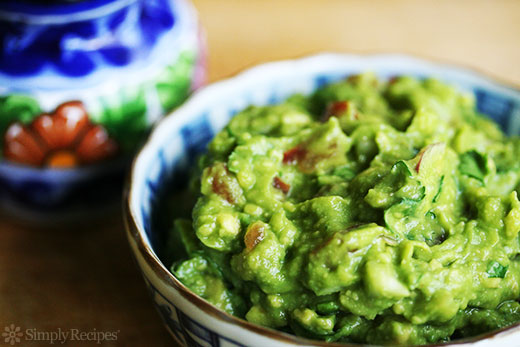
Photo credit: Simply Recipes
Hello Friends! Welcome to week six of my couch to 5k journey. You can read more about me here. This week we upped the mileage to 2.75 miles. On Tuesday I wasn’t feeling very well and my goal for the night was just to show up. Sometimes when I am tired or feeling blah, I trick myself into working out by saying that all I have to do is show up. I give myself permission to do what my body needs, which may include taking it easy or not exercising at all. Once I am there, whether it’s at spin class or out for a run, I usually muster the energy to exercise as planned. After I warm up I start to feel a lot better and somehow I find the extra energy to get the job done. Sometimes I will go slow but then I figure that light exercise is always better than no exercise. The hardest part for me is finding the motivation to show up. Once I am dressed and out the door then the hard part is done. It may sound silly but it works most of the time. I showed up on Tuesday feeling blah and I still ran 2.75 miles. I finished in 30:13 which is slower than normal but that’s okay with me. I got out there and I did it. On Thursday I felt much better. I ran with one of the faster mentors and she challenged me to quicken my pace. We finished in 27:30.
Another observation I have made is how few calories I burn during my runs. I got a Fitbit for my birthday this year, which calculates heart rate, steps, stairs, distance and calories. Typically for a 30 minute run I will burn around 300 calories. It feels hard when I am running so I just assume that I am burning more than that. Not so. It makes me think twice about indulging in empty calories because I realize how hard it is to burn them off. Healthy habits, like running, beget more healthy habits, like healthy eating. Okay, that’s all for now. Next week it’s 3 miles. Until then keep running!

Quinoa, Corn, Scallion and Goat Cheese Salad
Last week we took a short break from my obsession with whole grains for a granola recipe. This week grains are back in this wonderfully fresh and satisfying salad that is equally appropriate for lunch or dinner. This recipe is an improvised riff on the classic Middle Eastern tabbouleh which typically includes tomatoes, parsley, mint, bulgur and onion and dressed in an olive oil and lemon juice. Here parsley and quinoa are the star ingredients while the corn, cashews and goat cheese lend it some heft. We ate this salad for dinner and I loved the herbaceous kick of the parsley paired with the sweetness of the corn and the tang of the goat cheese. Each crunchy bite has a delicious combination of flavors and textures. This is a great salad to add to your repertoire and will only get better once the sweet corn arrives at the Farmer’s Market.
INGREDIENTS
1¼ cups quinoa
4 ears of corn or 1 large can of corn kernels (I used ½ bag of frozen corn)
1 bunch of scallions (about 3), chopped
1 bunch flat-leaf parsley, finely chopped
2 small heads baby romaine lettuce, chopped
1¼ cups aged goat cheese, cut into small cubes
1/3 cup cashews
For the dressing:
2 Tbsp. Dijon mustard
1 clove garlic, grated or finely diced
1 tsp smoked paprika
¼ cup white wine vinegar
2/3 cup grape seed oil or sunflower oil (if you don’t have either then olive oil works too)
Cook the quinoa for 20 minutes in a large pot with salted water. Drain in a sieve and rinse thoroughly under cold running water. Leave to drain. You can use a large wooden spoon to press on it to extract as much water as possible. In the meantime, cook the ears of corn for approximately 4-5 minutes. Rinse under cold water and cut the kernels from the cobs.
Make the dressing by whisking the mustard, garlic, paprika and vinegar. Blend in the oil slowly until a lovely dressing is obtained. If it is too thick, add some water.
Add all the ingredients to a large bowl. Pour the dressing over the salad and mix to combine. Serve and enjoy!
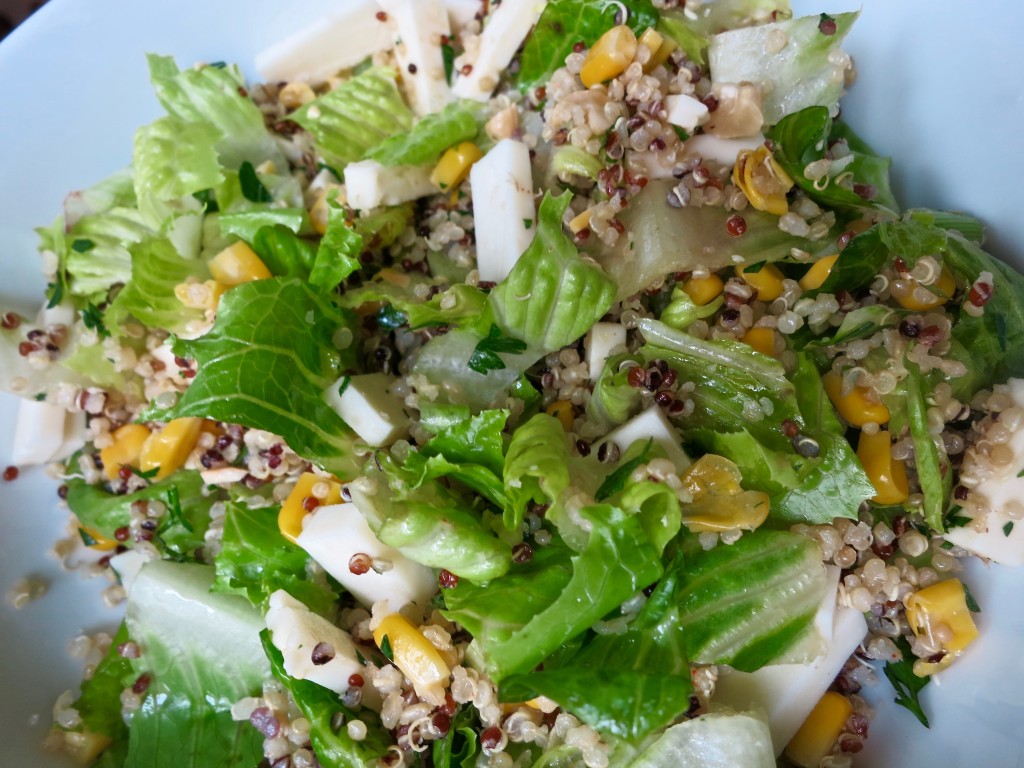
Couch to 5K: Week Five
Hello Friends and welcome to week five of my couch to 5k journey. You can read more about me here, here, here, here and here. We are officially half way through the program now and it is amazing how far I have come. As I have mentioned before I have never been able to add running to my fitness routine in any meaningful way. My best effort was after my son was born. I was determined to lose the baby weight and running (or walking) was the only way I could exercise with an infant in tow. I bought a used jogging stroller and took to the trail by our house. The best sustained running effort I achieved was 1.5 miles and it felt like a slog. I hated it so much I only got out once or twice per week. Now I am running 3-4x per week and we are already up to 2.5 miles. Each week we add 1/4 mile to the distance. The incremental increase builds strength and endurance so slowly that I hardly even notice we are running further. This week we ran 2.5 miles. On Tuesday I finished at 25:09 and on Thursday I finished at 25:33. I am very close to a ten-minute mile and it feels good. Hard but do-able.
At the start of the program I set three goals that I wanted to accomplish: (1) finish the Cellcom 5k in 30 minutes, (2) run continuously for 30 minutes and (3) incorporate running into my fitness routine. I would be thrilled if I achieved numbers 1 and 2 but the most important goal for me is to make running a permanent part of my life. Running is one of those skills that I can carry with me in all stages of life. It is portable, requires minimal equipment and gets you a good workout in a short amount of time. After five weeks I can feel the barriers to running starting to crumble. Now I am no longer intimidated to go for a run. I feel confident that I am indeed a “runner” even if I go slow or I only run 2-3 miles. I will be the first to admit that running is not my favorite way to exercise. I still prefer cycling or hiking or cross-country skiing. But now I can add running to my fitness repertoire without feeling like it’s too hard or I feel stupid doing it. I am starting to feel like it is here to stay. Running is just one more way to stay healthy and that is something I can get behind. Speaking of behinds, take a look at ours! Next week: 2.75 miles. Until then keep running!
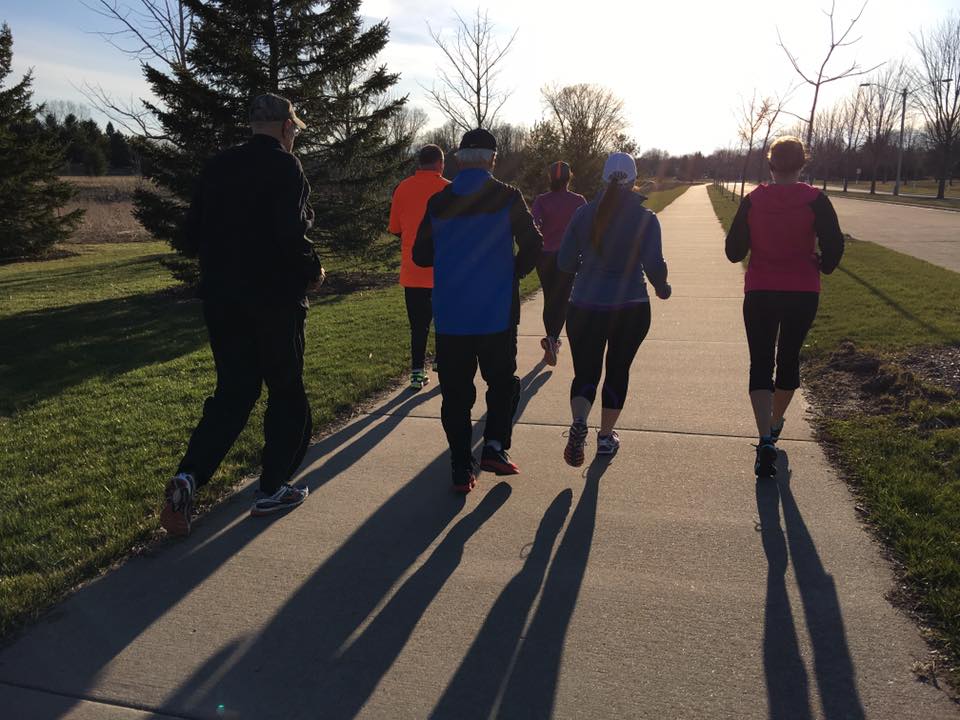
Low Sugar Cherry Walnut Granola
I have been eating this granola almost every day for the last year and I need a change. Nothing too drastic, mind you, because I still love my yogurt and granola combination in the morning. The granola packs a satisfying crunch and is slightly sweet while the yogurt provides a creamy tang as a contrast. It is delicious and keeps me full until lunchtime. Plus the latest research shows that full fat dairy may have protective effects, both in cutting the risk of diabetes and in helping people control body weight. When I stumbled upon this recipe in the Wall Street Journal I knew it was just the change I needed. This granola is more loose than others I have made so if you like clumpy granola then this is not the recipe for you. The walnuts and sunflower seeds are a nice change and you would never know that there is very little sugar in it. It is as delicious as any traditional recipe I have tried.
INGREDIENTS
- 1 cup walnuts, chopped
- ⅓ cup olive oil
- ⅓ cup maple syrup
- ½ cup dark brown sugar
- 1 cup pumpkin seeds
- 4½ cups old-fashioned rolled oats
- ¼ teaspoon ground cinnamon
- ¼ teaspoon ground ginger
- ¼ teaspoon ground cardamom
- ¾ teaspoon salt
- 1 cup dried cherries, chopped
1. Preheat oven to 325 degrees. Place walnuts on a baking sheet and toast until fragrant but not browned, about 8 minutes. Let cool slightly.
2. In a small saucepan heat olive oil, maple syrup and sugar over medium heat until sugar dissolves. Remove from heat.
3. In a large bowl, mix walnuts, pumpkin seeds, oats, spices and salt. Pour oil-sugar mixture into bowl and mix well.
4. Spread mixture over a baking sheet that has been lightly oiled. Bake until lightly golden and dry, about 30 minutes.
5. Remove from oven and let cool slightly. Mix in cherries so they are evenly distributed. Granola will keep in an airtight container up to two weeks.

Couch to 5k: Week Four
Hello Friends and welcome to Week Four of my Couch to 5k journal. You can read more about my journey here, here, here and here. Last week I was in California where the warmth, ocean views and fragrant spring flowers made it easy to get out for a run. Returning to Wisconsin and its unpredictable weather felt like a huge letdown, not just because our vacation was over but because winter just won’t go away. For our run on Tuesday night the mercury hovered around 32 and then it started sleeting. We ran while tiny ice pellets hit our faces and made the roads slick. My goal for this week was to pick up the pace. I had been running a 12 minute mile and I wanted to see what a 10 minute mile felt like. We finished 2.25 miles in 23:30 which put our pace around 10:45 per mile. Conveniently, we were done faster and able to take shelter from the abominable conditions. But I’m not going to lie – it was brutal. I think the weather combined with the first time of running faster made it miserable. I did some quick stretches and then headed home for a hot shower. On Thursday night the weather was better. Not warm by any stretch of the imagination but at least it wasn’t showering ice pellets. I tried again to pick up the pace and our group finished 2.25 miles in 23:45. It was a little slower than Tuesday but it also felt a lot more comfortable.
Another observation of mine since starting this program is that I have been sleeping much better at night. I am an occasional insomniac and lately I haven’t had any sleepless nights. At the end of the day I lay my head down, shut my eyes and the next thing I know it’s morning. I think perhaps my body is just plain tired from the uptick in physical activity. It could also be that I am getting outside more often and the dose of natural light makes it easier for my body to cue the melatonin at the appropriate time. Whatever the reason I am grateful. I am rested, have lots of energy and feel ready to take on the day.
Next week we run 2.5 miles and the extended forecast looks good. Perhaps spring will finally show itself. Until then keep running!
Farro with White Beans and Kale
I’ve been into eating grains lately and for good reason. Not only are they healthy but they elevate any meal with their heartiness. Some of my favorites include lentils, quinoa, wild rice and farro. I often cook vegetarian meals but then I find myself hungry again an hour later. They just don’t fill me up. Including whole grains makes your meal dinner-worthy instead of feeling like a snack. The mushrooms and farro in this recipe will satisfy your hunger while the cheese makes it feel just a little bit indulgent. I made this dish for dinner last week and it tasted nutty, creamy and fresh all at the same time. This is a recipe you can feel good about serving your family.
INGREDIENTS:
Adapted slightly from Gimme Some Oven
- 1 cup dry farro
- 3 1/4 cups vegetable or chicken stock
- 1 bay leaf
- 1 (15-ounce) can white beans, rinsed and drained
- 2 ounces Gruyere cheese, shredded (about 1/2 cup)
- 3 tablespoons grated Parmesan cheese
- 4 teaspoons extra-virgin olive oil
- 8 ounces baby bella mushrooms, diced into 1/2-inch pieces
- 2 teaspoons of thyme, chopped
- 1 medium shallot or small onion, chopped
- 3 garlic cloves, minced
- 1 small bunch kale, leaves chopped (about 4 cups chopped)
- 1/2 teaspoon salt
- 1/2 teaspoon freshly-ground black pepper
- 2 tablespoons finely-chopped flat-leaf parsley
DIRECTIONS:
- In a medium saucepan set over medium-high heat, bring the farro, stock, and bay leaf to a boil. Reduce the heat to medium-low and simmer until the grains are tender but still chewy, about 30 minutes.
- Stir the beans into the hot grains. Add the Gruyere and Parmesan cheeses and stir until melted. Cover to keep warm.
- Meanwhile, in a 12-inch nonstick skillet, heat 2 teaspoons of oil over medium-high heat until hot. Add the mushrooms and thyme and cook until browned on one side, 3-4 minutes, then stir and cook until browned and tender on the other side, 3-4 minutes more. Transfer the mushrooms to a warm plate.
- Add the remaining 2 teaspoons of oil to the skillet along with the shallots or onion and cook until translucent about 4-5 minutes. Add the garlic and cook an additional 30-60 seconds. Add the kale and cook, stirring frequently, until wilted, about 3 minutes. Season with the salt and pepper.
- Add the farro and beans mixture into the skillet and stir to combine. Serve immediately, garnished with extra cheese if desired.
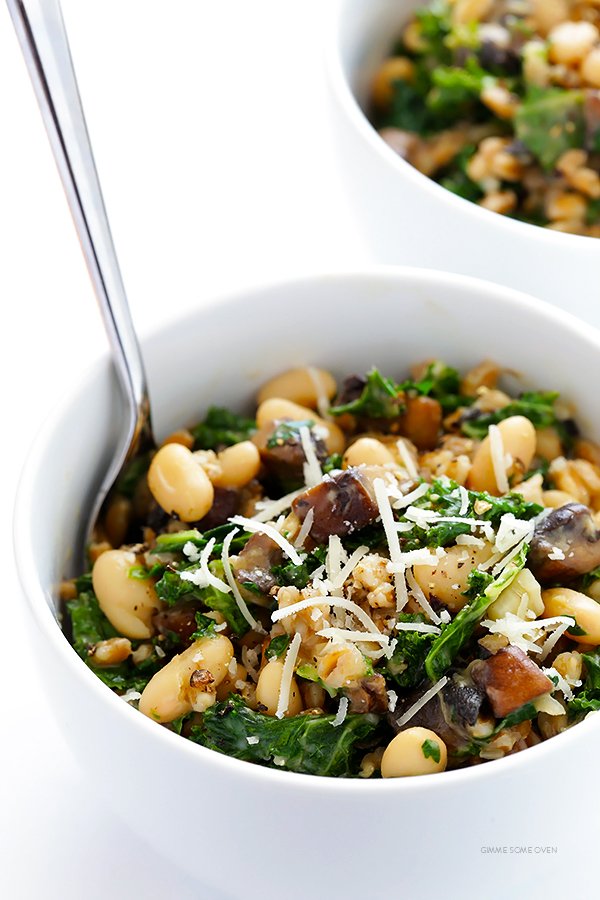
Photo credit: Gimme Some Oven
Couch to 5k: Week Three
Hello Friends and welcome to the vacation edition of my Couch to 5k journey. You can read about Weeks One and Two here and here. I don’t have much to report this week because I was away for spring break. My family and I travelled to San Diego and it was glorious. It was sunny and 68 degrees every day and the warmth felt good on my pale Wisconsin skin. We explored the city, visited the zoo and went to the beach. My favorite part of each day was sitting outside on our patio at dusk with a crisp glass of Rose wine and soaking in the last of the sunshine. It was just the break we all needed. I even managed to squeeze in 3 runs while I was there. That’s the great thing about running for fitness: you can do it anywhere and it doesn’t require a lot of equipment. I love to cycle but it’s a high barrier sport to do on vacation. You either have to bring your bike, which can be cost prohibitive if you are flying, or rent one, which is also expensive. Then there is all the gear that cycling requires like a helmet, shoes, pedals, and various clothing items. For running the gear is minimal: shoes, shorts, socks and bra. It took up very little room in my suitcase.
My runs felt like an adventure rather than a chore. We rented a beach bungalow one block from the ocean so the routes I took had glimpses of the water and the occasional surfer catching a wave. The views and the cool ocean breezes on my face made it easy to get my miles in. The training schedule called for a distance of 2 miles. I ran more than that and it didn’t feel hard. I still think I’m slow but I hope to work on speed next week.
I have observed one negative transformation thus far: I feel hungry much more than usual. I’m not usually a “snacker” but I find myself reaching for something mid-morning and then again mid-afternoon. I weighed myself recently and I found that I had actually gained a couple of pounds. I’m not worried about it though. I am happy with my weight but typically spring is when I tend to shed a couple of pounds instead of the reverse. The challenge will to keep the calories in check and eat healthy snacks. I have already buckled down on the sweets which are my true weakness.
Until next time, keep running!

My views while running
Mushroom Spinach Soup
Adapted slightly from the NYT
I just got done eating this soup for dinner and it was too good not to share it with you. I know we are supposed to be eating all things vegetable in celebration of Spring but the mercury hovered at 32 degrees all day and I needed something to take the edge off. Mostly I am annoyed at the cold weather and soups just make me feel better. Plus, my feet have been cold all day. Of course that might have something to do with the fact that I refused to wear socks because I am in denial that winter keeps dragging on. This soup was just the thing to lift my spirits. It came together easily and the Middle Eastern spices made the whole house fragrant.
INGREDIENTS
- 2 tablespoons unsalted butter and 2 tablespoons of extra-virgin olive oil
- 1 ¼ pounds mixed mushrooms (such as cremini, oyster, chanterelles and shiitake), chopped
- 1 large yellow onion, finely diced
- 2 garlic cloves, finely minced
- 1 tablespoon tomato paste
- 2 teaspoons chopped fresh thyme leaves
- 1 ½ teaspoons ground cumin
- 1 teaspoon ground coriander
- ¾ teaspoon ground cinnamon
- Pinch ground allspice
- Kosher salt, to taste
- Black pepper, to taste
- 4 cups chicken stock plus 1 cup of water
- 5 ounces baby spinach
- 1 package of egg noodles
- Fresh lime juice, to taste
- Plain yogurt, for serving (optional)
PREPARATION
- Heat 2 tablespoons butter and 1 tablespoon of oil in a large pot over medium-high heat. Add the mushrooms, a generous pinch of salt and cook, stirring occasionally, until most of the liquid has evaporated and the mushrooms are well browned, 10 to 12 minutes. You may need to cook your mushrooms in batches so they brown as opposed to steam. I browned mine in two batches, adding more butter and oil with the second batch. Transfer mushrooms to a bowl.
- After the mushrooms have been removed, add an additional tablespoon of oil to the pot. Add the onion, another generous pinch of salt and cook until softened about 5-7 minutes. Add the garlic and cook an additional 30-60 seconds. Return all mushrooms to the pot and stir in tomato paste, thyme, cumin, coriander, cinnamon, allspice and pepper. Cook until fragrant, about 1 minute.
- Stir in 4 cups of chicken stock and 1 cup of water, scrapping the bottom of the pot as you add. Bring mixture to a simmer over medium-low heat and cook gently for 15 minutes. Add the egg noodles and baby spinach and let cook an additional 7-8 minutes with the lid on.
- Before serving squeeze in lime juice. Taste and adjust seasoning, if necessary. Serve with dollops of yogurt if you’d like.
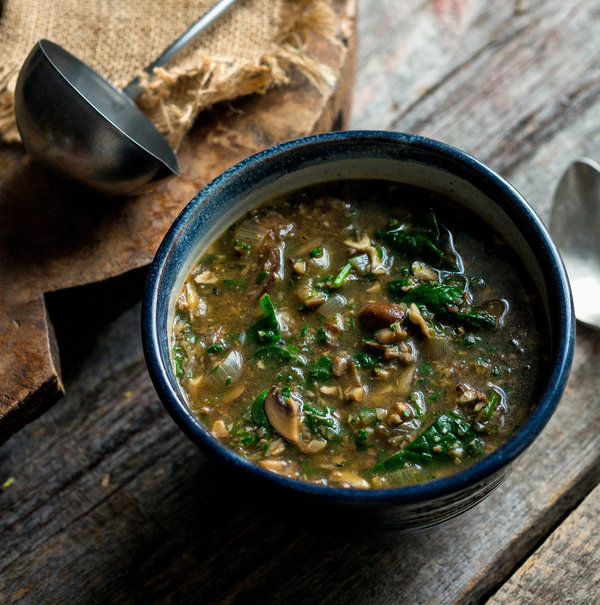
Couch to 5k: Week Two
Hello Friends! Welcome to week two of my Couch to 5k journal. Click here and here if you are new and want some more information. I know we are only two weeks into the program but I feel great about my experience thus far. Before the program started, I dreaded running. Now I have completed 5 runs and it isn’t so bad. I had some soreness after the first time but none since. Even though I am still slow I feel more confident about accomplishing the goals I set for myself. I was also worried about making the evening meetings. Like in most families, early evening hours can be chaotic. There is dinner to be made, homework to be done and nightly chores to complete. Good thing I have a supportive family. They make it easier for me to get out the door. In the morning I put all my stuff in a pile so all I have to do is put it on and head out.
In addition to the twice weekly meetings, Coach Tricia also gave us a recommended training schedule for the next ten weeks. Basically the schedule calls for one additional day of running, which progressively increases in mileage. Then there is one day of walking and one day of rest. The other three days are optional cross training days. Cross training simply means doing some other exercise besides running that improves overall fitness, like swimming, cycling, strength training or yoga. I already participate in spin class on Mondays and Wednesdays so I have continued doing those for my cross training days. When the weather gets warmer I will drop the spin class and get outside for some cycling. I just have to remember to squeeze in a run and a walk on the weekends. Last weekend it was easy to do because the sun was shining and I was itching to get outside.
For week two, we simply had to run 1/4 mile more than last week for a total of 1.75 miles. Again, the run felt good. I stayed true to my 12 minute mile pace and finished in 21 minutes. Right now I am not worried about speed. I am building more confidence with each run and I think I can build speed too. On Thursday night we stayed inside the Ice Arena because the conditions on the road were too messy and treacherous from the snowstorm. I didn’t feel as good as I did on Tuesday night but I blame the popcorn sloshing around in my stomach. My kids had a snow day so we went to see a movie. The popcorn ended up being a bad choice. I ran 30 minutes around the ice rink and up the bleacher stars. I still managed to work up a sweat despite the stomach ache. When I got home my Fitbit data revealed that I managed to sustain my target heart rate. It was another successful week.
As a heads-up, I will be gone next week. The kids have their spring break and we are headed to San Diego for a much-needed family vacation. I will be packing my running shoes, though, and hope to log my miles. I will share pictures when I return. Until then keep running!
Couch to 5k: Week One
Hello Friends! Welcome to week one of my Couch to 5k journal. Click here if you are new here and need an introduction. Otherwise I am happy to report that I made it through my first week. Well, I never had any doubt about “making it” but I was nervous nonetheless. At the first meeting, Coach Trisha and the mentors, Bill, Scott and Heather, put me at ease right away. They stressed the importance of starting slow, especially if you are new to running. It is important to acclimate your body to the effort running requires. Going too hard too soon can actually lead to injuries. The success of the program comes from building a slow, steady base and then gradually increasing that base. That’s good news for slow runners like me.
On Tuesday night we met at the Appleton Ice Area in Memorial Park. It was the first night so we made introductions and filled out some paperwork. We talked briefly about what kind of goals we want to accomplish with the program. The goals should be specific, measurable, achievable, realistic and have a timeline. As easy example might be to run 5 miles, as seen in this graphic:
After some consideration my goals for the program are as follows:
- To incorporate running into my normal fitness routine after the program ends
- To run continuously for 30 minutes without stopping
- To run the Cellcom 5k in 30 minutes
Then we did quick, dynamic warm-up that looked like this. It was cold and windy so we were anxious to get started. The first workout was a simple running assessment. The task: run ten minutes and then turn around. The purpose of the assessment is to gauge your fitness level. Coach Trisha asked each participant to remember where they were when they turned around. At the end of the program we are going to take another assessment and compare the two.
There were three groups to choose from: a run-only group, a run-walk group that alternated one minute of running with one minute of walking and a walk-only group. I chose the run-only group. I was cold, as was everyone else, so we started out fast. I slowed down to a more manageable pace once my body warmed up. When the ten minutes was done I took note of my location and then headed back to the Ice Arena. On the way back the skies opened up and it started raining buckets. I was soaked in a matter of minutes and, consequently, the return trip felt a lot longer. The rain reminded me that it is important to dress for the elements. Synthetic clothing is best because, unlike cotton, it wicks the moisture away from your body. Wet cotton can pull heat from your body and also chafe at pressure points. I was glad to have splurged on a new running outfit for myself, including good shoes and socks. Once we were safely back to the Arena we did some simple stretches and called it a night.
On Thursday night I was happy to see a few more participants had joined our group. After some more introductions, we did the same dynamic warm-up as before. Our task: run 1.5 miles. Again, I chose the run-only group. Besides some mild soreness in my hip abductors, I felt strong. I started slower this time. When I felt comfortable and warm, I increased my pace just a bit. I completed 1.5 miles in 18 minutes which means I ran a 12 minute mile. All in all it was a great start to the program, despite the rain.
Thanks for joining me this week. I will see you back here next week for the second installment on my journey to becoming a runner. Until then keep running!
Indonesian Chicken Salad
Adapted slightly from the New York Times
When the calendar says it’s spring and the weather gives brief glimpses of warmer days ahead, I start to crave lighter meals. Instead of chicken pot pie or beef stew, I crave salads, smoothies and vegetables of all kinds. It is a spring cleaning, of sorts, for my cooking. I dust off all the heaviness of fall and winter to make way for the fresh favors of the season. This salad is a wake-up call for your palate. It is both spicy and refreshing. Plus it is easy enough to make for a weeknight dinner. I used a store-bought rotisserie chicken but you could easily roast a bone-in, skin-on chicken breast for 40-45 minutes at 375 degrees for the same result.
Ingredients
FOR THE SALAD
- 1 whole chicken breast, shredded (I bought a rotisserie chicken to make this dish easy)
- 3-4 scallions, white part and green, thinly sliced
- ¼ cup chopped fresh mint leaves
- ¼ cup chopped cilantro
- 1 small red bell pepper, cut in thin strips
- 2 cups bean sprouts or sunflower sprouts
- 1 romaine lettuce heart, leaves separated, washed and dried
- ¼ cup chopped roasted peanuts (I didn’t have peanuts so I used cashews)
FOR THE DRESSING
- ¼ cup freshly squeezed lime juice
- 3 teaspoons finely chopped fresh ginger
- 1 garlic clove, minced or grated
- 1 tablespoon Southeast Asian fish sauce
- Two squirts of Sriracha
- 2 tablespoons crunchy or smooth natural peanut butter (more to taste)
- ⅓ cup buttermilk
Preparation
- Place the chicken in a large bowl. Add the white part of the scallions, the mint, cilantro, red pepper, and sprouts. Toss together.
- Combine the lime juice, ginger, garlic, fish sauce and Sriracha. Whisk together. Add the peanut butter, and combine well. Whisk in the buttermilk. Taste and adjust seasonings.
- Line a platter with the lettuce leaves. Toss the chicken mixture with the dressing, and arrange over the lettuce. Sprinkle the peanuts or cashews and the scallion greens over the top, and serve.
Couch to 5k: My Journey To Become a Runner
Have you ever wanted to take up running but something was holding you back? Maybe you felt self conscious about your appearance. Maybe you felt like you didn’t know how. Maybe you thought you were too slow or too old. Maybe you believed that you just couldn’t do it. That was me until now.
Hi. My name is Kara Sullivan and I am not a runner. I used to joke that the only time I ran is if there was something chasing me. But it wasn’t for lack of trying. I tried running in high school when I joined the Track and Field team. When I finished dead last on the team runs, my coaches suggested the field events and I happily concurred. I picked it up intermittently after high school as an easy way to stay in shape but it never became part of my fitness routine. I felt slow and stupid. It appeared effortless for everyone else while it was a struggle for me to run just one mile. I could never overcome this invisible barrier where it hurt and I just wanted to stop. The fabled runner’s high eluded me and I started to question that it even existed. Running faded out of my life. I replaced it with other things, like yoga, cycling, and cross-country skiing. I am not a competitor in any of these things but they came more naturally than running ever did. I was happy to never run again.
Then I met someone in book club who had similar feelings about running. She joined a group training program and ran her first 5k last year. And she is still running and for fun! I thought why not me. I needed a new challenge and running was it. In yoga the prevailing wisdom is to practice the poses you hate the most. Those are the ones that need your attention. Why? Often these poses specifically address your physical imbalances. They build strength and flexibility in exactly the places that need it most. If you sit hunched all day in front of a computer, backbends may be difficult, but they’re also just what your body needs. In addition, it is exhilarating to take on new challenges. And even if you don’t achieve immediate results, there is that sweet feeling of relief that comes from facing difficulties instead of evading them.
Inspired by my friend I finally took on the challenge. To help me on my journey I enlisted the help of the Couch to 5k Training Program offered at Fleet Feet Sports. I have tried and failed to take up running on my own so I figured I would create some accountability. Meeting as a group will help me stay motivated, especially on these chilly March nights when I would rather snuggle up with a glass of wine instead of going for a run. The program is ten weeks long, culminating with the Cellcom 5K in Green Bay. I intend to post here to update you on my progress. While I am not a couch potato, I assure you that running is perhaps my biggest fitness challenge to date. I hope you will join me!
Specialty Treatments: Dry Needling
What is dry needling?
Dry needling is a specialty treatment in which a needle is inserted into the skin and muscle directly at a myofascial trigger point. A myofascial trigger point consists of contraction “knots”, which causes pain.
Is dry needling similar to acupuncture?
There are many similarities and differences between dry needling and acupuncture. Licensed physical therapists can use dry needling under the scope of their practice. Dry needling also falls within the scope of acupuncture practice. We are not licensed acupuncturists and do not practice acupuncture. We are, however, specially trained to perform dry needling. In contrast to most schools of acupuncture, dry needling is strictly based on Western medicine principles and research.
How does dry needling work?
The exact mechanisms of dry needling are not known. There are mechanical and biochemical effects. Based on the pioneering studies at the National Institutes of Health, we know that inserting a needle into trigger points can assist in reducing pain. It is essential to elicit so-called local twitch responses, which are spinal cord reflexes. Getting local twitch responses with dry needling is the first step in breaking the pain cycle.
What type of problems can be treated with dry needling?
Dry needling can be used for a variety of problems. Muscles are thought to be a primary contributing factor to the symptoms. Such conditions include, but are not limited to neck, back and shoulder pain, arm pain (tennis elbow, carpal tunnel, golfer’s elbow), headache to include migraines and tension-type headaches, jaw pain, buttock pain and leg pain (sciatica, hamstrings strains, calf tightness/spasms). The treatment of muscles has the greatest effect on reducing pain in the nervous system.
Is the procedure painful?
Most patients do not feel the insertion of the needle. The local twitch response produces a very brief (less than a second) painful response. Some patients describe this as a little electrical shock; others feel it more like a cramping sensation.
Are the needles sterile?
Yes, we only use sterile disposable needles.
What side effects can I expect after the treatment?
Most patients report being sore after the procedure. The soreness is described as muscle soreness over the area treated and into the areas of referred symptoms. Typically, the soreness lasts between a few hours and two days.
What should I do after having the procedure done?
Our recommendations vary depending on the amount of soreness you have and on the individual response to the treatment. Recommendations may include applying heat or ice over the area, gentle stretches and modifications of activities.
How long does it take for the procedure to work?
Typically, it takes several visits for a positive reaction to take place. Again, we are trying alleviate pain without medication. Therefore, we are looking for a cumulative response to achieve a certain threshold after which the pain cycle is broken.
Why is my doctor not familiar with dry needling?
In the U.S., dry needling is a relatively new method for treating pain and not everyone is aware of it. Feel free to inform your doctor about this treatment option.
Once I am feeling better, how often do I need to come back to maintain my progress?
Your body is under constant pressure from gravity, stress, work etc. A regular exercise program combined with good posture can prevent many problems. If the pain comes back, “tune-ups” are recommended to treat and prevent serious injuries.
How do I learn more?
Feel free to call our office at 920-738-0671 or email Miles Weber, DPT, [email protected] for more information.
Running Tips: Recovery
What is your recovery plan after a big run? If you said “nothing,” that is a fine answer. After a race, it’s best to take it easy for a week and then slowly resume your regular training. The break from running gives your body a chance to heal and get strong. Give running a break. Instead try some other activities like spinning, walking, lifting weights, stretching or catching up on core work.
The trick is to make sure your easy week doesn’t turn into an easy month. You have worked too hard to let that happen. Make a plan for the week after your “rest” week. Commit to doing half your typical training during week 2. Then by week 3 return to your regular training volume. If you need more motivation, sign up for a spring running event. The Cellcom Green Bay 5k is on Saturday May 21st and is a great event to keep you focused. Click here to register. It will help you stay inspired and keep you on track with your fitness goals. Spring is only 26 days away and with it comes nicer weather. Stay strong for running season. It’s almost here!
Winter is not a favorite time of year for most runners I know. It is a constant challenge to run when the weather is cold or the footing is bad. However, there are a few motivational techniques that can keep you moving. Here are a few simple tricks to get you through the season.
Register for a winter race
Participating in a fun run midway through winter is great inspiration. One example is Seroogy’s Valentines Run 15k. The distance is long enough to require training so it forces you to run even when you want to stay home in your pajamas. Click here to find your next race.
Run with friends
Better yet, convince your friends to register for the same race. That way you can train together and hold each other accountable.
Run inside
What do you do when the weather turns really cold? When the mercury dips into the single digits and lower, consider running inside. I can already hear the collective groaning but keep it short and use entertainment such as music, TV or movies to make it more tolerable. Also try doing small intervals. If you haven’t been doing speed work then start small and at a moderate pace. Here is an example of a 9:00 mile:
- Warm up a mile at 9:00 pace
- Run 1 minute at 8:30
- Run 3 minutes at 9:00
- Repeat the 1 minute interval and 3 minute easy 3-5 times
- Cool down
These “intervals” are not really considered speed work, but that is not your goal. Your goal is to distract yourself and make the treadmill run more tolerable!
Running Tips: Flexibility
There are MANY opinions on flexibility these days: dynamic stretching, PNF stretching, yoga, static stretching, the list goes on. Although the latest research flip flopped for many years on whether stretching was beneficial, now the experts agree that the right kind of stretching can be good for some athletes. This study found that people who performed static stretches followed by several minutes of basic warm-up movement, such as light jogging, were significantly less likely to strain or tear a muscle. And stretching after your workout is good for everyone.
Stretching works best when you are warmed up a little. Stretch your problem areas after a brief warm up, again after you run and periodically throughout the day. Some people prefer to stretch all leg muscles after every run. There is no right answer. Do what works for you.
Here are some examples of static stretches for your legs:
I recommend holding each stretch for at least 30 seconds. Do 2-3 repetitions.
Happy stretching!
Running Tips: Getting Outside in Winter
How do you keep yourself going in the winter? Do you switch to the treadmill for most of your runs? Do you just tiptoe over the ice and hope for the best? Most runners prefer running outside, even in the coldest temperatures. If you are a winter runner, then there are a few things you can do to optimize your experience.
First, when the weather is cold, you forget about hydration. At first it seems like you will sweat less, but then you warm up and are sweating buckets. Forgetting to hydrate can leave you feeling sick. Try wearing a water belt to carry a few ounces of water on long runs. Also try setting water out on your route every few miles. Rather than drive around and stash water, text a couple friends and say, “Hey, Denise, mind putting a cup of water on your porch this am?” It works great and is a fun little break!
The next thing to think about is your running form. Running on snow and ice is a great time to reinforce fast cadence. A slow cadence is synonymous with a heavy heel strike and big push off. Both things will make you more likely to fall on the ice! Work on striking softly and avoid an aggressive push-off.
Lastly, the best winter running tool is appropriate shoe wear. The biggest concern with winter running is traction. Winter specific shoes tend to have extra traction AND be water proof with Gortex. There are many winter-specific running shoes such as Brooks Adrenaline and Saucony Exodus, which feature Gortex uppers and aggressive treads. A trail shoe, such as the Brooks Cascade, might also be a good choice. It has great traction for winter conditions if you are willing to forgo the Gortex for the increased comfort. For days that are quite snowy, Yaktrax are a great option.
Run safely and have a great weekend!
Running Tips: Keep Your Core Strong
Last week we shared three practical tips to keep you injury free. Here is another running tip to add to your list: keep your core strong. Most runners I know would prefer to run extra miles than do core. They just don’t like it. But a strong core plays an important role in staying injury free. Here is an earlier blog post that talks more about core strength for athletes. Consider this post a reminder that it is still important. If you struggle to make core work a part of routine then pick 3-4 exercises to do a few times a week. Change up your choices each time for variety. Some easy options include:
Plank
Side plank
Russian twists
Crunches
Oblique crunches
Bridge with knee lifts
A quick google search will give you more pictures and further descriptions. Also, check out our YouTube video, Tri 101 Core Exercises, for demonstrations of these exercises and more.
If you love core and do a lot, keep it up. More is probably better! Questions or comments? Don’t hesitate to email Kari at [email protected]. Have a great rest of the week!
Running Tips: Injury Prevention
Last week we shared tips on increasing your cadence, or steps per minute, to improve performance and prevent injuries. Cadence continues to be important for runners of all kinds. However, as your mileage increases, it is also important to pay attention to where you are running, how to safely increase your mileage and periodically updating your footwear. These are 3 tips our physical therapists give to our patients to prevent injuries:
Tip No. 1: Pay Attention to Where You Are Running
Roads are everywhere and, as such, runners use them more than any other surface. Unfortunately roads are built for cars, not runners. They have camber, which means that the center of the road is higher and each side slopes downward to allow water to run off. For safety runners typically run against traffic with the left foot downhill and the right foot uphill. The left foot is under-pronating and the right foot over-pronating. Neither leg is happy after a sustained effort. The higher your mileage the more unhappy your legs will be. First and foremost, BE SAFE! When it is safe to do so, try alternating sidewalks and road every few blocks, including with and against traffic. If it is not safe to run with traffic, then try altering your route completely to include more variety. If you are listening to music, then do not run with traffic AT ALL! Did I mention you need to be SAFE? (just making sure).
Tip No. 2: Safely Increase Your Mileage
Increasing your mileage in a sensible manner will also reduce your risk of injury. Typically, a 10% to 20% increase in mileage per week is considered safe. If you increase your speed, add hills work OR do intervals. Any ONE of these changes is considered that week’s increase. The more you change at any one time, the more you risk injury. Add all 3 things in one week and you are almost guaranteed a problem!
Tip No. 3: Replace Your Footwear When Needed
Finally, replace your running shoes every 300 to 500 miles if you are wearing traditional shoes. Many of the lower profile, more minimalist shoes need to be replaced sooner. Avoid wearing your running shoes for other activities to prolong their life.
Questions or comments? Don’t hesitate to email Kari at [email protected]. Have a great weekend!
If you have hummus fatigue, as I do, then this recipe is for you. I have made white bean dip with pita chips countless times over the years and it never disappoints. It has simple ingredients, ones that are probably in your pantry right now, but lively flavor and multifunctional utility. I mostly make it when I have people coming over but it is also great as an after school snack for your kids. I serve it with store-bought pita chips, like these, but it is also good as a dip for carrots, red peppers and celery. I imagine it would be good spread on toast as well, though I have never tried it that way. The original recipe comes from Giada de Laurentiis but I tweaked it a little to boost the flavor. Here it is:
Ingredients:
1 can cannellini beans, drained and rinsed
2 tablespoons fresh lemon juice
2 cloves of garlic, minced
1/2 small onion, finely chopped
1/3 cup of extra virgin olive oil, plus 3-4 tablespoons
2 tablespoons parsley, finely chopped
Salt and pepper to taste
Method
In a small skillet over medium heat, add two tablespoons of extra-virgin olive oil. Add the onions and cook until translucent, about 5 minutes. Add the garlic and continue to cook for an additional 60-90 seconds until fragrant. Remove from heat and set aside to cool slightly. Next place the beans, garlic, lemon juice, 1/3 cup olive oil and the slightly cooled onion and garlic in the work bowl of a food processor. Pulse until the mixture reaches the desired consistency. I like mine mostly smooth with some chunks in it. You could keep yours chunky or make it smooth. Season with salt and pepper, to taste. Transfer the bean puree to a small bowl. Drizzle with more olive oil and garnish with parsley. Serve and enjoy!
We are back with more tips to make you a faster, stronger and more efficient runner. Whether you are brand new to running or a seasoned pro, we have advice that can help. Our tip this week focuses on cadence.
First, what is cadence and why is it important to runners? Cadence is how often your feet touch the ground, or your steps per minute. A high cadence allows you to benefit from the natural elasticity in your tendons. Think of your feet as basketballs. When a basketball hits the ground, it stays for a specific amount of time before rebounding back up. When you run with a low cadence, you are holding your foot on the ground when it naturally wants to “bounce” off and rise again. In order to get your foot off the ground, you then need to push off the ground. A high cadence will shorten your stride reducing the over-striding and heel striking that exemplifies poor form. Quick, soft steps also decreases the forces on the body, reducing injury rates. Finally, quick turnover increases forward momentum, resulting in increased performance and decreased injury rate.
The latest research reveals that there is no ideal cadence. However, increasing a runner’s natural cadence by 5-10% significantly reduces the stresses placed on bones, ligaments, muscles and tendons. Clinically, we have seen great results by increasing our patients’ cadence by approximately 10%.
How do you apply this?
Let’s define cadence as number of steps per minute. You increase your cadence by taking shorter, faster steps while keeping your speed constant. It is easiest to practice cadence on a treadmill where your speed is held constant or while running with a group whose speed is constant.
With most patients, the ideal cadence is 175 steps/minute or more. However, it can be difficult to measure your preferred cadence. You tend to change tempo and the result is not a true measurement. Luckily there are also a variety of tools available to help you reach a higher cadence. A simple Google search of “running cadence app” reveals a wealth of links for your phone. Using a metronome and matching your steps to the beat is a simple way to measure your cadence. If you happen to be running with a group, find a runner that has a high cadence and match your steps to theirs. Just remember that when making changes to your running mechanics, it is best to do it gradually. Focus on cadence for a few minutes and then give your self a break for a few minutes, then repeat. Good luck!
Hello Friends and welcome to 2016! Our blog is back and ready for the New Year. Now that the holidays are over, it’s time to get serious about our health. Whether or not you make resolutions, there is no better time than the present to make exercise part of your routine. One great option is running. It is a low barrier sport that you can do almost anywhere and with very little cost. All you need is a decent pair of shoes, basic clothing and some good old fashioned motivation. If you are brand new to running it also helps to have a little advice and encouragement to aid you on your journey. Here at Peak Performance Physical Therapy we are the running specialists. Our licensed physical therapists specialize in running mechanics and gait analysis. We can offer basic tips and strategies to make you a stronger and more efficient runner.
Recently, our running expert Kari Sturtevant, DPT, attended The Science of Running Symposium in Chicago where top biomechanics researchers shared and debated topics related to running and running-related injuries. She came back with lots of great information and wants to share it with you. Her first tip: get in shape to run. Wait, what? It sounds counterintuitive but all of the presenters at the symposium stressed the importance of getting in shape to run rather than running to get in shape. The stronger you are in your hips and core, the less likely you are to become injured. Many running-related injuries are due to poor hip strength and control. This week Kari shares her 3 favorite hip exercises for runners to help stabilize hips and strengthen your core. Follow this link to Peak Performance’s YouTube channel and Kari performing the exercises: https://www.youtube.com/watch?v=x5l7A0w4Iys

October is rolling along and so are my apple recipes. This Apple Rose Puff Pastry recipe has been making the rounds on Facebook and Pinterest and it looked too pretty to pass up. It is one of those rare recipes that looks impressive, like it took hours to make, but is in fact is very simple. Before you click away let me reassure you that you do not have to make the pastry. I know so many people that immediately shy away from making pastry of any kind. Why is beyond me but that is for another post. This is not that recipe. You can buy puff pastry at any supermarket in the freezer section. Simply let it thaw on your counter for 30-40 minutes beforehand. It should still be cold to the touch while you are working with it. Serve these at your next dinner party or book club and I guarantee you will impress your guests. And kids love them too. I gave them to my kids with a little ice cream on the side and they gobbled them up.
Ingredients: to make 12 roses
- 2 sheets puff pastry, thawed
- 3 red organic apples (I used Honey Crisp)
- juice of one lemon
- 1 tablespoon of flour, to sprinkle the counter
- 3-4 tablespoons of apricot preserve
- cinnamon (optional)
- powder sugar for decorating (optional)
Remove the puff pastry from freezer and thaw on your counter for 30-40 minutes. The pastry should still be cold to the touch. Cut the apples in half, remove the ends and core them. Slice the apples very thinly from top to bottom. Fill a medium sized bowl half full of water. Squeeze the lemon juice into the water. Place the sliced apples in the water and microwave for 3-5 minutes until slightly tender. The amount of time to cook the apple slices will depend on your microwave. Mine is powerful and it only took 2 minutes, so be careful that you do not overcook them. Drain the apples into a colander. When pastries are thawed, place them flat on a floured surface. Roll the pastries out with a rolling pin to flatten just a little more. Cut each pastry into 6 equal slices. One at a time, spoon apricot preserve mixture onto a slice of pastry. Place 7-9 apple slices along one half of the pastry slice with the peel side facing out. Fold the pastry in half to cover the apples. Starting on one end, roll the pastry and apples to the other end of the pastry. Place in a muffin tin. Continue with the other pieces of pastries until you have 12 apple roses. Place a pan of water on the bottom rack of oven so the bottom of pastries do not burn. Bake at 375 for 40 -45 minutes.
Slice apples in half, cut off ends and scoop out the core.
Slice the apples thinly
Microwave apples with lemon juice for 2-5 minutes until just tender
Roll out puff pastry
In a bowl, place three tablespoons of apricot preserve with two tablespoons of water. Microwave for about one minute, so that the preserve will be easier to spread
Cut the puff pastry into 6 equal portions and spread with the apricot preserves
Place the apples on the pastry as shown and sprinkle with cinnamon
Fold the bottom half of the pastry over the apple slices and roll the dough onto itself
The rolled pastry will look like a rose

Place in your muffin tin and bake at 375 for 40-45 minutes
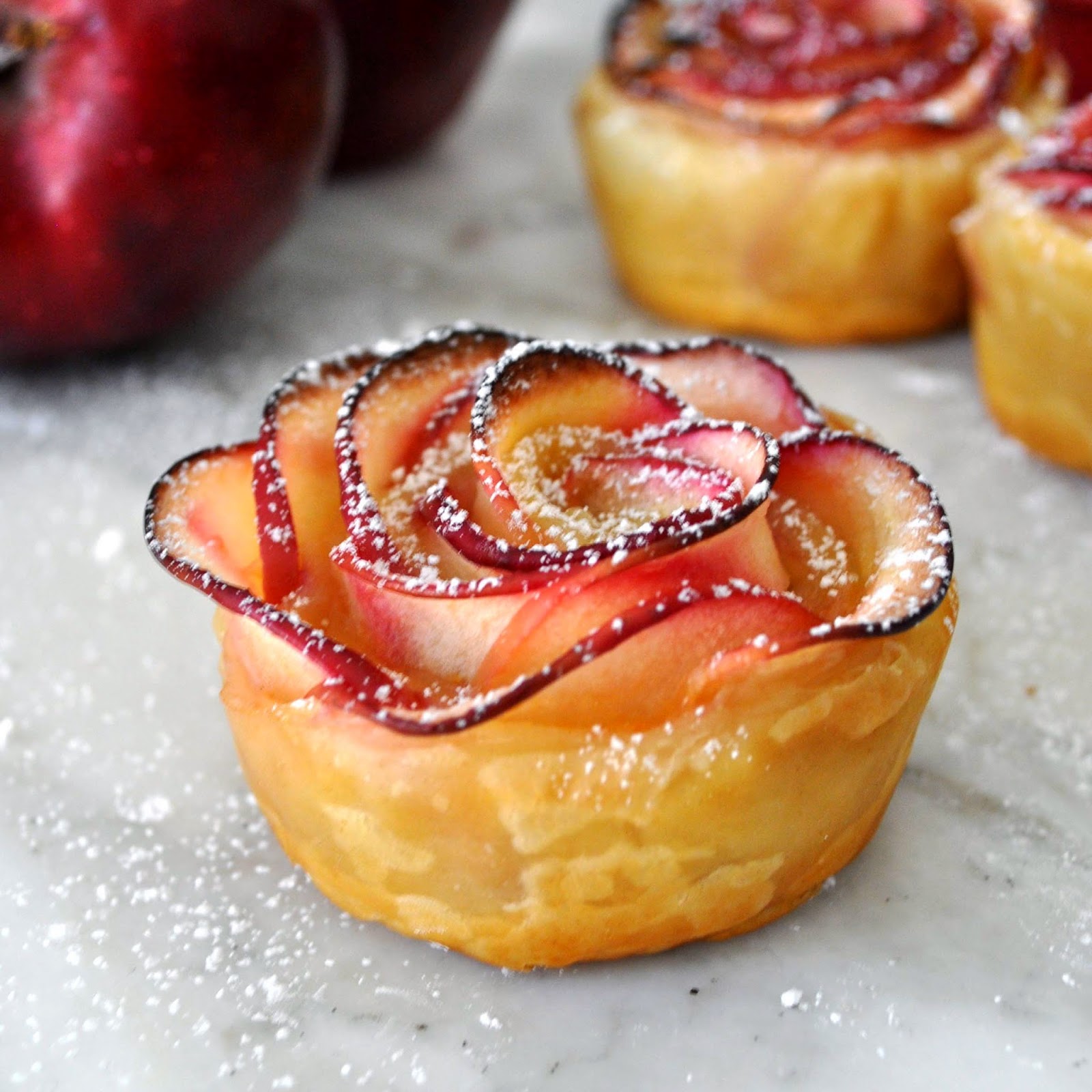
Apple Rose Puff Pastry
So you went apple picking with the family last weekend. Now you are stuck with a ten pound bag of apples and there is no way you can eat them all as is. There are only so many consecutive days that you can pack apples in your kid’s lunchbox. If they are like my kids then you have been finding half eaten, brown apples at the end of the day. It’s time for some easy and delicious apple recipes to make use of your glut. Enter these two recipes for homemade applesauce and stewed apples. They could not be easier and they use ingredients you probably already have in your pantry.
Unsweetened Applesauce
- 4 pounds apples, peeled and cored (I used a mix of whatever I had on hand)
- 4 strips of lemon peel
- 1/4 teaspoon ground cinnamon or 1 cinnamon stick
- 1 cup water
Peel, core and chop your apples into large chunks, about 8 pieces per apple. Put all of the ingredients in a large pot and bring to a boil. Once boiling, reduce it to a simmer and cover the pot. Cook for approximately 30 minutes, or until apples are quite soft. Fish out the lemon peels and whole cinnamon stick, if you used one, and let it cool.
*If you like a little sweeter version, feel free to add 1/4 of brown sugar or 2-3 tablespoons of maple syrup to the pot
Stewed Apple Slices
- 4 cups of peeled, sliced apples, about 1/4 to 1/2 inch thick (Again, I used whatever apples I had on hand)
- 2 Tbsp brown sugar
- A sprinkle of cinnamon
- 1 Tbsp maple syrup
Put apple slices in a glass bowl. Add the brown sugar, maple syrup and a light sprinkle of cinnamon. Give the mixture a stir. Bake in microwave oven for 3-5 minutes on high heat. Adjust the time for your microwave and how many apples you are cooking. I only needed to cook mine for 3 minutes. If you use more apples, you will probably need to cook it a little longer. Start with 3 minutes and then test with a fork for doneness. Be careful, they will be steaming hot. When you have reached the desired doneness, remove and mix well so the syrupy goodness coats all the apple pieces. \Enjoy with whipped cream, ice cream or plain yogurt.
Building Strength to Boost Confidence
As an Office Manager for Peak Performance Physical Therapy, Denise Dietz does it all, from greeting patients, to answering phones, to dealing with thorny insurance coverage issues. She tackles problems with confidence and keeps the office running smoothly. It is her fierce independence that stokes her can-do spirit. “I don’t like to rely on anyone but myself to get things done. That’s why I like working out. It makes me feel strong and gives me confidence to handle whatever life throws at me.”
Working out also relieves the stress from juggling two careers. Denise graduated with a Bachelor of Fine Arts from University of Wisconsin Milwaukee and fell in love with photography. She moved to Appleton in 1996 to manage her sister’s hair salon. She worked long hours but still found time to pursue her true passion. In 2010 she started work at Peak Performance which provided a better balance of work and personal time. With the encouragement of family and friends, she dedicated more time to photography and her business grew from there. Now she is Office Manager by day and a talented photographer by night.
The Workout
Although she stays busy, she makes time 4-5 times per week for a butt-kicking workout at Ellipse Fitness in Appleton. Ellipse is a training center, not a gym. It offers classes that focus on core work and strength training and it provides nutritional counseling. She used to run for fitness but she wanted to ramp up her metabolism with strength training. She took her first class at Ellipse two years ago and now she’s hooked.
Denise still runs but the class setting helps her stay motivated and adds a social component as well. “I like to go there because if left to my own devices I would just skip working out altogether. Plus, the staff and friends that I have made keep me coming back for more.”
On Mondays and Wednesdays she does kickboxing. “Kickboxing makes me feel strong. My anxiety and stress just melt away. I’m not the most coordinated person but I do it anyway.” On Tuesdays, Thursdays and Fridays she focuses on metabolic strength training. She prefers body resistance training but also lifts weights to build strength. She focuses on core work with burpees and planks. “Keeping my core strong has kept me injury free. Plus, it helps to work with physical therapists. They show me strengthening exercises and give me fitness tips to keep my body healthy.”
To stay centered Denise practices Kundalini yoga at home. The breathing exercises and mindfulness help bring balance to her sometimes chaotic life.
The Diet
Now that Denise has ramped up her workouts with strength training she eats more lean protein than she used to. For breakfast she likes eggs or some other protein with veggies or fruit. Though it is never a good practice, Denise skips breakfast in the morning if she is running late. Later in the day she will have a healthy lunch and protein shake.
To keep her hunger cravings in check, she drinks lots of water and snacks on almonds, cottage cheese, veggies and fruit. She will also eat a protein packed energy bar before she heads to her workouts.
At lunch she likes yogurt or whole grain bread with some sort of lean protein. For dinner she likes to grill salmon or veggie burgers. Now that it is winter she has been craving comfort dishes like chili, Thai peanut soup, macaroni and cheese and tuna casserole.
The Gear
Denise is not beholden to any particular brand of clothing. She stays away from cotton, preferring synthetic materials that wick away moisture. For shoes she wears Asics for running and Inov8 for her classes because they are light. “It feels like I’m not even wearing shoes.”
She doesn’t use fancy gadgetry either. She tracks her workouts and food intake with the My Fitness Pal app and that’s it.
There comes a moment when you finally feel like summer is over. There are the obvious signs like the autumnal equinox, the turn in weather or the change in leaves. Then there are signs that feel more personal. For me it is the way the sun sits lower in the sky and doesn’t warm my patio anymore. Or the way my garden looks tired from the long growing season. Most of all, though, I find myself craving things like pumpkin pie, caramel apples and anything cooked long and slow in the oven. September is a quirky month because the summer bounty is still rolling in but then apples start to appear and, with it, the first whisper of fall. You are stuck between seasons, culinarily speaking. The grill sees a lot of action and tomatoes and corn are still in heavy rotation on the meal plan. Then we get one cool night and, instead of salads, I want a hearty stew. By the time October rolls around there is no more doubt about it: tomatoes and corn are out and apples and pumpkins are in. Right now, due to two separate apple-picking forays, I am up to my ears in apples. In honor of October, my favorite month of the year, I will be posting only apple recipes. Today I am making Apple Pie Smoothie. It is a satisfying and healthy snack for any time of the day. Kids love it too.
Apple Pie Smoothie
Ingredients
- 1 cup unsweetened almond milk
- 1 cup unsweetened applesauce
- 1/2 cup plain Greek yogurt
- 2 teaspoons vanilla extract
- 1/2 teaspoon ground cinnamon
- 2 Tbsp maple syrup
- 1 cup ice cubes
Put all your ingredients in a blender and puree until smooth, about 30-60 seconds.
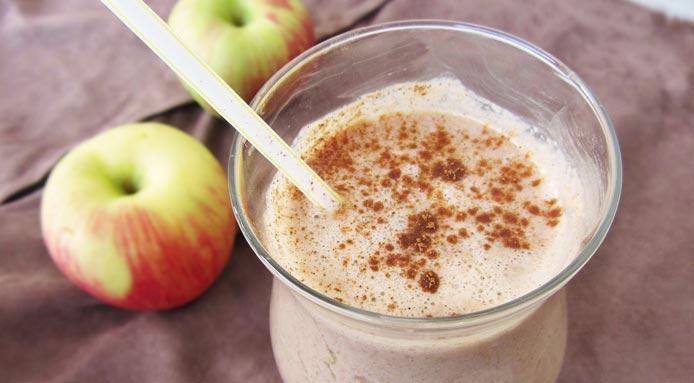
Staying Young Through Fitness
Nikki Strick loves playing team sports. When asked which one, she recites a laundry list that sounds like the greatest hits of the Summer Olympics. At Menasha High School she played basketball, softball and volleyball. At UW Madison, where she obtained both her B.S. in Exercise Science and her Masters in Physical Therapy, she played intramural volleyball, flag football and indoor floor hockey. Even after she graduated in 2002 she continued to play volleyball and later joined a kickball league. “I have always been involved in sports. It is a great way to stay fit and be social.”
In addition to playing team sports, Nikki also competes in triathlons, obstacle races and long distance bike rides. “I am competitive with myself rather than other people. I don’t have to place first in anything. It is more recreational for me than a competition.” Her favorites include the Tough Mudder and the Scenic Shore 150 Bike Tour. Two summers ago Nikki raced the Scenic Shore 150 when she was 30 weeks pregnant with her first child. “Attending spin class prepared me for the physical demands of the ride but I definitely got fatigued more easily. Besides that it was a great event.”
Playing hard at team sports can have its risks. In 2004 Nikki tore both ACL’s while playing volleyball and had two surgeries five months apart. Afterwards she worked hard at physical therapy to recover fully. “Now I have the perspective of being a patient and feeling challenged. I worked hard so I could get back to the things I wanted to do. I think I am a better physical therapist because of it.”
Besides back-to-back surgeries the only other thing that has slowed her down is the birth of her son, Quinn, who turns one this month. Although she does not have as much time as she used to, her fitness goals have not changed. “Staying motivated isn’t the issue. I enjoy going to classes and staying fit. It is like mental therapy for me because it makes me feel better.” To maximize her time, Nikki goes to work prepared. She packs her workout clothes, lunch and snacks the night before. That way she does not have any excuses to skip class. She also started attending classes before work. Being a parent also motivates Nikki. “I want to stay young through movement so I am able to keep up with my son as he gets older.”
The Workout
Nikki attends classes at Anu in Neenah twice a week, varying it up between Body Flow, Body Pump and CXWORX. These three classes offer enough variety to keep Nikki motivated. Body Flow is a mix of tai chi, yoga and Pilates, Body Pump is a weight lifting class set to music and CXWORX is a core and gluteus-focused workout. She also fits in workouts when she is at home with her son. When her son does tummy time she does planks to keep her core strong. During nap time she uses her elliptical machine for cardio work. “My perspective has changed because I have less time. My desire is there. I’m still playing kickball this fall and I want to return to volleyball in the future. There is a delicate balance between giving enough to my child and staying true to myself.”
She enjoys riding her bike when the weather is nice. Typically she rides 20-30 miles 2-3x per week during the warmer months. Recently she has also returned to running. Along with her colleagues Kari, Molly, Becky and Denise, she ran Run Away To The Bay in April, which was 55-mile relay race between Oshkosh and Green Bay. She trained 1-2x per week to get in shape for it. “My first training run went surprisingly well. I didn’t have to walk at all. It felt good after not running for a whole year.”
The Diet
Nikki does not have much time to make meals but she still tries to eat healthy. For breakfast she likes granola with milk or yogurt, topped with raisins or nuts. She will also eat a piece of fruit like pineapple, orange or berries.
For snacks she prefers hard boiled eggs, greek yogurt with berries, or wheat thins. For lunch she always has yogurt and a piece of fruit. She will also eat a Healthy Choice meal because they are fast and easy. Other options include leftovers from dinner or a turkey sandwich.
For dinner she eats pasta or chicken breasts on the grill with a side of rice and steamed vegetables. Chicken parmesan, casseroles, and lasagna are also perennial favorites. To spice things up she orders takeout from her favorite ethnic restaurants. Her favorites include Mexican, Indian or Thai.
The Gear
Nikki is not a clothing or gadget snob. She wears whatever feels comfortable for her. For shoes she has a pair of Asics. Capris are a favorite part of her workout uniform and she likes Nike or Lululemon. She has an inexpensive Ironman watch that she wears while running so she can count her cadence. She owns a Specialized Ruby Elite bike and wears Specialized biking shorts.
The Playlist
Like many of her colleagues, Nikki prefers silence over music. “I like having stillness in my day. It’s nice to have peace and quiet because my days are so crazy.”
Making the Ironman a Family Affair
For Molly Van Zeeland, racing the Ironman is a family affair. Her mom, Chris, sisters, Becky and Lucy, and husband, Adam, have successfully completed Ironman races this year. Her mom is an accomplished triathlon competitor and has been racing for the last twenty years. “When I was little my mom did her workouts between 4-6 am and came home in time to get everyone ready for school.” Last year she took a trip to Hawaii where she watched her mom race the Kona Ironman.
Molly is not just a spectator; she is a fierce competitor. Growing up in Kaukauna she played volleyball, basketball, and softball in high school and continued to play Division III basketball and softball for Lawrence University. After graduating with a Bachelor of Science in Biochemistry, Molly went on to obtain her Doctorate in Physical Therapy from the University of Wisconsin Madison.
While in graduate school Molly took up running and cycling as a way to stay in shape. Her mom encouraged her to add swimming to her repertoire. Triathlons were the logical next step. “My mother has taught me the most about the sport. When we first went for a bike ride together, I made it eight miles and asked if we could call my dad to pick us up. She encouraged me to take a break and bike home. From then on, she continued to teach me all she knows.” Swimming is Molly’s weakest event but her mom has coached her along. Now Molly is stronger than her mom in cycling. “We look to each other for advice. I help my mom with cycling and she helps me with swimming. We are each other’s biggest fans.”
Molly excels in endurance events and her finishes are the proof. She finished first overall female in the Green Bay Duathlon 2010, Paper Discovery Duathlon 2011, High Cliff Triathlon 2011 and Paper Discovery Duathlon 2015. She placed 2nd overall female in the Oshkosh Triathlon 2011. She won her age group at both the 2013 High Cliff Half Ironman and the 2013 Chicago Half Ironman. She took 5th in her age group at Ironman Wisconsin 2013 and 9th in her age group and Ironman Wisconsin 2015.
Nothing slows her down, not even being a first time mom. Her daughter, Paige Christine, turned one this past August. After Paige was born she took six weeks off but then started training again. “It helps to have a supportive husband.” Mornings are her workout time and evenings are his. “Being a first time mom, I have these small windows of opportunity. It’s now or never and that makes me go.”
The Workout
Training for three different sports can be tricky. Typically Molly does one hour workouts of each sport 3x per week for a total of 9 workouts. She always schedules one rest day per week to give her body time for muscle repair. That means she has to double up on workouts on other days. She will run in the morning and then try to find extra time to do either swimming or cycling in the evening.
For running she prefers to hit the roads. One of her favorite routes goes through downtown Appleton. “I get a lot of energy from traffic, people and shoppers.” She also likes to run at High Cliff State Park which is a totally opposite experience. She can enjoy the peace and quiet that nature has to offer. For swimming she uses the pool at the local YMCA. For cycling she will jump on her bike when the weather is nice. Otherwise she takes a spin class or rides a cycling trainer while her daughter naps.
Molly believes in the importance of strength training and incorporates it into her workouts 2-3x per week. “Strength training is what has kept me injury free.” She likes to take Body Pump classes at Xperience Fitness, which is a choreographed strength training class that works every major muscle group. Otherwise she lifts weights and focuses on her core with planks and side planks, doing one minute holds five times.
The Diet
Molly strives to eat a balanced diet. “I feel stronger when I don’t eliminate any one food.” For breakfast she eats oatmeal, banana and coffee every morning. Sometimes she sweetens the oatmeal with granola or honey. For a snack she likes mixed nuts, greek yogurt and fruit. For lunch she will eat a turkey or tuna sandwich, nut butter with apples or greek yogurt with fruit. A typical dinner includes some kind of lean protein like salmon or chicken with a starch and a vegetable. “We grill a lot, even in winter.” After dinner she indulges with a little dark chocolate, like Dove chocolates.
The Gear
Molly always keeps a bag of gear ready by the door to save time. In it she packs compression pants and Under Armor tops for running. When the weather allows, she prefers sleeveless shirts because they are less restrictive. For cycling she prefers triathlon shorts over cycling shorts. For swimming she wears Speedo for her suit and googles.
For shoes she has two kinds, depending on what kind of workout she does. She runs in Newtons which is a minimalist shoe, for speed and tempo runs. Otherwise she wears Hokas, which have more cushioning, for longer runs.
Other gadgets include a Garmin 910 GPS Watch which she uses for both running and cycling. It hooks up with her power meter on her bike so she can accurately track all her workouts. She downloads all her data to Garmin Connect. She often brings her daughter on runs and uses a Thule jogging stroller which she loves.
The Playlist
The Minions of Peak Performance Physical Therapy ruled at the Community First Fox Cities Marathon Festival of Races yesterday! It was a beautiful day for a race and we loved cheering for all the participants. Thanks to all our volunteers and to the runners themselves. You inspire us! Here are a some race day photos:
No Knead, No Work, So-Easy-Your-3-Year-Old-Could-Do-It Bread Recipe
Baking bread sounds intimidating, right? All that kneading and loaf-shaping business is best left to pros. But what if I told you that you don’t even have to knead or shape, that it is so easy that a 3-year-old could make it? Welcome to the No-Knead, No-Work, So-Easy-My 3-Year-Old-Could-Do-It-Bread-Recipe. This technique — it doesn’t really qualify as a recipe — came from Jim Lahey, owner of Sullivan Street Bakery in New York City. Jim has created a way for home cooks, not even ones who are serious bakers, to nearly duplicate an artisan bakery loaf, with a crackling crust, open-holed crumb, light texture, and fantastic flavor. All without kneading, fancy ingredients, or special equipment! The prep time is around 3 minutes which is less time than boiling pasta. A wet dough and slow fermentation are the keys to success, as is the baking method—a heated covered pot, which creates essentially an oven within an oven to trap steam as the bread bakes. This is the original, simplest version, though many people have tinkered with the formula since it was first published in 2006. I’m not kidding when I say the results will blow your mind. The only thing required is forethought. Ideally, you will start the dough about 18-24 hours before you plan to eat it; you can cut that to 12 and even 9, but you’ll be sacrificing some of the yeasty flavor and open crumb.
No-Knead Bread
Ingredients
- 3 cups all-purpose or bread flour, more for dusting
- ¼ teaspoon instant yeast
- 1 ¼ teaspoons salt
- Extra flour cornmeal or wheat bran as needed
Method
- In a large bowl combine flour, yeast and salt. Add 1 5/8 cups of lukewarm water, and stir until blended; dough will be shaggy and sticky. Cover bowl with plastic wrap. Let dough rest at least 12 hours, preferably about 18, at warm room temperature, about 70 degrees.
- Dough is ready when its surface is dotted with bubbles. Lightly flour a work surface and place dough on it; sprinkle it with a little more flour and fold it over on itself once or twice. Cover loosely with plastic wrap and let rest about 15 minutes.
- Using just enough flour to keep dough from sticking to work surface or to your fingers, gently and quickly shape dough into a ball. Generously coat a cotton towel (not terry cloth) with flour, wheat bran or cornmeal; put dough seam side down on towel and dust with more flour, bran or cornmeal. Cover with another cotton towel and let rise for about 2 hours. When it is ready, dough will be more than double in size* and will not readily spring back when poked with a finger.
- At least a half-hour before dough is ready, heat oven to 450 degrees. Put a 6- to 8-quart heavy covered pot (cast iron, enamel, Pyrex or ceramic) in oven as it heats. When dough is ready, carefully remove pot from oven. Slide your hand under towel and turn dough over into pot, seam side up; it may look like a mess, but that is O.K. Shake pan once or twice if dough is unevenly distributed; it will straighten out as it bakes. Cover with lid and bake 30 minutes, then remove lid and bake another 15 to 20 minutes, until loaf is beautifully browned. Cool on a rack.
*my dough expands out, not up so don’t worry if yours does the same
Exercise is Not An Indulgence For This Small Business Owner and First Time Mom
Kari Sturtevant does not consider exercise to be “me-time” but rather an essential part of her daily life. She schedules it into her day just like an important meeting or time with patients. As a first-time mom and sole owner of Peak Performance Physical Therapy, time management is foremost in her mind. Since opening the doors in 2001, Kari has grown her business from a solo practice to one with 4 physical therapists and a second location at Lake Park Swim and Fitness. Throughout the course of the day she juggles multiple responsibilities, both professionally and personally. It is more challenging to find time for running but she makes it work. “Because I am self-employed I have the luxury of creating a schedule that works for me.”
Kari has always loved running. Growing up in Menasha, WI she used to race the neighborhood boys on bikes while she was on foot. She ran track in high school and then later at Marquette University where she graduated with a Master’s degree in Physical Therapy. Other sports, like cycling and rowing, made appearances in her life but running is her real passion. In 2007 she ramped up her training to race competitively, the culmination of which was the Philadelphia Half Marathon in 2010. She finished 17th in her age group and 157th overall out of 5400 female runners, with a personal record of 1:41.23. The photo finish and bib still hang in her office.
Shortly thereafter she set her sights on a new goal: having a baby. It was not an easy journey for Kari and, after struggling with infertility, she finally gave birth to healthy boy in February 2014. Since becoming a mom her fitness goals have changed. Now she aims to maintain mileage and overall fitness. “Before having a baby I made more excuses to skip running but now I don’t. He is pleasant and happy in the stroller and he might not be if we stayed at home. Really, it is a preservation of my mental health as much as my physical health.”
The Workout
Strength training is also part of her exercise routine. She lifts weights at the downtown YMCA two times per week, focusing on muscle groups that need work like her neck and back. She typically creates a circuit of 6 exercises with a few therapy exercises thrown in for good measure. She also includes 10 minutes of core work even though it is not her favorite thing. “I focus on core work more than I would like to.”
Besides scheduled exercise, Kari enjoys getting outside as much as possible. She lives close to downtown and will walk or bike to many errands. In the summertime she grows a robust vegetable and perennial garden and on nice days she spends time weeding and maintaining it as much as she can.
The Diet
Kari does not believe in fad diets, cleanses or eliminating whole food groups. She strives to maintain a healthy balance of fruits, vegetables, grains, dairy and meat. She loves breakfast and, if she had more time she would make pancakes, french toast or waffles. Alas big breakfasts are not practical when there is a hungry toddler afoot. Nowadays she eats homemade granola bars, oatmeal or fruit and yogurt.
At the office she likes to snack on dried fruit, nuts, yogurt, granola bars or cheese and crackers. She tries to stash healthy snacks because if there is junk food lying around she will eat it. Lunch typically consists of leftovers from the previous night’s dinner.
Being a single mom makes dinner the most challenging meal to prepare. Typically Kari will crank out a few big meals during the weekend and save them for busy weeknights. With the arrival of cooler temperatures she has been craving hearty dishes such as bolognese, chili, braised beef with chipotle peppers, and pork chops in the crockpot. Soups are also a favorite because they are easy to make, portable and freezable. She recently prepared carrot soup using fresh carrots from her garden and black bean soup.
The Gear
Running shoes are Kari’s weakness. “I specialize in patients with running injuries so I sample lots of different shoes.” Currently she loves the Asics GT 2000 and the Brooks Pure Cadence running shoe. She hasn’t found a winter running shoe that she loves but Saucony makes a pair that comes close. They are knobbier on the bottom and have better grip on icy sidewalks and roads.
For clothing Kari is partial to Craft gear. However, she has trouble finding running tights that fit her properly. “I have super long legs and I couldn’t find a pair that fit properly. Finally I gave up looking and bought longer socks instead.” Her sports bras come exclusively from Moving Comfort.
Kari brings her son along on her runs. Her stroller is a Bob Ironman which she loves because the wheel does not pivot. It goes straight. “It is great for running but not so good for dodging crowds at the Farmer’s Market. It is the Cadillac version but I figured that I have enough barriers to running and I didn’t want a crappy stroller to be one of them.”
The Playlist
Are you hot enough yet? I’m sitting in my air conditioned family room and I’m still sweating it out. But you won’t find me complaining because I know what lies ahead. It’s called January and February: the two most brutally cold months of the year. I will take hot, humid and hazy any day of the week over these dark and cold months. In fact I am soaking in all this delicious mugginess. Literally. Besides leaving me feeling dewy, this weather is perfect for making something cold and sweet. Peach frozen yogurt anyone? I saw this recipe on The Kitchn a few weeks ago and but it really hasn’t been ice cream weather until now. This recipe is easy, requires few ingredients and has less calories than traditional ice cream. Plus it’s just as good for breakfast as it is for dessert.
Fresh Peach Frozen Yogurt
Makes about a quart
3 large, ripe peaches, peeled and cut into chunks (about 3 cups)
1/2 cup sugar
Juice of 1/2 lemon
2 cups plain whole milk yogurt
*optional: 1 tablespoon of vodka to keep the yogurt from freezing too hard
Bring a large pot of water to boil. Using a small paring knife cut an “x” on the bottom of each peach. When the water boils, gently submerse the peaches. Boil for 30-60 seconds. Remove peaches from the pot and run them under cold water until cool enough to handle. Using your fingers peel the skins off. Cut the peaches into chunks.
Put the peaches, sugar, lemon juice and vodka (if using) in a food processor or blender and purée until smooth and all the sugar has dissolved. Add the yogurt and pulse until well combined.
Transfer the peach mixture to a large bowl. Chill the base in the refrigerator for at least an hour.
Freeze in an ice cream maker according to the directions. Transfer to a container and allow to firm up for an hour or two in the freezer. If you freeze it longer than that, say overnight, be sure you allow the container to sit at room temperature for 10-15 minutes to soften before serving.
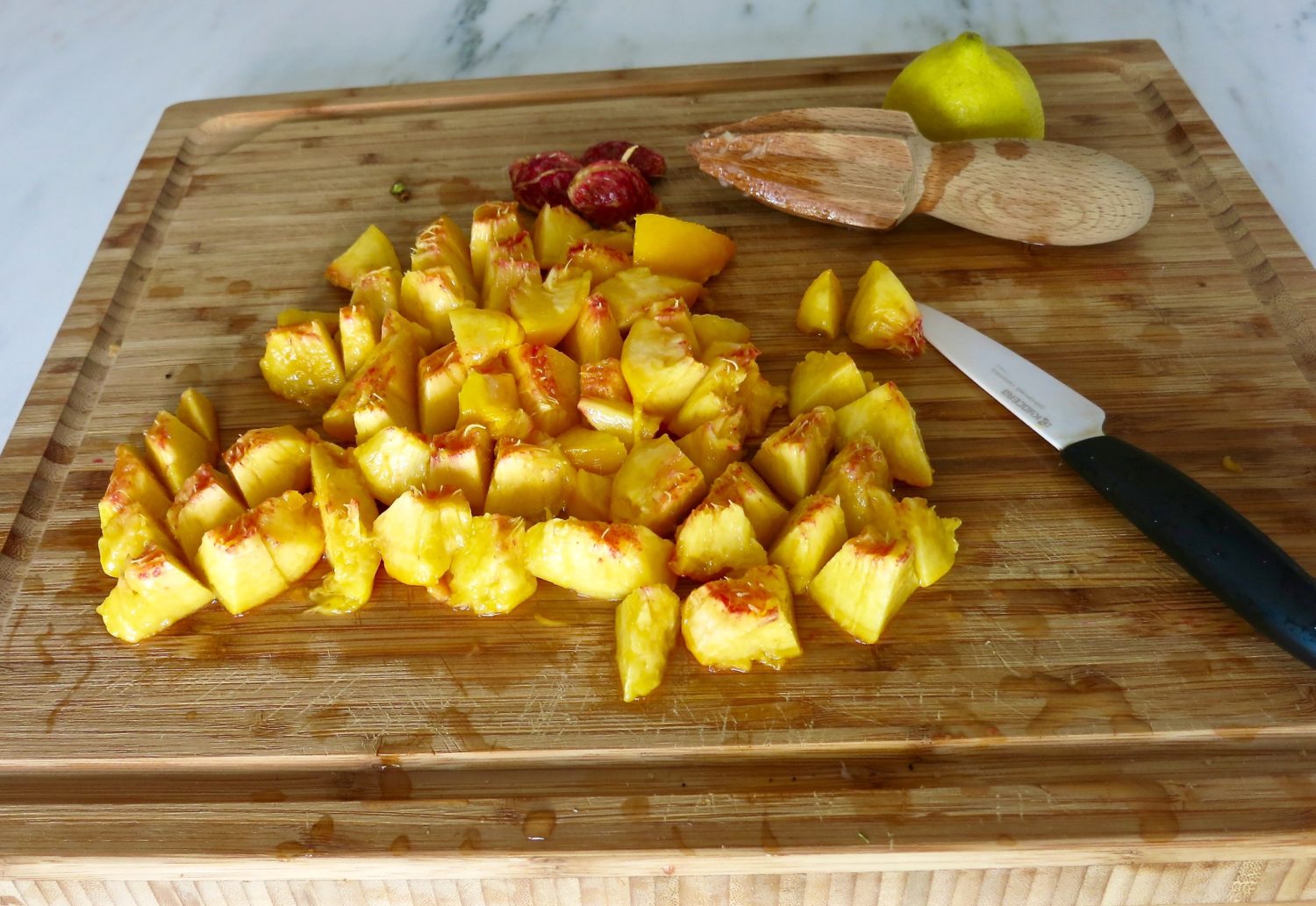
Chop the peaches into chunks and add to your food processor or blender with the sugar, lemon and vodka.
Happy Friday Friends! I hope everyone had a great week. Instead of doing a weekly recipe I thought I would post some foodie links that are inspiring me to get in the kitchen and cook. Last week’s cooler weather reminded me that fall is just around the corner so I feel a particular urgency to cook seasonally. The Farmer’s Market is simply bursting at the seams with its bounty and I want to eat it all. Corn? Tomatoes? Peaches? Chard? Beets? Raspberries? Plums? Yes please! I invite you to do the same.
Salads:
Tomato and Stone Fruit Panzanella with Burrata
Sweet Corn Salad with Pancetta and Mushrooms
Fresh Corn, Tomato, Avocado and Basil Salad
Green Salad with Golden Beets, Raspberries, Pistachios and Goat Cheese Toasts
Mains:
Grilled Steak Salad with Tomato Vinaigrette
Chicken Salad with Roasted Red Bell Peppers and Almonds
Angel Hair Pasta with Raw Tomato Sauce
Desserts:
Strawberry Cheesecake Ice Cream Pie
Cocktails:
Watermelon Cocktail with Gin and Basil
This month’s tip of the month comes from another one of our physical therapists, Kari.
A big topic of discussion lately is the rate of injuries in young athletes, especially females. According to data done by SPORTSMETRICS USA, females are 2-10 times more likely to have an injury to a ligament in their knee compared to males. Although we cannot completely avoid the terrible fate of someone tearing a major ligament in their knee, we can help to prevent it. With lots of experience rehabbing ACL tears and expertise on the SPORTSMETRICS program, Kari has lots of helpful tips to keep you or your kids from tearing an ACL during year-round sports. The biggest thing Kari noted was that individuals have to strong in a “well rounded way.” This means training the body as a unit rather than in segments. It seems like these days guys tend to skip the infamous leg day, while women favor the leg day and skip the upper body as fearing they will become “bulky.” In addition to lifting appropriately for your whole body, it is key to find sports to do year-round. While high school offers a full year of sports this is definitely something kids should take advantage of. From Cross- Country to Basketball and Soccer, there are many different sports that incorporate different parts of the body, different muscles and require different strengths.
While total body strength is extremely important for prevention, it is strength in the core and hips that hold your body together. Amazingly enough this concept has reached coaches of all sorts. Recently, we have seen core and hip strengthening exercises becoming incorporated into everyday practices.
Another huge part of prevention is focusing on proper form. Unfortunately, most people are unaware of their improper form and this is something that needs to be corrected immediately if they want to avoid injury. From my time as a running coach for SPORTSMETRICS, Kari has taught me all the tools to help make sure our athletes practice with good form. SPORTSMETRICS itself is something I’ve only recently heard of. The program was created by sports medicine surgeon, Dr. Frank R Noyes and is designed to help reduce the risk of knee injuries, especially in females, as mentioned before. The official program is six weeks long and incorporates plyometrics, which are jumping activities, strength, flexibility and agility training to prepare athletes of all sorts for their sport while preparing muscles of the hamstrings to help control the knee joint. It is this program that inspired Kari to bring it to Peak Performance. Our program is a little modified from the original, but has the same goal: to prevent knee injuries. As a coach for SPORTMETRICS this summer, I have had the opportunity to teach my athletes how to control their form. The major things we focused on were knees forward, toes forward, soft landing and butt back. All of these aspects were initially hard for some of the athletes, but after a few weeks many of them were doing the jumps with great form and success. Just these simple movements help to train those key muscles to help control your knee during a game, match or race.
Man! That was a lot of information. It all seems like simple concepts, but they are extremely important. Here are a few exercises for you to try out and share with other fellow athletes or your kids.
Hip Strengthening:
-Hip Bridge
-Step downs
-Single leg squat
-Clams
Core:
-Planks: Who doesn’t love planks, on so many different surfaces, to the side
Plyo’s Sample Program:
-Line jumps 2 x 20 sec (Forward/backwards, side/side)
-Wall taps 2 x 20 sec
-Squat jumps 2 x 10 sec
-Tuck jumps 2 x 20 sec
-Broad Jumps 2 x 5 reps
-Bounding in place 2 x 20 sec
For more information on SPORTSMETRICS visit their website and explore!
Over the past few years the Fitbit has grown in popularity for the general public as well as athletes with sales of the Fitbit increasing by 150% over the past year. So what makes these little gadgets such a hot item? Let’s start with the different types of Fitbits and what they have to offer. The lowest end Fitbit is the Zip which is a clip on step tracker costing $60. Next are the One and the Flex. The One is clip on step tracker that also has a clock and sleep tracker and the Flex is a step and sleep tracker that is worn on the wrist. Both of these options cost $100. A step up from these Fitbits is the Charge and the Charge HR. The Charge is a step tracker, sleep tracker, clock and caller ID and costs $130. For $150 you could get the Charge HR which has the same features as the Charge with the additional constant heart rate tracker. Lastly is the Surge which combines all the features of the previously stated Fitbit’s but adds in GPS tracking for more accurate pace tracking. A Surge can be purchased for $250.
Before purchasing a Fitbit it is important to look into the different features and the pros and cons of each. After researching, interviewing, and personally using a Fitbit I have outlined some of the main features of the Fitbit that people like and dislike. The main bonus to having a Fitbit is the awareness that it brings to people. I repeatedly heard comments like “I was unaware of how sedentary my job was until I saw how little steps I had” or “the Fitbit helped me realize how many more steps I should be taking daily”. As far as providing awareness to people about their steps, daily activity, calories, and sleep, the Fitbit hits the nail on the head but where I see an issue is correction of the problems the Fitbit may shed light on. While the Fitbit gives people many statistics and feedback about what they have done, it does not give any information about how to change that behavior or how to make sense of all the information that is given. When someone looks at their overall steps and realizes that they are consistently low, it is important for them to know ways in which they can increase this amount such as standing at work, cleaning the house, mowing the lawn with a push mower, cooking at home instead of going out, exercise while watching TV, taking the stairs instead of the elevator, or parking far away from your destination.
Along with the general features of the Fitbit, this device will also synchronize to an app on smartphones or an internet website. This gives more detailed descriptions of the information provided by the Fitbit by correlating the information to the time at which the data was taken. Along with features such as sleep, step, heart rate, miles, and calorie tracker the app also has a food intake tracker where you can input the food you eat to compare your calories burned with your calories eaten. While it was nice to make this comparison, I struggle with the setup of the tracker. The first big thing to note is people do not always measure portion sizes correctly so while they are imputing one cup of the selected food, they may have actually eaten closer to two cups and so on. The food tracker also only focuses on calories so there is no other nutritional information accounted for within the tracker such as fats, proteins, and carbohydrates so while someone may be hitting their calorie goal they may be doing this with unhealthy foods that may be high in saturated or trans fats or sugars. I was also disappointed with the reviews I got about using the Fitbit for various activities. While it does work great for walking and daily activities it might not be as accurate or account for all activities such as swimming, biking or weightlifting. When doing activities in the water the Fitbit cannot be worn and the activity will therefore not be counted. There is a way that this information can be imputed into the tracker through the app. As far as other activities such as biking or weightlifting, these activities don’t necessarily rely on steps to determine the amount of activity or calories burned. With biking, I had reviews saying that they watched the steps on their Fitbit and the mileage they were biking and it was off from the actual distances traveled. Lastly, for weight lifting I read an article that shared information about the accuracy of a Fitbit and found that not only is a step counter not accurate for weight lifting but neither is a heart rate monitor because the relationship between calorie expenditure and heart rate is not the same for all activities (http://www.sparkpeople.com/blog/blog.asp?post=you_asked_how_many_calories_does_strength_training_burn).
Overall, I have found that the Fitbit has many uses such as bringing awareness to people through showing their steps and calories burned as well as how active they are throughout the day. Where I struggle with the Fitbit is with more intense and active people whose workouts might not be tracked correctly with the Fitbit. When the average person uses the Fitbit in conjunction with education and lifestyle changes in order to meet their goals, I think the Fitbit can be a useful tool to make a positive change toward a healthy and active lifestyle.
This salmon salad is another one of my favorite summer dinners. I think the colors say it all – the corn and cherry tomatoes give it sweetness, the potatoes add creaminess and heft and the green beans, peppers and cucumbers add a satisfying crunch. A homemade vinaigrette tops it all off with some acidity to balance it all out. Feel free to substitute other ingredients as well. I have used beets, carrots, and avocados at different times with the same delicious result. Plus, can you think of a better way to use the season’s bounty? With fall right around the corner I feel an urge to eat local fruits and veggies at every opportunity.
For the vinaigrette:
4 tablespoons red wine vinegar
1 tablespoon dijon mustard
Squeeze of honey
Squeeze of fresh lemon or lime
1/2 cup olive oil
For the salmon:
1 salmon fillet (about 1 pound)
Salt and pepper
4 baby potatoes peeled and quartered
2 ears corn
Handful of green beans, trimmed and chopped into 1-inch pieces
1 cup cherry or grape tomatoes, halved
1 cucumber, peeled, seeded and chopped
1 pepper (red, yellow or green) chopped
2 tablespoons chopped fresh cilantro.
Make vinaigrette: Whisk together the vinegar, mustard, sugar, lemon juice and oil and set aside. Be sure you taste your vinaigrette. It may need more honey or lemon depending on how you like your dressing.
Make salmon: Sprinkle the salmon with salt and pepper. Brush with olive oil and a dash of honey and cook over medium-hot coals, 4 to 5 minutes on each side. When the salmon is cool enough use a fork to flake it out and add to a large serving bowl.
Make the salad: Bring a large pot of salted water to a boil. Add the potatoes and cook until a knife slices through them with no resistance, about 10-12 minutes, depending on the size of your potatoes. Using a slotted spoon, remove the potatoes to a large serving bowl. Add the corn to the same pot of water. Boil for 3 minutes. Remove to a cutting board, allow to cool, slice off the kernels and add to the serving bowl. Add beans to the same pot of water and cook for 3 minutes. Remove with a slotted spoon and add to the serving bowl. Add the tomatoes, cucumber, pepper and cilantro to the bowl. Toss all the ingredient, add the vinaigrette and toss again. Serve and enjoy!
It’s amazing how fast these summers fly by. As we wrap up our summer 2015, be sure to take your last trip to your favorite Wisconsin outdoor pool. Although some of the valley’s best pools have already closed for the season, this week is the final week for the remaining pools in our area. Burn off those extra calories, finish getting bronzed and enjoy Wisconsin’s hottest days at our fabulous public pools.
Of my favorite pools around the valley, Mead has to be my personal favorite. As a kid I used to spend everyday on the high dive and practically lived on the slide. Going back with my little sister and cousins brings back fond memories from when I was a kid. Although Mead hasn’t changed a bit since I little, it’s still as great as it was when I was 10. Of it’s featured attractions, the slide has to be the best. Although I seem to go a lot faster on it now then I did when I was a kid, it is a crowd favorite. Even when it’s barely over 70 degrees the line to that slide always goes down the stairs while the kids and parents are shivering waiting for it to finally be their turn.
After venturing out of the comfort of Appleton, I came upon the Neenah pool. I had never been to this pool until this summer when I was bribed/forced to go by my 7 year-old sister who had been raving about it all summer. When we got there, I was pleasantly surprised that it was such a nice space backed up right onto Lake Winnebago. The best part of this pool is that it has a shockingly large area that is shallow. This makes it great for kids who are just learning to swim and for parents who are watching their kids play. Overall, it is a great place for kids of all ages with two slides and diving boards for older kids and shallow water and a sand area for the younger kids.
This last pool is located a little bit further away in Green Bay. Although I have never been to this specific pool, it has great reviews. Joannes Aquatic Center is decked out with two large slides, a diving board, wading and swimming area and much more. This large pool is sure to please the whole family and keep everyone cool and entertained on a hot August day.
Instead of spending the last few weeks of summer indoors and playing video games because it’s simply too hot out, take your friends, kids or family to the pool and have a last hoorah before the first day of school creeps up on us. Hit up those pools for their final week!
So we’ve all heard of this new trend called CrossFit. From what many people know, it is a bunch of muscular men and women Olympic lifting weights for what seems like 100 sets. Contrary to what many people think, it’s for more than just a body builder and athlete. CrossFit is a surprisingly diverse program for people of several different ability levels.
A little History..
CrossFit itself was created by coach Greg Glassman over several decades ago, although it increased in popularity about 12 years ago. CrossFit coined their own definition of fitness and has been used all around the fitness world. To them, fitness is defined as “increased work capacity across broad time and modal domains.” For us, this means increased work ability over distance and time. While CrossFit is known as the “sport of fitness,” it has combined the competition and fun of sport while yielding intensity that cannot always be met by traditional sports. “It is our observation that men will die for points. Using whiteboards as scoreboards, keeping accurate scores and records, running a clock, and precisely defining the rules and standards for performance, we not only motivate unprecedented output, but derive both relative and absolute metrics at every workout. This data has important value well beyond motivation.” CrossFit revolutionized traditional fitness with the added intensity of competition that has ultimately sparked interest of athletes, fitness enthusiasts and others alike. Much like a sport, CrossFit has seen such great success because of the community it has built. As the program is designed to create community, it has shown success in creating a supportive and motivational environment for those who are involved and keeps people coming back! Its use of functional movements, is what ultimately gained CrossFit its legendary fame. These functional movements include anything that are considered “core movements of life” and can help individuals with their activities of daily living. Its additional safety, efficacy and efficiency are three more aspects that add to this contagious program.
What’s The Truth?
CrossFit is a great program that challenges an individual both mentally and physically. While it provides challenges for some of the most elite athletes, it is also perfectly suitable for someone with little experience. From older individuals to even those with heart disease, CrossFit has the ability to be flexible while changing load and intensity without changing the program. This program is especially great if you are someone who struggles with motivation and commitment. With the help of your CrossFit friends and family you’ll have no problem making it to your sessions. With such a high intensity program, you are able to burn a large number of calories in a shorter period of time compared to your traditional weight lifting. As a result of this, it has been shown to help improve regulation of hormones, as well as, aerobic fitness. With that being said, there are many steps a person must take to do CrossFit properly. Due to its intensity, there is an obvious risk of injury. Each participant must follow strict directions to ensure proper lifting form to avoid future injury. The process an individual must go through is outlined by ACE.” An individual should first develop necessary joint mobility (especially at the ankles, hips and shoulders) as well as joint stability (particularly in the core region) to learn how to effectively perform hip hinge, squat, pushing, pulling and rotating movements. The explosive and plyometric exercises in a CrossFit workout require rapid lengthening and shortening of muscles so if a participant does not take the time to develop the necessary flexibility and movement skills first, the joints might not allow a full range-of-motion which could affect muscle tissue and cause an injury.” So, while it does have some downfalls, CrossFit is a great program for someone looking for something challenging.
Want to learn more? Check out additional information found on ACE’s website and CrossFit.com
This grilled steak salad is one of my favorite summer dinners. An easy marinade adds just the right amount of sweet and salty to the meat while the creamy blue cheese, sweet cherry tomatoes and pungent red onion gives it tons of flavor. I like to use arugula for the greens because I enjoy their peppery flavor. Feel free to use a spring mix or even baby spinach if you do not appreciate bitter greens.
For the Marinade:
1/4 cup soy sauce
1/4 cup of balsamic vinegar
1/4 cup of olive oil
1 teaspoon dark sesame oil
1/2 cup chopped scallions
1 garlic clove, chopped
2 teaspoons hot sauce ( I used Sriracha but tabasco also works)
Salt and pepper
1 1/4 pound flank steak, skirt steak or flat iron steak
Add all the marinade ingredients to a large Ziploc bag. Add steak, seal it, and marinate in the refrigerator for at least 4 hours or up to 24 hours. When it’s time to grill, cook about 4 minutes a side (flank steak is thin, and it’s easy to overcook), remove, and let sit for ten minutes before cutting. Slice on the bias.
For the Salad:
1 pint (2 cups) cherry tomatoes, halved
1/2 cup (about 4 ounces) crumbled blue cheese
1/2 pound baby arugula
3 tablespoons finely sliced red onion
For the Vinaigrette:
1 tablespoon coarse Dijon mustard
2 tablespoons wine vinegar
1/4 teaspoon Worcestershire sauce
1/2 teaspoon honey
1/3 cup olive oil
Add the arugula to a large bowl. Sprinkle the cherry tomatoes, blue cheese and red onion on top of the greens. Add the sliced steak and drizzle with the vinaigrette. Enjoy!
Coming off of my last college track season, I struggled with what to do to fill all my extra time. I had people tell me to try marathons and that never seemed like something that would interest me. There was no way I was going to transition from being a hurdler to a distance runner. I thought I would spare the world from seeing me try to run awkwardly for about .50 miles and be done.
Eventually, I caved in. I was having some serious running withdrawal and needed something to do. After a couple weeks of running my usual routes around Eau Claire and Appleton I started to check out some of the cool new GPS watches. From Fitbit to Garmin, these new watches were slick, but did not come with a college friendly price tag. I even tried one out and found that they were pretty cool. However, I found myself constantly looking at my time and mileage anxious to see where I was. So even though it was nice finally being able to see my pace and mileage, it was very distracting for my wandering eye.
I started to check out some free apps on my iPhone and was recommended to use Run Keeper. Usually I’m not a person for having apps on my phone, but right away I fell in love with this app. Not only is it FREE, but it does almost everything a running watch can do! My favorite feature is that it can talk to you while you run. This is perfect for me because I can have my phone strapped to my arm with an armband and it tells me when I’ve hit .50 miles, 1.0 mile etc. The coolest part is that you can customize it to whatever you want. If you want it to tell your time every minute, it can do that too. It also tells you pace and if you’re using your location services on your phone it shows you your run summary. Seriously, this is awesome. Even if you’re not a runner, it can map anything from walking to cycling to mountain biking. This app has ultimately inspired me to try out this whole “distance running thing” with its great features.
I’ll let you try it for yourself, what can it hurt? Here is my list of Pros and Cons for this particular app. Enjoy!
Pros:
-FREE
-GPS route mapping
-Goal setting
-Tells you pace, time and distance
-Doesn’t drain your battery
-Gives you splits of your summarized workout
-Allows you to play music while the app is open (Pandora, Spotify etc.)
-Can connect to your personal heart rate monitor
-Allows you to share workouts with friends
-Super user friendly
Cons:
-Have to carry your phone with you when you run, bike, walk
-Can’t look at it while you run
-Can’t compare workouts unless you buy an upgraded package
-No heart rate monitor
Clearly, nothing can really replace a running watch, but this is a good starter without committing a couple hundred dollars to a watch.
Here’s a challenge: let’s transition from sedentary to active with the people you spend everyday with. With a little extra push from several of your friends, being active never felt so good. Even if you think you have no time for exercise, think again. There is no excuse not to sneak in some quick body weight exercises especially if they can be done in the comfort of your own office, cubical or chair.
Workplace Challenges:
–Who can get the most steps in a week: Pedometers are pretty easy to come by these days. Challenge your co-workers to a friendly competition of who can earn the most steps around the office in the week. You pick the prize for winners, but it must be health and wellness related.
–Workplace weight loss: Lose weight together. Challenge yourself to a losing weight as a group. See your total weight loss over a couple weeks and even a month.
–Healthy Pot Luck: Share your favorite recipes with your co-workers. Not only is it fun to find tasty new food ideas, but what brings people together better than food?
Favorite Ways To Stay Active At Work:
– Do Calf raises
– Do Body Weight squats: while you’re typing something up or waiting for the printer to print or copy something.
–Take a lap every around your office every 15 minutes: get up to tell someone a message instead of emailing them or hand deliver something to your boss.
–Walk the stairs at lunch or go for a lunchtime walk: Extra co-worker bonding time!
–Do lunges: Make it a group thing, so you don’t feel so silly doing it alone
–March in place in your chair: For when you can’t leave your desk or you’re in a meeting
–Stay balanced with single leg balance exercises:move you head side-to-side or close your eyes to make it more challenging.
–Plank it out: When you’re feeling tired do a plank and find yourself quickly re-energized
–Do chair dips: If you’re just not feeling legs today
As you can tell, there are a million ways to stay active throughout the day in the office. If time is a factor in why you’re not getting your exercise in, then these exercises are a simple solution to your problem. Use your co-workers and boss as your motivators. Get them involved and make it something fun for everyone.
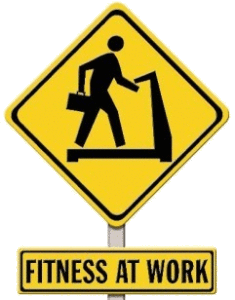
Nothing says summer more than the arrival of the crown jewel of summer produce – the sun-kissed tomato. If you are stuck using tomatoes in salads then here are two fresh ways to use your tomatoes for dinner instead:
Pasta with Tomato Cream Sauce:
Ingredients:
- 4-6 medium sized tomatoes, cored and chopped (you can peel the tomatoes if you’re willing to go the extra step. If the skin doesn’t bother you then just skip it)
- 2 tablespoons of butter
- a glug of extra virgin olive oil
- 2 shallots finely chopped ( if you don’t have shallot just use regular yellow onion – 1/2 cup)
- 2 garlic cloves diced
- a squeeze of lemon juice
- 1/2 cup of cream
- small handful of fresh parsley or fresh basil chopped
- fettucine, tagliatelle or similar
- freshly grated parmesan cheese
Don’t be afraid of the ugly tomato.
Pasta with Tomato Cream Sauce
Pasta with Tomatoes, Arugula and Olives
Ingredients:
- 4-5 medium tomatoes of different varieties, cored and chopped into bite sized pieces
- a couple of glugs of extra virgin olive oil
- a glug of balsamic vinegar
- pitted and chopped kalamata olives, 1/2 cup
- fresh basil, 1/4 cup, chopped
- two big handfuls of arugula
- parmesan cheese, grated
- pasta (penne, spaghetti, linguine)
Put your chopped tomatoes into a colander and sprinkle with salt and pepper. Toss to coat evenly and let the tomatoes stand for 10-15 minutes or so in the sink to drain the excess water. Then put the tomatoes into a large shallow bowl and add a couple of glugs of good extra virgin olive oil and a generous glug of balsamic vinegar. Add chopped olives and chopped basil and toss to coat. Let the tomatoes marinate on the counter (don’t put it in the fridge) while you start the pasta water boiling. You can also skip this step if you pressed for time. After they have marinated add the arugula on top of the tomatoes. Boil your pasta in salted water, drain and pour the hot pasta over the arugula and tomatoes. Let the heat from the pasta wilt the arugula and warm the tomatoes. Toss everything together. Sprinkle fresh parmesan on top and serve immediately.
Ingredients for Pasta with Tomatoes, Arugula and Olives
Pasta with Tomatoes, Arugula and Olives
5 Wisconsin Summer Hot Spots
1. Cave Point County Park: Sturgeon Bay, WI
Cave point is a new found attraction in Door County. With lots of camping space and a location on lake Michigan, it is a great place for everyone. If you have trouble finding something to do here, then you must have taken a wrong turn. You’ll never be bored here, especially with its biggest attraction, cave diving. If you’re not into that sort of thing, there is an option for snorkeling, kayak tours and even cliff jumping.
2. Kalahari Water Park: Wisconsin Dells, WI
For Wisconsin, we know how to do water parks. Probably one of the biggest Wisconsin attractions is the Wisconsin Dells. The Kalahari is great because it is appropriate for just about anyone. With both indoor and outdoor parks it’s even perfect for unpredictable weather. It has slides for thrill seekers and hot tubs for moms and dads waiting for their kids.
3. Waupaca Chain Of Lakes: Waupaca, WI
The chain of lakes is awesome for canoeing, kayaking and tubing. From one lake to another it includes hours of entertainment with beautiful scenery. Not to mention, these lakes are much warmer than some others like Lake Michigan.

4. Rotary Botanical Gardens: Janesville, WI
What a beautiful escape right at our finger tips. While Janesville isn’t as close as we probably would like, its worth the trip down to see some the most amazing floral displays around. Perfect for a cool summer day, Botanical Gardens will not bore you, that’s for sure. It’s complete with some of the most dramatic and awesome themed gardens around. I’m going to be honest, nature is pretty darn cool.
5. Bay Beach: Green Bay, WI
Bay Beach is our version of Great America, but smaller, closer and perfect for a relaxing day trip with the kids. Everything from huge swings, to mini roller coasters and all the rides that spin. However, if you’re like me and aren’t one for fast moving, spinning objects, Bay Beach surely has something for you like bumper boats, large slides and much more!
Have you ever seen Garlic Scapes at the Farmer’s Market and not known what they are, much less how to use them? You can use them to make a delicious garlic scape pesto for your next pizza or pasta dish.
Garlic Scape Pesto
Ingredients:
- 10-12 scapes roughly chopped
- ¼ cup slivered almonds
- ½ cup extra virgin olive oil
- ¼ cup Parmesan cheese, grated
- ½ cup basil leaves roughly chopped
- Juice of one lemon
- salt and pepper to taste
Place the silvered almonds in a small pan set over medium-low heat and lightly toast, about 5-7 minutes. Place the garlic scapes in a food processor and pulse for 30 seconds. Add almonds and pulse for 30 seconds. Scrape down the sides of the bowl. Add the olive oil and process on high for 15 seconds. Add the Parmesan cheese and pulse until the ingredients are combined. Add the basil and lemon juice, and process until reaching the desired consistency. Add salt and pepper to taste and serve.
* If the resulting pesto is too garlicky try adding 1/4 cup of heavy cream to thin it out.
Here are some ideas for your pesto. Or you can make this:

Add garlic scape pesto, sliced tomatoes and fresh mozzarella to a pizza crust. Bake at 475 until crust is golden and cheese is bubbly.
As we get into the peak of the summer hydration is an important thing on our minds. As temperatures climb exercising becomes harder as we lose more fluids through sweat.
During exercise, the normal person loses about 2-3 liters of sweat per hour. This leads to body mass losses of around 2-3%. Although this number isn’t that large, it can have huge effects on exercise performance. These numbers have been shown to fluctuate, however. Depending on an individual, their exercise program, metabolic rate, weather and even clothing, sweat rates and body mass loss can change greatly. The loss of water through sweat and improper re-hydration after exercise can ultimately lead to dehydration.
Dehydration refers to the loss of body water. Along with some more serious heat related conditions such as heat exhaustion and heat stroke, dehydration can cause muscular cramps and fatigue. This is measured through core body temperature, heart rate and rating of perceived exertion. The greater the dehydration, the greater these physiological measurements will be. With increased stress, there has been observed impairments in performance especially in endurance athletes exercising for extended periods of time. According to one source, Cheuvront et al 2003, great reductions in body mass as a result of increased sweat loss (greater than 2-7%) have been shown to cause significant reductions in exercise performance, especially in hotter and more humid environments.
Staying hydrated, therefore, is a crucial way to help maintain and improve exercise performance. Prior to exercise, a person should adequately hydrate for 8-12 hours before their next exercise session. Drinking beverages containing salt (Gatorade), or eating salty snacks can even help stimulate thirst and the retention of fluids. Our past view of the traditional eight glasses of water a day has drastically changed. According to many sources, in order to be considered properly hydrated, you must consume about 1/5 to 1 ounce of water for each pound that you weigh. So, if someone weighs 120 lbs, they should consume roughly 60-120 oz. of water per day. That does sound like a huge range, doesn’t it? Well, the need for water will depend a lot of how active you are, where you live, your metabolic make-up and even the clothes that you wear. So if you’re an athlete who exercises in the hot and humid weather, you are likely to consume much more water than someone who is sedentary and lives in cooler climate.
After exercise, the primary goal is to replace any fluid that was lost during exercise. This replacement may be in sodium, potassium and electrolytes. An individual should consume roughly 1.5L or fluid of every kg lost during exercise. If an individual fails to properly hydrate after an exercise session, their performance could continue to deteriorate into the next day and next exercise session. Avoiding dehydration during exercise is key to avoid declining performance. If you find yourself exercising for prolonged periods or in hot climates, it is suggested that you consume a sports beverage. Compared to water, these beverages contain potassium, sodium and carbohydrates that will help to give you extra energy as you start to increase your sweat production.
Did you get that?:
-Consume roughly 1/2 ounce to a 1 ounce of water per pound you weight (ex. for a person who weighs 120lb, this will be 60-120 oz, that is roughly 2.5-4.8 25oz water bottles per day)
-Re-hydrate immediately after exercise and up to 2-4 hours prior to exercise to prevent dehydration later
-Everyone loses different amounts of sweat during exercise. Be aware of your environment & clothing as a way to stay cool and hydrated during your summer workouts
-Gatorade or other sports drinks containing electrolytes and sodium can be beneficial after exercise to quickly help restore what was lost through sweat.
Workout clothes or recently coined “active wear” is a big topic of conversation recently. These days, people are wearing less black, gray and blue and more zebra print, polka dots and the most ridiculous patterns I’ve never seen before. I am definitely guilty of following this outrageous new trend, but I’m not the only one. When it’s all said and done, does it really matter if you look fabulous when you go to the gym? Are these new trends actually better or are they just a fashion statement? Let’s first take a look back at some of the trends through time courtesy of the Huffington Post.
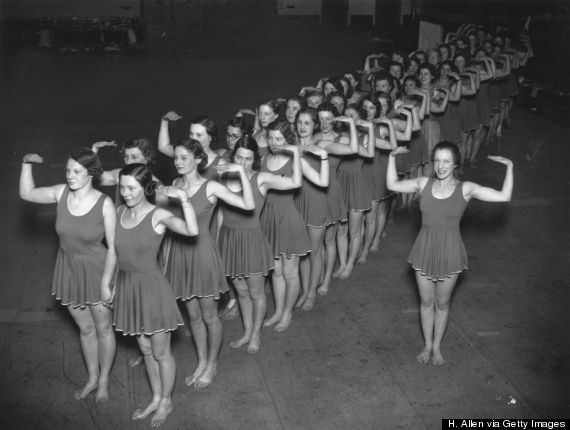
14th December 1937: Women participating in an exercise class run by Miss Majorie Mc Killop (right), a twenty five year old Australian heiress and socialite. (Photo by H. Allen/Topical Press Agency/Getty Images)
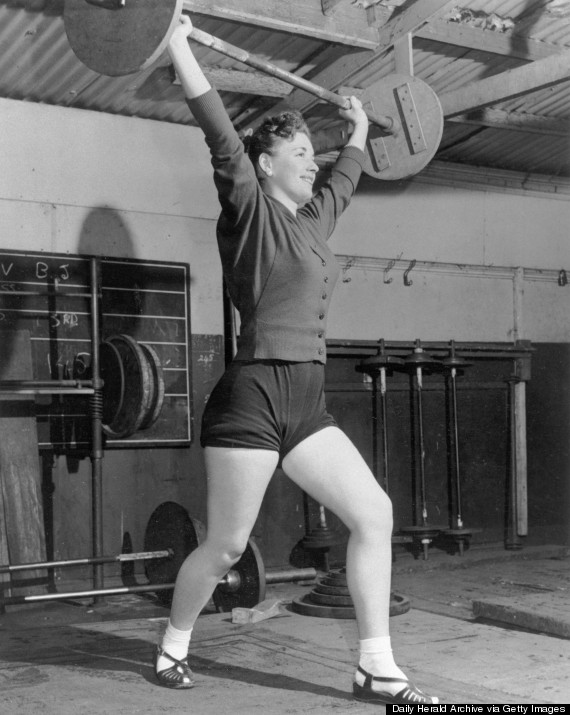
UNITED KINGDOM – FEBRUARY 23: Woman lifting weights, 29 February 1956. Woman lifting weights, 29 February 1956. ‘Using the practice barbell is 18-year-old Cathie Glen, a typist from Shettleston, Glasgow.’ (Photo by Daily Herald Archive/SSPL/Getty Images)
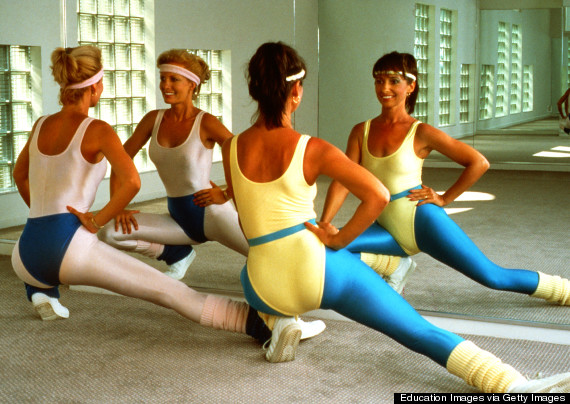
1980’S, Two Women In Workout Clothes Doing Aerobics. (Photo by Education Images/UIG via Getty Images)
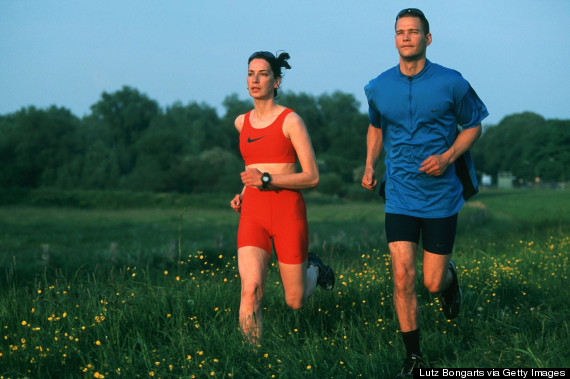
HAMBURG, GERMANY – JUNE 10: JOGGEN 1999, Hamburg; – MODEL RELEASED – (Photo by Lutz Bongarts/Bongarts/Getty Images)
Are these new clothes trends better?
It really depends on your personal preference for material, fit and color. Some of the new technology that they have come up with like dry-fit and other materials are awesome. Compared to our regular cotton shirts, these new types of shirts help wick away sweat and some even help to keep us warmer for longer. Also, the new colors and patterns we are seeing are more than just a fashion statement. With bright greens, yellows, pinks and even reflective material on the clothing themselves, have proved to be beneficial for safely. If you’re one who likes to run in the wee hours of the morning or just as the sun is going down, these bright colors and reflective surfaces help other runners, bikers, walkers and even cars know that you’re there. What you choose to wear also completely depends on what type of activity you do and what you’re most comfortable in. It may take some trial and error, but you’ll be sure to find whatever style, fit and color best suits you and your activity.
Through all the crazy patterns, obnoxious colors and strange dry-fit style, Peak’s PT Brad, likes to keep it plain and simple. Not trying to make any fashion statements, Brad dresses for practicality by keeping it simple with mesh shorts and t-shirt. I think this brings up a great point- does it really matter what you look like when you’re working out? If you’re just going to be sweating in it in about 2 minutes is there really a point to spending copious amounts of money on the latest exercise attires?
For many of us, cotton is just another thing of the past.
Peanut butter and jelly. Strawberries and cream. Dark chocolate and sea salt. Honey and apples. There are just some food combinations that love each other. The two halves are made better when combined into one whole. I would also include rhubarb and strawberries in this list. The bitterness of the rhubarb and the sweetness of the strawberries harmonizes perfectly to create a delicious flavor profile. This syrup is so easy to make and it will make your house smell like jammy goodness. Use it for homemade soda for the kids or as a cocktail mixer for the adults. You can find inspiration here and here. Hurry, though, rhubarb is on its way out at the Farmer’s Market so get some while you still can.
Strawberry Rhubarb Soda Syrup
Adapted slightly from Smitten Kitchen
- 1 lb of strawberries, tops removed and sliced in half
- 1 lb of rhubarb, sliced into 1/2 inch cubes
- 1 cup of sugar
- 1 cup of water
- 1 lemon
Combine strawberries, rhubarb, sugar and water in a large saucepan. Remove several strips of peel from lemon with a vegetable peeler and add them to the pot. Juice the lemon and set aside. Bring mixture to a boil and then reduce it to a gentle simmer. Simmer for 20 minutes, or until fruit has completely collapsed, stirring occasionally. Remove from heat, add half the lemon juice and let fruit cool in syrup. Once cool, pour mixture through a fine-mesh strainer (or, if you only have a coarse one, line it with cheesecloth or a lint-free towel). Press solids with the back of a spoon or spatula to get the most syrup from them.
Save fruit pulp in a separate container; it can be used to stir into plain yogurt, atop ice cream or in your next smoothie. I have been using it atop my yogurt and granola in the mornings.
To make 1 glass of soda, pour 2 tablespoons of the syrup in the bottom of a glass, fill with ice and then add sparkling water. Give it a stir and add more syrup to taste. Enjoy!

Combine strawberries, rhubarb, lemon peel, water and sugar in a large saucepan or stock pot and bring to a boil.

Let the fruit mixture cool completely and then strain through a fine mesh strainer. Use a spoon to push the liquids through. If you do not have a fine mesh strainer, line your regular colander with a piece of cheesecloth or a clean, lint free towel.

Pour 2-3 tablespoons in the bottom of a glass, add ice and top off with club soda. Garnish with a slice of lemon and a sprig of mint.
Yoga in the park: City Park, Appleton
Every Wednesday 6pm
I was biking past city park last Wednesday and came across a huge crowd of people. I found out later that it  was yoga in the park and was shocked that I haven’t heard of it until then. Empower yoga and the Appleton Parks and Recreation teamed up to create this great event every Wednesday. This event is for everyone from families to kids and friends. What a great way to spend a beautiful Wisconsin night! Not only that, but this would be a relaxing end to a busy work day. Why not get a group together and head over to city park to enjoy the company of each other.
was yoga in the park and was shocked that I haven’t heard of it until then. Empower yoga and the Appleton Parks and Recreation teamed up to create this great event every Wednesday. This event is for everyone from families to kids and friends. What a great way to spend a beautiful Wisconsin night! Not only that, but this would be a relaxing end to a busy work day. Why not get a group together and head over to city park to enjoy the company of each other.
Bret Younger 5k, 10k, kids fun run: Appleton North
Saturday July 11th 8am
This event is going on 12 years and celebrates such a wonderful man. Choose to run or walk the 5k or 10k and experience the great path the YMCA has set up through the north-side of Appleton, including Plamann park. If you have nothing on your calendar for this upcoming Saturday, look into working as a volunteer for the Bret Younger. From course marshals to handing out shirts, it is a fun event to work and I know I’m going to be there. All proceeds go towards area track scholarships, as well as the LIVEstrong program at the YMCA. Register now!
Appleton Farmer’s Market : Downtown Appleton
Every Saturday 8am-12pm
Every 2nd Saturday of the month is health and wellness at the farmer’s market. Let’s celebrate by checking out all the fresh produce and other goodies the market has to offer. From fruits to veggies, our market has lots of fabulous local food to choose from. To take it a step further, walk or bike to the farmer’s market and burn some extra calories, it may even save you time looking for parking.
Staying active throughout life plays a crucial part in both mental and physical health. According to the World Health Organization, only 22% of the population 65 years and older continues to exercise regularly and that number splits in half as adults reach the age of 85 years of age. With less time spent exercising, we are putting ourselves at risk for a number of chronic diseases such a heart disease, type two diabetes and stroke. It also leads to poor bone health (especially in women) increased blood pressure, obesity, increased risk for falls, decreased mood and decreased quality of life. With experience working with older adults, there are a ton of ways for everyone to meet the exercise recommendations.
What is recommended for older adults and exercise?
- Aerobic: 150 minutes of moderate exercise/ week or 75 minutes of vigorous exercise per week
- can be broken up into smaller 10 minute bouts
- 30-60 minutes/ day
- Balance: 2-3 times per week
- Flexibility: 2-3 times per weeks
- hold stretch for 30-60 seconds at mild discomfort
- Strength: 2x per week (non-consecutive days)
- 1-2 sets
- 10-15 repetitions
- 8-10 exercises involving all major muscle groups
What are the benefits of exercise?
- increased energy
- decreased risk of disease
- decreased risk of falls
- improved mood
- decreased blood pressure
Here are my personal favorite workouts designed just for older adults:
- Water aerobics: What a great workout! This workout it easy on your joints and gives a total body burn at the end.
- Try it for yourself:
- Deep water running: 10 seconds hard, 30 seconds rest x2
- 15x hamstring curls (against wall)
- 15x hip abduction (out)
- 15x hip adduction (in)
- 20x single leg calf raises
- Deep water running: 10 seconds hard, 30 seconds rest x2
- 10x bicep curls with underwater weights
- 15x overhead press with underwater weights
- Try it for yourself:
- Circuits: Circuits of any kind can be used for both strength and cardio training. The best part is that they as hard or easy as you want.
- Try it for yourself:
- Station 1: 20 seconds of wall squats with stability ball
- Station 2: 20 seconds medicine ball press ups
- Station 3: 20 seconds of balance (single leg or double leg)
- Station 4: 20 seconds of lateral shuffle with resistance band
- Station 5: 20 seconds of push-ups
- Station 6: 20 seconds jump rope
- Station 7: 20 seconds step-ups
- REPEAT 2-3x
- Try it for yourself:
- Seated exercises:
- Try it for yourself:
- 15x chair squats
- 12x overhead press with small weight (or even a can of soup)
- 15x leg extension
- 15x hamstring curl with resistance band
- 12x lateral raises with small weight
- 12x frontal raises with small weight
- REPEAT 2x
- Try it for yourself:
- Body Weight Exercises: No need for a gym for these exercises!
- Try it for yourself:
- 10-12x lunges
- 45 seconds clams
- 15x bird dog
- 12x body weight squats
- 20 seconds mountain climber
- 12x single leg calf raises (use a step)
- 15x arm circles
- 20-30 second plank
- REPEAT 2x
- Try it for yourself:
Last week we roasted beets from Farmer’s Market to make a delicious salad. This week we are roasting carrots and pairing them with avocados. I am always on the lookout for different or unusual combinations and this recipe from Smitten Kitchen caught my eye. The sweetness of the carrots pairs beautifully with the freshness of the avocado. The squeeze of lemon at the end brightens everything up and makes it feel summery. This is a quick and easy recipe that pairs nicely with any sort of grilled protein or you could even use it on top of greens for a more robust salad.
Roasted Carrot and Avocado Salad
- 1 pound carrots, scrubbed or peeled and cut into two-inch segments
- 3 tablespoons extra virgin olive oil, divided
- 1/4 teaspoon ground cumin
- Coarse salt and freshly ground black pepper
- 1 avocado, pitted and sliced
- Juice of half a lemon
- 1 tablespoon finely chopped parsley
Roast the carrots: Preheat your oven to 400 degrees. Spread the carrots on a baking sheet and drizzle with the olive oil. Sprinkle with a generous pinch of course salt (I like to use Kosher salt or sea salt), freshly cracked pepper (or whatever you have) and cumin. With clean hands toss everything together and spread in an even layer on the baking sheet. Roast for 20-30 minutes until tender and browned around the edges. Roasting time will vary according to the size of your carrot chunks. The smaller ones will take less time than the larger ones. I tried to make my chunks all the same size so they cook evenly.
Finish the salad: Once the carrots are roasted, arrange them on a serving platter with slices of avocado on top. Drizzle the salad with the last tablespoon of olive oil, lemon juice and extra salt and pepper, if it needs it. Sprinkle with chopped parsley and serve immediately.
Firecracker 5K-Kaukauna, WI
July 4th
If you haven’t done a 5k on the morning of the fourth, you’re doing it wrong. There’s nothing better than putting on your favorite red, white and blue outfit and being active. You can even walk the 5k if you’re not much of a runner and the kids can participate in a fun run while you cruise through Kaukauna. If getting in some extra mileage hasn’t sold you yet, the Firecracker has tons of hidden surprises including skydivers and much more. Register now, you won’t be sorry!
Egg Harbor Fireworks and Festival– Egg Harbor, WI
July 3rd-4th
Of all the places I’ve seen fireworks, Disney World included, there is no better place than in Egg Harbor. Taking place right on the lake, these fireworks are amazing and are a great end to a busy day at the Egg Harbor festival. Make sure to get there early, though, or you’ll end up sitting behind all the tall folks for the big firework display.
Cardboard Boat Regatta– Sheboygan, WI
July 4th 12pm- Sheboygan Riverfront
This is by far one of my favorite July 4th traditions. Ever since I was a kid my parents always took me to see these entertaining boat races. For those of you who don’t know, the boats created for this event are made with just cardboard and duck tape. Every year the boat designs get crazier and crazier and it is always surprising how well they hold up in the water. This is a definitely a crowd favorite and is guaranteed to be fun for the whole family. After the regatta is over, be sure to explore the beautiful boardwalk Sheboygan has to offer.
With fireworks and food, the Fourth is not always nice on our bodies. For this Fourth, I challenge you to change that. Do a 5k, go to a festival and fireworks and explore everything the fourth has to offer while getting in those extra steps and avoiding foods that you know you’ll regret later. Have a safe and happy Fourth of July everyone!
June’s tip of the month is courtesy of Peak’s very own Miles Weber. Here are a couple tips on how to prevent and care for low back pain.
5 Ways To Prevent Back Pain:
1. Improve your core strength. Your core plays a crucial role in stabilizing your back and although it is often overlooked, it is an important aspect to add to your exercise routine.
2. Get up and move! Contrary to what you may think, sitting all day will not relieve your back pain. If you’re stuck at work all day make a point to get up every hour. Sick of sitting on a chair? Get a stability ball instead. If you’re even feeling a little daring you could consider getting a standing desk, it’s sure to keep you moving throughout the day.
3. Keep an ideal weight. Be the healthiest you.
4. Make good food choices. This goes along with keeping an ideal weight and being active, the better choices you make and the more active you stay the better you’ll feel. Check out our recipes posted every Wednesday for quick, tasty and healthy meal ideas.
5. Improve flexibility- this is especially important as you age.
Things to AVOID:
- Exercises such as crunches and sit-up
- excessive twisting or flexion and extension of the back
- Slouching while you sit, especially for long periods of time
- Lifting objects with improper form
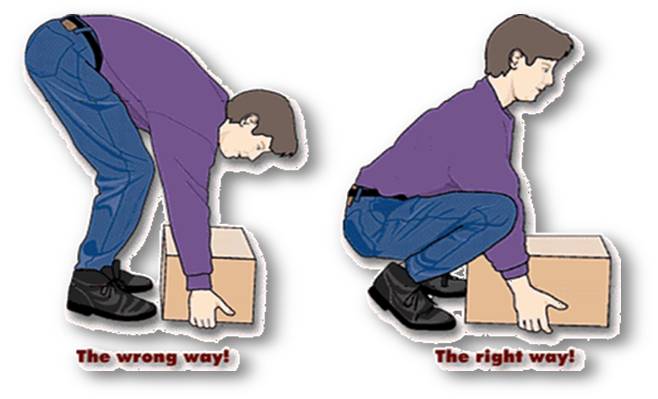
Caring For Your Pain:
Here are some exercises to help care for your existing pain or prevent future pain.
Flexibility…
Core Strengthening…
Hip Strengthening…
If there is one thing you can count on all summer long it is the abundance of beets at the Farmer’s Market. Beets are one of those foods I recently re-discovered. Up until a few years ago I thought all beets were like the ones you get out of a can: tasteless, slimy and unnaturally red. You know when you first try something as a kid and you have a bad experience with it? You swear it off completely thinking that you just don’t like it. Well, I swore off beets. Then I tasted them again and it was a food revelation. When properly prepared beets are sweet, earthy and delicious atop salads. Now they are one my favorite things to eat in the summer. Here is an easy beet salad that you can savor all summer long:
Roasted Beet Salad
- 3 large or 6 medium beets
- ¾ cup walnuts
- 6 cups mixed greens
- 4 ounces goat cheese
- Basic Vinaigrette (recipe below)
- Grilled chicken (optional)
Basic Vinaigrette
Add the following ingredients to a jar with a screw top lid (or a small bowl) and shake (or whisk) vigorously. Taste and adjust seasonings accordingly. If you like it sweeter add a touch more honey. If you want it creamier and tangier, add a touch more mustard. You get the drift.
- 1 tablespoon Dijon mustard
- 4 tablespoons red wine vinegar (or balsamic vinegar)
- squeeze of honey (or a teaspoon of sugar)
- squeeze of lemon
- 1/2 teaspoon Kosher salt (less if you are using table salt)
- freshly ground pepper
- chopped herbs (chives, parsley, dill, thyme, whatever you’ve got or even leave them out)
- 1/2 cup good olive oil
Preparation
- Heat the oven to 400. Wash the beets and cut off the tops and bottoms. Put them in an 8 x 8 baking dish, drizzle with olive oil, sprinkle with Kosher salt and cover tightly with aluminum foil. Cook undisturbed, until you can pierce them easily with a fork, 45 – 60 minutes, depending on the size of your beets. Once the beets have cooled, simply peel off the skins with your hands and cut them into chunks.
- Put the walnuts in a dry skillet over medium heat and cook, shaking the pan frequently, until fragrant and beginning to darken, 3 to 5 minutes.
- Rinse and dry the greens and put them in a large bowl.
- Pour some of the dressing onto the greens and toss to coat; pile the greens on 4 plates. Put the beets in the bowl, toss with some of the dressing and arrange them on top of or around the greens. Crumble the goat cheese on top and sprinkle around the walnuts. Serve and enjoy!
There’s simply nothing better to do with your summer than go to a concert.
Country USA: Oshkosh, WI
June 23rd-June 27th
If you’re one for mud, drinks, and some of the best country singers around- Country USA is definitely for you. It’s certainly not for all music lovers, but if you’re patient enough to wait in the endless traffic and the even longer lines for parking, Country USA never disappoints. Top headliners for this year include: Miranda Lambert and Eric Church, although I’m sure we all wish Taylor Swift would make a special appearance at CUSA just one more time.
Summerfest: Milwaukee, WI
June 24th-28th & June 30th- July 5th
Maybe country is not your jam, then head over to Summerfest. This year’s line-up is filled with all of your favorite musicians like Kendrick Lamar, Stevie Wonder, Sheryl Crow, Carrie Underwood, and even Ed Sheeran (my personal favorite). If you have a day off of work, make the trip down to Milwaukee otherwise you will regret it. How often do you have the chance to see Ed Sheeran in Wisconsin? Never.
Heid Music Summer Concert Series: Houdini Plaza- Appleton, WI
Featured Band: Bad Habitz
Thurs. June 25th: 5:30 pm-8:00 pm
There’s no better way to spend a summer’s Thursday night than relaxing in downtown Appleton. Each week you can find Houdini Plaza filled with music from featuring artists. Grab the family, head downtown, and get a bite to eat. It’s a great way to enjoy Wisconsin’s beautiful summer nights.
What is High Intensity Interval Training?
High Intensity Interval Training (HIIT), is described as alternating bouts of intense exercise followed by short periods of rest.
Why do I love HIIT so much?
HIIT has gained much of its popularity due to fact that it is a fast and effective way to sneak in a workout. It can be done in almost any setting and with almost any equipment including: treadmills, bicycles, arm cycles, and kettle bells. Not only does HIIT take an average of 17 minutes per session compared to traditional aerobic exercise (that can last up to an hour), but has actually been shown to improve your mood!
HIIT is for EVERYONE!
Contrary to what it seems, HIIT is safe for almost everyone. It has been used in populations that are overweight, diabetic, elderly or suffer from diseases such as heart disease or coronary artery disease. Due to the intense nature of HIIT, individuals have noticed changes in their body fat, lean body mass, insulin sensitivity and even aerobic capacity. Not only that, but HIIT is tailored to you! High intensity means something different to everyone and you are in charge of how much you are able to tolerate.
My favorite HIIT workout?
As a collegiate track athlete much of our training involved intervals. However, when I am not running my favorite form of HIIT is deep water running. Although aqua jogging sounds pretty silly, it is challenging as the water acts as constant resistance.
Not convinced yet? Try it for yourself
Kettle Bell (KB):
Warm-up 5-10 minutes
20 seconds on, 10 seconds rest, repeat 2x
KB Around The World
Mt Climbers
KB Snatch Right Arm
Squat Jacks
KB Snatch Left Arm
Burpee
KB Swing
Push Up
KB Goblet Squat
High Knees
KB Crush Curl
Jumping Lunges
20-Minute Running HIIT:
Warm-up 5-10 minutes
This can be done outside or on a treadmill. For this, go at a faster speed (whatever is most comfortable for you) for 1 minute and slow down to a walk or slow jog for 1 minute and repeat this 10 times.
Minute 1: Sprint
Minute 2: Walk/jog
Minutes 3: Sprint
Minute 4: Walk/jog
Minute 5: Sprint
Minute 6: Walk Jog
(Continue to 20 minutes)
If you want to cut back on your daily sugar intake, breakfast foods are a good place to start. Cereals are fast and easy but they easily contain 10+ grams of sugar per serving. Plus, cereals leave you feeling hungry an hour later because they contain very little protein. Nowadays I eat plain, whole fat yogurt with homemade granola almost every day. I make a big batch every couple of weeks so I have some on hand when time is tight in the morning. It is still fast and easy but also satisfying because of the whole grains and nuts. My favorite granola recipe is the Double Almond Cherry Granola that I found in the Wall Street Journal. I tweaked it a little – reducing the brown sugar and upping the almond butter, nuts and dried fruit. It is a yummy way to start the day and I know exactly what’s in it.
Double Almond Cherry Granola
- ½ cup almond butter
- ½ cup honey
- 2 tablespoons brown sugar
- ½ teaspoon ground cinnamon
- 1 teaspoon vanilla extract
- 3½ cups rolled oats
- 1 ½ cup slivered almonds (or your other favorite nut)
- 2 tablespoons chia seeds (optional)
- 1 teaspoon Kosher salt
- ¾ cup dried cherries (or your other favorite dried fruit like raisins or currants)
1. Preheat oven to 325 degrees. In a small saucepan over low heat, mix almond butter, honey and brown sugar until mixture is soft and combined, about 3 minutes. Off heat, stir in cinnamon and vanilla.
2. In a large bowl, toss together oats, almonds, chia seeds and salt. Pour almond butter mixture over oat mixture and toss well. It will be sticky. Make sure oats, almonds and chia seeds are well coated.
3. Lightly grease a rimmed baking sheet with vegetable oil or nonstick spray. Spread oat mixture onto baking sheet in a single layer. Place in oven and bake, stirring once halfway through, until golden brown, about 20 minutes. (Granola will be soft when removed from oven but will become crunchier as it cools.) Let cool on baking sheet, then stir in cherries. (Cooled granola will keep for 3-4 weeks in an airtight container.)
Note: The almond butter can easily be substituted for peanut butter. Do not use natural peanut butter, however, or it will separate when heated.
When June hits, another Wisconsin summer has officially begun. No, I’m not talking about the endless construction or the copious amounts of cheese curds and beer we will consume, but rather the fun and festivities that are to come.
From Cheese Fest to Mile of Music, the Dairy State has something to offer for everyone. Check out our blog every Monday to find out what’s going on in the Appleton area and all over Wisconsin. In honor of Father’s Day coming up on Sunday, this week is dedicated to all the fun things we can do with and for dad.
Kohler Golf Course: Kohler, WI
Price: $190-385 (depending on course)
When?: Anytime
What dad doesn’t like golfing? Although the courses in Appleton are always a good choice, my dad’s personal favorite is found in Kohler, WI. The hour drive to Kohler is well worth it as you will not be disappointed by the beautiful and dynamic courses Kohler has to offer. Whether you are a beginner or expert, each of its four courses will have something for everyone. Oh, and did I mention it’s home of the 2015 PGA Championships?
If you don’t find golf as exciting as it looks, stop over at the Kohler Design Center while dad stays busy. It has a showroom of products, history behind of the Kohler company and the notorious wall of toilets that I highly recommend seeing.
Mulberry Lane Farm: Hilbert, WI

Image by David Gn
Price: FREE for dads on Father’s Day, $12 for general admission: ages 2-92
When?: Sunday June 21st 10am-3pm
If you have young children then Mulberry lane Farm is the perfect place to take the family on Father’s Day. Experience milking cows, riding ponies and learning about animals. What’s better than spending a day at a farm with the ones you love? After all, this is Wisconsin.
Jason Aldean, Old Dominion, Brantley Gilbert, Cole Swindell Concert: Lambeau Field, Green Bay

Image by Benjamin Pc via Flickr
Price:$60-400
When? June 20th 5pm
Country and summer are a combination that were just meant to be together. With the warm summer weather and Lambeau practically in our backyard, what’s a better present for dad? Even if he’s not the biggest country fan, tell him it’s good family bonding- dads are suckers for that.
The Fire: Downtown Appleton
Price: Ranges depending on items
When: Tues-Friday 11am-8pm; Saturday 10am-8pm; Sunday 12pm-6pm
I can’t even express how much I love The Fire. Even if you lack creativity, like myself, you are sure to find The Fire to be fun and easy. With mosaic, pottery and glass working, it’s a great place for everyone and anyone. The Fire is a great place to take your kids and siblings and make something special for your favorite man.
-I would like to make a shout out to all the wonderful men in my life- both my grandpas, my dad and my step-dad. An extra special shout out to my dad for helping me move in/out of three different houses, telling horrible jokes and always buying me the same shirt in different colors- thanks for all you do!-
Jogging strollers are on a roll at Peak Performance
Staying active is a crucial part of life, but is often overlooked by new moms and dads as they try to keep up with their growing children. Although staying active is hard for most parents, the moms at Peak Performance showed me some tricks to balance work, kids, and exercise. The answer is jogging strollers.
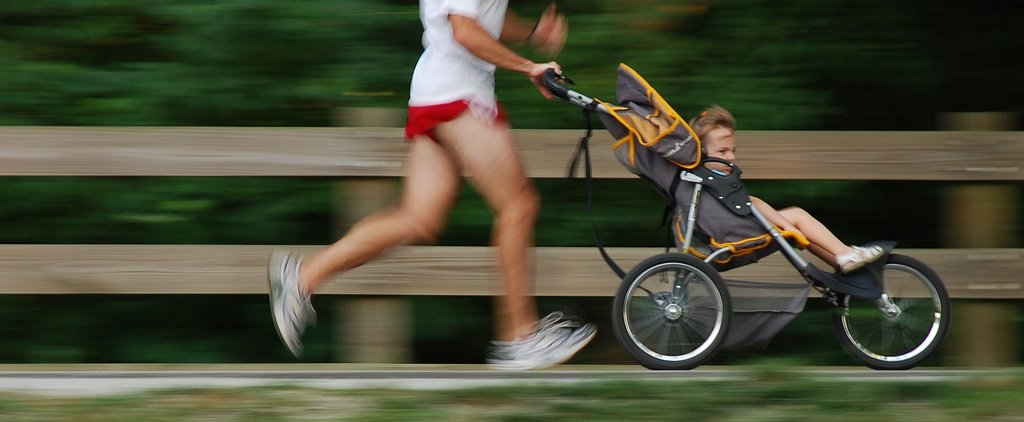
Image by Al Herms
I didn’t realize how popular these strollers were until the ladies were raving about them during lunch. Not only are they an incredible workout- with that extra weight, but their kids love it. Through the hundreds of brands and types you can choose from I got some insight on the favorites at Peak Performance.
Kari:
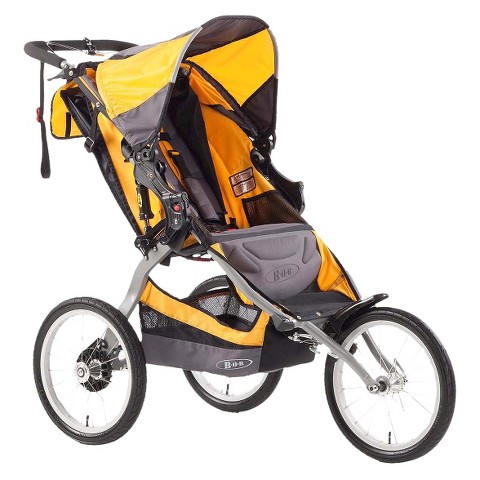
As the owner of Peak Performance Physical Therapy, finding time to exercise has been a task for Kari. Thanks to the help of her Bob Ironman Jogging Stroller, she is able to run four times a week. Not only does her son have a blast going along for the ride, but it also gives Kari the ability to continue her passion for running.
Nikki:
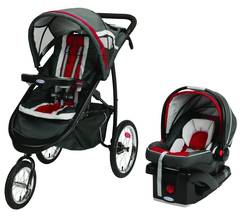
Sold at Graco.com
Nikki’s Graco Fast Action Fold Jogger Click Connect Stroller is all-inclusive as it has a car seat base that can convert into a ‘regular’ seat for older children. Although the name is a bit wordy, this functional stroller guarantees satisfaction as it grows with your child.
Molly:

Sold at Performancebike.com
Molly fell in love with the Thule brand after trying out their biking equipment and discovering what a good and dependable brand they are. Her Thule jogging stroller is her most used exercise equipment as it allows her to continue training with the company of her little girl.
Here are some quick tips from the pros:
- Make exercise a priority: Plan out when you will have time to exercise and stick to it
- Be active with your child: Take them jogging with you or do body weight exercises at home while they play. Show your child that being active is fun!
- Use your time wisely: If your child wakes up at 5 in the morning, use this time to go for a quick jog instead of staying in and playing
- Find a workout facility with childcare: The small fee for childcare is well worth it as you will get some time to sneak in weight training or classes. Check out childcare options at the YMCA, Lakepark and Xperience Fitness
- Teamwork: Work with your partner to find time where you can switch off watching your kids and exercising. Single parent? No problem, ask a friend or family member to watch your child while you exercise.
Don’t let being a parent and your career stop you from exercising. Make it happen! Stay healthy for your future and your children’s future.
Chillax! You’re Halfway There
I think it’s safe to say that we went out all out for the Fox Cities Marathon last Sunday. We invited staff, family and friends to dress as minions from Despicable Me. We played upbeat music, handed out gel packs and cheered until our voices went hoarse. It was a great day!
In honor of this year’s Fox Cities Marathon here are 10 fascinating facts, brought to you by Everyday Health
- Upon the Greek victory over the Persians in 490 B.C., legend says that soldier Pheidippides ran 25 miles from Marathon to Athens to deliver the news. After he arrived, Pheidippides yelled out, “Rejoice, we are victorious,” then collapsed and died.
- A 140-pound woman running 10-minute miles will burn 2,777 calories during a marathon. That’s about twice the recommended daily caloric intake of 1,200 to 1,500 calories.
- Paula Radcliffe of Great Britain holds the world record for fastest marathon, which she set at the London Marathon in 2003 with a final time of 2 hours, 15 minutes, and 25 seconds.
- Patrick Makau Musyoki of Kenya set the world record for men in 2011 at the Berlin Marathon when he ran the course in 2 hours, 3 minutes, and 38 seconds.
- Oprah finished the Marine Corps Marathon in 1994 in 4 hours, 29 minutes. After finishing, Winfrey said, although making it through was “better than winning an Emmy,” she had no desire to ever run another marathon.
- In 2003, Sean Combs set out to “beat Oprah” in the New York City Marathon. He finished in 4 hours, 14 minutes, 54 seconds.
- More famous faces who have footed their way through 26.2 miles including: President George W. Bush who ran the Houston marathon in 1993 in 3 hours, 44 minutes; Will Ferrell who completed the Boston marathon in 2003 in 3 hours, 56 minutes, 12 seconds; and Katie Holmes who finished the 2007 New York City marathon in 5 hours, 29 minutes, 58 seconds.
- In 2011, Belgian runner Stefan Engels ran a marathon every day for a year, covering a total distance of 9,569 miles. “I don’t regard my marathon year as torture. It is more like a regular job. I am running just as Joe Average goes to work on Monday morning, whether or not he feels like it,” he wrote on his website via CNN.
- In 1972, the Boston marathon became the first marathon competition to allow women to enter; the distance was previously considered too grueling. In 1984, the Olympics opened the marathon competition to women.
- But even before the Boston marathon officially allowed women to race, there were a few daring females who snuck in. In 1966, Roberta Gibb cleverly hid in the bushes until about half of the racers had passed her by. Then she quickly jumped in, ran the course, and finished in 3 hours, 21 minutes, 40 seconds. Inspired By Gibb, the following year Katherine Switzer applied under her initials, K.V. Switzer, and was accepted. About four miles into the race, officials noticed “K. Switzer” was actually a girl and tried to boot her from the run. Switzer’s boyfriend shoved the official away, allowing her to finish the course in about 4 hours, 20 minutes.








Click here to see the race results.
Distance isn’t the only measure of respect
We have all seen them while driving around town: 26.2 or 13.1 bumper stickers that proudly proclaim the running prowess of its occupant. Marathoners are everywhere, or at least that’s how it seems. Amateur runners are racing longer distances in record numbers. According to Running USA, a nonprofit organization dedicated to distance running, participation in triathlons, half marathons, and marathons has doubled since 1990.
But is more necessarily better? Are you a better athlete because you can run a marathon? Studies now show that short, intense bursts of exercise provide the same benefits as sustained, endurance workouts. A 30-minute workout of 10 minute intervals of intense exercise and recovery “has been shown to improve aerobic capacity, skeletal muscle oxidative capacity, exercise tolerance and markers of disease risk,” said a review of exercise research. The review was published this year in the journal Applied Physiology, Nutrition and Metabolism.
Similarly, a research paper published in July in the Journal of the American College of Cardiology says milers enjoy the same mortality-fighting benefits as marathoners. The study of 55,137 adults over a 15-year period found that those who ran less than an hour a week lived longer, as did those who ran more than three hours a week. Both groups on average lived three years longer than non-runners.
Now there are no excuses not to run. When you only have twenty minutes to workout just remember that you can produce the same long term benefits as endurance athletes in a fraction of the time. Or perhaps you are a current marathoner who wants to opt out of the distance arms race. The races keep getting longer but the time you have to train stays the same. Just say no because there is a new race in town that can give you the same street cred. Why not make the mile your new goal?
Here are some resources where you can learn more about mile races:
Fleet Feet Make-It-A-Mile Running Program
Why Drink Water?
Water is the most abundant, yet possibly the most overlooked, substance in the body. It is impossible to sustain life for more than a week without water. It is necessary for the healthy function of all internal organs. Without water your kidneys won’t function well, your brain won’t work properly, your skin will become dry and itchy, you will get constipated, and you will have trouble regulating your body temperature.
Knowing all of these things, why in the world would we not want to drink the recommended amount of water each day?
Well for one thing, if you are not used to drinking the recommended amount of water each day, once you start, you may end up feeling like your back teeth are floating by the end of the day.
8 Glasses a Day
Most articles you read recommend between 8 and 12 eight-ounce glasses of water a day, however, believe it or not, there are times when your body may need even more water. Those include but are not limited to: when you exercise, when you travel (especially in airplanes), when you are ill, when you are in a high altitude area and when the weather is warm.
Athletes Need Water for Optimal Performance
Athletes will find that maintaining a constant supply of water in the body is vital to optimal performance. In a dehydrated state, your muscles fatigue and may develop cramps. Pay attention to this when exercising. Do not make the mistake of thinking these cramps are caused from drinking too much water. I did this during a marathon and found myself in the medical tent immediately after crossing the finish line. In a worst case scenario, an athlete can experience heat exhaustion or heat stroke because of the body’s inability to cool itself. It is important to drink before, during and after a workout.
Helpful Tips
If drinking 8 glasses of water a day sounds daunting, these tips might help:
- Use a water bottle throughout the day and keep it with you.
- Drink a glass of water before your meals, when you are hungry, rather than after.
- Replace coffee, sodas and sugary drinks with water.
- Get in the habit of drinking a glass of water during your other daily routines.
Water Has More Benefits Than You Know
The truth is most of us are not drinking enough water. Do yourself a favor and increase your daily intake. You’d be surprised at the benefits. It even helps with blogging!
Small, Medium or Large? It’s not that simple.
I bet that everyone reading this blog knows their shoe size, their shirt size and their pant size….but do you know your bike size? Yes, your bike size. A bike should fit you. From personal experience, I can tell you that finding a bike that fits is much less traumatic than finding a swimming suit or pair of jeans that fit.
Does An Average Person Need a Bike Fitting?
You bet. Whether you are riding to the park or riding in a triathlon, you need a proper fitting for your bike. This is not a ‘small, medium or large’ sort of deal, either. Everyone is unique. Our bodies are not perfectly symmetrical. Often times one leg or one arm is shorter or longer than the other. These differences, if not accounted for, can lead to pain and eventual injury. The goal of properly fitting your bike is to maximize your comfort and minimize the potential for injury.

Chain Reaction exterior
What Does a Bike Fitting Entail?
A lot more than you might think, but never fear…there are professionals out there who are happy to help. I purchased my bike at Chain Reaction Cyclery in Appleton and had a great experience.
Niki, the store owner, began by speaking with me about how I planned to use my bike and the amount (and type) of biking I would be doing. She put my bike on a trainer and asked me to sit on it while she performed a variety of measurements using a number of tools, strings and weights I had never seen before. (if I had paid more attention in geometry class I might have had a clue)
I sat on the bike the same way I would if I were riding outside and then pedaled several times while Niki made a series of other adjustments. Who knew how many things could be adjusted on a bike? Turns out, the most minor of adjustments can make a significant difference in the comfort of your ride, especially adjustments to the saddle.

Niki at her shop
Adjusting The Saddle
Let’s face it. Getting used to a new bicycle seat can be an adventure. If you saddle is not fit properly, that ‘adventure’ turns into a ‘nightmare’ really fast. Your bike seat should be level and in a good position to support your body. Tilt it too far forward and you will slide down the seat. This puts added pressure on your hands and knees….not to mention a really uncomfortable wedgie. Over time, poor saddle position can cause unnecessary injury. Tilt the seat too far back and you will create uncomfortable pressure points. No further explanation needed, right?
Handlebar Adjustment
There are all sorts of different adjustments that can be made here. You can change the width and the height as well as how close or how far away they are. This is critical because improper positioning can cause neck, shoulder, back and even hand pain. Niki adjusted my handlebars a bit lower because I was planning to participate in some triathlons. She told me that recreational bikers might want their handlebars a bit higher.
Why Can’t I Do It Myself?
Well, the truth is, you can. However, there are so many adjustments that can be made and the adjustments can be so slight that I highly recommend that you take the time and money to have your bike professionally fit. The time and expense will save you from pain and potential injury in the long run. It can also maximize your efficiency and increase your enjoyment. Any reputable bike shop will be able to fit your bike, but not all bike shops offer the same degree of expertise. I suggest you find someone like Niki, but if you are determined to do it yourself, take a look at this Performance Bike video on fitting a road bike first.
5, 10, 20……..?
We’ve all got them….countless race shirts from countless races. But do we actually wear them? In my experience, most t-shirts get shoved in a drawer, pulled out only to wear while painting, gardening or performing some other messy chore.
Men and Women Are Different
It’s not that I don’t want to wear race shirts….it’s that race shirts almost always only come in men’s sizes and are almost always cotton. Let’s face it. Women and men are shaped differently. Their t shirts are shaped differently. Women’s’ t-shirts are fitted and men’s are shaped like a box. When was the last time you saw a female athlete shaped like a box? Even when I put on a small sized men’s t-shirt, the sleeves end up half way down my arm and the body of the shirt falls low enough to wear it as a mini-dress. It is not humanly possible to tuck in that quantity of material.
T-shirt or Parachute?
Now that you have a visual of me in the boxy night shirt, imagine what I would look like running down the street….extra material flapping in the wind behind me. Not only is it difficult to run in a men’s sized cotton race shirt, it is extremely hot. It doesn’t breathe properly. A well fitted technical T will move with you and offer moisture wicking capabilities. While cotton is fine for everyday use, serious runners appreciate any race that offers technical shirts.
Why Offer Both Men’s and Women’s Sizes?
Given the fact that most half and full marathons have nearly as many men as women participants it would make sense for race organizers to offer both men’s and women’s’ sized shirts. I understand that organizing a race involves much more than selecting race t shirts, but considering that these shirts can inflame such passion in the participants, the style, size and design might be worth more careful consideration.
Cost Saving Measures
There may be added cost to purchasing a larger variety of t-shirt options, and considering many races benefit charities, this is a significant concern. There are ways to compensate for the increased expense. One way is to guarantee t-shirts only to pre registered runners. Another way is to limit the maximum number of T-shirts you will give away. Race organizers could guarantee t-shirts to the first ‘X’ number of entries. Either way you limit expense of having surplus t-shirts at the end of an event.
One Design For All Shirts
Another way to compensate for the increased cost of purchasing both men’s and women’s sized shirts is to use one t-shirt for the series of races that take place at the event. For instance, The Madison Marathon provides men’s and women’s technical shirts. One way that they solve their logistical t-shirt ordering challenge is that they have one design for all the events–every shirt says marathon. I realize that some people will be concerned that a half or quarter marathoner may be confused with a marathoner. Given the option a shirt that fits with a single design for all events OR different designs for each event on an ill fit shirt, I believe people will choose the single design on a shirt that fits.
Non-Cash Benefit
Finally, I believe there is a non-cash benefit to providing both men’s and women’s’ sized shirts. The number of people who actually wear the shirt would increase exponentially. The marketing benefits alone should outweigh the increase in cost.
You Think YOU Have The Ugliest Race Shirt?
While my challenge is mostly with the sizing, there are some out there who would be happy just to have an attractive shirt of any kind. The ugliness of the shirt becomes much less relevant for me because I am never going to wear it anyway. I found this amusing contest to find the world’s ugliest race shirt. Take a look. You may find one from a race you’ve run.
If a race organizer gave me a shirt that is in my size and that fit properly I would wear it proudly, showing off my accomplishment to every single person I pass along my run. Until that time I suppose I will continue to wear my commemorative mini-dress while painting or gardening.
What is posture?
Posture refers to the alignment of your body with respect to gravity and is an important part of everyday life. It involves holding your body upright against gravity while standing, sitting or lying down. Good posture requires that you distribute the force of gravity through your whole body so no one structure is overstressed. Contrary to popular belief, a good posture does not mean keeping your spine totally straight.
What is bad posture?
Many people experience poor posture when sitting in front of a computer or while driving a car. It is easy to allow your head and neck to protrude forward as you focus on the activity in front of you. Because the body follows the head, the thoracic and lumbar spine tends to round forward as well. When this occurs, the weight of the head and upper body is no longer balanced over the spinal column. It is instead supported by increased muscular energy and stretching spinal ligaments. This can lead to fatigue and pain in the back and neck. Over the years, bad posture can reduce functioning of your joints and muscles or even cause chronic pain.
How can I achieve good posture?
Being aware of your posture is the first step in reducing the stress on your back, neck and spine. Here are three easy steps to help you achieve good posture while sitting:
- Make sure your feet are resting on the floor with your knees and hips bent at a 90 degree angle.
- Lift your breast bone and ensure your shoulders are down and back.
- Make sure your chin is level (envision balancing a book on your head)
When your posture is correct, your muscles, organs, joints and bones are all where they’re supposed to be. Good posture also allows the arteries to stay open to provide an adequate blood supply to the brain.
Exercises that help.
Another way to increase awareness of your posture is to begin doing some simple core strengthening exercises demonstrated below from Peak Performance Physical Therapy and Sports Medicine.
Why is bad posture so common?
In my opinion it is no surprise that bad posture is such a common occurrence. In today’s world adults are sitting in front of computers at work all day, (possibly sitting with a laptop computer on our lap again at night), kids are hunched over playing hand held electronic games or watching television and all of us are driving cars everywhere we go. All of these things are being done with poor posture.
While some of this can be helped by ergonomic work stations and conscious effort on proper body placement, what could help even more is getting off the couch, getting away from the computers and electronic games and getting some exercise instead.
The good posture challenge
Justin Lahart wrote an article for the Wall Street Journal which outlined how and possibly why Americans have increased the amount of time spent watching tv.
Here’s and idea: For one week keep track of how much time you spend in front of the tv, on the computer and on the phone. I bet you will be surprised to find that it is much greater than you anticipated. Next pick a weekend and try to spend one day computer and tv-free. Let us know how difficult it was. What did you do instead? Your comments could motivate others to take action as well.
On January 31st the Department of Agriculture and of Health and Human Services released a new set of dietary guidelines for Americans. The guidelines, being both sensible and affordable, provide Americans with the information they need to make thoughtful food choices that emphasize nutrient dense foods and minimize nutrient poor ones.
In America, the majority of adults and one in three children today are overweight or obese according to Agriculture Secretary Tom Vilsack. That bears repeating….the MAJORITY of adults and one in three children today are overweight or obese! Obesity and its associated health problems have a significant economic impact on the U.S. health care system. Direct medical costs may include preventive, diagnostic, and treatment services. Indirect costs include the value of income lost from decreased productivity, restricted activity, absenteeism and even the value of future income lost from premature death. Proper nutrition and eating habits are something this country can no longer afford to ignore.
It is surprising to me that such a serious problem has such a simple solution: Eat healthy food and increase physical activity.
The Department of Agriculture and of Health and Human Services’ Dietary Guidelines for Americans include common sense suggestions including avoiding oversized portions, drinking water instead of sugary drinks, increasing your intake of fresh fruits and vegetables, eating out less and increasing physical activity.
Putting such simple practices into place will prove beneficial not only for every individual and family, but also for our country. Americans can live healthier lives and reduce their risk for dietary related chronic diseases. This in turn, contributes to a lowering of health-care costs, helping to strengthen America’s long-term economic competitiveness.
A New York Times article provides information about the new guidelines.http://www.nytimes.com/2011/02/15/health/15brody.html?ex=1313557200&en=f96f158f9696cd20&ei=5087&WT.mc_id=HL-D-I-NYT-MOD-MOD-M189-ROS-0211-HDR&WT.mc_ev=click
The complete set of guidelines can be found here http://www.health.gov/dietaryguidelines/dga2010/DietaryGuidelines2010.pdf
In my opinion, following the dietary guidelines could lead to yet another benefit. It would stand to reason, that if people do indeed follow the guidelines and eat healthy fresh foods, they could easily find those healthy fresh foods locally. AND, should people actually make a shift toward eating locally, we would have the opportunity to make an even bigger health, economic and environmental impact.
Just think about it….there are tons of reasons for people to purchase fresh, healthy food in their own back yard. First of all, local foods simply taste better. Put two apples side by side and I guarantee you the bright red one that was picked a month ago and travelled a thousand miles on a truck does NOT taste better than the one picked yesterday at the local orchard.
Second, if you are eating local food you are eating those foods that are ‘in season’. By eating what is in season and available, you are provided a great variety of fruits and vegetables that change throughout the year.
Third, eating local foods could involve walking to the farmers market…well, that’s exercise! As I recall, exercise in the guidelines as well. See how this all fits together? AND, at the farmers market you have a chance to meet and get to know the people who grow and raise your food. You know where it was grown, and there are fewer steps between your table and your food’s source.
>Finally, eating local food means your money stays in your own community. You are spending money with local farmers who will use the money in your community as opposed to sending your money to another city, state, or even country, where you cannot even ensure that fair wage practices are being enforced.
Who’d a thought that following the guidelines could benefit not only on our health and our economy, but our environment as well? If this ‘trips your trigger’, there are other resources you may be interested in.
Michael Pollin, author of, The Omnivore’s Dilemma believes that the answer to the question “What should we have for dinner?” may well determine our very survival as a species. In his book, he follows each of the food chains that sustain us–industrial food, organic or alternative food, and food we forage ourselves–from the source to a final meal, and in the process develops a definitive account of the American way of eating. Very interesting reading.
Yet another literary resource is a book called Animal Vegetable Miracle: A Year of Food Life, written by Barbara Kinsglover. This book tells the (sometimes funny) story of a family that deliberately ate ONLY foods produced in the place that they lived, for an entire year.
Now I realize that eating only those things we grow and raise locally might be a significant challenge but it is not an “all or nothing” proposition. An occasional snack of Cheetos is not going to end the world, although it is hard to get that orange stuff off your fingers. Change starts with baby steps. There are things you can do right now to begin to eat healthy, seasonally and locally. If you want suggestions, the Animal Vegetable Miracle has a corresponding website that offers recipes that you can use on a seasonal basis. Here’s the link: http://www.animalvegetablemiracle.com/Recipes.html
Spring is the perfect time! Why not start a small garden and give it a shot. Just being aware of where your food comes from is a big step. Have fun!
Our Blog

Stay away, DRA!
Posted on Dec 04, 2020
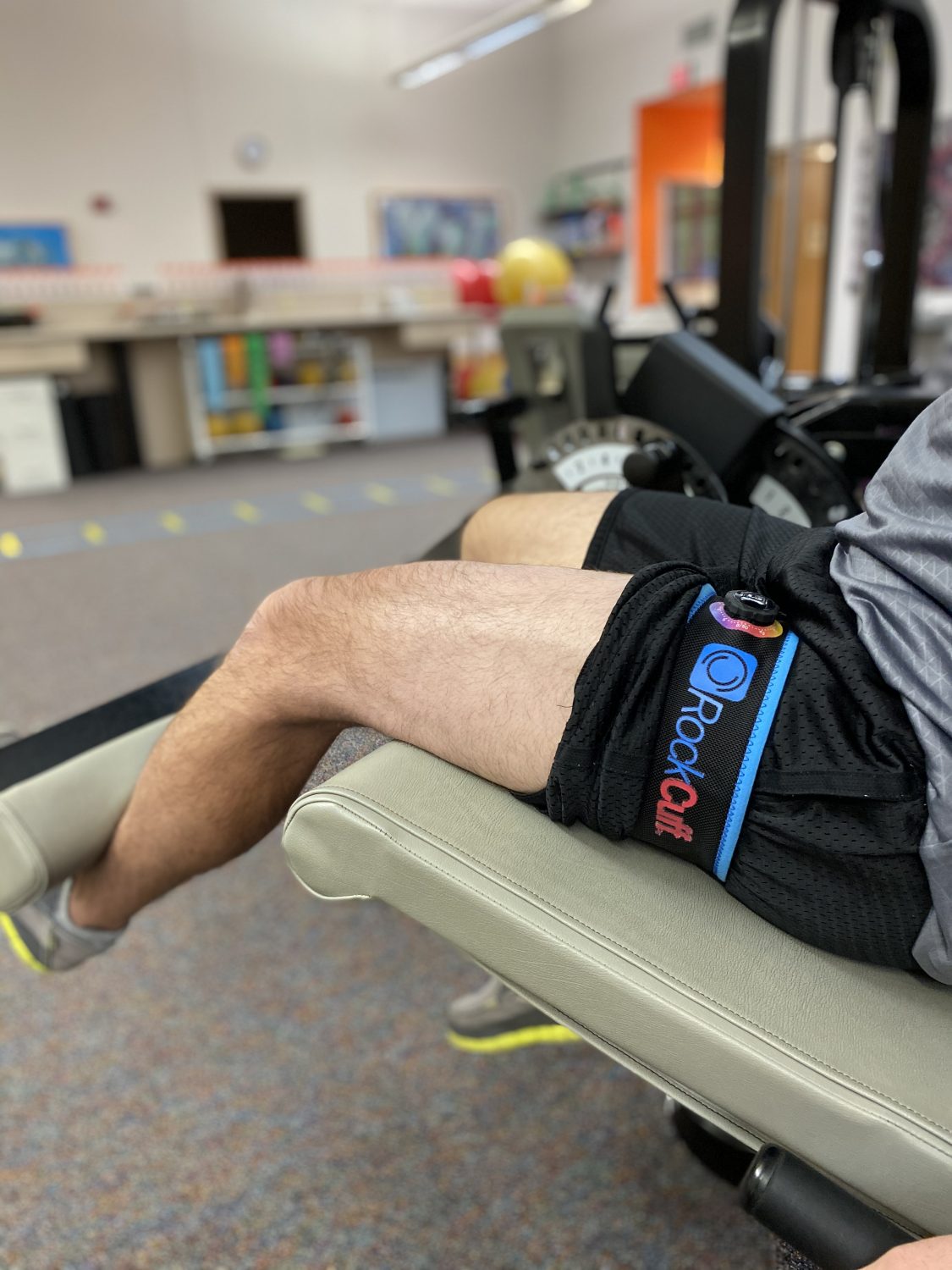

PSA: Physical Therapy Is Great During and After Pregnancy
Posted on Aug 24, 2020

